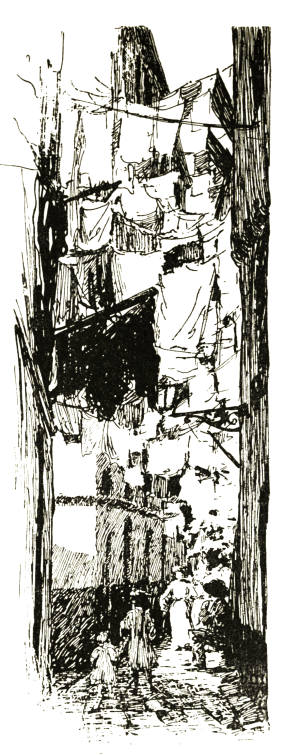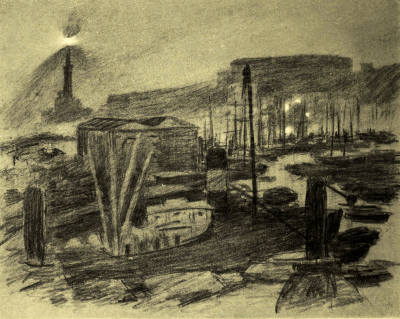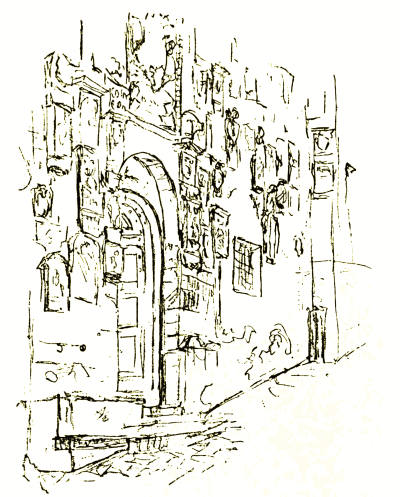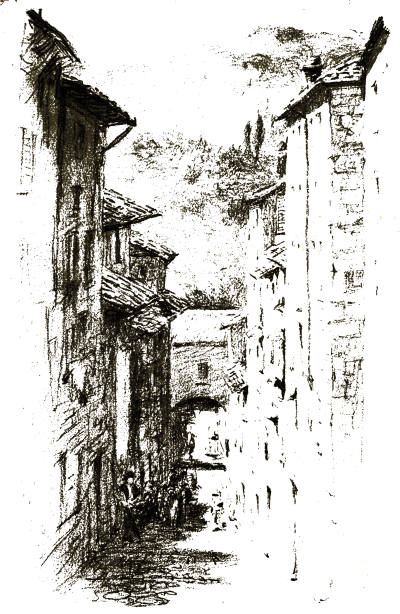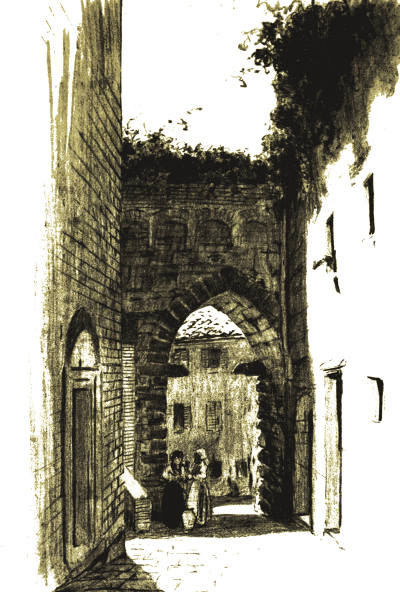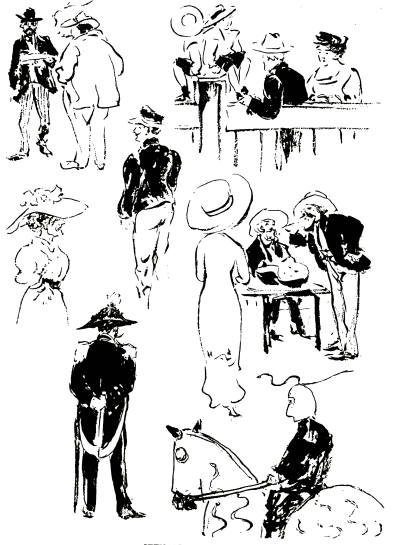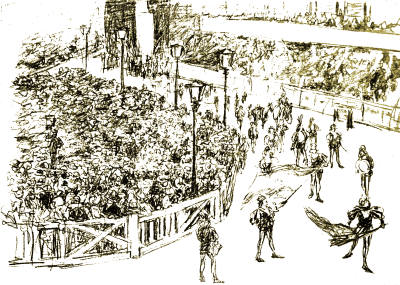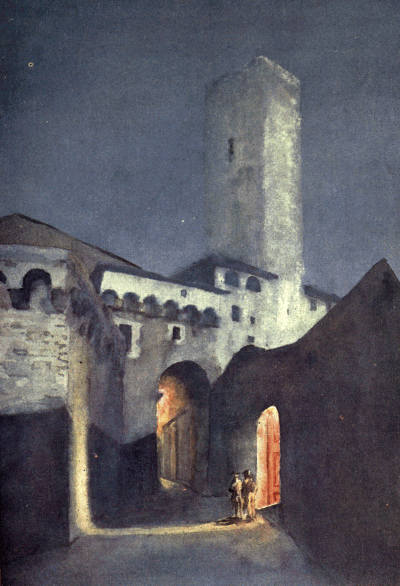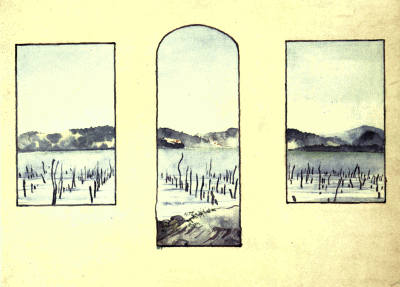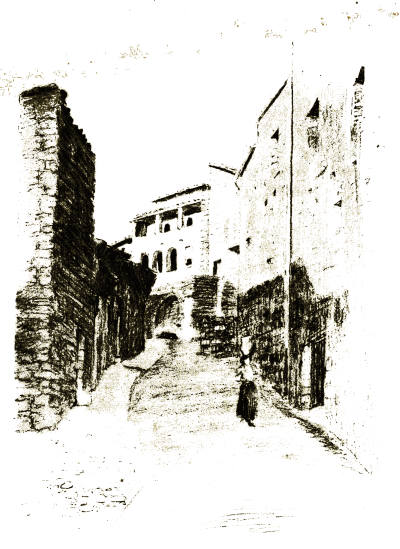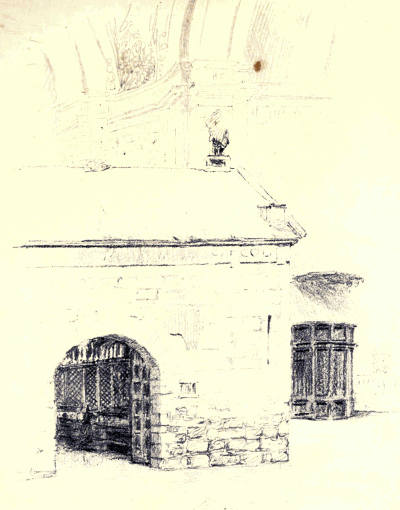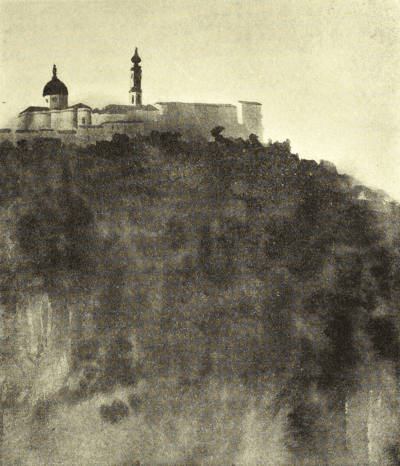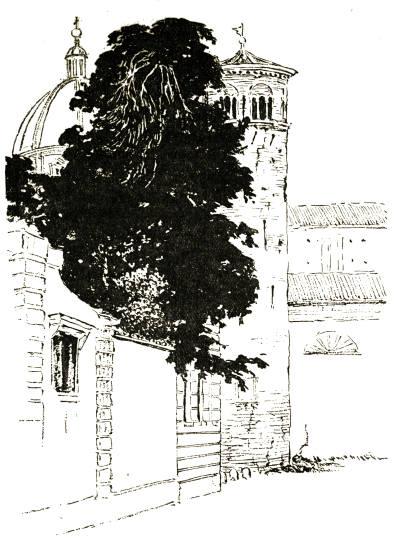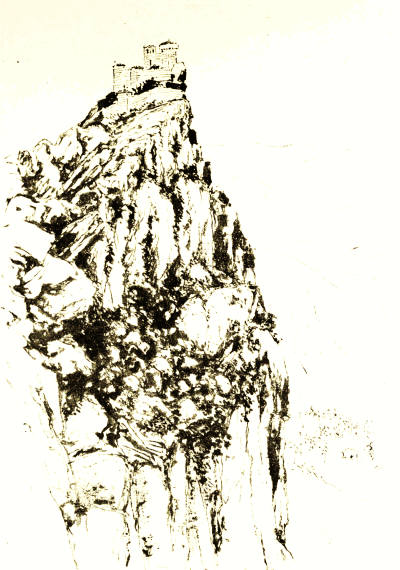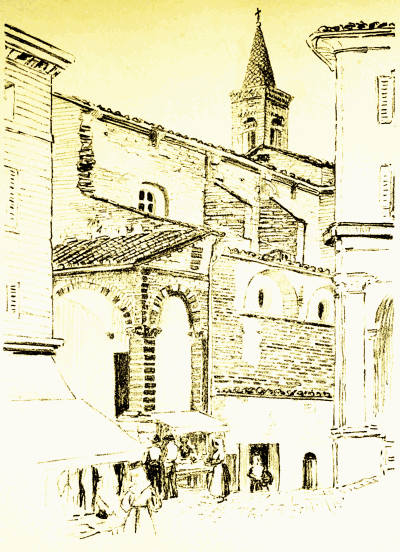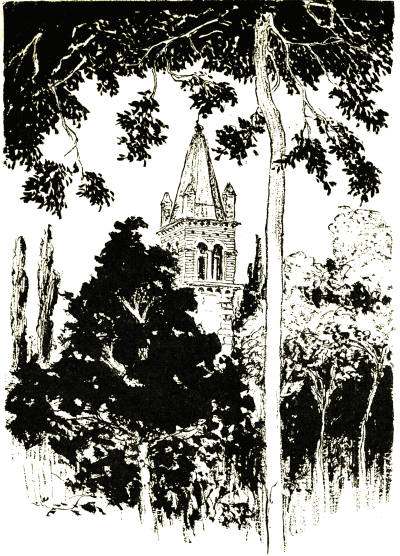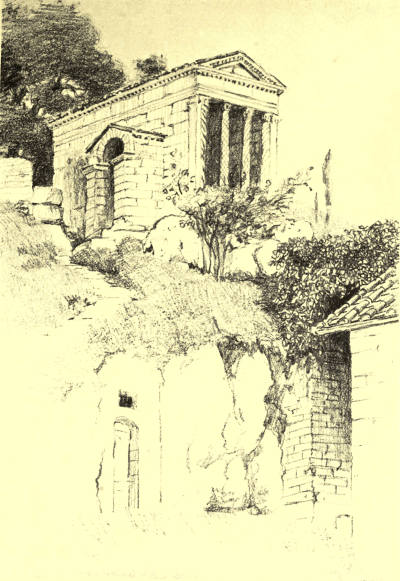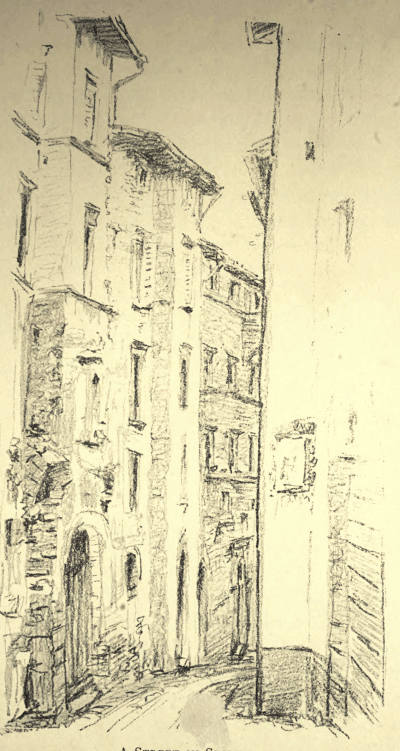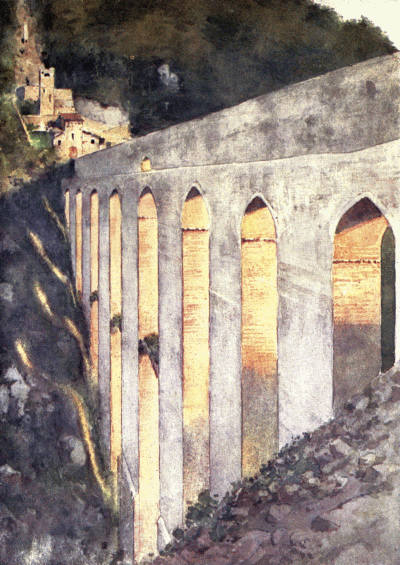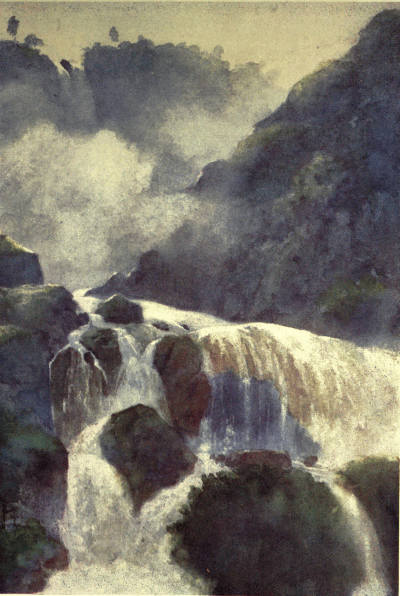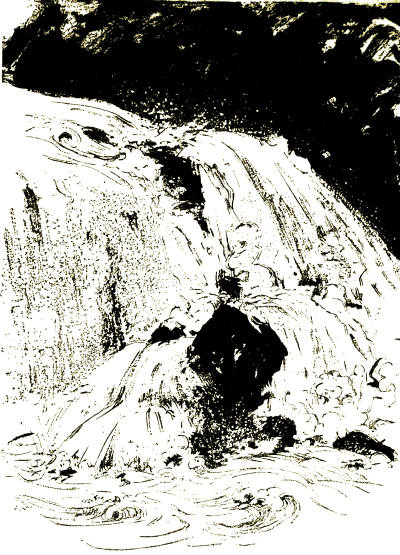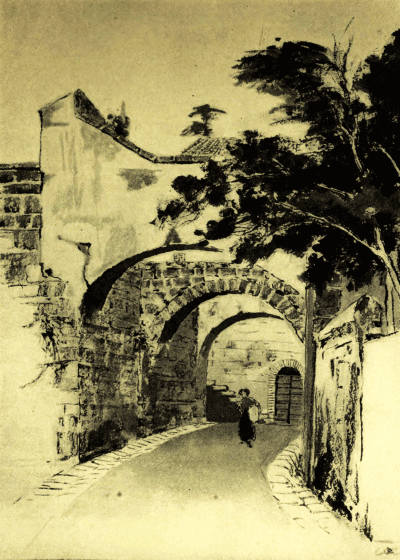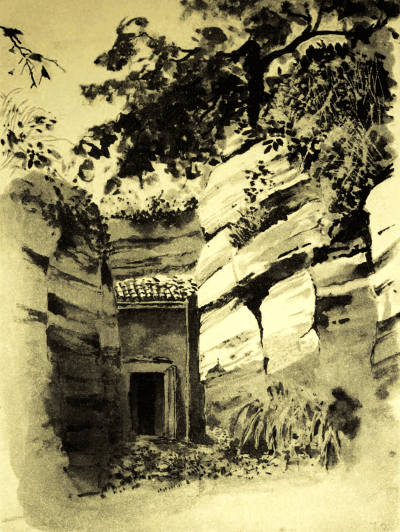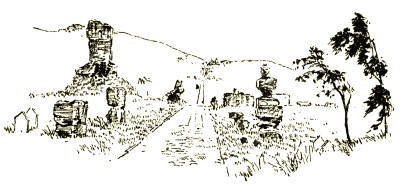*** START OF THE PROJECT GUTENBERG EBOOK 46092 ***
The Project Gutenberg eBook, A Little Pilgrimage in Italy, by Olave M.
(Olave Muriel) Potter, Illustrated by Yoshio Markino
[i]
A LITTLE PILGRIMAGE IN ITALY
[ii]
[iii]
4
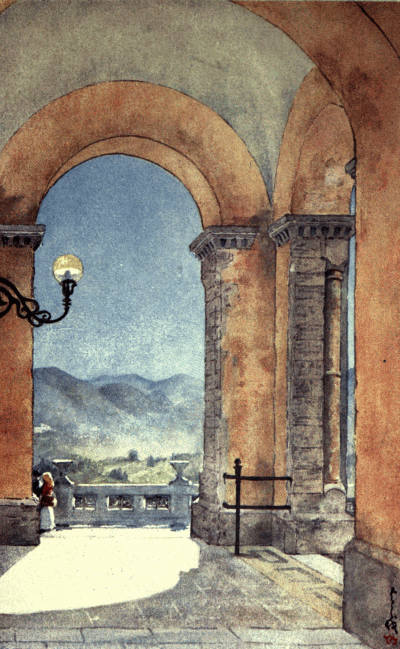
Perugia: looking towards Assisi.
A LITTLE PILGRIMAGE IN ITALY
BY
OLAVE M. POTTER
AUTHOR OF 'THE COLOUR OF ROME.'
WITH 8 COLOURED PLATES AND
ILLUSTRATIONS BY
YOSHIO MARKINO
TORONTO
THE MUSSON BOOK COMPANY
LIMITED
[iv]
| FIRST PUBLISHED NOVEMBER |
1911 |
| CHEAP RE-ISSUE |
1913 |
Edinburgh: T. and A. Constable, Printers to His Majesty
[v]
FOREWORD
One morning of high summer three pilgrims met
together in the City of Genoa to sally forth in search
of sunshine and the Middle Ages.
At least that was what the Poet said, for sunshine
and Ancient Stones were the passions of the Poet's
life.
The Philosopher insisted that we went in search of
Happiness.
It is no matter. But in fact we did meet one July
day of sweltering sunshine in Genoa, the Western
Gate of Italy, which is a city of grateful shadows,
whose narrow streets defy the brilliant sun.
This is a book of simple delights, a chronicle of
little pleasures, so I shall not talk much of Genoa,
although to my mind she is the most Italian of all the
great cities of Italy. Nor shall I speak of Florence, or
Naples, or Venice, or Rome. Doubtless, like me, you
have loved them all.
[vi]
8
[vii]
If you come with me I shall take you away from
the great cities where your feet are bruised on the
stony streets and never feel the soft warm earth beneath
their soles, where mountainous walls of brick limit
your vision to smoke-clouded strips of sky, where you
never smell the fragrance of the night. If you come
with me I shall take you to the hills, the deep-bosomed
rolling hills, with their valleys and their plains and
with towered cities riding on their crests. You will
lie with me under the olives and stone-pines, where
the warm earth cushions your limbs in luxury, and the
sunlight flickering in the green shadows lights on a
wealth of flowers.
Then, if you will, come back to your haunted
streets.
But I am persuaded that if you go there you will
find a great content among the little cities of great
memories which stand knee-deep in flowers upon the
hills of Italy, or in those nobler towns,—Siena, who
belongs to the Madonna, and Perugia, whose name is
as a torch to light your feet into the Valleys of Romance.
In their streets you are seldom shut away from the
mountains and the sky; and little gracious weeds and
grasses have spread a web among their stones as though
an elfin world sought to entrap a monster and pull him
down to ruin.
Our little pilgrimage took us to many shrines, and
haunts of peace and beauty. We made our discoveries,
saw much, learned not a little philosophy. And, most
of all, we caught a glimpse of the heart of Umbria—Umbria
of the saints. We watched the gathering
of the golden maize in the plain below Assisi while[viii]
we walked with St. Francis among the vines and
olives; we saw the vintage being brought home
with song and thanksgiving at Orvieto and Viterbo.
We dwelt among beautiful simple-hearted men and
women, living in little farms far from the toil of the
modern world, who still worship God in the gladness
of their hearts and the spirit of the ardent thirteenth
century; who toil and spin and bear children and lie
down to die, not with the stupidity of animals or
the self-satisfaction of the bourgeoisie, but full of a
beautiful content, moved by a beautiful faith. We
dipped into Tuscany too, into Lombardy, into the
March of Ancona, into Lazio, but nowhere else was
the world as perfect, as unspoiled as in Umbria. If you
are travel-stained with life, if the sweat of a work-a-day
world still clings about you, if you have lost your saints
and almost forgotten your Gods, you will cure the
sickness of your soul in Umbria.
11
[ix]
CONTENTS
| CHAP. |
|
PAGE |
| |
FOREWORD |
v |
| I. |
AREZZO |
1 |
| II. |
CORTONA |
14 |
| III. |
PERUGIA |
24 |
| IV. |
TODI |
45 |
| V. |
SIENA AND THE PALIO |
58 |
| VI. |
SAN GIMIGNANO DELLE BELLE TORRI |
88 |
| VII. |
MONTE OLIVETO MAGGIORE |
105 |
| VIII. |
CHIUSI |
116 |
| IX. |
HANNIBAL'S THRASYMENE |
129 |
| X. |
ASSISI |
144 |
| XI. |
GUBBIO |
171 |
| XII. |
ANCONA |
188 |
| XIII. |
LORETO |
201 |
| XIV. |
RAVENNA |
216 |
| XV.[x] |
THE REPUBLIC OF SAN MARINO |
234 |
| XVI. |
URBINO |
245 |
| XVII. |
FOLIGNO |
259 |
| XVIII. |
CLITUMNUS |
276 |
| XIX. |
SPOLETO |
280 |
| XX. |
THE FALLS OF TERNI |
296 |
| XXI. |
NARNI |
303 |
| XXII. |
ORVIETO: THE CITY OF WOE |
316 |
| XXIII. |
VITERBO |
333 |
| XXIV. |
ROME |
353 |
[xi]
ILLUSTRATIONS
COLOURED PLATES
| Perugia: Looking towards Assisi |
Frontispiece |
| Siena: Torre del Mangia |
Facing page |
62 |
| San Gimignano |
" |
102 |
| Lake Thrasymene |
" |
137 |
| Assisi: The Lower Church of San Francesco |
" |
152 |
| Ancona: The Fishing Fleet |
" |
192 |
| Spoleto: The Aqueduct |
" |
292 |
| The Falls of Terni |
" |
298 |
HALF-TONES
| Genoa: The Harbour |
Facing page |
viii |
| A Street in Arezzo |
" |
8 |
| Cortona from the Porta S. Margherita |
" |
20 |
| Perugia: Piazza del Municipio |
" |
28 |
| Perugia: The Ring of the Blessed Virgin |
" |
30 |
| Perugia: Porta Eburnea |
" |
40 |
| Perugia: The Tomb of the Volumnii |
" |
42 |
| [xii]A Street in Siena |
" |
66 |
| Siena: S. Domenico and the Via Benincasa |
" |
68 |
| Siena from the Convento dell'Osservanza |
" |
72 |
| Siena: The Palio |
" |
84 |
| San Gimignano: The Washing Place |
" |
96 |
| Chiusi: The Palace of the Bishop |
" |
126 |
| A Street in Assisi |
" |
148 |
| The Little Cloister in S. Francesco d'Assisi |
" |
154 |
| Assisi: The Porziuncula |
" |
168 |
| Gubbio: Piazza Vittorio Emanuele |
" |
180 |
| Gubbio: Via Carmignano |
" |
184 |
| Loreto |
" |
202 |
| San Marino |
" |
236 |
| Urbino: San Francesco |
" |
252 |
| Foligno: The Washing Place |
" |
268 |
| The Temple of Clitumnus |
" |
278 |
| A Street in Spoleto |
" |
288 |
| The Cattle Fair at Narni |
" |
306 |
| A Street in Orvieto |
" |
322 |
| Orvieto: Etruscan Tomb |
" |
330 |
| Viterbo: Mediaeval House in the Piazza S. Lorenzo |
" |
336 |
| Viterbo: From a Window in the Palace of the Popes |
" |
340 |
| Viterbo: Via di S. Pellegrino |
" |
346 |
| Rome: St. Peter's seen from the Arco Oscuro |
" |
354 |
| Rome: A Fountain in the Borghese Gardens |
" |
358 |
[xiii]
LINE DRAWINGS
| A Street in Genoa |
See page |
vi |
| Arezzo: The Prison |
" |
6 |
| Cortona from the Piazza Garibaldi |
" |
16 |
| Perugia: Detail from the Choir of S. Pietro de' Cassinensi |
" |
24 |
| Perugia: Arco di Augusto |
" |
27 |
| The Griffon of Perugia |
" |
32 |
| Fountain in the Cloister of S. Pietro de' Cassinensi |
" |
36 |
| Details from the Apse of the Cathedral of Todi |
" |
51 |
| Todi: S. Maria della Consolazione |
" |
54 |
| Siena: Banner-holder |
" |
61 |
| Siena: Torch-rest |
" |
64 |
| Sienese Youths in Palio Dress |
" |
77 |
| Seen at the Palio |
" |
81 |
| The Towers of San Gimignano |
" |
89 |
| Chiusure from Monte Oliveto Maggiore |
" |
107 |
| Città della Pieve from Chiusi |
" |
118 |
| Etruscan Cinerary Urns |
" |
122 |
| Chimneys at Passignano |
" |
133 |
| Assisi: S. Maria Maddalena at Rivo Torto |
" |
159 |
| Assisi: The Carcere |
" |
163 |
| Gubbio: The Lamplighter |
" |
173 |
| Gubbio: San Francesco |
" |
177 |
| [xiv]Gubbio: The Mediaeval Aqueduct |
" |
183 |
| Peasants at Loreto |
" |
206 |
| Pilgrims at Loreto |
" |
211 |
| Ravenna: The Pineta |
" |
218 |
| Ravenna: Sant'Agata |
" |
221 |
| Ravenna: The Tomb of Dante |
" |
228 |
| Ravenna: Column of Gaston de Foix |
" |
232 |
| The Palace of the Dukes of Urbino |
" |
247 |
| Foligno: San Domenico |
" |
263 |
| Foligno: Well in the Casa Nocchi |
" |
265 |
| Spello |
" |
273 |
| Spoleto: Porta d'Annibale |
" |
282 |
| Spoleto: San Gregorio |
" |
285 |
| A Fountain of Spoleto |
" |
290 |
| Spoleto: San Pietro |
" |
294 |
| The Lower Fall of Terni |
" |
300 |
| Farmers at the Ox |
" |
304 |
| Fair of Narni |
" |
308 |
| Market People |
" |
310 |
| Narni: The Ponte d'Augusto |
" |
312 |
| Below the Walls of Orvieto |
" |
318 |
| Orvieto: The Clock Tower |
" |
320 |
| Orvieto: Sant'Agostino |
" |
326 |
| Etruscan Necropolis below the Walls of Orvieto |
" |
329 |
| Outside the Walls of Viterbo |
" |
334 |
| Viterbo: The Moat outside the Porta San Pietro |
" |
338 |
| [xv]Viterbo: The Stemma of the City |
" |
341 |
| Viterbo: The Palace of the Popes |
" |
343 |
| Viterbo: Fountain in the Palazzo Municipio |
" |
344 |
| Viterbo: The House of the Bella Galiana |
" |
345 |
| One of Viterbo's many Fountains |
" |
348 |
| The Ruined Theatre of Ferento |
" |
351 |
| The Altar of the Unknown God on the Palatine |
" |
356 |
| The Via Appia |
" |
360 |
[xvi]
[1]
AREZZO
We came to Arezzo in the cool of the evening. It
had been a breathless day. Even at Genoa the air
hung heavy with the sirocco. We found Pisa in a
mirage, and the white hills of Carrara glistening like
the lime rocks of a desert.
It was good to be in Tuscany again—Tuscany with
her grey farms and lichened roofs, her towered horizons,
her blue hills, her vineyards, and her olive-gardens.
We could hear the song of the cicalas vibrating in the
sunshine above the jar of the train; near at hand the
hills swelled up, clothed with the tender mist of olives
or linked with vines; stone-pines floated darkly against
the sky, and cypress spires climbed the hillsides in a
long procession like souls on pilgrimage.
Perhaps it is because Arezzo, little Arezzo, with her
ancient history and her tale of great men, was the
earliest of our hill-cities that we loved her at first sight.
Coming from London and Genoa, with the noise and
dust and heat of long train journeys still hanging
about us, she seemed very cool and sweet among her
vineyards and olive-gardens. She has left her hill-top[2]
now that she needs no more the walls which Sangallo
built in the fighting days of the Popes, and has trailed
down to the railway in the valley, leaving behind her
wide piazzas which she has filled with shady trees, and
benches, and statues of her great ones. Her paved
streets, steep and clean, climb up the hillside between
grey palaces, green-shuttered, with wide Tuscan eaves,
whose fantastic outlines, seen in échelon against the sky,
bring back a score of memories of other clean-swept
Tuscan towns.
Now that we were threading her byways, Arezzo,
though she had looked imposing from the valley,
dwindled to a little brown city, full of memories,
and frescoed churches, and ancient houses in which
the labourer dwells in his poverty to-day where
the rich citizens of Arezzo once held great state.
Capers and all manner of pensive creepers grew out
of the rough walls; fig-trees, roses, wistarias, and
oleanders in full blossom poured over them, so that
the air was full of fragrance. And there were flowers
in the upper windows of thirteenth-century houses,
for your Tuscan is fond of flowers, and will have his
garofani upon his window-ledge. Through the low-browed
gateways we could see women spinning in
arcaded courtyards; and the shoemakers and basket-weavers
worked at their humble trades as they sat on
the steps of weather-beaten Gothic houses.
And often as we wandered through her narrow[3]
streets we paused to look down upon the calm beauty
of the Tuscan plain, which stretched from the vineyards
below her walls to the blue mountains of Chianti.
Nor did it require any effort of imagination, while we
were walking in those mediaeval byways between the
Borgunto and the Via di Pellicceria, to people the rich
valley with the pageant which Dante witnessed while
he was staying in Arezzo with the elder Petrarch, both
exiles from Florence.
'It hath been heretofore my chance to see
Horsemen with martial order shifting camp,
To onset sallying, or in muster rang'd,
Or in retreat sometimes outstretch'd for flight;
Light-armed squadrons and fleet foragers
Scouring thy plains, Arezzo! have I seen,
And clashing tournaments, and tilting jousts,
Now with the sound of trumpets, now of bells,
Tabors, or signals made from castled heights.'[1]
A common sight enough, heaven knows, in the
Middle Ages, when every little city sought to rule
itself, and the populace and the petty lords alike
cloaked their ambitions under the old war-cry of Guelph
and Ghibelline!
There is an air of gaiety in Arezzo, a simple, almost
pastoral, joy. The philosopher felt it at once.
'We are like flowers,' he said, as we sat on a bench
outside the inn after our first breakfast in Tuscany.
'In London our roots spread in the ground, and they[4]
get knotted and twisted in the darkness. Here we
shoot right up into the sun.'
And, indeed, Arezzo is a happy place, whose charm, it
may be, owes its origin to an earlier civilisation, which
has left so many broken fragments of its art scattered
on the neighbouring hillsides. They are garnered
to-day in the museum among the relics of Arezzo's
history, of which they are the chief glory now that the
bronze Chimera and the magnificent Etruscan statue
of Minerva have gone to swell the treasures of Florence.
There is not a vase or patera unbroken. The entire
collection is composed of fragments, moulds and casts
in low relief. But every piece is exquisitely beautiful;
each one is like a shell cast by the tides of fantasy
upon the shores of a work-a-day world. And though
the streets of Arezzo are nearly always empty and
silent, I think the flutes and lyres and dancing fauns,
with which the artists of Arretium delicately graced
their coral-coloured bowls and cups, are not silenced
yet upon this Tuscan hill. Perhaps the spirit of the
slim-limbed girls and youths, and merry little loves,
whose forms are beauty, and whose fragile feet seem
scarce to bruise the ground, dance still to their forgotten
songs about the vineyards of Arretium. It is as though
the dream of some Attic poet, for I cannot think that
the heavy-eyed people of Etruria imagined such gods,
lingers on in this little Tuscan town, and the echo of
its ancient music vibrates in the stillness of the museum[5]
like the murmur of waves in a shell. Or perhaps it is
a magic in the air, the subtle air of Tuscany, that poets
sing of, which has inspired more genius than we can
find in all the rest of Italy.
For Arezzo, like Florence, has been the mother of
great men. Michelangelo, himself born but a few
miles from Arezzo, wrote to Vasari, 'Giorgio, of myself
I have no power. I happened to be born in the subtle
air of your paese.'
Poets and artists, sculptors and musicians, have
issued from her walls. All the world knows that she
bred Maecenas and Petrarch, but only those who pause
to read her chronicles know how many of her sons have
walked with History in the corridors of Time—Margheritone,
the Spinelli; Leonardo Bruni; Carlo
Marsuppini, and a host of other humanists; the fighting
bishop, Guido Tarlati; Vasari; and Guido Monaco, the
Benedictine monk, born in the closing years of the
eleventh century, who was the inventor of our modern
system of musical notation.
Whether Arezzo occupies the site of Arretium, the
city of the Etruscan league, which is unlikely, or
whether it rose like a phoenix from the ashes of
its ancient necropolis, or grew from a Roman colony
of that name near the Etruscan settlement, is not for
me to say, since antiquaries are undecided. In any
case there is little of either Etruscan or Roman antiquity
outside the museum to-day.
[6]
It is the Middle Ages which have set their crown
upon Arezzo. Knowing her courage, and how it outweighed
her strength so that she dared to offer battle
to her great neighbour Florence through many stormy
centuries, it is a marvel that anything of value should
be left. And in fact Arezzo boasts few civic buildings—the
palace of the Podestà or del Governo, now the
prison, whose façade is covered with the stemme of her
many rulers, and the Palazzo Comunale or dei Priori,
with its picturesque clock tower, are all that remain[7]
of the mediaeval city, except some streets of fifteenth-century
dwelling-houses. But she has several noble
churches—the Gothic Duomo, majestically simple
within and without, which crowns her hill-top; the
Pieve, Santa Maria di Gradi, with its wonderful
Pisan-Romanesque façade, hoary with antiquity;
the great bare church of San Francesco, enriched by
Piero della Francesca's Story of the True Cross; and
Santa Maria delle Grazie in the vineyards outside the
walls.
It is the same all over Italy. What little town is
there, however broken, but has ancient churches and
palaces to crown its hill and keep troth through the
ages with its vanished greatness? Arezzo is particularly
rich. The most expectant pilgrim to Italy's
shrines of art, even though he come straight from
Florence, will be thrilled by the golden church which
soars from the crest of Arezzo's hill between the
gracious old Palazzo Comunale and the public gardens,
gay in July with the flame-coloured pennons of a
flowering tree, which Mr. Markino tells me is called
Urushi in Japan. For the Aretines have lavished
wealth upon their cathedral, and the Ark of San
Donato, which is one of the most beautiful mediaeval
shrines in Italy, a rival to Orcagna's masterpiece in Or
San Michele, is alone worth the long hot climb. The
exquisitely wrought marble is yellowing with age; it
is as finely carved as Oriental ivories; the trefoils and[8]
the edges of its panels are set with lapis lazuli. And
here we have the reverence of the Trecento, with its
rude handiwork redeemed by its ardent sincerity. For
the sculptors saw nothing strange or irreverent in filling
their scenes of the lives of Madonna and San Donato
with all the incongruous details of their own day, so
that we have at the same time jesters and angels,
knights a-horseback and heavy-headed saints, and the
queer beasts of mediaeval imaginings.
Close at hand is the tomb of the splendid old fighting
Bishop of Arezzo, Guido Tarlati, who crowned the
Emperor Lewis of Bavaria with the Iron Crown of
Lombardy in defiance of the excommunications of
John XXII., and who led his people to battle against
the Pope as readily as he led their prayers to God. A
great man this, who has a worthy tomb, for Agostino
and Agnolo of Siena carved the history of his stirring
life below his recumbent form when he was laid to
rest, and have shown us incidentally the life of the
Trecento in all its vigour and humour. Two angels
draw back the curtains of his bier, revealing him as he
lies asleep, with folded hands and an air of extreme
piety and humility, belied by the long recital of his
little wars, and the story of his triumphs, from his
Consecration as a Bishop to the Coronation of Lewis,
and his death in 1327.
29
[9]
There are many other treasures in the Duomo,
besides the column upon which San Donato had his
head cut off, 'without any regard for the axe,' as the
custode explained, pointing out a deep gash in the
marble to remove the lingering doubts of any sceptic;
there is an exquisite relief by Rossellino in the Chapter
House, and many Della Robbias have set their seal
of piety and graciousness on altar and tomb in the
Chapel of the Madonna. But it was not any of these
things which claimed our thoughts the first time that
we entered the dim aisles of Margheritone's soaring
Gothic church. After the glare and heat of the piazza,
where the sunlight reflected from the yellow walls of
the cathedral dazzled our eyes, we found the darkness
of the nave, illuminated by a solitary altar lamp, and
threaded with shafts of jewelled light filtering through
painted glass, as grateful as the shade of some primeval
forest formed by the interlacing branches of giant trees.
For, within, the Cathedral of Arezzo is like the Gothic
churches of the north, and it may be that the grim
Margheritone, whose agonised crucifixions adorn so
many chapels in Tuscany and Umbria, was himself
inspired by northern architecture. He returned to
his native town from Florence in the train of Gregory X.,
fresh from the Council of Lyons; and Gregory, who
left 30,000 scudi to the Comune for the erection
of the new cathedral, may well have made some suggestions
as to the style of architecture which was to be
employed. He died in the neighbourhood some
months later, early in the year 1276, and his beautiful[10]
thirteenth-century tomb by Margheritone is one of
the chief ornaments of the cathedral which he helped
to endow.
In Arezzo we were fortunate to find a real
country inn; a clean, cool place, with floors and stairs
of red brick, and an alfresco dining-room in the
garden.
I remember how gay we were, how our burdens of
care slipped from our shoulders as we sat to eat below
the trees on those first nights in Tuscany. Were we
not on the road again, knowing nothing of the morrow,
forgetful of everything but the joy of yesterday, dining
when we were hungry, sleeping when we were tired,
with no thought but for the beauty of the ways which
opened out before us, no care but that we might
pass unwittingly some of the quaint and lovely fragments
of art and architecture with which our path was
strewn?
'Peregrino, quasi mendicando,' said Dante, bitter in
his exile, but we did not want for the luxury which
money cannot buy. It is only Italy of the little towns
that can make you forget the work-a-day world. Nowhere
else can you be so content with what is often
meagre fare, so careless of the morrow, so full of the
joy of to-day, as you are in Italy.
At night we sat at rough trestle tables in the little
garden of the Albergo della Stella with the star-strewn
canopy of night above us, and an electric light hanging[11]
like a fire-fly from the branches of an acacia tree.
The level note of night crickets singing in the ilexes
made an accompaniment to the distant clatter of dishes
and the snatches of talk from other tables behind the
tall bamboos. The food was simple—minestre, perfectly
grilled steaks, fresh fruit, and generous fiaschi of
the good red Tuscan wine, for which the vineyards of
Arretium were praised. And here we lingered, talking
of the wide-eaved Tuscan house in the Via del Orte,
where Petrarch, the first of the great Italian humanists,
was born, and Dante came to visit the elder Petrarch,
who had been exiled from Florence by the same turn
of the political wheel as himself; of Vasari, who filled
his niche as a biographer so much better than he
ever filled it as an artist; of Piero della Francesca and
the vigorous young world he pictured on the bare white
walls of San Francesco; and of San Bernardino who,
like St. Francis, purged Arezzo of its devils and laid
the foundations of Santa Maria delle Grazie, that
exquisite church outside the city walls which Benedetto
da Maiano, Andrea della Robbia and Parri di Spinello
enriched with the sister arts. For it was San Bernardino
who, coming to Arezzo, and finding that the
citizens were in the habit of practising pagan rites for
an oracle, which they imagined dwelt in a wood outside
their gates, preached such a fiery sermon from the
pulpit of San Francesco that they wept before him like
little children. But he, insisting that they should do[12]
penance, gave orders that on a certain day a great
wooden cross should be brought to him, and that the
people should come in solemn procession to exorcise
the demon. That week the citizens of Arezzo went
about their work with fear and trembling, and some of
them cast doubtful looks down to the valley where the
oracle was hid. But on the appointed day, though I
doubt not that many did absent themselves, a great
company followed the saint, carrying the cross, down
to the hateful wood.
It is not hard to picture to-day—the Mystic chanting
as he walked at the head of the procession; the
hot and dusty way through the vineyards below the
city walls, for San Bernardino was loth to start until
all the people were met together; and the fear of
the crowd as they drew near and heard the music of
the oracle-haunted spring. But Bernardino, whose
heart was ever with the angels, caused the fountain to
be cast down and the trees to be felled, lest by any
chance some evil might yet lurk in the wood. And,
knowing the heart of the people, that where a man has
once worshipped he will worship again, even though it
be to other gods, he built a little chapel to the glory
of Our Lady of Mercies, and he begged Messer Spinello
to paint the Virgin for an altarpiece.
But not every one who comes to Arezzo visits this
lovely church down in the vineyards, in spite of the
marvellous beauty of Andrea della Robbia's 'cornice,'[13]
which frames Spinello's Madonna delle Grazie as she
stands among the stars, like the Mother of the World,
with strange, sad eyes, and shelters in her cloak the
little people of Arezzo, humbly kneeling in penitence
at her feet.
[14]
CORTONA
Cortona! Not one of us but thrilled as we drew near
her. For few cities bear so fair a name or seem as
full of promise as Cortona. Although the world has
long since passed her by, she loiters on her hill-top
between the valley and the sky like a forgotten goddess
who is loth to quit her great estate. Her towering
walls encompass her about, those mighty walls built
for a mighty people which Virgil sings of in the Aeneid;
she frowns as though she were still girt for war, and
had forgotten how to smile; her lean grey castle, stark
upon the crest of the hill, points to the heaven like an
avenging sibyl.
No wonder that her history is spare since the days
when she and her great neighbours, Arretium and
Clusium, joined the Etruscan League in 310 b.c.; for
even to-day, with excellently engineered roads scaling
her hill, she is difficult of approach, and her stout walls
and impregnable position offered no inducement to
invading armies, who were content with harrying her
fertile plain, as they passed by to Umbria and Rome.
We know she was a Roman colony in the time of the[15]
historian Dionysius, but scant mention is made of her
under the Roman Empire; and although she was one
of the earliest Episcopal sees, and is still the seat of a
bishop, it was not until the thirteenth century that the
chronicles of Cortona began to take a place in mediaeval
history. She is still withdrawn from the world upon
her mountain; her houses are still huddled together in
the shelter of her great walls, built by the Unknown
People; she still hides her poverty from the eyes of the
careless traveller as he rushes past the foot of her hill
on his way to Rome or Florence.
After the motor-omnibus had deposited us in the
Piazza Signorelli, and we had deposited our luggage
in a rather dreary-looking inn whose only claims to
notice were its exquisite views over the Tuscan plain
to the inland sea of Thrasymene, we sallied out full of
anticipation to see the legendary birthplace of three
such widely different characters as the mythological
Dardanus, founder of Troy; Brother Elias, the erring
and ambitious follower of St. Francis; and Luca
Signorelli, that courtly gentleman and great painter of
the fifteenth century.
But we were disappointed. Cortona, notwithstanding
her lovely name and her ancient and picturesque
site, is a dirty little place, with unsavoury streets and
a baroque cathedral. She has treasures, of course.
What little town in Italy has not? Her tumble-down
palaces are built of warm red brick; her churches have[16]
some fine pictures; her Palazzo Pretorio is covered
with the escutcheons of the princes who were her overlords,
but she has no charm unless you catch her
unawares before the sleep is shaken from her eyes
early on a summer morning.
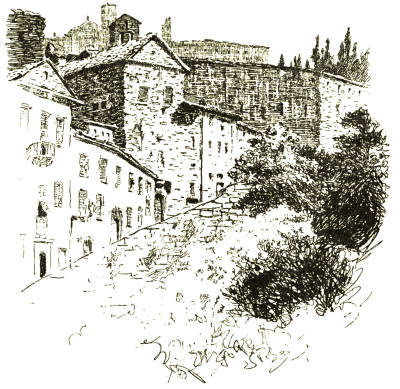
CORTONA FROM THE PIAZZA GARIBALDI.
We found so little to detain us in her dingy, unkempt
streets that we decided to push on the next day
to Perugia. We tried our tempers in the inn, the most[17]
lethargic inn that it was our misfortune to visit,
endeavouring to get some lunch, and after waiting
an hour and a half we found the gnocchi stale and the
coarse meat uneatable. So we went out again into
the siesta heat, determined at least to see the great
Etruscan lamp which is the pride of Cortona's museum,
and the pictures which Luca Signorelli painted for her
churches.
Cortona was asleep. She was as still as a lizard
on a sunny wall; even the tiresome children who had
followed us all the morning, agape for soldi, had
vanished; the air was vibrant with the tremolo of the
cicalas; the sunlight stretched like a shimmering veil
across the valleys. And in a moment all our vexation
vanished. Italy the Beautiful came out to meet us,
smoothing away all disagreeable memories as a cool
hand laid on the forehead will smooth out pain; we
forgot the hatefulness which had been piling itself
up all day—the dust, the smells, the too-glaring sun,
the stupid inn with its bad-tempered maid-servant, the
screaming children, the baroque cathedral!
In the cool grey church of San Domenico, which
stands in the flowery public gardens of Cortona, we
found not only one of Luca's great pictures but a
pageant of Quattrocento saints and Madonnas in richly
gilt Gothic frames over the three altars which fill its
eastern wall. In the Gesù, a little ancient church
which clings to the hillside close to the cathedral, we[18]
discovered an Annunciation by Fra Angelico, almost
as beautiful as that exquisite picture which he painted
on the wall of his monastery-home in Florence. It is
very like the fresco in the corridor of San Marco.
The Madonna is sitting in the same light and airy
loggia reading in some little book, as the Angel
Gabriel, with his iridescent wings still poised for
flight, alights at her feet, filling the air with glory.
Outside, the grass is starred with the flowers which
Angelico loved to paint; and far away, silhouetted
against the sky, we see the Angel with a flaming sword
driving Man and Woman from their Garden of Paradise,
whose gates not even the coming of Christ could
reopen on earth.
And then, remembering the story of Filippo
Brunelleschi, we went into the Duomo to see the
famous sarcophagus which legend claims to be the
tomb of the Consul Flaminius, and which the great
architect of the dome of Florence Cathedral walked
sixty miles to see. For one morning when he was
discussing antique sculpture in the Piazza of Santa
Maria del Fiore with Donatello and some other artists,
Brunelleschi heard of a Roman sarcophagus in
Cortona. Straightway he left his companions, and
fired by his passion for the works of antiquity, 'just
as he was, in his mantle, hood and sabots, without
saying a word of where he was going,' came to Cortona
and made a drawing of it, returning at last to Florence[19]
where he showed it to the astonished Donatello, who
had not been able to guess where his friend had disappeared.
But it was in the early morning, as I have said,
that we discovered the nameless charm of Cortona—that
same charm which we found in a different guise
in all the little towns of Umbria and Tuscany. Our
inn, though it towered more than a thousand feet
above the valley, was at the bottom of the city, for
Cortona in the immemorial Etruscan fashion hangs
from the crest of her hill. Even the ambitious motor-bus
could not climb higher than the Piazza Signorelli,
because nearly all the streets above it are so steep that
they are built in shallow steps. And they are so
deserted that in one of them we found rabbits contentedly
nibbling the grass which grew between its
paving-stones. So the next morning, very early, while
the day was cool, we climbed up to the great church
of Santa Margherita, which stands with the ruined
Fortezza on the crest of Cortona's mountain.
To me it is always rather strange that this harsh
Tuscan citadel should ignore the name of Brother
Elias, that great and restless spirit who sought to wed
Love not to Poverty, as Francis did, but to Ambition.
His name is hardly spoken in Cortona, but the body
of Santa Margherita, whom some call the Magdalen
of the Franciscans, because they love to draw comparisons
between the life of Christ and His humble[20]
follower, is enshrined upon the hill-top like the light
that cannot be hid. Her church has been restored,
and there is little of the ancient building left except
her beautiful fourteenth-century tomb, the silver shrine
which was the gift of Piero da Cortona, and the lovely
rose-window which is preserved in the modern façade.
In the aisle are the flags and ship-lantern of some
knight of Malta, who prayed to Margherita in the
hour of peril, and was saved by her intercession.
Yet it was not for Santa Margherita that we
climbed Cortona's hill at dawn, but to see the rich plain
of Tuscany in its amphitheatre of blue hills, each with
a towered city for its crown—Chiusi, Città della Pieve,
Montepulciano, and a host of others to which we had
not learned to give their names. It was a panorama
of surpassing beauty which opened out before us.
Fold on fold the mountains lifted their heads above
the mists of the valley, rising always towards the
mighty crest of Monte Amiata, which was to loom
upon so many of our horizons while we were journeying
through the heart of Italy. And far away the
sunshine lightened the opal waters of Lake Thrasymene,
lying like a forgotten sea in the bosom of the
Umbrian hills, with the towers of Castiglione del Lago
rosy in the dawn.
43
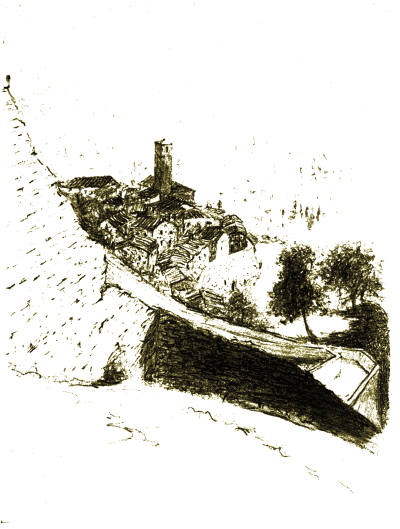
Cortona from the Porta S. Margherita.
[21]
Even here the Rocca stood above us on its scarp,
the key of the strong citadel which claims descent
from Dardanus of Troy. On either side of Santa
Margherita the mighty walls, including many courses
of Cyclopean masonry, climbed down towards the
peaceful plain. We passed through a gap which
had once been a gate, and saw them plunging
down the hillside holding the crumpled brown roofs
of the little shrunken city in their elbow. So was
Cortona of the Unknown People fortified; so was the
city of the Etruscans girt about, and Hannibal and
Flaminius have looked upon these walls as they passed
by to battle upon the reedy shore of Thrasymene.
Up on the hillside men and girls were reaping in
the shadow of the ancient wall. 'And the reapers,
reaping early,' quoth the poet softly to himself. Their
laughter floated down to us. Every now and then
a girl would straighten her lithe figure, stand upright
curved scythe in hand, and sing, her clear notes soaring
like a lark's in the crystal air. At our feet Cortona
nestled in the embrace of her great wall, and far below,
the plain of Tuscany rolled away to the hills where
the sunlight fired the towers of other mountain cities.
So in the dawn we grew to love Cortona, for the
fantastic beauty which is her own, and for her aloofness.
As we passed down into her steep-paved streets
we paused a moment in San Francesco, where Brother
Elias lies buried with his hopes and ambitions; where,
too, is kept the ivory case with a fragment of the True
Cross which the Patriarch of Constantinople gave to
Elias when he visited that Court as Nuncio of Frederick[22]
II. And we lingered in little San Niccolò, which, with
its loggia and cypress-garden, is the loveliest of Cortona's
churches; and which, for all its poverty, treasures
three pictures by Luca Signorelli, who belonged to its
confraternity.
Down in the Piazza Signorelli we found the motor-omnibus
already waiting to take us to the station.
The narrow streets were crowded with black-browed
Tuscan peasants selling fruit and vegetables, and doing
a thriving business in skinned frogs strung on wooden
skewers. These looked particularly unappetising in
pails of not too clean water, and the atmosphere was
putrid after the freshness of the air above. Again
we had the sense of stifling heat and odour, and
again the swarms of dirty children who had tracked us
yesterday rose, as it were, out of the earth. We were
glad enough to leave Cortona, but not until we had
experienced many vexatious delays. For when we
had fetched our luggage from the inn and settled our
account with the rather difficult landlady, the driver of
the omnibus was not forthcoming. And when at last
we persuaded him to leave the shelter of the cool
Palazzo Comunale, a glazier took the ill-chosen opportunity
of mending two of the broken windows in the
omnibus. We had given up all hope of catching
our train when half an hour later we swung out of the
town and began our perilous descent down to the
plain.
[23]
After all we had some minutes to spare, though I
should not care to make the journey again, for we took
more than one corner of that switchback road on two
wheels. But the driver was confident of our approval.
'Ecco signore, the train has not yet arrived,' he cried
triumphantly. Facilis descensus Averni!
[24]

PERUGIA: DETAIL FROM THE CHOIR OF S. PIETRO DE' CASSINENSI
PERUGIA
'For bodiless dreams through double gateways go
Of horn and ivory, from night's realm forlorn;
And those that through the ivory gate are borne
Deceive, and what they tell is unfulfilled;
But those that issue through the polished horn
Fulfil themselves for mortals to whose sight
They issue.'
J. W. Mackail's Translation of the Odyssey,
xix. 562.
'Look!' said the chronicler, 'there is Perugia.
Perugia, whom I have loved so long for her name alone.'
The poet sighed.
'I could almost envy you because you do not
know her. See how her loggia'd towers frame the
heavens, and how she stretches out her lovely arms to
welcome us!'
We came to Perugia from Cortona. In an hour
we slipped from that austere Tuscan citadel into the
heart of an enchanted land—Umbria Mystica—the home[25]
of saints, where Beauty and Romance walk in the
valleys with the gentle Gods of Arcady; where brooding
peace hangs in the luminous air, and on whose
aerial hills great memories dwell in the little cities full
of dreams that men have built for them. We skirted
the enchanted shores of Thrasymene, the spell-bound
lake which lies like an opal in the bosom of the
Umbrian Hills, and found ourselves among vineyards
and olive-gardens, where the Madonnas of Perugino
and Raphael are living their beautiful and simple lives
in the fields, and the great-eyed oxen draw Virgilian
ploughs below the olives, or roll along the dusty roads
with scarlet fillets on their milk-white heads.
Perugia is the queen of this enchanted land, the
crown of Umbria. Think of her name—Perusia
Augusta the Romans called her; was there ever a more
lovely name, or one which History enriched with more
poetic legends? For Felice Ciatti, that brilliant scholar
of the seventeenth century, in summing up the Greco-Trojan
tradition and the popular belief that Noah, the
Patriarch, was the founder of the city, thought nothing
of addressing the Perugians, in one of his Lenten
sermons, in these stirring words—'No marvel is it if,
to-day, ye Perugians possess the justice of the Armenians,
the wisdom of the Greeks, the prosperity of
Augustus, and the sanctity of Noah, for ye are
descended from them all.'
And if these legends leave you cold, think of the[26]
Carlovingian tradition in which such great names as
Oliver the Paladin, and the puissant knight, Count
Roland, 'the Falcon of Christendom,' and the tyrant
Orgoglioso, play their parts with the lovely lady Prossimana.
Or, if this does not stir you, would you rather
learn romance from the nomenclature of her ancient
gates? Here, long since vanished, was the Portal of
the Sun, the gate through which blind Homer thought
that dreams entered into a city from the east. It still
gives its name to a whole quarter of Perugia—the
Rione della Porta Sole—and though no man can point
to the actual Porta Sole, when the wind blows coolly
through any of Perugia's eastern gates, and you look
across the valley at Assisi, it will be strange if you do
not think of Dante's words:
'There hangs
Rich slope of mountain high, whence heat and cold
Are wafted through Perugia's eastern gate:
And Nocera with Gualdo, in its rear
Mourn for their heavy yoke. Upon that side,
Where it doth break its steepness most, arose
A sun upon this world, as duly this
From Ganges doth; therefore let none, who speak
Of that place, say Ascesi; for its name
Were lamely so delivered; but the East,
To call things rightly, be it henceforth styled.'[2]
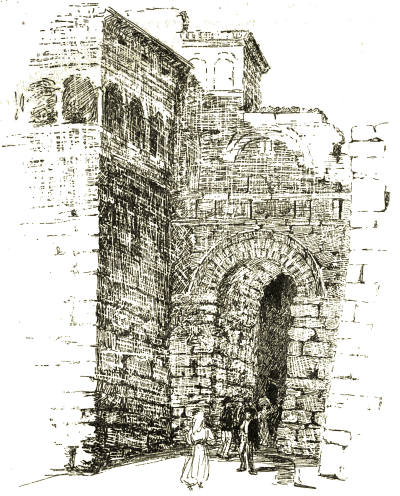
PERUGIA: ARCO DI AUGUSTO.
Here, at the end of a winding street of mediaeval
houses, is the Porta Eburnea, the Ivory Gate through
which Homer thought that False Dreams were expelled[27]
from a city; and close to Sant'Ercolano is the Porta
Cornea, the Gate of Horn, whence issued all True[28]
Dreams. The Porta Eburnea was, indeed, the gate of
False Dreams, for it was by that way, so Matarazzo
tells us, that the Baglioni, that strange and beautiful
and ungodly race who lived and died by violence,
always passed out to battle. Of the others the Porta
Augusta, the greatest of the Etruscan gates, once bore
the proud name Porta Pulchra, because of its beauty
even in a beautiful city; and another was named, and is
still named, after the God of War. Is it not irony that
all the rest should bear the names of saints, for Perugia,
a city of turbulent desires, has ever bred more warriors
than saints? Even to-day there are few monks or nuns
in Perugia; it is the military who are in evidence, and
not a few churches and cloisters have been despoiled
to house them. In fact Perugia, notwithstanding
her mediaeval monuments, is a gay and much begarrisoned
city, not provincial like Siena, but really the
capital of a state. I have never seen so many smart
and pretty women in any Italian town of the size as I
found at Perugia in high summer, nor so many soldiers.
The Corso is full of them, both morning and evening.
They promenade up and down, 'wearing out the pavements,'
in the phrase of the immortal and energetic
Fortebraccio; or they sit at cafés gossiping after their
siestas. At night they become an army. It seems as
though the entire population congregated then in the
Corso and the Piazza Vittorio Emanuele, where there
is a band and a mushroom growth of tables and chairs.
On Sundays they promenade in the cathedral in just
the same gay and careless fashion, except that the boys
doff their hats, and that here you see shaggy-haired and
devout peasants kneeling among the beautifully-dressed
Perugian ladies.
53
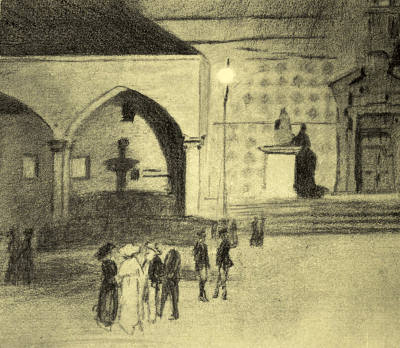
Perugia: Piazza del Municipio.
[29]
Perugia is not a religious city. It is true that she
furnished the most ardent disciples of the thirteenth-century
Flagellants;[3] and that Fra Bernadino of Siena,
preaching to her from the little pulpit outside the
cathedral of San Lorenzo, brought her to such a
passion of repentance that not only did she burn her
vanities in the piazza before this ardent Flame of God,
as the Florentines were to do later for Savonarola, but
she built in his memory that exquisite oratory covered
with reliefs in terra-cotta by Agostino Duccio, under
the shadow of San Francesco. Yet for the rest it
seems as though she has not forgiven the papacy for
grinding her under its heel in the stormy sixteenth
century, when Paul III. built his fortress on the ruined
palaces of the Baglioni; although, on the Feast of the
Ring of the Virgin, which, for all her air of cynicism,
she still counts as one of her treasures, we saw the
peasants who had climbed her hillside in the dawn
worshipping with the simple faith of the Middle Ages.
Matarazzo has told the story of this Ring, and how
it was stolen from Chiusi, where it was held in great[30]
veneration, in the thirteenth century by a German
priest, and brought by the intervention of the Holy
Virgin to Perugia. It is shown in San Lorenzo in a
finely-wrought casket thrice a year; otherwise it is kept
in an iron chest, whose seven keys are in the custody of
different citizens. We arrived early enough to go into
the loft, where the chest is lodged, above the Altar
of the Sacrament, and see the Ring being put sans
cérémonie into its place in the gold casket before the
red silk curtains were drawn back and the holy relic
lowered to the altar. A short mass was said, and the
casket was placed on a table in the centre of the chapel
for the people to pass one by one in front of it.
It was a sacrament, a holy and beautiful thing, to
watch them as they passed, these peasants with their
broken dusty hats and rugged faces, who had come up
from the valleys with their Madonna-like wives.
They pressed their lips to the glass, and held up their
rosaries and rings to touch the shrine. All had some
special sign of love and reverence.
57
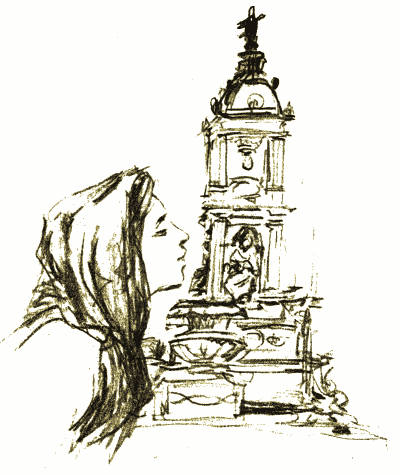
Perugia: the Ring of the Blessed Virgin.
[31]
I watched them till my eyes were filled with tears
because of the beauty and the pathos and the blessedness
of it all. One by one they passed. First, an old
woman, her white hair hidden beneath a gold kerchief,
and a smile of rare peace on her gnarled face, pressed
her lips to the casket and handed up her rosary
that it might touch the shrine. She passed down with
bent head. Next came a girl of the splendid Umbrian
type, deep-chested and straight-limbed, her head carried
high. She kissed the glass and lifted up her ring, maybe
her wedding ring, then crossed herself, and passed on
with trembling lips. Old men there were who touched
the shrine with shaking fingers, and stumbled away into
the cathedral to pray. Children were lifted up to kiss
it. And there were others besides the kerchiefed women
and their peasant husbands—people of the town, complacent
burghers and their stout wives, and the dainty
white-robed girls of Perugia. And nearly all passed out
with uncertain lips as if they had been strangely moved.
Across the nave is the Miraculous Madonna which
Giovanni Manni painted on a column. She is in a gilt
frame, set about with silver hearts, which gleam in the
darkness of the aisle like the smiles of those who have
found joy in her. I do not wonder that the people of
Perugia love this Madonna, for she is very beautiful.
Her hands are raised in blessing, but to me her tender
eyes are full of wonder, as though having no belief herself
she marvelled at these worshippers for their faith,
and loved them exceedingly because of it. We always
found some poor, rough-headed peasants kneeling in
the great ugly church before her, and ever she blessed
them, and wondered at them, and seemed to give them
peace.
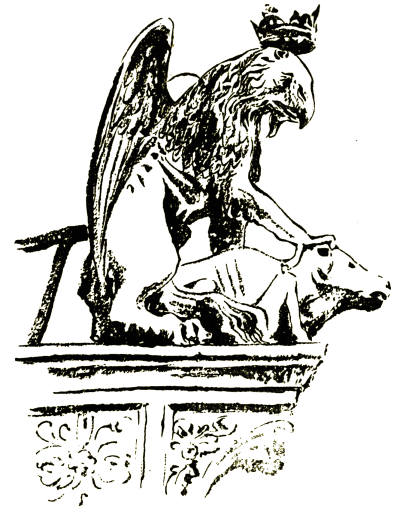
Perugia is a mediaeval paradox. When you stand
upon her ramparts in the clear shining of the morning,
and look across the hills and vales of Umbria, you[32]
wonder that the hot breath of war and the scent of
blood should have reached her. For she stands at the
head of two wide plains full of enchanted silence—the
Valley of Spoleto with its many little cities starring
the green hills, and the Valley of the Tiber which
sweeps from the gates of Perugia southwards to Rome.
The mountains, which close them in, are clothed with
vines and olives, and swell softly like the many
bosoms of Diana of the Ephesians. The valleys are a
garden, and the hills roll softly to the horizon till they[33]
grow aerial in the distance and hang upon the heavens
like fantastic clouds. Little white cities crown them
or clamber up their slopes, and rivers wind down the
valleys, with sunlight glinting on their waters, between
the tall poplars swaying on their banks like girls who
gather flowers by a stream. The high brown shoulder
of Subasio, made sacred by its memories of Umbria's
greatest saint, shuts off the bleak and hungry Appennines
which clasp Gubbio and Gualdo and a hundred other
little cities to their barren breasts. But here you have
the landscape of the Quattrocento artists with the
clear pale light and blue aerial hills which are the
hall-mark of the Umbrian masters. Nor can you ever
tire of watching it, for every day and every hour some
subtle change sweeps over the face of this immortal
loveliness; and it is always beautiful, whether you look
across the sunlit mists at Assisi in a blue veil of cloud-shadow
or see her smiling and rosy in the sunset, or
whether you stand at night under the scented laurels
of Perugia's passeggiata, and see the lights of distant
hill-cities riding like ships upon the dim horizon of a
soundless sea. It became a custom, almost an act of
worship, to congregate upon the bulwarks of Perugia
before the sun slipped behind the western hills, to
watch the light pouring into the plain like liquid gold
into a bowl of translucent glass, tinted all the colours
of the prism. Even when night had drained this
ancient chalice of the golden wine of the sun, and the[34]
lights of lonely farmsteads were twinkling on the hillsides,
we were loth to leave it.
Yet these fair valleys have been drenched with
blood and scorched by fire; Hannibal and his Gauls
and Africans gave battle to Flaminius, the maker of
roads, by the lake of Thrasymene; they have been
devastated by Goths and Lombards; the German
Kings of Rome have harried them, and the history
of Perugia itself has been one long tale of battle
and murder. It is as though the Griffin of Perugia,
the strange Etruscan beast which is to this day the
device of the city, has never sheathed its talons in
anything but human flesh.
From the beginning Perugia fought fiercely for her
freedom. Octavius wrestled for seven months outside
her gates, and when he entered them was cheated of
everything but honour; because a citizen, rather than
yield his city to the first emperor, set fire to it, and
stabbed himself in the holocaust which followed.
Totila would not rest until he possessed her, and all
through the Middle Ages she fought like a termagant
with her neighbours; and the name of that griffin's
brood, the Baglioni, was a terror throughout the
Umbrian vales.[4]
[35]
It was Paul III. who brought her to her knees, and
forced her to build his great fortress upon the palaces
of her princes, and not long since she turned and rent
it stone from stone, seeking to wipe out the old insult.
But it is not only in the marvellous and peaceful
beauty of her setting that Perugia is a paradox, for how
is it possible to reconcile the pictures of Perugino and
his great pupils—Raphael, Lo Spagna, Pinturicchio,
and Eusebio di San Giorgio—with the awful deeds of
the Oddi and the Baglioni; or the wailing of the
Flagellants with the great soldiers who ruled this
turbulent city—Biordo Michelotto, foully done to death
by the wicked Abbot of Mommaggiore, and Braccio
Fortebraccio, the idol of the people? Paradox again!
For the bones of Braccio Fortebraccio, which, to satisfy
the vengeance of Martin V., were buried in unconsecrated
ground, lie in a wooden box in the museum,
and sigh to posterity through their melancholy inscription:
Hospes lege et luge.
Perusiae natum Montonium me exulem excepit,
Mars patriam Umbriam et Capuam mihi subegit.
Roma paruit; Italia theatrum; spectator orbis fuit.
At Aquila cadentem risit quem patria lugens brevi hac urna tegit.
Eheu! Mars extulit, Mors substulit.
Abi.
In the days when Perugino and his pupils were painting
their calm-eyed Madonnas and saints with the blue
Umbrian hills as the background to a world of ineffable[36]
peace, Perugia was drenched with blood daily, and
every man carried his life in his hand. Yet hardly any
of the artists of Perugia painted war, though here and
there in their blue distances you see a little band of
knights pricking out on the plain. Bonfigli, the master
of Perugino, was the only one who cared to speak the
truth; dear Bonfigli, who loved Perugia so well, and[37]
painted her with such naïve joy upon the walls of the
Palazzo Comunale!
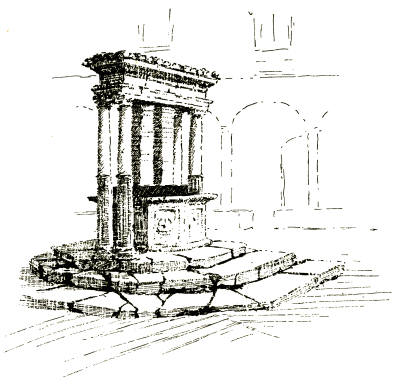
FOUNTAIN IN THE CLOISTER OF S. PIETRO DE' CASSINENSI.
Trace Perugia in his frescoes, and you will wonder
that it should be so little changed to-day. There is
the slender minaret of San Pietro de' Cassinensi, and
the great Gothic window of San Domenico, whose
cloisters are to-day a barrack, and Sant'Ercolano
soaring up beneath the city walls beside the ancient
Porta Marzia. Here you see the Palazzo Comunale,
one of the most sublime Gothic palaces in Italy, with
its curving front and delicate fourteenth-century
windows and majestic portal, and the loggia which
Fortebraccio built by the cathedral. It is all much
the same to-day as it was when Bonfigli painted his
primitive wars, except that the citizens no longer dress
in scarlet and fur, and that there are fewer towers in the
city, and none at all on the circuit of the walls.
San Pietro de' Cassinensi is still the gracious church
Bonfigli loved. We walked there one evening towards
the hour of sunset. A little rainstorm, like a petulant
burst of weeping, overtook us as we drew near, and we
saw the yellow sunset and the cloud-shadows in the
valley through a web of silver threads woven by
the rain under the acacias. Inside, it was too
dark to see the pictures with which the walls are
covered, but we gathered an impression of space and
dignity and richness. In the dim light we marvelled
at the beauty of the choir-stalls, the intarsia, and the[38]
carving in which Stefano of Bergamo, and some say
Raphael himself, gave free rein to fancy, and dreamed
of delightful mythical beasts, and sphinxes with lovely
faces, and a wealth of flowers and fruit and joyful little
children. A mad world!
Then the old monk, glad that we loved his treasures,
opened the doors of the choir, so that we might see
their exquisite workmanship in the fading light; and
we looked down upon the incomparable Valley of
Spoleto, with Assisi and her sister city, little Spello,
on the skirts of Monte Subasio, and Foligno and Trevi
rising out of rosy sunset mists. There is a small round
hill below San Pietro, just such a little hill as Pinturicchio
loved, encircled by a winding white road, and
shadowed with slender trees. We almost looked to
see his gay horsemen in red and blue and shining steel
pricking down into the plain. There were still storms
abroad, and the clouds drifted like great birds across
the heavens, casting their shadows on the valley.
'This is the work of a great artist,' said the
philosopher, with a little sigh of complete content.
And indeed it was a worthy picture to be framed in
those exquisite doors.
Night overtook us before we reached Sant'Ercolano,
which looked more like a mosque than ever with its
soaring arches in the twilight. We climbed up the
steps beside it, and passed into the city through the
Gate of True Dreams. At night Perugia of the Middle[39]
Ages awakes. As we wandered in her dark and silent
streets, ill-lit and bridged with gloomy arches, our ears
were tuned to catch the voices of the past.
We divided our evenings. Sometimes we took our
coffee and vermouth in the Piazza Vittorio Emanuele,
where there was a band or music of sorts. At other
times the poet had his way, and we visited a humble
café opposite the Palazzo Comunale, and afterwards
plunged into the dark and mysterious alleys of the
mediaeval city. These were the evenings that I loved
the most. In the distance we could hear the faint beat
of music, and up and down the Corso flowed the gay
tide of promenaders, which always turned before it
reached us. Above us loomed the great Palazzo, which
is justly Perugia's pride. In the gloom its brown and
bulging walls would have been as forbidding as a fortress's
but for the delicate tracery of its windows and its
fantastic Gothic door, with the Griffin of the City gazing
down hungrily into the night. The lovely fountain on
which the Pisani and Arnolfo di Cambio lavished their
genius was nothing but a beautiful silhouette against
the loggia which Braccio Fortebraccio put up to shield
his beloved citizens from the sun; and on the steps of
the gaunt cathedral the statue of Papa Giulio III., with
raised hand, blessed his careless people.
For Perugia is careless, beautifully and graciously
careless. She has forgotten her woes, she has almost
forgotten her old enemies; she has certainly forgotten[40]
to finish her cathedral. And yet when we sat at night
in this romantic spot, where the art of four hundred
years is garnered, we noticed a little yellow lamp
flickering unsteadily above the cathedral door, no
brighter than a glow-worm in comparison with the
flare of electric light close at hand. The passers-by
told us its history: how the people of Perugia, feeling
the iron hand of the Farnese Pope, turned for help to
Ridolfo, the last of the great Baglioni Princes. How
Ridolfo failed them, and how in their extremity they
turned to Christ, and besought Him with cries and sobs,
tearing their garments and beating themselves like the
Flagellants of the thirteenth century, to defend them
against the terrible Paul III. They placed the crucifix
above the door of San Lorenzo, where the light shines
every night, and laid the keys of the city below the
tortured feet of the Saviour. We know that their
prayers were of no avail, yet every night in Perugia,
that city of beautiful and romantic memories, they still
light the little lantern over the cathedral door, where
the crucifix was placed, when they crept with fear and
trembling to the feet of Christ to ask for help against
his Vicar, because Ridolfo Baglione, forsooth! had
failed them in their necessity.
69
[41]
A step from here and we found ourselves in the
dark and memory-laden streets of the old town, with
their vaulted passages and their blocked-up Doors of
the Dead—those pitiful defences against the Common
Enemy, in which Japan as well as Italy put faith.[5] Of
them all I loved the Via Vecchia best, with its air of
mystery and its many arches linking the grim old
palaces together. At night it was so gloomy there that
we could barely find our way past the ancient Canonica
in which so many of the Popes snatched a holiday from
Rome; and as we went down the hill, always between
great palaces, the darkness closed round us. Here and
there a feeble light illuminated the steep path, but for
the rest there was only the starlight to guide us until
we came to the great Porta Augusta, which spanned the
road majestically, full of the dignity of dead Etruria.
Seen thus against the stars, with its graceful fifteenth-century
loggia faintly illumined by a yellow light
within, it was as impressive as the pylon of an Egyptian
Temple.
Or, if our steps took us another way, we passed the
grim towers of mediaeval mansions, and presently found
ourselves at the Baglioni's Gate of Dreams, or the
Porta Mandola, as the Etruscan gate is called. Here,
of a certainty, we would hear music, for whenever I
have passed through that ancient gate at night, the[42]
silence has been broken by gay songs. Sometimes I
have sat there far into the night, dreaming of the
Baglioni and listening to the careless music of I knew
not what laughter-loving house. For no one can live
long in Perugia without being fired by the memory of
those strange men whose strength and beauty was
famous throughout Italy, and whose lovely names alone
fit them to be the heroes of romance—Grifonetto,
Astorre, Gismondo, Sermonetto, Morgante. If we
believe their adoring chronicler, who though he traced
their downfall could not speak of them without the
stately prefix 'High and Mighty Lords,' their beauty
was the beauty of the ancient Gods of Greece, and
their courage was the courage of the Heroes. And
who of us but has wept over the Great Betrayal, and
the passing of the beautiful Grifonetto, forgiven at the
last by Atalanta? And who has not loved the young
Astorre in his Cloth of Gold bringing his fair young
bride back to his home; and thrilled to read of the
Homeric death of Sermonetto, 'so strong and gallant
while he lived that tongue of man cannot tell the
worth of him. One, in very truth, who never in all his
days knew what fear was, and till the last word died on
his lips ever showed himself the greater-hearted, as
though he were not vanquished, but victor of his foe.'
73
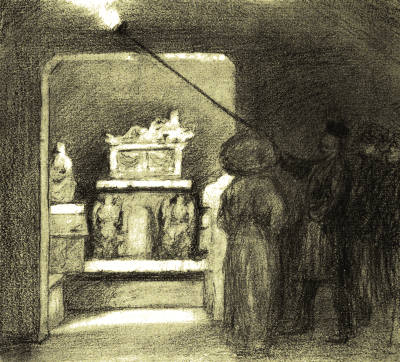
Perugia: the Tomb of the Volumnii.
[43]
Early one hot and cloudless August morning, while
the farmers with many cries of 'per la Madonna!' were
urging their oxen up the hill to market in the shadow
of the old grey University of Perugia, we drove down
into the Valley of the Tiber to see the wonderful
Etruscan tomb close to Ponte San Giovanni, which
was the burial-place of the Volumnii. It is of special
interest not only for its excellent preservation, but
because it belongs to the Roman-Etruscan period, and
forms the connecting link between the old Etruscan
tombs and the famous Roman sepulchres a mile or two
outside Rome on the Latin Way.
A short descent took us into the subterranean vault
at whose portal, cut out of the tufa rock, lay the ancient
stone door, set aside now for a modern gate of iron.
As we passed into the dark antechamber the chill
damp air was cold as death after the cicala-haunted
sunshine of the fields above. But while we strained
our eyes to pierce the gloom the custode turned on an
electric light hidden behind the cornice, and straightway
we forgot everything in the wonder of the scene before
us. In an inner chamber, resting upon their carved
sarcophagi, we saw the inmates of the tomb grouped
round the urn on which reposed the head of the
house above two finely sculptured furies. On the
coffered ceiling a gorgon's head, very terrible, with
knotted snakes on its temples and horror in its face,
stared down upon the dead. And as our eyes became
accustomed to the dim light we discovered the strange
symbolism of Etruria all round us. From the ceiling[44]
of the ante-chamber, on whose benches the relatives of
the deceased reclined, to feast or watch beside their
dead, little genii, exquisitely beautiful and light as
butterflies, were hanging by the leaden chains by
which they were suspended more than two thousand
years ago. Over the doorway was a sun-disk, springing
from the waves—fit emblem of the immortality of these
Etruscans, springing from the waves of oblivion which
for so many centuries washed over them. But there
was none of the colour which makes beautiful the
Tombs of Egypt, and there was hardly the same air of
eternity. In the long corridors of the Royal Tombs of
the Pharaohs there is an archaic defiance as of a life
long since forgotten and lost in the dust of centuries.
Here the life is of yesterday; we could almost hear
the heart of Greece and Rome beating gaily in a
young world, and the languid tread of the effete
Etruscans, whose curious symbolism at once repels and
mystifies, with its red lascivious serpents, its demons
and furies, its beautiful and reluctant Medusas, and its
solemn mockery of the feasting dead.
[45]
TODI
When I think of Todi the first things that I remember
are the golden tassels of the corn against the
sky, and the blue chicory which starred the dusty
roadside as we drove to her from Perugia across the
young Tiber. For little Todi, enthroned on her steep
hill, has no railway within thirty-three miles of her
gates; and if you do not wish to ravish the leagues
which separate her from the world by motor, you can
only reach her after many hours spent in the exquisite
and touching beauty of the Umbrian Vale. She is one
of those forgotten cities which are still to be found
on the hills of Italy. The years have trampled
lightly within her ancient walls; she has no trains,
no jangling trams, very few motors except the grey
automobile from Perugia which bursts noisily into
the heart of her every day. She is a charmed city,
whose name is painted on a signboard outside the
gates lest the traveller should pass her by unwittingly.
Within her walls we shook the dust of a work-a-day
world from our feet, and forgot its turmoil in
the music of her bells, which tell the passing hours[46]
with the loving persistence of those grown old in
labour.
To many people Todi is a mere horizon of towers
on the crest of a distant hill. To me she is the dwelling-place
of happiness. And because I am a little
jealous for Todi, and would have you love her as I
loved her, having watched her grow in beauty as the
miles decreased between us, I beg your patience while
we thread the plain between Perugia and Tuder of the
Umbrians.
It was a day of sun and shadow, an ideal morning
for an expedition into Arcady, and we found the
beauty of a young world down in the Valley of the
Tiber. The jangle of harness-bells called us early
from our breakfast, and the air was like wine cooled
with snow as we drove down Perugia's four-mile hill,
past her great churches, and on to the long white
road where the vines are linked together for miles
in festoons of archaic grace. The only people that
we met were peasants toiling barefoot in the sun.
Their olive skins were deepened to pomegranate;
they had lithe figures; their finely moulded heads
were set on long, slender necks; and when we
saw them working under the olives, or coming
towards us along the dusty road from some village
fair, leading the milk-white oxen whose horns were
bound with scarlet fillets, we knew that these were the
ideal shepherds among whom the Gods of Greece were[47]
content to dwell. Their white homesteads rose from
fields of maize and corn, and among the vineyards and
olive-gardens were crops of tomatoes and hemp and
pumpkins, and always figs and mulberries, for Umbria
is the land of plenty, the home of Maia, and of
Hermes,[6] her light-hearted son. The vines which
linked the mountains to the plain had the beauty of
a classic frieze, and when our eyes turned from the
dappled hills we saw flowers weaving a multi-coloured
web on the loom of dusty grass by the roadside—purple
loosestrife and scabious, blue chicory, sugamele
and rare borage, poppies and pink veronica, yellow
spanocchi, dandelions, and golden broom. All the
dyes of the East were woven there; and brambles
and blossoming clematis stretched out long swaying
arms towards the little shrines with which the fields
were strewn, or twined a crown of flowers and thorns
about the rust-worn symbols of the Passion on a lonely
crucifix.
Little cities which had been hidden in the folds of
the valley grew into our horizon—Torgiano, towering
on our left, Deruta and Ripa Bianca. Our road, which
had run in a straight line across the plain from the
foot of Perugia's hill, crossed the Tiber on a bridge
with a fifteenth-century gate-tower, and turned along
the banks of the river. Tall Lombard poplars lingered
on its brink, and peasant women in gay kerchiefs were[48]
washing linen in its green water. Across the valley
we could see Perugia, most beautiful of all hill-cities,
smiling in the sunshine, already far away; and in front
across a sea of lesser hills rose Todi, perched on her
mountain like a city in a fairy-tale, which surely could
be reached by no other way than on the wings of a genie!
We rested our horses at Deruta, and clambered up
into its precipitous streets. It is a mere hamlet, though
a great deal of majolica has been made here for the
last three hundred years, and it is extremely picturesque,
perched high over the Tiber. Deruta is like a piece of
its own pottery. It is built of gray stone, much the
same colour as the unglazed plates which we saw
drying on the walls, and its people dress in bright
colours like the pigments on the finished ware. Every
one goes barefoot here, and the old women toil up the
steep stair-streets with their sandals slung over their
arms, and huge bundles of sticks or fodder on their
backs. And apart from its picturesqueness Deruta is
well worth a visit for the sake of a beautiful fresco
by Caporale in Sant'Antonio Abbate.
After Deruta the Umbrian Valley was all vineyards
and olive-groves and fig-trees and acacias. Sometimes
the Tiber was close beside us like a blue ribbon dividing
us from the plain as we jangled through the cicala-haunted
woods on the hillside; at others we could only
trace it among the vineyards by the tall reedy poplars
which followed its winding course.
[49]
The day grew hotter; the song of the cicalas
swelled up like an anthem, and the butterflies drowsed
upon the flowers. Presently we came to a wayside
fountain, where a lovely girl with a jar of water poised
on her head was talking to a young herdsman, beautiful
as an Apollo, who was watering his oxen. There was
a garden of ancient olives on the hillside above, and
a welcome shade for our horses in the road. And
because we had seen Todi on her hill, and that she
was beautiful, we ate our lunch and took our siesta
there under the olives in the scented air. Near at hand
a boy was singing like a lover at his work; there were
flowers at our feet, and cicalas fluting in the silver
foliage overhead. The great white oxen were still
drinking at the fountain, and their bells made pleasant
music; sometimes a woman with a water-jar on her
head came from the village, or a peasant rode by on
his mule. It was a magic day. We had had so many
hours of joy, so many hours of sun and wind and
beautiful primitive things, that we had left care behind
us. As we lay there on the soft earth and watched
the cloud-shadows sweeping over the hills, we forgot
the toil of life; we no longer heard the world throbbing
its soul away in its great cities. The voice of the wind
mingled with the shimmering music of summer—the
insects, the song of the boy at work, and the bells
of the oxen, in a paean of joy. For Umbria is like
that garden in which Siddârtha dwelt with Yasôdara,[50]
shut off from all ugly and painful things. If you look
deep enough you will assuredly find death, even as
Siddârtha did—the hawk preying upon the small bird,
the small bird upon the gnat, and you will see the
sweat upon the oxen as they strain in the sun. You
may find the world as sad a place, as full of pain and
toil as he did, or you may find it just such a mirror
of God's Love as did Francis, the chief of Umbrian
saints. Here the butterflies seem to dance more gayly
than they do elsewhere, the trees grow free, the flowers
stretch upwards to the sun; no questions vex you when
you see a wayside shrine. In the garden of Umbria
there are only God and Nature, the Soul of Things is
at ease.
So, with our hearts attuned to her simplicity, we
came to Todi on the top of her hill, with her towers
and walls, and her winds and clouds. We caught her
asleep in the siesta hour. There was no one astir when
we drove into her beautiful golden piazza, where the
Middle Ages have never been forgotten: even to-day
it is full of mediaeval grace, with its two great palaces
and its exquisite cathedral. But if we had come to
her in the busy morning stir of the market we could
still have found the Middle Ages there, for the peasants
ride in on the old leather saddles picked out in brass
and scarlet that we see in fifteenth-century frescoes;
the asses bear on panniers barrels, or huge bundles of
rough wood; the mules are harnessed with bells and[51]
tassels, three abreast, so that they straggle across the
narrow road as they strain up the hill, and all the
women carry their marketing on their heads.
The cathedral of Todi is one of the gems of
Umbrian architecture. It is a great golden church
with beautiful and very ancient doors, and an ornate
rose window; it soars above the piazza on a wide
flight of steps which not even a gigantic cinematograph[52]
advertisement can rob of dignity. Below its southern
wall is a row of shabby little shops where the people
sit at work in their doorways, but the northern side has
flying buttresses and a cornice of fantastic heads of
men and birds and beasts; and there is a pleasing
baroque arch with shallow, grass-grown steps leading
down to the piazza.

DETAILS FROM THE APSE OF THE CATHEDRAL OF TODI.
Like her cathedral Todi is full of quaint and
beautiful things. She is an artist's city, solitary and
beautiful, unexpectedly rich and frankly poor. Once
away from her stately piazza with its three great buildings,
which are like three jewels in the crown of King
Cophetua's Beggar Maid, we found her humble and
out of elbows. Her old brown houses bulged out
over the steep little streets, or towered like lean fortresses
on her city wall, with all manner of green things,
even fig-trees, growing out of them. From below they
seemed to be piled up one on the top of the other like
children's bricks. The vineyards and olive-gardens,
which swept up the hillside, forced entrances at every
point; and on the crest of the hill among her palaces
was one slender cypress spire, soaring up as though
Nature herself must climb through this clear air to
heaven. She had long avenues of acacias and flowering
laurels, and ancient gateways like the Porta Aurea,
through which we had a vista of mediaeval towers, and
a Perugino landscape of green valleys with a river
winding away to the amphitheatre of blue hills. Here[53]
and there in her walls were courses of splendid masonry,
Umbrian perhaps, and on the eastern side of the town
were four gigantic niches of a Roman basilica. But as
in most Umbrian cities, it was the Middle Ages that
left Todi her chief treasures, her stately palaces and
her cathedral; and further down the hillside, on a
flight of earthquake-riven steps, San Fortunato, which
was the home of the Antipope Nicholas v. in the days
when rebellious little Todi was a thorn in the side of
the papacy, and Lewis of Bavaria made her his headquarters.
Fra Jacopone of Todi, the author of Stabat
Mater Dolorosa, is said to be buried in this church, but
though we looked for it we could not find his tomb.
All these things count as nothing in the eyes of
the Todesi, for Todi boasts a pilgrimage church; and
a pilgrimage church, albeit of the sixteenth century,
is an acquisition not to be despised by any city however
ancient and picturesque. But in truth Santa Maria
della Consolazione is a lovely church, a capolavoro of
architecture, and it soars up like a great golden gourd
ripened to perfection on the green hillside. We came
to it through the Porta Aurea along an avenue of
flowering laurels, and its fair proportions gave us a
complete sense of satisfaction. As we drew near, its
clustered domes dwarfed the amphitheatre of hills.
Inside it was airy and gracious, a bubble of light; but
its sixteenth-century paganism, which is always the
paganism of secular buildings rather than of temples,[54]
and its overgrown apostles in the niches that were
meant for gods, spoilt its appeal, to the Protestant
mind at any rate, as a house of prayer. What is it,
I wonder, that makes it easy for the Protestant to
worship in Gothic or Romanesque churches, and to
respond to the appeal of basilicas like Santa Maria
Maggiore or San Clemente in Rome, while sixteenth-century
churches still remain the ideal ecclesiastical
building to the majority of Roman Catholics? Is it
that they all bear the image of St. Peter's and the
Vatican in their minds? They argue that at least[55]
under the spacious cupolas of the renaissance they
have light and space. And it is logic, for Gothic
cathedrals are dim and full of shadows. But I could say
my prayers more easily in the baths of Caracalla, where
the sun slanting over the broken walls has a trick of
making mist like floods of incense, and the birds chant
all day long, than in St. Peter's, for all its fragrant
services. And I doubt if any Catholics could be moved
to such an ecstasy of worship in the dusk of Milan
Cathedral, when the organ throbs through the aisles at
Vespers, as we have seen them in many of the late
pilgrimage churches of Italy, like Santa Maria of Todi
or the great basilica of the Casa Santa at Loreto.
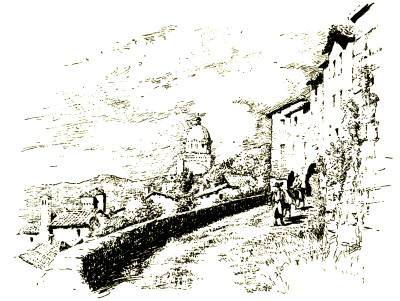
TODI: S. MARIA DELLA CONSOLAZIONE.
Like all the hill-cities of Umbria, one of Todi's
chief charms is the beauty of her views. Below my
bedroom window in the Hotel Risorgimento the old
brown roofs of Todi clambered so eagerly down the
slope that each one was at least two stories below the
one above. Here and there were little gardens full of
tamarisks and oleanders and morning glories. To the
left rose San Fortunato, high on its broken flight of
steps, like a grim fortress; and below it was the bastion
of the public garden, with its round acacia trees which
were always vibrant with the song of cicalas. In the
deep valley were grey-towered farms with loggias and
outside stairways, and a great fortified convent with
the stations of the Cross climbing up to its gates
in a cypress avenue. Through the midst the Tiber[56]
wound very slowly like a ribbon, and now the
sunlight caught it, and we could see the blue water,
and now we could only trace it by its tall Lombard
poplars. But always it turned towards the distant hills
which rose the one behind the other, fold on fold, and
full of changing lights, towards Rome. At night it
was still and mysterious. The steep hillside was
wrapped in darkness. There was no moon, and though
the sky was powdered thickly with stars they gave no
light to see the valley by. Far below I could hear the
humming of the night crickets; they sounded sleepy
too. And up above, San Fortunato loomed almost
transparently in the heavens, and the Milky Way shone
like a mist of stars.
We found Arcady again down in the valleys as
we drove back to Perugia across the Umbrian plain.
There had been a fair at some neighbouring village,
and the road was full of peasants coming back with
cortèges of white oxen and calves, which had bells on
their throats, and collars of scarlet and brass, and
crimson fillets.
Perugia lay before us all the way, with her towers
and majestic walls and the slim campanile of San Pietro,
which looks like an obelisk from the plain. As we
drove along the straight white road we saw the cities
of the Valley of Spoleto rising like stars upon their
hills. At each turn fresh mountains were disclosed
with fresh cities on their skirts, pink in the evening[57]
sun. We were tired after the heat of the day, and
silent. The harness-bells and the clipping sound of
hoofs made an agreeable accompaniment to our
thoughts. We climbed up slowly through the sunset,
looking now at the hills, now at the olive-gardens that
stretched away from the road, their leaves as silver as
a flight of butterflies in the sunlight; now idly watching
the long-legged shadows of the horses on the flowery
bank. And all the way the cicalas were singing by the
roadside, and we bore the memory of fragrant sunlit
hours in our hearts. Half unconsciously, and like a
message from the eternal hills, St. Paul's words came
into my mind: 'Whatsoever thing is good, whatsoever
thing is pure, whatsoever thing is lovely, whatsoever
thing is of good report, if there be any virtue or if
there be any truth, think on these things.' They were
like an answer to the riddle which all men ask of
Fate. But indeed in this Umbrian garden they are
the text of everyday life, for in its byways it is easy
to catch the spirit of St. Francis as he passed, barefoot
and meanly clad, singing the praise of God and
all His creatures.
As we drove up the last steep incline the plain
was filled with light. Overhead the clouds were growing
rosy. Assisi was a city of gold. And to the
horizon rolled the Umbrian hills, purple and blue,
and very far away like jade, airy and transparent, in
the luminous space which Perugino loved to paint.
[58]
SIENA AND THE PALIO
It was the poet who persuaded us to go to Siena to
see the Palio run in honour of Our Lady of Mid-August.
We were still in Perugia enjoying the
languid Umbrian summer, when he announced his
intention of leaving the next day for Siena.
'What is the Palio?' asked the philosopher.
'August will be very hot in Siena, and nothing could
be more beautiful than this'—he waved his hand
towards the white walls of Assisi, and the great dome of
Santa Maria degli Angeli, floating like a lotus bud
above the morning mists, which filled the valley
between Perugia and Monte Subasio.
'It is so difficult to define,' said the poet. 'When you
say, "What is the Palio?" you give me the wherewithal
to write a book. If I told you that it was a race in
honour of the Virgin Mary, ridden bareback round the
chief piazza of Siena, by jockeys in mediaeval costume,
who try to club each other off the course, you would
probably prefer to stay here in Perugia. If I told you
that it was a pageant you would be sure to say that
you have seen better at Olympia.'
[59]
He was silent for a moment.
'But it is more than that. Imagine a city of Gothic
palaces, a little flushed hill-city, sleeping among vineyards
and olive-gardens, sleeping and sleeping like a
girl bewitched. And then imagine the soul of her
awaking for a few hours—a day perhaps—in the
summer of the year. That is Siena, dear gay Siena,
with her indomitable spirit and her fickle careless heart,
with her pageants and her saints, and her allegiance to
Madonna. For first and foremost Siena is the city
of the Virgin Mary. There they think of her not
only as the Mother of God, but as their own liege
sovereign; even the Standard of the City, the black and
white Balzana, is emblematic "of the purity and
humility of the Virgin, or of those joyful and sorrowful
mysteries whereby, as she told St. Bridget, her life was
ever divided between happiness and grief."
'As for the Palio, if you would appreciate it you
must understand something of the religion of the Middle
Ages, which was at its best an inspiration, capable of
producing St. Francis and St. Catherine, and at its
worst a creed of superstitions which found vent in
wild orgies of penance, and countenanced the crusade
against the Albigenses. You must have thrilled to
stories of wild games, like the Florentine Giuoco del
Calcio or Perugia's Battaglia de' Sassi, in which the
players lost their limbs and not infrequently their lives.
And lastly, you must appreciate the intense patriotism[60]
which the men of Siena feel for their contrade, or
divisions of the city, which I can best describe as
parishes; though it is difficult to say whether, in
the first place, the boundaries were parochial or
military.
'It is not merely a pageant, though as a pageant
it is superlative; it is the last flicker of the spirit of
the Middle Ages. And for my part I love it, because
the Sienese are still so mediaeval at heart. And that
is why there is no city in Italy more fitted to be
illumined by the torch of the Middle Ages than Siena.
For Siena, notwithstanding the fact that she bred
some of the greatest Renaissance popes, was comparatively
untouched by the wave of paganism which swept
over Italy in the sixteenth and seventeenth centuries.
She still has whole streets of Gothic palaces; her saints
are still reverenced with the almost child-like simplicity
of the Middle Ages; she still boasts the special protection
of the Blessed Virgin; and in the midst of all her
fervour she still nurses her old feuds, not only with her
ancient enemies, the Florentines, but between her own
contrade.'
It was dark and the heavens were full of stars
when we bade good-bye to our kind host of the
Perugian inn, and boarded the electric tram that was
to take us down to the station. We had chosen an
early train so as to avoid travelling in the heat of[61]
the day, but we found the car already full of thrifty
Italians bent on making hay before the sun shone.
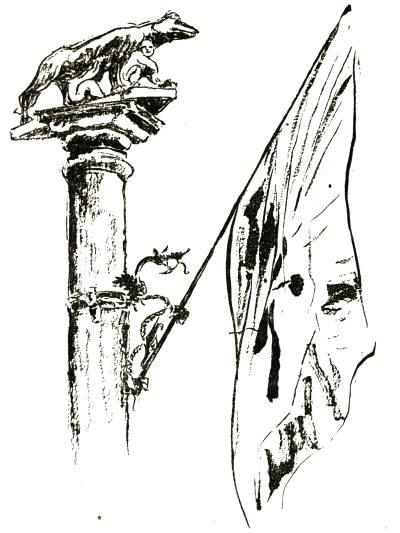
We left at dawn, in the clear pale light which
floods the Umbrian plain when the world is yet a
little grey, and Perugia is nothing but a lovely outline
on the crest of her hill. This is the light that[62]
Perugino loved, the shadowless herald of the day, full
of the mystery of the morning. The world woke
slowly from her pale slumber in the arms of night;
the sky deepened from beryl to gold. We found
Thrasymene illumined with rosy morning fires, her hills
empurpled, and the towers of her little cities aflame with
sunrise. It seemed as though immortal memories, great
desires, and burnt-out passions struggled for utterance
there. How Hannibal's tired eyes must have ached to
possess so fair a land! Yet it is likely that he never
saw the passionate dawn wooing the lake with plumes
of rose and gold, as we did; for we know that on the
fateful day when he waited to give battle to Flaminius
by the shore of Thrasymene, the mists which
did him such signal service filled up the hollow like a
curtain hung from one range of mountains to the other.
So we came through Tuscany to Siena, and found
her all agog with excitement for the Palio, with pennons
flying and music echoing down her streets, and her inns
already full to overflowing.
Ah, Siena, with your gaunt red palaces and your lily
tower, and your ineffectual walls which thread the vineyards
like old men dreaming life away in memories, it is
you who are the heart of Tuscany! You are not pale
and beautiful like Florence, not such a great lady; nor
have you the silent grace of Pisa, but how lovable,
how intimate you are! Their dignity would ill become
you with your stormy and undignified past, of which De
Commines said: 'La Ville est de tout temps en partialité,
et se gouverne plus follement qu'aucune Ville d'Italie.'
95
[63]
But in no other place is the traveller welcomed
with such song and laughter as in Siena, when she
holds high festival. I, who have only seen her in her
Palio days, cannot think that life is ever dull or languid
in her streets and piazze. I have peopled her with
mediaeval ghosts since that day in mid-August when
I woke and found them in possession. At every
sound of music I look round for silken banners, and
pretty boys in doublet and hose escorting steel-clad
warriors, or the gay spendthrifts of whom Folgore of
San Gimignano sang. For on that day I caught a
glimpse of the Middle Ages, with their knights and
pages and their companies of men-at-arms. I heard
the brave music of their drums, and saw the old Siena,
ruddy and black-browed, clamouring loud-voiced in the
Piazza del Campo—a happy child one moment, and the
next a bundle of conflicting passions, remembering
century-old grievances, and raking up dead feuds to
make a Tuscan holiday.
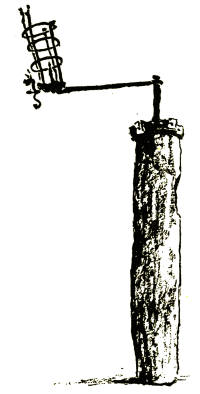
It was in the Piazza del Campo, or to give it its
modern name which does not please me half as much,
the Piazza Vittorio Emanuele, that I grew to know
Siena best. Here she was the city of the Quattrocento,
of which I love to dream, fantastic and beautiful,
with untold possibilities lurking behind the walls of her
tall red palaces. The Campo lies in the hollow where[64]
the three hills of Siena meet, and its shape is an
irregular semi-circle. I can best describe it by saying
that it is like an enormous cockle, slightly concave—rose-coloured,
for it is paved with red brick—and
with ribs or flutings of grey stone which converge
towards the deepest hollow in
front of the Palazzo Pubblico.
Encircle this by a wide, flagged
roadway, and ring it round with
noble palaces, many of them of
great beauty, with Gothic arch and
lancet window. At the deepest
hollow of the shell build up a
palace for the rulers of the most
unruly republic in the whole peninsula.
Fashion it of exceeding
beauty with a façade which follows
the curve of the piazza. Build it
of Siena's red brick; break its long
lines with Gothic windows cloven
by slender columns; grace it with
magnificent arched doors; decorate it with scutcheons and
crests; and high on its wall place the golden monogram
of Holy Flame which Bernardino, Siena's gentlest saint,
identified with his life. At its side build an arcaded
chapel of white marble, stained by time, filled with the
faded frescoes of Il Sodoma; and from this chapel
picture yourself a tower, not like the tower of any city[65]
out of Tuscany, which springs up into the heavens with
the natural grace of growing things, so that you do not
think of it as brick or stone, but as some beautiful and
splendid flower which grew up in one mediaeval night
while Siena slept, and has blossomed ever since.
Even Florence cannot show the like of this. It is
so beautiful and characteristic that it is worthy of
mention beside the Piazzetta of St. Mark's at Venice.
And at night it is a revelation of the Middle Ages to
pass from the Via Cavour, with its lighted shops and
its gay streams of men and women, into the dim and
romantic Campo. Night covers the passing of time.
The song and laughter of modern Sienese life, flowing
down to the Lizza to promenade, comes like an echo
across the years. It is very still in the Campo at night,
and empty except perhaps for Beppo, the seller of
water-melons, whose guttering candle suffices to show
his pink and succulent wares. But one evening while
we stood in the shadow of the Palazzo Comunale we
heard some stray musicians singing an old choir-chant
in the Via del Casato. It was as though the ghosts of
pilgrims were toiling up the Via dei Pellegrini, just as
they used to do, past the great ruined palace of Il
Magnifico, to lay their troubles at the feet of the Queen
of Sorrows. Overhead the Torre del Mangia, released
from the shadows of the battlemented court, soared up
to the stars more like a lily than ever with the moonlight
silvering its machicolations. And we remembered[66]
that in the morning we had seen it with its head
in the drifting clouds, and the sunlight below.
But it was not only for its mediaeval beauty that
we loved the Campo. This is Siena's heart. Here she
has fought and loved and hated and rejoiced, ay, and
died too. And if her stones have been too often stained
with blood in civil warfare she has gentler memories—here
Provenzano Salvani, the victor of Monte Aperto,
cast all dignity aside 'when at his glory's topmost
height,' and begged for alms to ransom a friend who
languished in some foreign prison; here Bernardino
preached so eloquently of Divine Love that he almost
moved the unregenerate young Aeneas Sylvius Piccolomini,
afterwards Pius ii., to repentance. And here,
while the armies of Spain were beleaguering their city,
and they were faint for food, the youths of Siena came
to play their games till they were called back to guard
the city walls, to the joy and amazement of Blaise de
Montluc, the French Governor, who never tired of
praising the Sienese for their chivalry and the courage
and beauty of their women.
Here, too, in a few days' time, came Siena and all
the strangers that were within her gates to see the
Palio!
101
[67]
The Prove were run first. Early in the week a sandtrack
was prepared, and as if by magic an amphitheatre
of seats sprang up round the piazza. There are six of
these prove, or trial races, for the selection of horses for
the Palio; and they are run on the evening of the 13th,
the morning and evening of the two following days,
and the morning of the 16th of August.[7] The Palio
festivities really begin on the 13th of August, for
although the Sienese do not attend the prove in
great numbers there are generally some thousand
spectators who shout themselves hoarse with excitement;
and feeling sometimes runs high when there is
rivalry between ancient enemies like the contrade of
the Oca and the Torre.
On that morning, too, the streets are full of peasants
driving their white oxen in pairs before them to the
annual fair, which is still held outside the Porta Camollia
in honour of our Lady of Mid-August. It has
dwindled considerably from the seven days' fiera which
marked the occasion in the Middle Ages, but it is still
a picturesque sight. The peasants drive standing up,
like Roman charioteers, behind their milk-white steers,
whose heads are bound with scarlet fillets, and their[68]
soft dewlaps girdled by a bell. The sellers of water-melons
do a thriving business with the thirsty drovers,
and the piazza is a sea of tossing horns and smooth
white backs from the battlemented city wall to the
column which marks the spot where Leonora of
Portugal met her betrothed, the Emperor Frederick III.
On Sunday Siena was comparatively quiet, although
there were prove in the Piazza del Campo both morning
and evening, and a general air of merriment throughout
the city. We heard mass in the cathedral where the
banners of the various contrade hung from the piers of
the nave; and the wonderful graffito pavement which,
according to a seventeenth-century custom, is covered
with boards for the rest of the year to preserve it from
injury, was laid bare. And then we went down to
Fontebranda to see how the Contrada of the Oca, Saint
Catherine's contrada, was preparing for the Palio. We
found it delightfully confident of victory. The sacristan
of Saint Catherine's house took us into the chapel
which was once her father's workshop, and would not
let us go until we had heard the history of the many
Palii which the victorious Oca had won in past years—assisted
no doubt by the prayers of Santa Caterina in
heaven to the holy Mother of God.
105
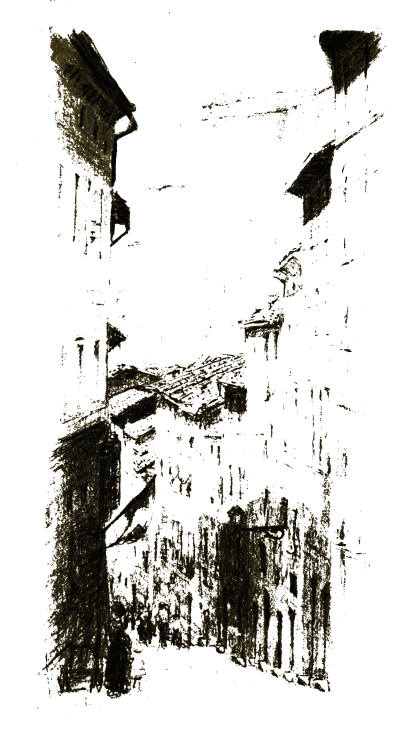
Siena: S. Domenico and the Via Benincasa.
[69]
The philosopher loves Fontebranda. To him it is
the most romantic spot in Siena. It is certainly one
of the most picturesque, whether you stand at the head
of the steep Via Benincasa and see San Domenico's
gaunt red walls towering above its houses, or whether
you look towards the city from the church. A winding
road leads up through gardens from the Valley
of Fontebranda to the city gate. Above the wall tall,
green-shuttered palaces rise tier on tier to the cathedral,
whose delicately arcaded dome and tower crown the
hill. To the right the loggia'd houses of the tanners
sweep down the Via Benincasa to Fontebranda's mediaeval
fountain; and the keen, unpleasant smell of the
tanneries, which was one of the first things we noticed
in Siena, is everywhere. Fontebranda is changed
but little since the days when Saint Catherine lived
there with her parents. Then as now it was full of
tanneries, then as now the men worked half in their
dark windowless shops and half out in the street: in
her day the loggia'd houses were here; the yellow skins
were drying in the road; and San Domenico, up whose
hill she toiled to prayer, was the same grim fortress-church
as now.
But I do not love Saint Catherine, her warlike
spirit notwithstanding; nor do I love Sodoma's
frescoes of her in the great church on the hill. And
the Sienese themselves, though they give her great
honour, do not seem to love her as they love the simple
Bernardino. Splendid as her chapel is, magnificent as
are her festas, she seems to be less in the imagination
of Siena than Saint Bernardino, whose gentle life
followed closely on hers as though the genius loci[70]
dared not trust her unruly people through that
stormy century without a guiding spirit. See on how
many houses is his seal of holy Flame! And how
brightly it burns on the Palazzo Pubblico, especially
towards nightfall, when the setting sun gilds the façade
and fires the sacred monogram.
'Respect is what we owe, love what we give.' And
so I would leave the philosopher to St. Catherine and
his Fontebranda, and come to San Francesco and the
little chapel beside it where San Bernardino prayed.
The Sienese have lavished lovely things upon this
oratory of the ardent boy, who forsook all and followed
Francis in the love of Christ. Sodoma, Pacchia and
Beccafumi have glorified it, and peopled its walls with
the beautiful and mystic-eyed women of the Renaissance.
But though they have enriched it, I am glad
that circumstance has kept St. Francis' great church
as it was first conceived—a bare and solemn building—a
church for the followers of the man who loved poverty
and simplicity, because through them he saw the way
to God. Even now I would have it cleared of its
black and white Sienese stripings; but its wide empty
nave, the noble chapels of its transepts, its ruined
islands of fresco, its stillness and its great simplicity,
make it beautiful.
San Francesco stands on the southern spur of the
city, and from the ancient Porta Ovile in the valley
below, a country road leads through gardens and[71]
cypress-woods to the Convent of the Osservanza, in
which Pandolfo Petrucci the Magnificent, one of
Siena's great failures, lies buried. The brother who
took us over the church showed us the cell of
Bernardino with its ancient wooden door nibbled
almost to destruction by ardent pilgrims. And from a
window in the old monastery we looked across the
valley of pines and cypresses to Siena, painted against
a glowing sunset sky. Seen thus across the fruitful
Tuscan vale she was still the City Beautiful which
inspired San Bernardino to a passion of eloquence on that
long-distant summer day, early in the fifteenth century,
when he climbed up into a tree and addressed the
astonished multitudes 'in words so inflamed with divine
love, that while many wept, there were some that
deemed him mad.' Then as now her towers, though
there were many more in Bernardino's city, were like
the hands of suppliants held up to heaven; then as
now the great dome and Campanile of Santa Maria
Assunta set the seal of Madonna over her troubled
people.
We looked long. In the church overhead the monks
were intoning, and the song of the cicalas floated up
from the fragrant cypress-woods as though they too
were praising God. The sun went down, and little
white wraiths of mist rose from the valley. The air
blew chill. When we departed the monks had long ago
ceased chanting, and the insects had folded their wings.[72]
But as we hastened through the vineyards where the
mists fled from us like pale ghosts, the lights of the city
twinkled a welcome to us through the gathering dusk.
And so we came again into the warm heart of
Siena.
Boom! Boom! Boom!
It was different from any other sound. At first I
thought it was a part of my dreams, for it vibrated over
the city like an orchestra of bells.
Boom! Boom! Boom!
Then I remembered, and sprang out of bed. It was
the 16th of August, the day of the Palio, and that
deep music whose echoes were throbbing round the
countryside was the voice of Siena waking from her
long slumber. It was the first time that I had heard it,
and my heart beat faster, for the tocsin of La Mangia
is nearly always silent now, although it played such a
great part in the mediaeval history of Siena when it
used to call her citizens to arms in the name of God
and the Virgin Mary!
My window looked down on a silent street winding
between tall shuttered palaces. As a rule it was
empty except for the milk-woman going from door to
door in her big straw hat, and a worn-out Comacine
lion which grinned sardonically at me from an ancient
tower opposite. But to-day peasants were pouring
up the hill—the men in their black wide-awakes and
Sunday clothes, and the women, old and young alike,
in their silly Tuscan hats which frivol with every
breath of wind, and are never as becoming as the lovely
head-kerchiefs of the Umbrians. They are worn on
the backs of the heads; the soft brims, which are not
wired, form an aureole of pale-coloured straw, and
present a deliciously incongruous effect when they frame
withered faces wrinkled like walnut-shells. I love the
bent old women of Siena who look as if they had
forgotten to be old with their ribbons and flowers and
their coquettish young hats!
111
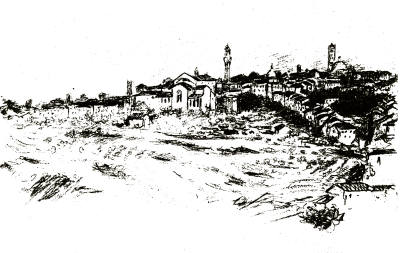
Siena from the Convento dell' Osservanza.
[73]
Yes, Siena was awaking from her slumber. I even
fancied that there was a glint of suppressed laughter in
the eye (he had only one eye, the other was filled with
lichen) of my Comacine friend across the street. Already
the city was like a hive, and the sound of a distant
crowd was like the humming of many insects. Every
inn had been full for days, and the people were still
pouring in from all directions.
At nine o'clock we went to see the last of the prove
from the balcony which we had hired from that very
agreeable haberdasher, Signor Tizzi, who has a shop
almost opposite the Palazzo Comunale. It was hot,
and the people down in the piazza were crowded together
in the shade of the Torre del Mangia, which lay
across the square like the shadow on a sundial. The
whole scene was more like a dream than a real happening.
In the dark cortile of the Palazzo Pubblico we[74]
could see the jockeys in fantastic parti-coloured suits,
waiting for gun-fire; and the fierce white sunlight beat
on the piazza, empty except for the chattering, gesticulating
belt of humanity in the shadow of the Mangia.
Bang! went the gun. And with a rattle of drums
the fantini (jockeys) came out to run their mad race, to
the accompaniment of the thunder of iron hoofs on baked
sand, and the ceaseless shouting of the good Sienese.
After the excitement had subsided somewhat we
pushed our way through the crowded streets to the
cathedral. It was empty to-day, although yesterday,
on the Festival of the Assumption, it had been full of
glorious living colour. Then the Palio was hanging
from the arch of the transept, and a great throng filled
the aisle. Then, too, the miraculous Madonna delle
Grazie, she to whom the distracted Sienese dedicated
their city on the eve of Monte Aperto, was shown to
the people; and the peasants, ever the last to lose faith,
knelt at her shrine all day. As a rule I do not love
the cathedral of Siena, notwithstanding its glorious
pavement, and rich carving, and the Pisani's exquisite
pulpit whose equal is not to be found in Italy. The
great church's black and white stripings within and
without make the eyes ache, and the over-elaborated
façade is only beautiful by moonlight. But when High
Mass is being celebrated with mediaeval splendour
within its walls, and a great press throngs the aisles, it
is bewilderingly rich. And we found it easy to forgive[75]
even the zebra stripings when we saw the poor people
of the campagna praying to their miraculous Madonna
behind the veil of sunlight which poured down from
the clerestory and made a Holy of Holies of the Cappella
del Voto.
That morning we paid another visit to the famous
Library of the Duomo, which Francesco Piccolomini
commissioned Pinturicchio to paint in honour of his
uncle Aeneas Sylvius, for we could think of no better
preparation for the Palio than studying this Quattrocento
pageantry. We are told that in his contract
Cardinal Francesco inserted a special clause, insisting
that the Umbrian artist should use a certain quantity
of gold and ultramarine and crimson in his decorations.
And truly Pinturicchio has lavished colour
on this splendid monument to the glories of the
Humanist Pope, who was a typical expression of his
age in everything, except in his great revival of the
Middle Ages, when he tried to lead a crusade against
the Turks. The room is full of sunlight and the sheen
of gold and precious stones, and Pinturicchio seems
to have caught the world in its morning, with gay
youths and maidens walking on the flower-starred
grass, and swift wild-geese high on the wing through
the clear blue heavens. But except in the exquisite
panel where the young Emperor meets his beautiful
betrothed outside the Porta Camollia, he is not such
a poet here as he is in the Appartamenti Borgia at[76]
Rome, though he is much gayer. All the more suited
to Siena, whose art was summed up by Lanzi as
'lieta scuola fra lieto popolo'; forgetting, so it seems,
the many Massacres of the Infants scattered by Matteo
di Giovanni through the Sienese churches, which are
revolting in their cruelty and ugliness!
By noon-time Siena was in a state of wild excitement.
We had been warned that the Porcupine had a
good chance of winning the race because its contrada
had drawn the horse which won the July Palio. So
after lunch we drove down to Santa Maria dell'Istrice,
which is a tiny church with a picturesque Renaissance
belfry in the Via Camollia. There were flags in the
Via Cavour, and the great Palazzo Salimbeni was hung
with banners, and had velvet cloths embroidered with
the crest of the Montone hanging from its Gothic
windows. The torch-rests and banner-holders in the
public squares each carried the proud silken banners of
their contrade, and the whole city masqueraded under
their different emblems—now the Giraffe, scarlet and
white; further on the Caterpillar, green and yellow and
blue; then the Dragon and the Wolf; and, at last, the
Porcupine.
[77]
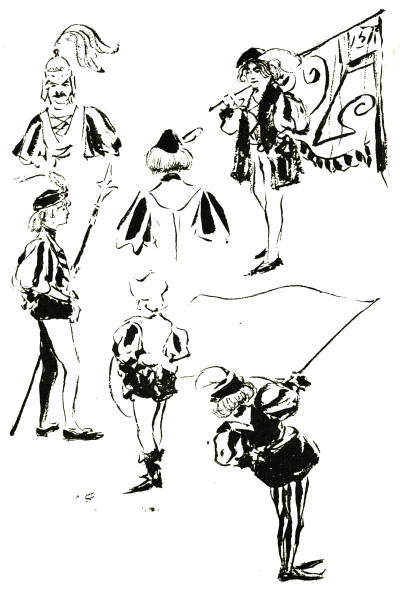
SIENESE YOUTHS IN PALIO DRESS.
[78]
In the chapel we found three men at arms and two
alfieri in parti-coloured hose and jerkins of magenta
velvet, slashed with black and white. Orestes, the
fantino, was padding his helmet in the little cupboard
of a sacristy. He was a tall, blue-eyed man, and looked
superb in his bravery of velvet and satin and lace, with
long-toed velvet boots and shining helmet. He showed
us the heavy wooden jockey cap with painted colours
which he was to wear in the race, to protect his head
from the blows of the other fantini; and, as he told us
with a shrug, he expected some, because, thanks to
Saint Anthony, his horse was undoubtedly the best,
and every one expected him to win.
The poor Captain who was to head the cortège was
in a wretched plight. He was being girded into his
armour, and it was not a dignified process. The day
was hot, and the chain mail would not meet.
Eventually some one lent him a boot-lace or a piece
of string, I forget which, and we left him, to see the
alfieri[8] tossing their banners out in the street.
After a long delay the knight appeared, looking
as dignified and composed as if he had been wrestling
in the spirit rather than in the flesh before the altar of
his chapel. And while the procession was forming up
we drove on to San Pietro della Magione, where the
Horse of the Porcupine is always blessed. The Via
Camollia, although it is one of the main streets of
Siena, is so narrow here that we had perforce to drive
past La Magione to the city gates, where it widens
out into a piazza, before we could turn and so drive
back again.
[79]
La Magione has a flight of steps leading up to a
terrace. It is a very ancient church, brown and shabby,
and many a Templar's horse has champed at the foot
of these same steps while his master prayed within;
and, it may be, shared his blessing before they started
out on the crusade.
With a rattle of drums our friends of the Porcupine
came up the narrow street. Everything was done with
such natural grace and pomp. First the tossing of
banners round the ancient well-head before the presbytery,
and then the little service which ended in the
Blessing of the Horse. The animal was led to the
foot of the steps, and the old priest after saying a
prayer sprinkled him with Holy Water. He was a dear,
intelligent beast, and behaved to the manner born. He
pricked his ears at the prayer, and though he tried to
walk up the steps, and sniffed inquisitively at the
censer, he did not even sneeze while lie was being
sprinkled. Indeed I have seen the part played worse
by many a Christian.
Then the cavalcade formed up again, the drummer
and the alfieri leading, the knight on foot with his
five pages, the fantino on horseback, and behind him a
man leading the noble beast[9] he was to ride in the
Palio. With a rattle of drums they went off to toss
their banners in another piazza.
[80]
By this time Siena was alive with mediaeval processions,
and the music of their drums was borne in upon
our ears from every side. On our way to the Piazza del
Duomo, which was the rendezvous of all the contrade,
we met many a gay company coming up the dark
alleys; or heard the stirring music of their drums as
they paused to fling their banners below the decorated
windows of fifteenth-century palaces. But the Piazza
del Duomo was the culminating point. The air was
thick with silken banners, and at every moment some
fresh contrada came up the hill, till it seemed as though
the square could hold no more. Was it by chance, or
to spite the other by diminishing his glory, that the
Oca swaggered up at the same moment as his ancient
enemy the Torre? The alfieri flung their silken
banners high into the air, catching them as they fell,
and made them flutter like a carpet round their feet, or
between their legs, or about their necks, in honour of
the Virgin. And, in faith, how could she be otherwise
than pleased to see these pretty boys with beating
drums and fluttering banners doing her honour so
merrily in the sunshine before her house!
[81]
[82]
From the Gothic windows of the Bishop's Palace
the Cardinal, who yesterday had blessed the people in
the cathedral, looked down upon the scene. Once,
when the alfieri of the Wave tossed their blue and white
flags thirty feet into the air and caught them again, he
clapped his jewelled hands. The press thickened, but
always the silken banners clove the sunshine, and the
drums sounded merrily, now in the narrow street leading
up between the vescovado and the ancient hospital,
now from the Via del Capitano. We saw knights on
horseback mingling with the crowd, and little children
of the Quattrocento, and Pinturicchio townsmen in
scarlet and green and orange and blue with fur-edged
tunics and peaked caps. It was the Pinturicchio of the
library come to life again; or rather it was the old
light-hearted Siena who, even in the horrors of the
Spanish siege, would have her games, though she had no
bread. The gay drummers of the different contrade
seemed to have caught the rhythm of her joyous
heart-beats.
When we reached our seats the police were already
clearing the course, and the centre of the piazza was a
seething crowd, with fans which fluttered like butterflies
over a field of wheat. What a gay scene it was!
The sunlight gilded La Mangia, and flamed from
Bernardino's monogram on the Palazzo Pubblico. The
amphitheatre of seats all round the course was filled,
and every window and balcony was peopled, and hung
with scarlet and crimson cloths. Up the steep Via
Casato we could see the massed banners of the contrade,
and hear their impatient drumming as they waited for
the signal to enter. The voice of the people was like
the roar of waves on a distant shore.
At last every one seemed to have been driven[83]
behind the barrier except a few sellers of beer and
lemonade. A patrol of horse carabinieri galloped
round the course. Bang! went the gun. La Mangia
gave voice. To the fanfare of trumpets and the dull
roar of the people mediaeval Siena swept into the
piazza.
Slowly and stately they came on. First a horseman
in scarlet and blue bearing the great Comunal
Banner of the city, followed by trumpeters in the livery
of the Palazzo, and then the companies of the ten
contrade who were to compete for the Palio. As each
one entered the piazza the whole procession paused for
them to toss their banners. Then with a blare of
trumpets they passed on—knights in burnished armour
with drawn swords, pages in silk and velvet with
flowing cloaks and waving plumes, alfieri with proud
banners, fantini riding slowly with their racers led
behind.
Victorious Montone, the winner of the July Palio,
came first, waving and tossing its red and yellow
banners; then came the gay Giraffe, scarlet and white;
and then the Snail, who looked depressed because
he had drawn a sorry white nag more fit for tilting at
windmills than racing. The Tortoise followed him,
yellow and blue and red; and then the Wave, in pale
blue slashed with white; and next the stately Goose, St.
Catherine's contrada, wearing the red and white and
green of United Italy. Behind them marched our[84]
friends the Porcupine in their brave purple velvet and
shining armour, and the splendid Golden Eagle and the
Blue Men of the Nicchio, and the Contrada of the
Wolf. Still they came on, with many pauses while
the alfieri waved and tossed the silken banners, now
carpeting the ground with the fluttering folds, now
whirling them round necks and under arms and legs,
or tossing them up before the Casa Nobile, till the
course was like a bed of flowers. And still the
Mangia's deep voice acclaimed, and still the trumpets
blared and the drums rolled, till the procession
stretched all round the Campo, and the great banner
of Siena at its head was furled before the Palazzo
Comunale.
Then came the Palio itself, borne on the great
carroccio decorated with the banners of Siena and her
contrade. How the people yelled as the enormous
waggon, so splendidly mediaeval with its poles and
banners and its four heraldic horses, rumbled round the
square. Before it went two rows of children, little
Quattrocento children in striped jerkin and hose,
scarlet and green and black, linked together with long
festoons of laurel. And round the car rode knights in
jousting helmets, clad in velvet and cloth of gold, on
richly caparisoned steeds with jewelled reins. Just so
did the victorious and exultant Sienese bring back the
carroccio of the Florentines which they had captured in
the bloody fight of Monte Aperto when they trampled
the lilies of Florence into the dust. And there, below
the black and white oriflamme of Siena, was a great
banner of crimson velvet and gold—the colours of the
famous banner of the Florentines, which was brought
back to Siena more than six hundred and fifty years
ago!
125
[85]
Although the tiers of seats erected for knights and
pages below the Palazzo Comunale already looked like
a bed of tropical flowers, more banners came fluttering
down the Via Casato—the comparse of the seven other
contrade who were not to take a part in the race.
They fluttered round the course to gay mediaeval
music, and joined the parterre of colour below the
Palazzo beside the great carroccio.
And now everything was ready. Two ropes were
stretched across the course at the starting-point—one
the whole width of the track, the other leaving a gap
through which the horses could pass into line so as to
get as fair a start as possible; though every one knows,
and the fantino as much as any one, that the start has
little to do with the race. His great object is to try
and place himself out of reach of the nerbate of his
special enemies, but even this is hopeless if two or
three have come to an arrangement to hold a mutual
enemy back until some outsider has carried off the
prize.
Down in the crowded square the man who was
to give the signal of gun-fire had his fuse already[86]
lighted. In the dark courtyard of the Palazzo we
could see the fantini, no longer in their bravery of
velvet and silk and burnished steel, but clad in the
colours of their contrade, and wearing on their heads
painted wooden caps to guard their skulls from the
blows of the nerbi.
Bang! There was a rattle of drums. Out came
the fantini. They moved slowly to the starting-point,
and a great shout rent the air as Siena with one voice
acclaimed them. In the crowded square, on the housetops,
from the windows and the balconies, men waved
their hats, and women their scarves and handkerchiefs.
Even little children forgot their toy balloons, clapping
their hands and shouting while their erstwhile treasures
floated away unnoticed.
They edged their horses between the ropes. Some
blows were exchanged; a horse reared, and one fantino
almost lost his seat. Bang! went the mortaletto.
Down went the ropes.
They were off!
From the start the Oca never had a chance. As
for the Snail, the whole field passed it before it had
completed one round. The Porcupine made a good
effort, but the impetuous and dashing fantino of the
Nicchio headed him off at the difficult turning of San
Martino. As they came up the hill for the last time
it was a race between the Tortoise and the Nicchio.
The Tortoise was leading, but the Nicchio overhauled[87]
him as they mounted towards the Via del Casato, and
as they came into the straight they were neck and neck.
How the people yelled! How they called upon
the Virgin and St. Antony to come to the assistance
of their contrada!
There was an indescribable confusion.
Bang! They had passed the post.
It was the Tortoise won the race!
In a flash the crowd had burst through the barriers
and flooded round the horses. The carabinieri came at
a double to the rescue of the Victorious Tartuca, for the
men of the Oca were attempting to mob him. The
horse had already been spirited away lest it should
come to harm. The great mass of people swayed and
roared.
Rattle-tap-tap; rattle-tap-tap. Through the crowd,
with an escort of stalwart troopers, came the waving
banners of Tartuca with the Palio in their midst, and
away they marched with it to get the blessing of
Madonna.
It was all over, though the Mangia was still ringing
overhead, and the people were still shouting themselves
hoarse.
'Or fù giammai
Gente si vana com'è la sanese?'[10]
[88]
SAN GIMIGNANO DELLE BELLE TORRI
'And far to the fair south-westward lightens,
Girdled and sandalled and plumed with flowers,
At sunset over the love-lit land,
The hillside's crown where the wild hill brightens
Saint Fina's town of the Beautiful towers,
Hailing the sun with a hundred hands.'
Swinburne.
We left Siena to her merry-making, and stole away
early in the morning to San Gimignano delle Belle
Torri. From Poggibonsi we drove right into the heart
of Faery-land. Were we not bound for Tuscany's
most mediaeval city, which is still caught in the web
of beautiful thoughts spun round her towers by poets
from Messer Folgore, the thirteenth-century San
Gimignanese, to our own Swinburne? Our way lay
through the rich Val d'Elsa, 'smiling in the sweet air
made gladsome by the sun.' Little hills ringed round
with the slender conventional pine-trees which Gozzoli
loved to plant in his Gardens of Paradise rose from the
billowing plain. The vines were linked from tree to
tree in great festoons, heavy with grapes; the plumy
tassels of the maize were taller than a man; the roadside
was full of flowers—bright pink cloves, crimson[89]
wild peas, chicory and Canterbury Bells. Indeed it
was a veritable Paradise, a Promised Land, not flowing
with milk and honey, for milk is sometimes very difficult
to obtain in Tuscany where there are no pasture
grounds, but heavy with wine and corn, and the manifold
fruits of the earth.
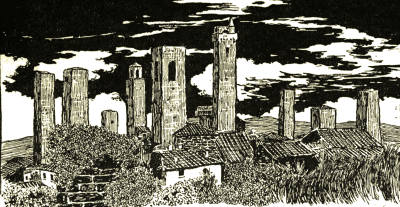
THE TOWERS OF SAN GIMIGNANO.
Long before we reached San Gimignano we saw
her towers rising up above the festooned vines like
those Giants in Dante's Inferno, which from a distance
he took to be a city of many towers. He must have
been thinking of San Gimignano as he had seen it
more than once when he rode across the Tuscan vales
from Florence, for it looks ridiculously like a city of
giants striding among miniature houses. Its thirteen
square towers of uneven heights massed on the top of[90]
its little hill make the most fantastic sky-line in Italy,
and if the chroniclers speak truth the city to which
Dante came as Ambassador in the year of grace 1300
boasted no fewer than seventy-six of these ambitious
towers.
San Gimignano is like the Enchanted Princess in
our childhood's fairy tales. I think she must have
fallen asleep one summer day, wearied with waiting
on her little hill for the Prince who was to wed her.
Perhaps she watched them jousting in the plain, those
petty princelings who tried to win her hand and always
proved themselves unworthy of her beauty and her
ancient lineage, and I know she sickened to hear their
battle-cries as they issued by night from their towers
to plunder and slay. No laughing Tuscan princess
this, but a grave-eyed dreamy girl who loved to think
of saints although she blushed and trembled at a poet's
tale, and dreamt of queening it over the valleys which
rippled from her old brown walls to Volterra, or the
fair city of Certaldo where Boccaccio was born. She
fell asleep in the fourteenth century when she yielded
up her keys to Florence, tired of waiting for the prince
who never came; and she dreams on among her flowers,
very beautiful, and happy at last with her poets and
her saints, wearing the threadbare garments of her
ancient glory as befits a queen, and at rest now that
the faithless Salvucci and the unhappy Ardinghelli no
longer wage their useless warfare under her towers.
[91]
San Gimignano is a city where one could dream the
world away, and count its loss as nothing compared to
the fragrant memories in which she dwells. I think
the people of San Gimignano do really dream. They
are very gentle and grave, and occupied with simple
tasks—the men working in the vineyards, and the
women sitting at their spinning-wheels outside their
fourteenth-century palaces, or plying their distaffs on
the steps of the ancient well in the Piazza del Pozzo,
whose wall is worn into grooves, the width of my hand,
by the ropes of seven hundred years.
Flowers and grasses grow from her ancient towers,
and white doves nest in the narrow windows whence
men-at-arms kept watch upon the streets. It is as
though the spirit of gentle Saint Fina lingers still in
the old grey town which gave her birth. The sweet-smelling
flowers 'called of Saint Fina' run riot on its
walls and towers, and her name is ever on the children's
lips when they meet the traveller at their city gates.
Let us go then to her chapel, for they will not let
us rest till we have seen it: they can find no beauty in
their ragged palaces, and no appeal in their gaunt grey
towers or their lovely broken walls. And we soon
found that we must pay our respects to Fina first if
we would have peace to look elsewhere.
It was Domenico Ghirlandaio, in his way as great a
poet as Botticelli, whom the San Gimignanesi commissioned
to paint the story of their beloved Santa Fina;[92]
and in no other picture, save his great 'Nativity' in the
Accademia of Florence, did he reach such a high
poetic standard. He has chosen only two scenes from
the life of the little girl saint of San Gimignano—her
vision of St. Gregory, who appeared to her some days
before her death and warned her of her approaching
end, and the miracle of the healing of her old nurse
Beldia as she lay in state awaiting burial.
With what simplicity and charm has he depicted
the apparition of St. Gregory! The Blessed Fina lies
on her wooden plank in a little white room which is
empty of ornament or furniture—except for a long,
low settle bearing a plate, and a dish of pomegranates,
and a flask of wine covered with a napkin of fine linen.
The door and window both stand open to the sun and
wind, and through the casement we see the Tuscan
landscape, soft with the green of early spring, with a
towered city crowning a hill, and little white clouds
on the clear blue sky. Two women in wimples sit
beside her, the old nurse Beldia supporting the child's
head on her hand, for the chronicler tells us that,
notwithstanding, 'the strength of her body lessened
and waned even to swooning, yet, withal, she suffered
exceedingly from within her head.' The other woman,
obviously a neighbour who has looked in to see the
sick child, sits on a chair beside them. Her hand is
raised and her head turned towards the open door, as
if she has been startled in the midst of speaking, or is[93]
listening to some unwonted sound. But Saint Gregory
in cope and mitre, in a glory of cherubs, has floated in
at the door and is speaking to the saint, who listens
with rapt attention and hands folded in the attitude of
prayer.
There is no reference to the horrible corruption of
the Holy Fina's fair body which her hagiographers
insist upon. 'She was palsied all over, and in no wise
could she rise from her couch, nor yet move hand or
foot. And as God willed that she should be thus
afflicted she would not that her body rest upon any
soft and yielding thing, rather laid she herself down to
sleep upon a plank of wood; and because one side of
her body was afflicted with the sickness and wearied
her greatly, she slept upon the other; and during the
space of five years she did so lie upon that side, neither
would she allow any one to move her or yet change her
raiment. For so many a long day lay this holy virgin
upon her one side only, that the flesh became corrupted
and the plank begat vermin which devoured her flesh.
Moreover, because of the corruption of these things, the
rats gathered together and devoured her flesh.'
Ghirlandaio could read no poetry into this perverted
moral. He forgot the rats and vermin and the sore
corruption, thinking of her only as the fair maiden, so
goodly to human eyes, whose claim to saintship rested
on her holiness and chastity and patience. Listen once
more to the words of Fra Giovanni her chronicler.[94]
'Whilst yet a little maiden she withdrew herself from
all converse that could imperil her soul, forswearing
those pleasures in which her like often indulged; such
as to gambol and frolic, and such-like frivolities and
pleasantries, and the setting fast of their hearts and
minds on fine raiment and worldly joys.... She
avoided all frivolous comings and goings as being
harmful to her peace of mind, and if peradventure she
walked abroad, she first made treaty with her eyes that
they should look always upon her feet; lest by their
vain outward glance they should tempt her guileless
spirit. And whilst it pleased God that she should
possess a fair countenance, be of tall stature, and all
things in her were goodly proportioned; yet in no
fashion would she adorn her face, willing only to please
God and not to gratify the sight of worldly men....
And she worked unremittingly with her hands in the
calling of women folk; but all these acts she would
perform, not for the great need she were in, but to
eschew idleness, which the Holy Scripture saith is a
snare for the feet of the Lord's servants. Likewise,
when not in prayer, she laboured steadfastly, following
thus in the footsteps of our Mother the Virgin Mary:
as of her it is spoken in the Epistles of St. Jerome,
that she earned each day the wherewithal for the
sustenance of her body.'
Nor does the artist give us any hint of the miraculous
fragrance which pervaded her chamber and her person,[95]
and of the flowers which blossomed from the board on
which she lay. Unless he meant to represent them by
the sweet spring sunshine and fresh air, scented by the
breath of flowers grown without, which fills her white
room.
On the other wall we see her lying in state on a bier
of gold brocade, clad in fine silk, her poor fair head at
rest on a rich cushion. Round her stand the bishop
and the choristers with candles and banners, and behind
them are the stolid citizens who, in the usual manner
of Quattrocento burghers in frescoes, pay no attention
to the little ceremony. A small, tearful child is kissing
the dead saint's feet. It is the moment of the healing
of Beldia, who stands grief-stricken beside the bier;
and Santa Fina, 'lifting her arm as though she were
yet quick,' has taken the afflicted hand in her slender
fingers. The artist has forgotten nothing—in the
background he has painted the towers of San Gimignano
whose bells, 'each one and severally, not being pulled
by hands of mortal men, were set to ring with sweetest
unison and melody.' Even the little angel who set
them ringing is there, flying in haste from tower to
tower with the sunlight gilding his wings.
It is small wonder that the people of San Gimignano
are proud of their Cappella della Beata Fina, for besides
the frescoes of Ghirlandaio it contains the exquisite
shrine which Benedetto da Maiano wrought of white
marble, finely gilt, to hold the bones of the saint.
[96]
San Gimignano was the home of saints, and it is to
them that she turns now in her poverty and simplicity,
glad of their ancient sanctity which has survived the
years, and has not vanished in memories like her dreams
of glory. From the beginning she was beloved of
saints. Is not her very name an echo of the legend
of St. Geminianus, the Martyr of Modena, who
appeared before her walls during a siege and routed
the barbarians of Attila? Until that day the city had
borne the enchanted name Castello della Selva—the
Castle of the Wood—because of the great oak forests
which clothed the hillside and the plain, where now
the olive sheds its silvered shade. But when Attila,
who, like Totila and the other invading barbarians, was
often defrauded of legitimate victory by patriotic
saints, retreated from the citadel, the people changed
its name to San Gimignano in memory of the martyred
Bishop's timely appearance.
Putting aside this legend she had four saints:
the Holy Fina; the Blessed Bartolo, whose life was
spent in humble service, and who for twenty years was
a victim of leprosy which he caught from the plague-stricken
people to whom he devoted his life; the hermit
San Vivaldo; and Saint Peter, who was one of the first
in the brotherhood of St. Francis to suffer martyrdom.
139
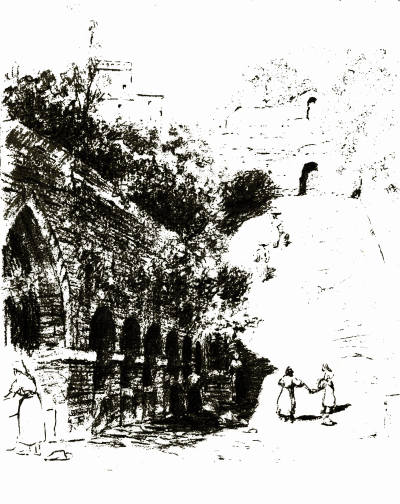
San Gimignano: the Washing Place.
[97]
After Saint Fina it is the Blessed Bartolo, 'the
Angel of Peace,' whom the San Gimignanesi venerate
most. Like Santa Fina he has a noble shrine by
Benedetto de Maiano; and he lies, as we are told he
wished to do, in Sant'Agostino, the great bare friar's
church on the hillside, which is a treasure-house of
mediaeval art.
If all the towers of San Gimignano were chimneys
belching smoke, and all her mediaeval palaces were
ugly modern houses, the world would still visit her
to see Gozzoli's inimitable frescoes of the life of Saint
Augustine. They are so fresh and unspoiled, so stately
and human, so full of quaint imaginings. For he was
a great humorist this pageant-painter of the Renaissance,
and his naïve pictures are the ideal illustrations
to the naïve Confessions of that very human saint,
Augustine!
Gozzoli came to Sant'Agostino from his work in
the Riccardi Chapel at Florence. There he had slipped
beyond the monastic conventionalities of his master,
Fra Angelico, and adventured into the gay Florentine
life of the fifteenth century with its sports and pageantry.
Here he has wandered further from his gentle
instructor, and does not hesitate to reproduce with
genial wit the humour as well as the pageantry of the
age in which he lived. For it goes without saying that
his Augustine is transplanted to the Quattrocento,
and his life pictured in Gothic cities where Gozzoli
himself and his gay compatriots all play their parts.
From the beginning, if we except perhaps the first of
the series in which the saint is being spanked by his[98]
schoolmaster for some small misbehaviour, Augustine
is a charming and dignified figure, whether we see him
a thoughtful youth setting out in state for Milan
through a typical Gozzoli landscape, or he wanders
disconsolately in the monastic habit upon the shore,
and is rebuked by the little child making mud-pies
there, in the immemorial fashion of childhood, for
trying to probe into the mysteries of the Trinity.
This great church has many other treasures, frescoes
and tombs, such as Gozzoli's San Sebastiano or the
effigy of the Augustan brother who fell asleep in the
worn pavement so many years ago; or, best of all, the
tomb of Fra Domenico Strambi, the grand old monk
who commissioned Benozzo Gozzoli to paint his choir,
and who lies below a fresco which Mr. Gardner aptly
calls 'a masterpiece of municipal sentiment.'
San Gimignano is extremely rich in frescoes, considering
that she had no native school of painting, but
drew her artists first from Siena and later from Florence,
when she had yielded her freedom to that city. The
Pieve or Collegiata is like an ancient missal full of
illustrations. Besides the frescoes of Ghirlandaio in the
Cappella della Beata Fina, and his Annunciation in the
Oratory of St. John,[11] the walls of the nave are covered[99]
with the quaint and primitive frescoes of Taddeo di
Bartolo and Bartolo di Fredi; and many other painters
besides Piero Pollaiolo and Benozzo Gozzoli have added
their quota to this ancient scroll of art. The choir of
Sant'Agostino, as I have remarked above, is a masterpiece
by Gozzoli; and the museum in the Palazzo
Comunale boasts a fine collection which includes two
beautiful pictures by Pinturicchio and Filippino Lippi.
Of all the Palazzi Comunali of vanished republics
San Gimignano's is the most forlorn. It seems to
have fallen asleep like the rest of the city, and forgotten
to do anything but flower and be beautiful. Its faded
fourteenth-century courtyard has an outside stairway
leading to a raftered loggia; grass grows in its brick
pavement; and tall grey towers, fringed with flowers,
rise above its walls. Without the Tuscan sunshine to
beautify its stones it would be a little desolate, all faded
fresco and broken plaster. And this, mark you,
although it is the nuovo palace of the Podestà. The
antico Palazzo, facing the Pieve, so picturesque with
its loggia and tower and municipal clock under its
wide Tuscan eaves, is older and more ruinous still.
It is not battlemented like its neighbour, and it has
no processional staircase; nor is its tower, which
'marked the limit to which noble citizens might build
their private towers,' as lofty as the Torre del Comune,
for this bestrides a street and is the giant of the city,
a monument to the vanity of the San Gimignanesi,[100]
being built with the money contributed by magistrates
who wished their arms to be fixed to it when
they went out of office.
We went up the steps which have seen so many
municipal pageants to try and learn the history of San
Gimignano from the threadbare splendour of her garments.
How like they all are to each other, these little
cities of United Italy, with their smug municipal dignity
sitting in the midst of tatterdemalion glory! Here, in
this very chamber where to-day Lippo Memmi's great
fresco of the Virgin and Child, enthroned among the
angels, looks down on office chairs and ink-stained
tables covered with American cloth, came Dante in
the year of the first jubilee, 1300, in all the splendour
of Florentine embassy! Here he spake to the lords of
San Gimignano, and invited them to send representatives
to the election of a captain to lead the Ghibelline
League of Tuscany. Here, where all the petty business
of a little town is ratified, the men of San Gimignano
were wont to deal with their affairs of state, to settle
wars, and speak of popes and emperors. We read the
story of it round the walls—Memmi's fresco with its
proud baldachin of armorial bearings surmounted by
the Ghibelline eagle has effaced the greater part of it,
but under the timber roof are the arms of the noble
families of San Gimignano; and below them jousting
knights tilt at invisible combatants, long ago lost in
plaster; and huntsmen chase their vanished prey; and[101]
the Guelphs and Ghibellines fight out their everlasting
warfare in dim distemper.
The sunset was gilding the towers of San Gimignano
when we came out again, and all the bells were
ringing for evensong. Already the streets were bound
in shadows, so we wandered out among the olive-trees
to the little ruined church of the Templars. From here
we passed out of the city by an ancient gate, and down
the hill to the Gothic washing-pool, where the women
of San Gimignano wash and wring their linen in the
cool of the evening. The delicate afterglow of Tuscany
filled the sky, and the tall poplars whispered and
shivered in the sunset wind. Up and down that steep
and stony hill under the old Gothic gate went the
women, with their snowy linen piled in baskets on their
heads. The sound of their voices and laughter floated
back to us, mingled with the music of bells from the
city above. In the hollow below the road a little waterfall
babbled to the stones as it leapt over them to the
plain. Between the whispering poplars a white road
wound up the hill like the roads up which Benozzo
Gozzoli's stately young men rode to their Gothic cities.
And below, stretching far away to the east where it
was lost in rose and purple mists, billowed the vast
Val d'Elsa.
Seen through the magic of a summer evening—when
the poplars were making music in the breeze, and the
shadows were sweeping across the Tuscan plain; when[102]
the women, having folded their linen under the silver
olives and piled it on their heads, climbed the steep hill
into their tower-girt home—the world and all its doings
were as beautiful as a sacrament. Here, at least, in
these dim forgotten paesi, 'glory and loveliness have
not passed away.'
But, after all, it is at night that San Gimignano
is most beautiful. Then she is a city bewitched,
unspeakably lovely and romantic. Her silent streets
are thronged with memories; her shuttered palaces are
given back to ghosts; her proud old towers loom up
against the star-lit sky like mediaeval giants.
A silver moon was riding low in the heavens when
we left the doorway of the Leon Bianco and passed
through the Arco de' Becci, the great gateway of the
ancient circuit of walls, which leads at once into the
heart of San Gimignano. It was velvet-black under its
ghostly tower, and the Gothic palaces of the Castello
Vecchio within seemed to be holding their breath as
they watched the shadows creeping over the pale stones
of the piazza. How silent and deserted it was! The
lovely grave-eyed children, who had been our guides all
day, had vanished with their gentle mothers, whom we
had seen spinning in their doorways through the sunny
hours. Where had they gone? There were no lights
in any of these silent palaces, and the narrow streets
were empty except for the shadows of the towers, grim
as bloodstains.
147
[103]
A white owl, soundless of wing, sank on to the
parapet of an ancient palace. Imagination plays
strange tricks in this city of ghosts, in whose streets
an August moon, more than five hundred years ago,
bore witness to the greatest tragedy in the vendetta
of the Ardinghelli and the Salvucci. Was it a bird, or
did I see a scrap of paper flutter from the window of
that dark tower? No. It was only a piece of broken
glass glittering among the stones—fit emblem of the
broken hopes of those two hapless boys whom Benedetto
Strozzi so foully did to death by the persuasion
of the treacherous Salvucci. Their letter went astray,
thrown from the prison tower, in the hope that
a friendly breeze would carry it to the feet of an
adherent of the Ardinghelli. And very soon afterwards
they met their death, by the steps of the Palazzo
Comunale, early on a summer morning, hurriedly,
because Strozzi and the Salvucci knew that the
messenger who was riding from Florence with their
pardon would be delayed only a few hours by the
rising of the Elsa. He came too late, as he was
meant to do. The Salvucci had already reaped their
bloody harvest—the heads of Primerano and Rossellino,
the flowers of the noble house of Ardinghelli, had fallen
to the sickle.
It was late, and the sleepy porter of the White
Lion yawned reproachfully as we passed him on our
way to the Porta San Giovanni, whither we were bound[104]
to view the city and rid ourselves of shadows. If tragedy
lurked within the narrow streets and byways of San
Gimignano, we found nothing but beauty without.
The moonlight, flooding her broken walls and picturesque
old gates, transformed her into a city of pale
jade, crowning a gloom-dark hill. Her diadem of
ghostly towers seemed enamoured of the sky, and
soared towards the heaven like young Endymion,
stretching out his arms to his enchantress. Down the
hillside poured her palaces, white as marble, rising in
terraces from their dark gardens, and far away we
could hear the plaintive cry of the city watchmen as
they went their solitary rounds. At our feet a sheer
cliff, filled to the level of the road with trees, fell into
the night. From its mysterious depths ascended the
fragrance of wet earth and the bell-like chant of frogs.
And beyond, and all round, lay the broad fields of Tuscany,
filled with a sea of moonlit mists, from which the
fantastic outlines of little hills rolled up, like shadowy
waves, with towered farms and slim black cypresses
upon their crests.
[105]
MONTE OLIVETO MAGGIORE
Austere and terrible, barren as the Valley of the
Shadow of Death, is the desert of Accona, where
Bernardo Tolomei founded the monastery of Monte
Oliveto Maggiore.
At Asciano we left behind us the fruitful gardens
of Tuscany, rippling with vines, and rich with maize
and olives, and embarked upon a sea of pallid hills.
It was as though a blight had fallen. The naked earth
was parched and rent with gaping fissures; the tamarisks
and spurges and the drab grass which fringed the
roadside were old and dry. The smiling valleys fled to
the north and the south as from a land accursed, 'and
lo, the fruitful place was a wilderness.'
Our way lay along a bleached white road which
seared the grey hillside and writhed among volcanic
mounds and precipices. Here and there the drab
monotony was broken by the clustered spires of
cypresses round scattered farms; but their black foliage,
like funeral plumes, only added a deeper note of
melancholy. It was hot too. The August sun beat
down upon us from a brazen sky, and the glare of the[106]
road made our eyes ache for cool green shadows. But
when we reached the plateau a vision of surpassing
beauty burst upon us. It was as though, after sojourning
for many hours in the wilderness, we looked
from Pisgah on the promised land. To our right,
across miles of pale clay gorges and volcanic mounds,
Siena lay rosy and smiling in her vineyards; on
the other hand a wide valley full of precipices rolled
away to the purple hills of Umbria, which hung like a
mirage between earth and sky, with Monte Amiata
lifting her proud head above them all. And presently,
after we had passed through Chiusure, a shrunken little
town in the heart of a green oasis, we caught our
first glimpse of Monte Oliveto.
Below the road the hill fell away in a deep ravine,
whose tortured sides were torn and scarred by torrents,
as though the pallid earth had bared an ancient
wound. And in the midst of the grey desolation, with
towering cliffs above, and wild precipices leaping down
into the valley below, stood the Abbey of the Blessed
Bernardo. Grim and forbidding as a fortress were its
bare red walls, devoid of ornament, only redeemed
from positive ugliness by their austerity and rugged
strength. And yet, as we approached the monastery
through the fragrant shade of cypress avenues, the
scent of pine needles and the song of cicalas rose
together like the voice of the wilderness and the
solitary place which has been made glad.
[107]
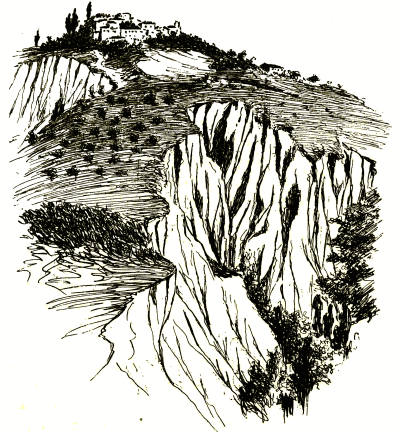
CHIUSURE FROM MONTE OLIVETO MAGGIORE.
For, indeed, S. Bernardo and his companions
laboured to make this wilderness blossom like a rose.
Early in the fourteenth century he put aside the vanities
of life. At the height of his glory, when all Siena[108]
was ringing with his brilliance and prodigality, he left
the city, fleeing, like Shelley, from the awful spectre
of his veiled self, asking 'Are you satisfied?' And
coming into the desert of Accona he dwelt here in
poverty and simplicity, building a little chapel to
Santa Scolastica, the sister of St. Benedict, and leading
a life of prayer and meditation. We read that a great
number of followers, many of them noble, came to him,
and lived upon the hillside, striving by the sweat
of their brows to transform the Tuscan desert into
a garden. But in that day of Guelph and Ghibelline
disorders the rulers of Siena feared that he was sowing
the seeds of a rebellion; and, if we believe his legend,
tried to poison him. It is certain that he was accused
of heresy, and forced to make the long journey to the
Papal Court of Avignon with Ambrogio Piccolomini,
one of his earliest companions, and a scion of the noble
house of Piccolomini. Nothing more is said of the
charge of heresy. The Pope, John XXII. , received
them with favour and gave them letters to Guido
Tarlati, the splendid old warrior-bishop of Arezzo, in
which he asked that most unconventional of prelates to
furnish them with a monastic rule. Here again the
legend adds a picturesque touch, for it tells us that
Tarlati had a miraculous vision, in which the Blessed
Virgin appeared to him and commanded him to give
the rule of Benedict to 'the pious solitaries' of Accona,
to clothe them in spotless white, the symbol of her[109]
purity, and to give their hermitage the name of St.
Mary of Mount Olivet.
So with their own hands Bernardo and his companions,
no longer clad in the garb of penitents, began
to build their church and convent on the spot where
he had his vision of a celestial ladder stretching
up to heaven, with angels leading his companions
to the throne of Christ. But their work was stopped
by news of the great plague which was spreading
desolation throughout the country. Going himself to
Siena, Bernardo sent out the brothers two by two
to tend the people, bidding them depart with good
courage, saying that they should all meet together
in Siena for the Festival of the Assumption. He
never saw his cloistered home again; he died in
the stricken city with nearly all his companions, and
other hands took up the building of his monastery; and,
later, beautified it with frescoes by Luca Signorelli
and Il Sodoma, and rare intarsia by Fra Giovanni of
Verona.
But I was not thinking of the Blessed Bernardo or
of his white-robed Olivetans as we drew near the
monastery. Some touch of faery lingered in that
cypress grove. We had come out to see a convent.
And lo! a battlemented gateway rose before us, with
drawbridge and portcullis, as warlike as a castle of the
Sforzas. It was as though we had ridden like princes
of eld across the grey inferno of Childe Roland, where[110]
the grass 'grew scant as hair in leprosy,' only to wind
our horns before the gate of an enchanted city.
And the fancy grew. We passed without challenge
under the portcullis, with a smiling Godspeed from its
Della Robbia Madonna, into one of those enchanted
woods of Italy, where stone-pines make a frieze
against the sky, and cicalas sing their little hearts
away in rapture. Two paths led through the flickering
shadows. We hesitated which to take, and glanced
behind us, half expecting some warden to issue from
that ancient gate to ask our pleasure and direct our
steps. No one was there. But, just as St. Mary
welcomed us without, so from his niche above the
arch St. Benedict, clad in the spotless robes of Oliveto,
gave us his blessing. We went forward then, past a
huge brick jebbia full of green water and down to the
stables where we dismounted by a well, as Aeneas
Sylvius and his brilliant suite of knights and choristers
dismounted when they rode here from Siena and
marvelled to find so fair a garden in that barren land.
Still no one came, and still the enchanted silence of
the woods prevailed. We wandered round the old red
walls, seeking to find an entrance, and since there was
no one to say us nay, we went into the cool white
monastery. How still and desolate it was! Our footsteps
ringing on the flags dismayed us, and when we
pealed the bell it echoed like derisive laughter down
the empty corridor. Truly the spirit of the place has[111]
taken flight, now that the white-robed brethren no
longer dwell in their inheritance. Not more than
three monks live here to-day; and these, they told us
rather sadly, as custodes only, for their order is suppressed
nearly everywhere, and the state has made a
national monument of their treasures. So the ancient
law that to him that hath shall be given, and from him
that hath not shall be taken away even that which he
hath, is fulfilled. And I will confess at once that from
the sentimental point of view my sympathies are all
with the monks, for they are one of our most picturesque
links with the past, and it was with their own
hands that they sowed this harvest which another
reaps.[12]
So there are only ghosts to people the deserted cells
and chapels and refectories of Mount Olivet to-day.
Time and the hand of man have robbed this sanctuary.
Everywhere the eye sees frescoes fading from the walls;
and Napoleon, who never saw any harm in robbing
Peter to pay Paul, stole some of the exquisite intarsia
stalls of the convent church to enrich the cathedral of
Siena. Only in the great cloister, where Signorelli
and Sodoma painted the life and miracles of St.
Benedict, is the imagination fired. What does it
matter that the story has been often told? That we[112]
have conned it in a hundred other frescoes? It is like
the magic stories of our youth, which gained an added
joy by repetition, because no two people ever told them
quite the same. Here we could find inhabitants for all
those empty cells; here we could fill the pleasant
groves with white-cowled monks who knelt in prayer
below the cypresses, or paced the shady avenues in
meditation; here we could picture Bernardo himself,
building his abbey, and see him sitting in the old
refectory with Patrizi, and Ambrogio Piccolomini, and
the other nobles who followed him into the wilderness.
'The series forms, in fact, a painted novella of monastic
life; its petty jealousies, its petty trials, its tribulations
and temptations, and its indescribably petty miracles.'[13]
And then, because it was long after mezzogiorno,
and we were to sleep at Chiusi that night, we went
back to the magic cypress-woods to eat our lunch and
rest before we drove to Asciano. Our coachmen had
prepared a place for us, which they explained was
molto arioso for so warm a day, on a terraced slope
in the wide avenue of cypresses leading from the
monastery church to the little chapel which contains
the cell of Bernardo. The bank was carpeted with
pine-needles, and the air was fragrant with the scent
of crushed thyme. We lunched excellently well off
wine and bread, figs and peaches; and our smiling
drivers brought us a great fiasco of sparkling ice-cold[113]
water—an acceptable addition to the meal, for we were
thirsty, and good spring water is not found everywhere
in Italy. And then we pillowed our heads on the soft
bank, and lay in silence, entangled in a flickering web
of sun and shadow.
Surely it was an enchanted wood of cypresses that
summer afternoon! As I drowsed I dreamt that I saw
a boy come idly through the trees singing to his lute.
His eyes were heavy-lidded, and long black love-locks
lay on his shoulders. He was dressed fantastically in
scarlet stockings, a silken cap, and a gay cloak,
which evidently pleased him well, for at times he
plucked at it and pulled it closely round him to
admire its folds. A monkey with a gilded chain was
on his shoulder, and a badger walked solemnly at his
heels. Who could he be? I wondered. He was too
gay and worldly to have thoughts of entering the
Brotherhood, and as he drew nearer I could hear that
his song was in the praise of love. Some poet of the
Renaissance, perhaps, whose lord was resting in the
monastery.
He drew nearer still, till I thought he must have
seen me; and then, as though he was a little weary of
his song, he dropped his lute and pillowed his gracious
young head upon the flowery bank and drifted into
sleep, lulled by the fragrance of the warm pine-woods.
It seemed to me as if he dreamed, for he stirred, and
turned his face away.
[114]
Was it I who dreamt the rest?
I saw a lady moving towards him across the flowers
as lightly as a butterfly upon the wing. Fair of face
and form was she, fashioned very lightly, full of airy
grace; with child-like laughter on her lips and a half-defiant,
wholly-alluring challenge in her tender eyes.
Her dress was blue and of so light a texture that it
rippled from her rosy limbs like water, and scarce
bruised the flowers. As she ventured near she laughed,
and wantoned with some golden fruit. The sunshine
and the breeze, greatly daring, played in her filmy
yellow hair and fashioned the tender blue of her robe
into little wings. Half a child was she, and half a
woman, full of the joy of living and the joy of beautiful
things; the very spirit of an azure butterfly who flutters
through a summer day, dancing from sheer delight.
Who could have dreamt that I should find her here,
on this bleak hillside, in this austere old house? These
baked clay cliffs and desolations should have driven her
away to gay Siena long ago, even if she outstayed the
bitter winds which thrash the stone-pines round the
forsaken monastery in winter.
She was standing by the poet now, and smiling
down at him, pouting a little because he did not wake.
Who could resist her, this happy butterfly fashioned so
beautifully for love on a golden summer day?
A pine-cone fell into my lap and startled me. I
moved. And in a flash the spell was broken. They[115]
had vanished, the beauteous lady and the sleeping boy
whose dreams had conjured her. The yellow sunlight
was slanting in between the cypresses, and from the
stables came the sound of horses being harnessed. It
was already time to go.
And yet they say that Benedict sent her away
with harsh words and admonitions.
And the youth who dreamed was not a poet but a
painter; his name was Sodoma. You may see her picture
in the cloister, and his own as well, in the gay clothes
of which he was so proud, for they were part-payment
for his work, and had belonged to a gentleman of
Lombardy who took the monastic habit.
But it is still a miracle to me that I should have
met her on this bare hillside.
[116]
CHIUSI
Night had fallen when we reached Chiusi Junction.
A full-blown harvest moon hung over the station-yard
like a yellow lamp. It was late, and the lights of
Chiusi were a twinkling bunch of fire-flies on a distant
hill. We dined at the excellent station buffet, resolved
not to spoil the propitious hour by arriving in an unknown
city tired and hungry; and afterwards we
climbed up to our mysterious destination at leisure, in
the glory of a late moon, with the night insects singing
by the dusky roadside.
They are among the little joys of Italy these late
arrivals, on breathless summer nights, at hill-towns
whose features you have only glimpsed heretofore from
the windows of a flying train. A fig for the discomforts
that you risk! They add a touch of salt to the
adventure. The inn you stumble on may be the worst
of all bad inns; the dinner will of course be long-delayed;
and if you have inadvertently walked in upon
a festa it may be difficult to find a place whereon to
lay your head. But reckon against these things the
charm of mystery—the complete sense of satisfaction
with which you watch the ruby tail-lights of your train[117]
slipping away into the night, and hear the lessening
roar of its engine till your last link with the familiar
world is severed, and you are face to face with the
unknown. And lastly, remember the joy with which
you discover a new world in the morning.
We started in a vettura which was never meant to
carry passengers as well as luggage, but before long we
slipped out one by one, for we were only going at a
snail's pace up the long hill which leads from Chiusi
station to Chiusi town, and we could see nothing of the
magic of the night, half-buried in boxes, and with the
stars shut out by tarpaulin. The driver did not
notice, but the horses quickened their pace with the
lightened burden, and soon we were left to find our own
way up the hillside. It was not difficult. The bright
moonlight, which flooded the plain below, turned the
road into a band of silver, whose whiteness was barred
by the shadows of giant cypresses towering black
against the night. The chanting of the frogs and the
song of the night cricket almost drowned the jangling
bells of our vettura, and high above us we could see
Chiusi, no longer a bunch of fire-flies, but a ghostly grey
hill-city already wrapt in slumber, with a frowning
rocca, and grim old walls. Its silence was a little
desolate as we drew near, and it was a relief to see the
hospitable yellow lights of the Leon d'Oro outside the
Porta Romana, giving us a homely welcome into the
mysterious moonlit town.
[118]
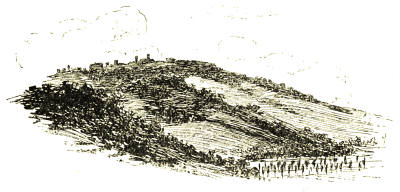
CITTÀ DELLA PIEVE FROM CHIUSI.
I woke early in the morning. It needed but a
glance to tell me that I was back in Umbria. Nowhere
else are the dimpled valleys so full of beauty, or
the blue hills so softly moulded; and nowhere else is
that pellucid sky, or that strange clarity of atmosphere
which inspired the landscapes of the Umbrian Quattrocento
artists. It was as though I looked straight into
the heart of one of Perugino's sacred pictures. There
was the soft green valley melting in the distance into
the azure folds of mountains; there were the slender
trees cleaving the luminous air; there were the towered
cities crowning the hills; there was the clear pale sky,
the spaciousness, the holiness which Perugino and his
school immortalised. But, after all, this rich plain,
from which the waters of an inland sea have long ago
receded, is peculiarly the land of Perugino. Is not[119]
that rose-red city on the crest of the wooded hill which
bounds the southern horizon of Chiusi, Città della
Pieve, the town which gave him birth? I half expected
to see a band of saints walking in the vineyards,
or to find Madonna sitting by the roadside with the
Infant Christ. But another artist had usurped the
landscape. Below my window was a peasant ploughing
in his olive-garden. He sang as he bent forward to
throw his weight on the wooden shaft, and his clothes
were as blue as the heavens at mid-day. Two milk-white
oxen moved slowly before him under the tender
grey of the olives, and as they passed they left behind
them shining furrows of freshly-turned earth. It was
a poem of labour, as delicate in colour as a tone-etching,
an inspiration for Millet with the poetry of life in
his veins, or for the subtle Corot.
Chiusi, the Clusium of Lars Porsena, the great
Etruscan Prince who championed the Tarquinii after
they were expelled from Rome, is a little self-contained
city with an affectation of placing cypresses at becoming
angles. She is rather a coquette this old town. She
is not unconscious of the picturesqueness of her position
as she rises above the shimmering olives which
veil her hillsides; she knows the value of cypress spires
when they soar above the bastions of ancient walls;
she deliberately sets herself out to charm the stranger
by filling the gardens of her trattorie with flowering
gourds and purple morning-glories. Her picturesque[120]
old cathedral has been so cleverly redecorated throughout
with painted mosaics, that when we first stepped
down into the cool dark nave we were deceived, and
gasped to see such jewels outside Ravenna; and she
has built herself a delightful museum, in the form of a
classic temple, to house her Etruscan treasures.
I think she has never ceased to congratulate herself
upon giving the lie to Dante's ill-omened prophecy,
when he quoted her as an example of a city falling
into decay—
'Mark Luni, Urbisaglia mark,
How they are gone, and after them how go
Chiusi and Sinigaglia; and 't will seem
No longer new or strange to thee to hear,
That families fail when cities have their end.'[14]
She may well have seemed a city doomed to him as
he rode in haste through the pestilent marshes of the
Val di Chiana, and saw her desolate towers above him
stark against the evening sky, as he hurried from Rome
to Siena to meet his fellow exiles and learn the story
of his fall.
For eight centuries or more Chiusi was a plague
spot, and the vapours of the maremma were more
powerful to guard her from invaders than the strongest
walls. So she has fewer mediaeval palaces, and fewer
towers than other hill-cities, and these were long ago
given to neighbouring churches to hang their bells in,[121]
and the ancient Rocca is a garden with a farm-house in
its keep.
I have a tender spot in my heart for Chiusi. She
is a happy town. In herself she is not very picturesque:
her houses are the plain, white-washed, green-shuttered
homes of modern Italy; there are few traces of her
ancient greatness to be seen except the scanty Etruscan
foundations of her mediaeval fortifications, a quantity
of cippi and reliefs built into walls, and the labyrinth of
ancient sewers which honey-combs the hill.[15] And in
comparison with the other cities of Umbria she contains
nothing of the Middle Ages, certainly nothing
Gothic, if we except the exquisite illuminated missals
and psalters by Bindo Fiorentino and Girolamo da
Cremona, which are kept in the sacristy of the cathedral,
and which came originally from the monastery of
Monte Oliveto. To the antiquary she is of the
highest interest, for she marks the site of Clusium, one
of the five Etruscan towns which combined against
the first of the Tarquins, and of the earlier Camars,
which may have been a city of the more ancient
Umbrians. Her history shows her to have been one of
the oldest and most powerful cities of the Etruscan
League; and the country for miles round her walls has[122]
yielded, and still yields, a rich harvest of antiquities
from scattered tombs. There is a slope to the east of
the city which is called 'The Field of the Jewellers,'
because so many scarabaei have been discovered there
by the chance furrow of a plough.
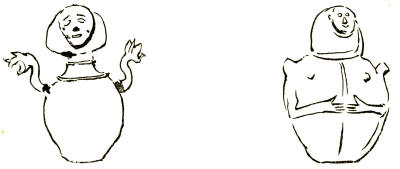
But I am no antiquary. It is not for me to discuss
the possible site of that improbable mausoleum of
Lars Porsena with its labyrinth and pyramids and windbells,
which Varro described as glibly as Herodotus
did the marvels of the labyrinth of Crocodilopolis. I
have not seen the great necropolis of Poggio Gajella on
the hill to the north of Chiusi, which Dennis tells us
is a hive of tombs. To me the charm of Chiusi does
not lie in her antiquity, though like every one else who
visits her I have spent happy hours in her sunny
museum, poring over inscriptions and sarcophagi, and
cinerary urns and household implements, and all the
strange paraphernalia of a vanished race which have[123]
been garnered from the fields of Clusium. Nor are the
painted tombs of Etruria as much to me as the wonderful
beauty of the olive-gardens through which we
walked to find them, in the golden sunset or the clear
cool dawn.
There are many tombs scattered round the hill of
Chiusi. Some of them empty caves hollowed out of
the rock, half full of water, abandoned to moths and
bats; and others which have been opened and closed
up again because the damp and thieves have robbed
them of all interest. A few of the best are kept under
lock and key to preserve them from wanton destruction,
but even these are slipping reluctantly back to
oblivion.
Such an one is the Tombe del Colle Casuccini, which
is to be found in an olive-grove to the south-east of
the town. It is hollowed in the rock, and is approached
by a levelled path cut in the slope of the hill. The
earth around is full of iris plumes and slender field
flowers; there is a weather-beaten cippus over the
lintel, and a solitary stone-pine which stretches out its
branches as though Nature sought to render homage
to the dead by yielding them a royal canopy. We had
lingered so long in the silver olive-gardens that it was
almost the hour of sunset when we reached the tomb.
A melancholy evening wind moaned in the branches
of the pine-tree, and rustled in the flowering yews which
guarded the entrance of the passage.
[124]
Up and down the hillside we could see the peasants
returning from their work in the fields, and the whole
world was caught in the sudden glory of the setting
sun. A woman came towards us with the key of the
tomb; she had a baby in her arms, and on her head a
great mottled pitcher, green and gold, full of spring
water. The sunlight wove a halo round her till she
seemed as radiant as one of Pinturicchio's Madonnas.
The great doors of travertine groaned as they swung
slowly open on their stone pivots, and a scorpion
fled from the light. Dennis says, 'There can be no
doubt of the antiquity of these doors; it is manifest in
their very arrangement; for the lintel is a huge mass
of rock buried beneath a weight of superincumbent
earth, and must have been laid after the slabs were in
their place.'
This sepulchre, like most Etruscan tombs of importance,
is divided into several chambers. Its roof is
curiously coffered, and was at one time painted red
and black. But it is the wall paintings which are of
supreme interest here. Unlike the other tombs of
Chiusi the sandstone walls have been whitened, and
even so the figures are hardly distinguishable. But
look close. It is worth the trouble, for as your candlelight
drives the shadows back, the story of an ancient
world unfolds itself. Here, to the right, three charioteers
urge their archaic steeds to the winning-post; here are
the wrestlers; here the musicians with their doublepipes[125]
and lutes, and here a dancing girl. On the other
wall you can trace the progress of a banquet, and see
the languid youths of Etruria reclining on couches,
toying with wreaths and flowers, and holding out their
paterae for the hurrying slaves to fill with wine.
But they are very faded. They are a world of
shadows; they vanish with the months. Another
generation will look for them in vain; then the
athletes will no longer run their silent races to eternity,
the music will be hushed, and the feet of the dancers
stilled. And then, I suppose, the wonderful old doors
will be taken away, and the angry scorpions will be left
in possession. If you would see these ghosts, come
soon. For if you come ten years after, perchance you
will find nothing on the cold stone walls; their pictures
will have gone the way of all the other antique graces
which have been lost in Time's devouring maw!
In Italy, especially in the small cities, you have to
bow to local convention. In Chiusi it takes the form
of Etruscan tombs. Every one from tiny children to
the oldest inhabitant volunteers to be your guide. A
stranger would say that the Tomb of the Monkey or
the Deposito del Gran Duca were topics of burning
interest in the town, for the people will not rest until
they are assured that he has visited them. It was for
this reason that the sunrise next morning found us on
our way to the Tomba della Scimmia, which lies a mile
or so to the north-east of Chiusi. At first we followed[126]
the highroad where the gay painted ox-carts of Clusium,
with their picturesque high-curved shafts, were already
rolling up the hill. But our way soon turned off into
a rough path which dipped down into the chilly sweetness
of the olive-gardens. The sun had not yet risen
high enough to penetrate these dewy hollows, but as
we re-emerged from them and breasted the little oak-clad
hills beyond, it slanted between the branches and
made a halo round some young peasant girls, barefoot
and with uncovered heads, who were carrying great
pitchers of water to their cottages from an Artesian
well. We dipped into more valleys and circled other
hills, plucking the ripe blackberries as we passed, and
gathering the flowers which made a tangle round our
feet. The only people that we met were peasants at
work below their olives, and every one of them gave
us a smiling buon giorno a loro as we passed.
Presently we came out upon a wooded cliff and saw
Chiusi, with her fair white houses and her grey ivied
rocca, across the valley to our right, and on our left the
little lakes of Montepulciano and Chiusi, like opals in
the dawn. Umbria again! The flowers at our feet,
the glint of water in the wide green valley, the purple
hills, the soft blue sky, the breadth and depth, the
holiness and peace of mystic Umbria.
173
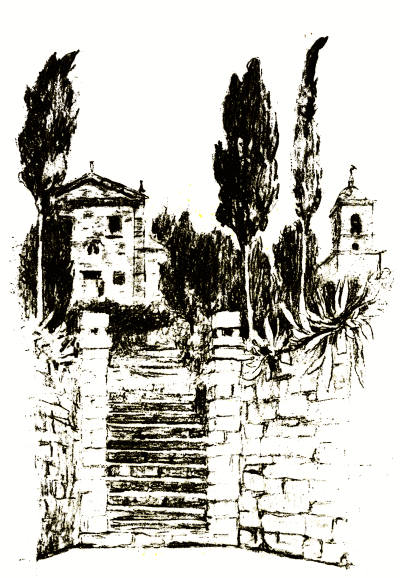
Chiusi: the Palace of the Bishop.
[127]
The Tomb of the Monkey owes its name to the
painted monkey chained to a tree in the midst of the
athletes who wrestle and ride and box and perform their
Pyrrhic dances round the walls. It is approached by a
deep cut in the tufa, in the style of the mummy shafts of
Egypt, but the steps which lead down to the door, and
the door itself, are modern. By the help of our guttering
candles we were able to decipher the solitary
spectator who sits, like Nefertari in her rock-hewn
tomb of Thebes, with foot on stool and umbrella over
head, gazing into eternity. But we did not stay there
long. It was too cold. The damp had eaten almost
everything away. Down in the chill dark of the tomb
we knew that the wrestlers, their naked red bodies
fading into the tufa, wrestled continuously, and the
chariots drove silently into the shadows before the
solemn audience of one.
But up above we could hear the bells of Chiusi on
the warm, scented air. And there were the wind, the
limpid sunlight, the song of birds, the wooded hills and
valleys, the yellow earth with its flowers and its trails
of bramble covered with shining fruits—everything of
warmth and sweetness and pleasure to the eye and ear.
In the plain below we could see the little blue lake of
Chiusi, called lovingly of the people, the 'chiaro di
Chiusi,' which in the olden days was yearly espoused
with a ring by the chief magistrate of the town, in the
same manner as the Doge of Venice wedded the
Adriatic. And beside it the towers of Béccati Questo
and Béccati Quest'altro, which were put up in the
fifteenth century by the rival provinces of Siena and[128]
Perugia, still shout defiance to each other across the
valley.
After all, it was for her old-world charm that we
loved Chiusi—the simple pastoral beauty of her contado,
her forges glowing at night in deep caverns below her
walls, her Bishop's palace with its ancient cippi, and its
flowering agaves and cypresses. And most of all we
loved the lichen-covered boy in the fountain of the
Piazza del Duomo. For he was like the spirit of eternal
youth, keeping the soul of things alive in this city of
tombs. There were gold fish in the green shallows
round his feet, the water spouted from his forehead, his
arms were outstretched and his face upturned, as though
he sang in rapture to the sun.
For it was in such little things as these that we
found the hidden secret of Italy's charm. These little
towns like Chiusi, perched each one on its hill, are sometimes
commonplace enough in themselves, even though
their foundations are inscribed by the years that have
passed; but they look across valleys of unimaginable
beauty to the mountains; they have genii singing in
their springs; and the lives of their people have the
classic simplicity of an older, unspoilt world.
[129]
HANNIBAL'S THRASYMENE
'Yea! sometimes on the instant all seems plain,
The simple sun could tell us, or the rain,
The world caught dreaming with a look of heaven
Seems on a sudden tip-toe to explain.'
'The Rubaiyat,' Le Gallienne's translation.
We came to Passignano from Chiusi, because we
could not resist the beauty of Thrasymene. Most
travellers in Italy only view it with passing admiration
as they fly by in the express which takes them from
Florence to Rome and Naples. It is to them merely
another lovely incident in their journey through a landscape
of surpassing beauty. Perchance they refer to
their Baedekers, and find that it was the scene of
Hannibal's great victory over Flaminius, and in a few
minutes more their train is in Chiusi Junction, and the
lake is lost behind the Umbrian hills. Others, who
visit Perugia and Assisi, see more of its beauties, for
when they leave the main line at Chiusi they have to
make a semi-circular tour of the lake; and even from
Terontola, the junction for Florence and Perugia, the
line runs for miles along the lake-side, and crosses the
actual site of Hannibal's battle-field.
[130]
Twice already, in the last month, we had traversed
it, on the journey from Cortona to Perugia, and again
on our way to Siena. Coming back we could no more
resist it. Our intention had been to go straight from
Chiusi to Assisi, but at Terontola the little philosopher
put in a special plea for Thrasymene. He has a passion
for lakes and rivers; no landscape is complete for him
without them.
'Let us go down to Thrasymene,' he said. 'Not
for the sake of Hannibal, but for the pleasure of its
beauty. For I am sick of the petty wars of hill-towns,
and am wearied for the moment of Etruscan tombs and
Gothic palaces and churches. Let us go forth into the
field; let us lodge in the villages. Let us get up early
to the vineyards; let us see if the vine flourish, whether
the tender grape appear and the pomegranates bud
forth!'
So we came to Thrasymene and Passignano, which
is a mere handful of brown houses pushed into the
water at the foot of a rocky hill. Passignano has
a flavour of its own. To begin with, its inn is different
from any other albergo in Italy. It has an old-fashioned
kitchen with a cowl chimney and rows of shining brass
saucepans, and it opens on to the village street, where
the people sit to gossip while the evening meal is
cooking. Its low cottage windows look over the wide
expanse of water to towered Castiglione, and the
wooded islands of Thrasymene; but it is built so close[131]
into the hillside at the back that you can stretch your
hand from an upper room and pluck the creepers which
pour in a green cascade over the rocks. It is extremely
primitive: the menu consists of soup, macaroni, eggs,
fresh fish from the lake, and very lean chickens, supplemented
by rough country bread, plenty of honey
and fresh fruit, and cheese if the proprietor has lately
been to market in Perugia. Meat there is none, at any
rate in August, nor tea. But the rooms are spotlessly
clean, with snowy beds, dainty white valances, curtains
edged with hand-made lace, and the finest of linen
towels; the daughter of the buxom landlady is as
charming as she is elegant, and the serving girl is a
beautiful Murillo.
Passignano is full of beautiful women; they form
two-thirds of the population of this little lake-side
town. There are hardly any men in it except the old
fishermen, and a few young lads, apprentices to bootmakers
and saddlers. All the rest have drifted away
to the towns, or have farms out in the paese. And the
women, from the pretty French wife of Signor Arturo
of the Albergo Balducci, with her freshly laundered
cotton dresses, to the little bareheaded girls whose
mothers call to them at night, bidding them bathe their
dusty feet in the lake before they come to bed, are all
lovely. They are noted for it.
The only other visitor in Passignano that August
was a young Apollo—so beautifully dressed in pale grey[132]
riding-clothes that he looked as if he must have slipped
out of a George Edwards musical comedy. He was,
according to the landlady, a student from the University
of Perugia, spending his vacation in Passignano
because the girls were so beautiful! Oh, young Italy!
How natural and unaffected you are! I loved to see
him strolling down the village street with a lordly
air of indifference, running the gauntlet of eyes as the
pretty girls, linked in groups like bouquets of flowers,
passed him demurely; while their mothers, sitting on
the doorsteps of their cottages, scanned the handsome
boy with kindly humour.
Everybody lives out of doors in Passignano. The
women are always sitting outside their houses; and their
children, half-naked in the summer heat, with halos of
sunburned curls, pillow their heads on the rough cobbles
of the hilly streets, and sleep after their play, as baby
angels might sleep in paradise, tired out with singing.
The stables and bakeries and workshops are open to the
road, and above them the shabby brown houses clamber
up the hillside to the Fortezza, which rears its shaggy
head above the highest of their pagoda-like chimneys.
'If we stay here we shall prolong our lives for
always,' cried the philosopher. 'Already I have forgotten
the world!'
And he fell to imitating the song of the cicalas.
Indeed for us the world was standing still. We
were caught in a mesh of beauty as in a summer daydream.[133]
The waves of Time seemed to retreat, leaving
us like swimmers resting on a golden shore after
struggle and turmoil. It might have been Lethe whose
waters sang to the stones at our feet: for we forgot
the world: its voice became a dream; we found ourselves
content to watch the changing lights as the hours
drifted away.
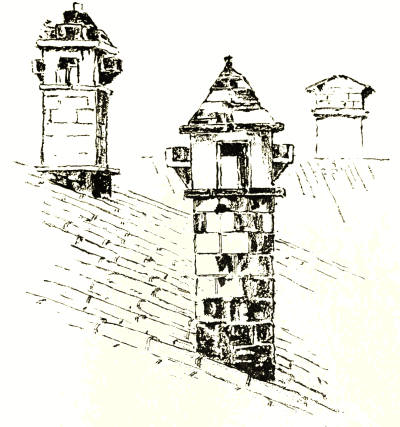
We ate our meals in the unfinished dining-room
which Signor Balducci is building out over the lake—a
mere shell of white plaster with empty doors and[134]
windows through which the little breezes strayed.
There were flowers on the cloth beside our plates,
and a great bowl of oleanders, geraniums and white
asters on the table. We breakfasted off golden bread
and honey, and the pretty waiting girl brought tuberoses
with our coffee. Outside, the lake was a tender
morning blue; its surface rippled to the cool breath of
the mountains, and sparkled in the sunlight. The bent
and twisted sticks of the fishermen cast fantastic
reflections in the water, and were beautified, as all
humble and work-a-day things are beautified in Italy,
by the magic of the sun. Further out two men in a
rickety sampan were hauling in their nets.
It was a scene of infinite romance. The towers of
Castiglione shone like ivory out of the violet mists, and
many of the hills which rose above them bore turreted
towns upon their crests. Behind them we knew lay
Siena, Montepulciano and Chiusi, and to the right
Cortona and Arezzo, and there Perugia, and Assisi
there. History swept down upon us too. Thrasymene
and its vine-clad slopes are full of memories of Hannibal,
the stormy petrel who beat his wings round Rome in
vain. Nor does it lack for gentler associations, for
Saint Francis of Assisi, who had been preaching in one
of the lake-side towns, was inspired, according to the
author of the Fioretti, to spend Lent on an island in its
midst. Which he did, in solitary prayer and meditation,
eating only the half of one small loaf of bread, 'from[135]
reverence for the fast of Christ the blessed one, Who
fasted forty days and forty nights without partaking
any earthly food; but in this manner, with that half a
loaf, chased far the venom of vain glory from him.'
Towards the hour of sunset, when the shadowed
hills grew blue and misty, and the lake was a mirror
of pale gold, we walked along the reedy shore of
Thrasymene. The wind rustled in the silken leaves of
the maize, and made a music like far-off singing in the
emerald reeds. We went down to the edge of the
water where the gardens sloped to the lake, and we
found flowers there and herbs—mint and thyme and
rosemary that scented the air, and purple vetches and
clover, and the beautiful cow-parsley whose blossoms
float like butterflies over every hedge and waste ground.
And there we waited while the sky glowed from gold
to rose, and Thrasymene seemed aflame with Hannibal's
desire for Rome.
We dined in our alfresco dining-room, and afterwards
we walked again by the still waters, where the
frogs were shrilling a chorus to the night-crickets, whose
song in the grass is like the sound of a curb-chain being
rubbed in the hand. Except for these the world was
still. There were no lights along that mysterious
country road except the stars, and rarely have I seen
them brighter, even in Africa.
'In a town we never see such stars as these,' said
the philosopher. We never do. The Milky Way[136]
stretched like a girdle across the heavens, and was
reflected in the lake like a pale moon. We stayed to
watch it, and to listen to the voices of the night.
A train glared out of the tunnel which pierces the
hill below Passignano, and tore along in the darkness
beside the road, lightening our starlit gloom for a
moment before its meteoric tail of windows was
swallowed up by the night. Then we saw a glow-worm
in a hole below the wall, and because in Italy
you are pleased with little things, we stopped to look
at it, and watch it turn round like a light-house lamp,
now glowing clear as a star, now an indistinguishable
mass of phosphorescence. And all the time the sky was
growing lighter, and the mountains darker in the east.
It was the moon.
Slowly it rose. The Milky Way grew pale in the
lake, and one great star which had twinkled like a will-o'-the-wisp
among the reeds went out. The light grew
and gathered behind the hills, and at last the miracle of
moonrise came to us as we waited in the scented
darkness of Thrasymene's shore, as it came to the
young world on the eve of its creation. First the rim,
and then the pulsing globe leaping from the shadows.
For a moment it hung upon the hillside while two
fantastic stone-pines, a fraction of an inch in height,
swayed within its circle like neophytes bowing before
Diana; then it rose into the heavens,—a stately ship
steering among the stars.
186
[137]
A miracle no less because our darkness has been
lightened thus since the beginning of the world. There
are so many miracles every day, if we but knew them,—the
scent of flowers, the webs of spiders, the subtle
fragrance of the earth, a wayside weed, and, most
beautiful of all, the sunrise and the moon. For sunsets,
though they may fill a grey world with rose and gold,
and though they are always so magnificent that words
are pallid pictures and artists' colours impotent, never
have the beauty of the dawn. A sunset may turn our
joy to melancholy, so tender is it, so pregnant with
regret for the vanished day, so full of splendours. But
we are always happy in the dawn. What of the night?
It is over and gone. A new world lies at our feet; a new
beauty fills our eyes; the breath of the morning in our
nostrils is as a flower after rain. For in the dawn we
step from the valley of the Shadow of Death on to the
rosy mountains of Hope.
And because you are in Italy you have time to notice
these miracles of every day, time to be happy, time
to watch things grow. The hours do not matter, for to-morrow
is as yesterday, and to-day is but a little minute
in a garden. If it should rain the butterflies will only
seek their shelter, the cicalas will be still, and the pores
of the thirsty earth will open. To-morrow the sun will
shine again. Or the day after that.
Nor is Passignano devoid of interest for the sightseer
whose pleasure is not to be found in green pastures[138]
or beside still waters. Magione, with its three
mediaeval castles and its memory of the Baglioni, is
within a drive. Picturesque Castiglione del Lago is
well worth a visit. There is the island of St. Francis,
with its ruined convent, now the villeggiatura of an
Italian nobleman, and its exquisite views of Montepulciano.
And lastly, there is the battle-field where
Hannibal, the 'furious youth' of Publius Cornelius
Scipio, defeated Flaminius, the maker of roads.
We did not go to Magione, but we let two old men
of Passignano row us to St. Francis' Island in their
weather-beaten fishing-boats. In an acacia grove down
by the water's edge they showed us the block of stone
whose surface was worn into two hollows by the knees
of St. Francis. So they would have us believe. 'Ma,
è vero!' they exclaimed, as though they feared that we
should doubt them; and we could but smile as they
told us an old legend of the saint sailing miraculously
across Thrasymene on his mantle, bearing a lighted
candle in his hand, because the boatmen dared not
put out in the tramontana which was lashing the
waters to fury.
We almost missed seeing the battle-field of Hannibal,
because we had left it to our last afternoon, and discovered
too late that the only carriage in Passignano
had been already commandeered.
It was Fortunato Rosso who came to our rescue,
dear old man, with his dilapidated vehicle, which[139]
was no larger than a riksha, and so broken down that
we expected the back to fall away every minute.
The step did break when we tried to use it, and the
axle bar was tied up with string. Fortunato Rosso
is one of the characters of Passignano. He is a veteran
of the Venti Settembre. As he has lost his teeth his
conversation is difficult to follow, though he is an
intelligent guide, having a soldier's eye for the possibilities
of the land: his clothes are almost as dilapidated
as his carriage, but he has a string of medal ribbons
sewn across his scrupulously clean white waistcoat.
The medals themselves are kept in a dirty scrap of
paper in his pocket. He persisted in showing them
to us before we started, and the villagers stood round
and laughed indulgently. While he was eagerly pulling
them out a cheap crucifix fell to the ground. A
small boy picked it up, and pressed it to his lips as he
handed it back, and Rosso himself gave it a resounding
kiss before he put it into his pocket.
The spot where Hannibal entrapped the Roman
army is as distinct as stage scenery. There is a
semi-circle of mountains coming down to the lake
at each end. Passignano clambers into the water at
the southern extremity; and on the northern spur, close
to the lake, there is an ancient road climbing between
bluffs in an olive-garden. It is below the modern
strada; and Fortunato Rosso, who takes a delight in
propounding the stratagems of Hannibal, insists that[140]
Flaminius must have entered the plain through this
pass. Half-way between the semi-circle and the lake
is the hill of Tuoro, on which Hannibal's centre was
conspicuously drawn up.
For the Punic general with his genius for guerilla
warfare no better place for an ambuscade could be
imagined. The Consul Flaminius lay at Arretium
some miles to the north; and Hannibal, knowing his
impetuous temper, determined to draw him out
by laying waste the countryside from Cortona to
Thrasymene under the very eyes of the Roman legions.
As he anticipated, Flaminius, exasperated beyond
endurance, left Arezzo and marched down to
Thrasymene, paying no heed to the ill-omens which
attended his setting forth. As a consequence his army
had no enthusiasm. The name of Hannibal had turned
even the heart of Rome to water, so that she spent her
days in making sacrifices to the gods and consulting
the oracles, but the fiery Flaminius would not allow
his legions to make propitiation. 'Nay, rather,' said he
with bitter sarcasm, 'let us lie before the walls of
Arretium, for here is our country, here our household
gods. Let Hannibal, slipping through our fingers,
waste Italy through and through; and, ravaging and
burning everything, let him arrive at the walls of
Rome; nor let us move hence till the fathers shall
have summoned Flaminius from Arretium, as they did
Camillus of old from Veii.'[16]
[141]
Everything befell as Hannibal desired. Flaminius
entered the pass. Seeing the Carthaginian army on the
hill of Tuoro he advanced to give battle, not noticing
the Baliares and light troops posted round the mountains,
and unconscious of the fact that the Numidian
cavalry had blocked his retreat by holding the pass
when the last detachment of his army had come
through. To add to his discomfiture a mist rose up
from the lake and enveloped the lowlands, while the
hills were in the sunlight above, and the enemy could
watch for the preconcerted signal of attack.
It was given, and they poured down upon the
Romans from all sides, taking them by surprise, and
terrifying them by the unexpectedness of the assault.
Even so the day might not have been lost if Flaminius
had not fallen early in the engagement. After that it
was a slaughter. There was no order. Each man
fought for his own life, and when the legions attempted
to escape by water, the only way left open to them,
they were either drowned, or cut to pieces by the
Carthaginian cavalry which followed them into the
shallows. A band of some six thousand did indeed
force their way to the hills, where they waited for the
mist to rise, not being able to see how the day was
going. And when at last the sun pierced through to
the plain, and they could view the slaughter, they fled,
taking their standards with them, only to fall prisoners
on 'the following day when, Maharbal, who had[142]
followed them during the night with the whole body
of cavalry, pledging his honour that he would let
them depart with single garments if they would deliver
up their arms, they surrendered themselves: which
promise was kept by Hannibal with Punic fidelity,
and he threw them all into chains' (Livy, xxii. 6).
So much for the battle, but the old tragedy that
was enacted on these vine-clad plains has been forgotten.
Many of the peasants have not even heard
of the name of Hannibal, nor dream that where they
gather their purple vintage to-day the earth was
reddened once by Roman blood. The broad smooth
road led us between ancient olives. White oxen yoked
to clumsy wooden tumbrils rolled on and on towards us
in a mist of sunlit dust; peasants in gay kerchiefs and
skirts were working in the bearded corn which rose
higher than their heads, so that we looked at them
through a veil of stalks; a herd of black swine were
nosing the yellow earth under the olives, with a little
girl-child to keep them. And when we reached the
summit of the pass above the turquoise lake we could
see the road to Arezzo in a gap of the mountains, across
a sea of vines. There was nothing to disturb the air of
peace; the mediaeval towers and castles which crowned
the hills were farms; and the Sanguinetto, whose
sinister name is the one memento of that day of
slaughter, was a river of stones agape for the September
rains.
[143]
'Far other scene is Thrasymene now;
Her lake a sheet of silver, and her plain
Rent by no ravage save the gentle plough;
Her aged trees rise thick as once the slain
Lay where their roots are; but a brook hath ta'en—
A little rill of scanty stream and bed—
A name of blood from that day's sanguine rain;
And Sanguinetto tells you where the dead
Made the earth wet, and turn'd the unwilling waters red.'
Childe Harold.
[144]
ASSISI
Almost the first thing we noticed in Assisi was the
Biblical simplicity of life. This little city, rose and
white, upon the lower slopes of Subasio would be like
a picture out of the Bible if it were not so Gothic.
Its steep and rough-paved streets have grasses growing
in between their stones; its grim and silent houses,
built of Subasian rock, are as unresponsive as the East;
at their barred gates stand mules and asses tethered,
with clumsy wooden saddles on their backs, or sacks of
grain thrown pannier-wise. It is not only Francis and
his companions that you might see walking in this
poor and humble town, but Jesus of Nazareth.
For Assisi still wears the thread-bare garment of her
poverty, notwithstanding the great basilica on the hillside,
which is rich out of all comparison with the
poor little city of St. Francis. Long, long ago in the
thirteenth century she dedicated her life to him,
giving up her worldly vanities and espousing Lady
Poverty, 'that Dame to whom none openeth pleasure's
gate.' So that the story of the splendid young men of
Assisi, whose magnificent equipages drew the eyes of[145]
Rome in the seventeenth century, comes as an echo
of another place. I think she loved him from the first,
when he was still gay Cecco of the midnight revels,
Lord of Love, the boon companion of her merry
youths. She listened to his songs—the soft Provençal
songs which he had learnt from the lips of Madonna
Pica, his mother—and smiled at his caprices, pleading
his youth when others shook their heads. Later,
when the world made a jest of the penitent, and his
friends scorned him, and the hand of the people was
against him, she wept for him, and gazed with wistful
eyes down to the valleys where he ministered to her
outcasts, and garnered in his soul that Peace of the
Lord which passeth all understanding. She is like
the bride of whom the poet of the Israelites sang,
looking and listening for the voice of her beloved.
'The voice of my beloved! Behold he cometh, leaping upon the
mountains, skipping upon the hills.
My beloved is like the roe or a young hart: behold, he standeth
behind our wall, he looketh forth at the windows, showing himself
through the lattice.
My beloved spake, and said unto me, Rise up, my love, my fair
one, and come away.
For lo, the winter is past, the rain is over and gone;
The flowers appear on the earth; the time of the singing of birds
is come, and the voice of the turtle is heard in our land;
The fig-tree putteth forth her green figs, and the vines with the
tender grape give a good smell. Arise, my love, my fair one, and come away.'
But if there had been no Saint Francis to raise[146]
her to the foremost rank of shrines, and sanctify her
with a special crown of holiness, Assisi would still
be one of the most lovely cities in the garden of
Umbria. She has grown like a fair white flower
upon the brown slope of Monte Subasio, whose
shoulder is a bulwark between the ragged Appennines
and the soft valleys of Umbria.
It is a sudden revelation, as though the landscape
foreshadowed the history of Assisi, to stand on the
windy height of her Rocca, and first to look down on
the rolling Umbrian hills, clothed with the tender green
of vines and olives, which have gentle streams meandering
at their feet, and then to turn to the eastern slope of
Subasio and see the brown and barren mountains ravening
away to the horizon, like an angry sea, now towering
into broken peaks, now falling back with steep, scarred
sides, red as wounds where the ruddy limestone has been
torn from them. On the one hand there is that Peace of
God which St. Francis scattered through the turbulent
thirteenth century, and which has lingered in the grass-grown
streets of his native city; and, on the other,
the bloody wars and revolutions which racked Assisi
from the day that Rome first put its yoke upon her,
to the sixteenth century, when she surrendered a
second time to the Imperial city, and yielded up her
keys to Paul III. For her history is one long tale
of disasters. She fell a victim to so many conquerors—Totila,
Charlemagne, Frederick Barbarossa, and the[147]
condottieri of her enemy Perugia—Biordo Michelotti,
Braccio Fortebraccio, and Niccolò Piccinino. And from
the sack of the terrible little man, Niccolò, Assisi never
recovered: to this day there is a spacious olive-garden
between the Rocca and the town itself, on which the
disheartened Assisans had not the spirit to rebuild their
ravished homes.
Assisi is full of forgotten charms. No other city
in Umbria, except proud Spoleto, can boast as many
traces of her Roman greatness. Though her amphitheatre
has vanished underground, its lines are clearly
preserved by the houses which are built above it;
there is a wonderful Roman cistern below the cathedral;
there are fragments of a theatre, and a drain of excellent
masonry in the Canon's garden; and in the Piazza
Vittore Emanuele is the exquisite portico of the
Temple of Minerva, which, legend says, was built by
Dardanus of Troy. Be that as it may, this temple of
the Goddess of Wisdom, which was long ago dedicated
to the Mother of Christ, and on whose steps St. Francis
often stood to preach, is one of the most perfect
Roman temple-façades extant, notwithstanding the
mass of mediaeval buildings which crowd in upon it,
or the foreshortening of its pronaos, half sunk below
the pavement of the piazza.
It would be difficult to find a more completely
Gothic place than Assisi. Except for the great hotels
near San Francesco, the sixteenth-century church of[148]
Santa Maria degli Angeli, and the palaces of the
Via Superba, in which the spendthrift nobles of the
seventeenth century entertained Queen Christina of
Sweden, there is hardly anything in Assisi that is not
of the Gothic age. If all the bricked-up loggias and
windows of Assisi were opened out, she would look
like a city frescoed by Benozzo Gozzoli.
And she has many treasures which the hurried
traveller does not dream of. Who, for instance, ever remembers
the ancient cathedral of Santa Maria Maggiore,
and the Bishop's Palace, where Saint Francis renounced
his earthly heritage; or climbs the hill to see the cathedral
of San Rufino, with its wonderful Romanesque façade,
mystic with strange carvings, and its font in which not
only Francis, but the great Emperor Frederick II., was
baptized? How many people have lingered to look
at the little loggia of the Comacine masters at the foot
of one of the stair-streets of Assisi, which seem to have
been created by the imagination of Albrecht Dürer?
Or the sunken loggia of the Monte Frumentario, one
of the most ancient municipal buildings in Assisi, which
still carries on its original business and makes loans
of money and seed to the peasantry, so that they shall
not be ruined in the lean years of agriculture? How
many have seen the little Chapel of the Pilgrims,
founded by the Confraternity of St. Anthony in honour
of their saint as a hospice for poor pilgrims, though it is
frescoed by Matteo de Gualdo and Mesastris of Foligno?
199
[149]
There are few even who have visited the minor
relics of St. Francis,—the Carcere; the cell in the
garden of San Rufino in which the Miracle of the
Fiery Chariot took place; the little parish church of
San Giorgio; and the chapels scattered through the
fields of Umbria in which he worked and prayed.
It is San Francesco which most people come to
see; San Francesco, one of the most inspired Gothic
buildings in Italy, made sacrosanct with the body of
Francis, illuminated with all that Tuscany could yield
of art in the far-back thirteenth century. So all those
dreams of poverty and humility which were the
moving spirit of the Early Companions have come to
naught. It avails nothing that when the hand of
death lay heavy upon Francis, he yielded up even the
coarse rough robe, his last possession, and but for his
hair-shirt lay naked upon the ground, until a brother
covered him with another garment, given 'as to one
who has made himself poor for the love of God.' Nor
does his humility count for anything, for though his
petition to be buried on the Collis Inferni among the
criminals and malefactors was granted, he was not
given the humble grave he sought; and it is probable
that Pope Gregory, who changed the name of the hill
from that day to Collis Paradisi, only yielded to the
saint's request because there was no other spot near
the city walls suitable for the huge monument which
he and Brother Elias were preparing to build.
[150]
There is a story that the irresponsible Leo, the
constant friend and companion of Francis, whom he so
lovingly called 'the little sheep of God,' broke the
porphyry vase for alms and collections which Brother
Elias placed outside the church that all might contribute
to its building. But it needed more than the simple
Leo's protest to stem the flood of innovations which
the ambitious Vicar-General was introducing into the
Order. Even in his life-time St. Francis could not
hold it back. Who, knowing the pathetic story of his
home-coming from the East, and his disappointment at
seeing the sumptuous Convent of the Brothers Minor
in Bologna, can think that this splendid basilica does
not weigh heavily upon the bones of the little poor man
of Assisi? But it was inevitable. He had more to
combat than the ambitions of individuals; there was
the papacy to reckon with, the luxurious and effete
Court of Rome, which saw well enough the moral of
the Rule of Francis, but had no mind to make a bride
of Poverty.
'Provide neither gold nor silver nor brass in your
purses, nor scrip for your journey, neither two coats,
neither shoes nor yet staves. And, as ye go, preach,
saying, the Kingdom of Heaven is at hand.' Thus,
literally, did Francis, the splendid Idealist of the
Middle Ages, whose faith in human nature was second
only to his faith in God, follow the teaching of Jesus
of Nazareth. Only once in a hundred ages does such[151]
a star arise in the East to illumine the darkness of the
world and oppose the primeval laws of disaster. We
know how much he achieved, what a vista of purity
and love he opened to the thirteenth century, and how
signally even this fervent age failed to respond to the
voice of the Herald of God who preached repentance,
and sang the praises of his Maker through the sunlit
fields and gardens of Italy. So that there is much
pathos in this mighty temple on the western rock of
Assisi, which is the mausoleum of all the beautiful
impracticable dreams of Francis as well as the shrine
on which devotion, art and wealth have lavished every
resource to make it a worthy resting-place for the
Messiah of the Middle Ages.
It was the hour of sunset when we first climbed up
the slope of Monte Subasio, and Assisi and her great
church were rose-red, as though they glowed with
inward fires. We left our vettura at the city gates,
telling the driver to take our luggage to the inn, and
we ourselves turned up the hill to San Francesco. As
we approached it through the long arcades of the lower
piazza the great golden church with its towers and
gables, its buttressed sides, its jewelled windows and
gracious portico, and the noble steps which lead up to
the Chiesa Superiore, had something of the eternal
beauty of St. Mark's at Venice.
We passed through a group of the clamorous beggars
who besiege the pilgrim at the door of San Francesco,[152]
like a canker at the heart of a perfect fruit, and
plunged into the gloom of the Lower Church. After
the gold splendour of the sunset our eyes could distinguish
little except the royal tombs which line the
vestibule, and the great barrel arches which span the
vault. But as we groped our way through the vast
dim nave the world of Giotto, Cimabue and the
Lorenzetti loomed on us through the shadows like a
memory. The walls of chapel and transept were held
in the bondage of shadow, but here and there some
sweet familiar face looked down upon us with its
golden halo fired by the last light of day. It was very
dark. Vespers were over. One little lamp hanging in
the Cappella San Martino only emphasised the gloom,
but our footsteps were lighted by a faint glare radiating
from the lowest tier of the altar. We could not
imagine whence it came, shining so low in our path,
until we drew near and beheld through the grille a
lamp, suspended below the floor above the tomb of
Francis. It was as though the luminous presence of
the saint himself was guiding our feet through the
shadows.
205
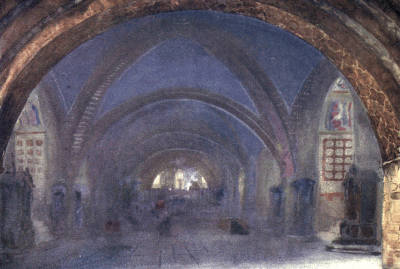
Assisi: the Lower Church of San Francesco.
[153]
I have been many times to see San Francesco since
the first night I climbed Assisi's hill, but I have never
passed from the sunlight, which the little Poor Brother
loved so well, into that shadowy vault without feeling
something pulling at my heart-strings, for there is an
atmosphere of sadness in San Francesco. Below all
this splendour Francis is crushed out of thought just
as his body is crushed out of sight by his massive tomb.
It is Brother Elias, not Francis, whom we meet in
these dim rich chapels; and the fabric of the great
church and convent is a monument to human frailty
rather than to individual holiness. But it is so completely
lovely, so full of memories, with its unbroken
chain of faith and prayer to link it to the thirteenth
century, that I would not have one jot or tittle of it
altered. It is one of the chief gems in Italy's crown
of beauty, an inexhaustible treasure-house.
Every day, although we were living at the other
end of Assisi, our feet wandered down the hillside to
San Francesco. Now it was to hear Mass in the dim
Lower Church when clouds of incense veiled Giotto's
canopy of allegories above the High Altar, and the
peasants knelt humbly round the shrine of the little
Poor One, who having nothing gained the whole world.
Now to gaze upon the pitiful relics of the saint housed
in the magnificent carved presses of the sacristy—the
fragments of his death-clothes; the original
register of Honorius iii.; the Blessing of St. Leo
in Francis' handwriting; and, most touching of all,
the rough sandals which Saint Clare made with her
own hands for the beloved Father, when his poor
weary feet, with their sacred wounds, could no longer
tread the stony Umbrian roads. Now we would wander
through the chapels spelling out the frescoes of Martini[154]
and the lesser Tuscans, pausing awhile before the tomb
of that forgotten Queen of Cyprus, who is only remembered
for her priceless gift of ultramarine, presented
in the porphyry vase which is still to be seen
in the east transept; or by the shadowy tomb of
Madonna Giacobba di Settisoli, the Roman lady who
loved Francis, and ministered to him at the last, bringing
him his shroud and the candles for his burying,
and, pitiful and human touch, the little comfits which
had pleased him when he lay sick in Rome.
Nor did we ever weary of the small cloister of San
Francesco with its faded grey of bricks and mortar,
its cypresses and lichens, and the stemme of the
nobles who lie below its pavement. It is a veritable
home of peace. The walls are veiled in hanging
creepers; there is a little box-hedge and a shower of
sun-flecked acacias and lilacs from which the grey
trunks of giant cypresses soar like the columns of a
mighty temple. Dragon-flies flash through the warm,
pine-scented air, and in the heart of it there is a crucifix
to turn the thoughts of the brothers to holiness, lest
they should be distracted by the sight of so much
beauty, as they walk in the garden before their Mass.
209
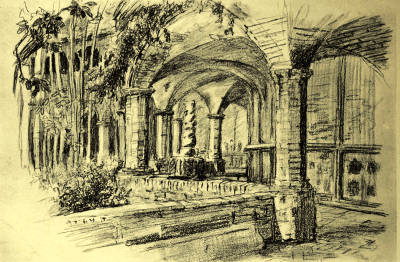
The Little Cloister in S. Francesco d'Assisi.
[155]
And many a golden afternoon did we while away
in the beautiful Gothic Chiesa Superiore, whose walls
Giotto has illumined with the story of St. Francis. It
would be hard to find two buildings in such strong
contrast as the Upper and Lower churches of San
Francesco. The Chiesa Inferiore, with its great barrel
arches, its shadows and its dim frescoes, moves the
world most, for it is full of the suggestion of beautiful
unseen things; but the Upper Church has blossomed
like the flowers of the field above the tomb of Francis.
It is a miracle of light and spaciousness and colour,
with rich stained windows and soaring arches; and the
white cities of Giotto's frescoes, and the exquisite blues
of his many heavens encircle the walls like a gay
ribbon below the faded reds and yellows of Cimabue.
Here at least we cannot but feel grateful to Brother
Elias, for from the beginning the Franciscans were
patrons of the art of painting, and they were among
the first to encourage the independent school of
art as distinct from the work of Byzantium. Giunto
da Pisa clothed the walls of the transept, and Cimabue
and his pupils were called in to complete the decorations
of the Upper Church. Thus it befell that,
while Cimabue was painting some of his masterpieces
on the walls above, Giotto, serving his apprenticeship
and working with the other pupils of his Master's
atelier, stretched out his hand to snatch the greater
laurel.
'Cimabue thought
To lord it over painting's field; and now
The cry is Giotto's, and his name eclipsed.'[17]
Many years later, when his fame was assured, Giotto[156]
came back to paint his allegories in the place of honour
over the High Altar of the Lower Church. What did
he think of it all, I wonder, this Florentine, this lover
of beautiful things, this shepherd who left his sheep
and his poverty and lighted the difficult path of art by
the torch of his genius? Did he too love the memory
of Francis? Or was it beyond his understanding that
a man should dream of giving up all the world to follow
a vision of eternal life? Perhaps he shrugged his
shoulders over the whole thing, and painted on, with
little thought for the saint, but all his heart in his
ambitions, and in the beautiful church which he was
helping to adorn.
Truly it is a temple of Art this Franciscan Holy of
Holies, but pilgrims who are questing for the gentle
spirit of St. Francis should come away, nor hope to
find it in the other great shrine of Assisi, Santa Chiara,
the resting-place of Clare. Santa Chiara is inside the
eastern gate of Assisi, close to the ancient palace of
the Scifi in which the saint was born. It is a bare and
empty church whose frescoes, according to the sacristan,
were white-washed by a seventeenth-century bishop,
because so many strangers came to disturb the nuns!
But this Goth, who is said to have been of German
extraction, left untouched some exquisite gold pictures
of virgin saints over the High Altar, nor did he deem
it worth while to destroy the frescoes which cover the
walls of the ancient parish church of San Giorgio. For[157]
which we should be grateful, because half-hidden behind
the gaudy trappings of its altar are two expressive and
beautiful pictures of the Madonna and Saint Clare.
In this humble chapel where they keep the miraculous
crucifix of San Damiano, we seem to draw a little
nearer to Francis, who must have come here often to
the old priest who gave him lessons in his childhood.
Later, when the Assisans had begun to listen to him,
he preached here until the press became so great
that he was given permission to deliver his sermons
in the then unfinished cathedral of San Rufino. Here,
too, he lay in state while the people of Assisi wept
and gloried over him, just as many years after they
wept and gloried over St. Clare. It would have been
a gentle thought if these two who had prayed and
laboured together in life could have been sheltered by
the same roof in death. Madonna Giacobba, who had
the privilege of coming to St. Francis in his last illness,
lies in San Francesco; but Clare, the Poor Lady of San
Damiano, who had so humbly begged that she might
once break bread with Francis, lies on the hillside far
away from him.
We went down to see her tomb, the rock-hewn
vault in which until fifty years ago she lay, just as the
world had left her seven centuries before, with sprigs
of wild thyme scattered by her mourning sisters still
clinging to her robe. To-day she lies in a gilt and
crystal chest, decked with flowers and jewels and elaborate[158]
velvet cushions. Her strong and rather austere
face with its delicate aquiline nose is outlined against
her snowy wimple, and in the midst of the incongruous
splendour of her resting-place she is clad in the coarse
brown robe and black veil of penitence for which she
cast aside the luxurious garments of her youth. Candles
burn at her head and at her feet, and a phantom-like
nun with a lighted taper in her hand glides from behind
a veil to draw the curtains. It was so quiet that suddenly
I could hear the ticking of my watch out of the
stillness, as though time tried to mark the moments in
that silent chamber where it had been as nothing for
so long.
But how grotesque the wreath of flowers, the thin
halo, the gilded bed! Why not have left that sunken
figure resting on such hard stones as it chose for comfort
in life?
It is only by going out into the highways and hedges
as he did that we can find the real Francis;—in the
little convent of San Damiano, in the Hermitage of the
Carcere, that retreat on Monte Subasio beloved of the
early Franciscans, and in the holy places scattered
through the fields of Umbria in which he worked and
prayed.
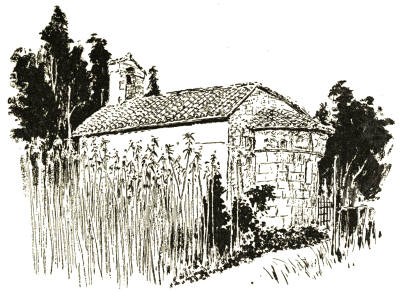
ASSISI: S. MARIA MADDALENA AT RIVO TORTO.
A faint odour of romance clings round the ancient
stones of San Damiano, for there St. Francis laboured
with his own hands to build a habitation of apostolical
simplicity which was to be the spiritual home of Clare.[159]
This humble place, a mere chapel in the olive-gardens
below Assisi, is pregnant with memories of the simple
Francis and the saintly Clare. For it was here, as he
knelt before a crucifix in the little ruined church, that
Francis, the gay merchant-prince of Assisi, heard the
voice of Jesus saying, 'Francis, seest thou not that my
house is in ruins? Go and restore it for me.' It was
just what he needed, this troubled boy. Here was an
obvious work for his hands, and in the doing of it he
might find relief from the fears and doubtings that had
assailed him since he rose from his weary sick-bed and
looked upon an altered world. With no premonition[160]
of his life-work, truly the rock on which the Catholic
Church built up its power when it was in danger of
being swept away in tidal waves of lust and avarice
during the stormy Middle Ages, the ever-literal
Francis bethought him of the letter of his miraculous
command.
It is such an old story that it is not worth retelling,
how he sold the bales of cloth from his father's
warehouse in the market of Foligno and brought
the money to the priest of San Damiano; how the
good man refused it, being fearful of Pietro Bernardone's
wrath; how Francis flung it into the corner of a little
window and would not touch it either; how his angry
father renounced him; and how St. Francis, having
yielded up his earthly goods, begged through the
streets of Assisi for the stones with which to accomplish
his work. There was no more fitting spot in all
Umbria to be the home of the Second Order than San
Damiano. But I think that Clare in her long life
within its walls must have often wept, seeing the rough
stones which Francis, with his tender unaccustomed
hands, had fashioned into a house of God and a shelter
for the Poor Ladies who had renounced the world to
serve his Master.
I remember well coming upon it one evening,
breathless with sirocco, when all the world was gray
and silver. In the little cloister-garden the flowers
were yielding up their fragrance to the night in perfumed[161]
sighs, and in the tiny vaulted chapel two brothers
and a priest were singing vespers with a few peasants
who had wandered in from the fields. A flight of
steps led down into the dark chapel, so little altered
from the church which Francis built. And here I
rested. Every moment the shadows below the olives
crept nearer, shutting out the distance. At my feet
in San Damiano the altar lights grew brighter in the
dusk, and the swinging censer glowed like a live coal
in the dark choir. So I waited, thinking of another
Clare, in England, who was lying sick unto death, but
with peace in my heart, for it was very sweet to hear
Vespers in this holy place while the curious shadows
of night crept up under the olives. Presently the
chanting ceased. The priest went away, and the
peasants passed out into the soft dusk.
I went down then into the silent chapel and saw
the relics of Saint Clare; the little sacristy with ancient
wooden seats, such hard uncomfortable planks, where
she and the sisters heard Mass; the room she died in;
the hollow in the wall through which she received
her spiritual food; her yard of garden overlooking the
wide Umbrian plain and Rivo Torto. How often
as she stood here upon the convent roof must she
have thought of the Seraphic Father toiling down in
the valley, for I doubt not she loved him, even as
Madonna Pica, his mother, and Giacobba di Settisoli
loved him, and hungered over him, and grieved for his[162]
poor weary feet, and exulted in the purity of his
soul.
What memories of Francis and Clare, the true type
of the brother and sister in Christ, are here! Francis
indeed came seldom to the convent after the Poor
Ladies were installed, for as he was not ordained, he
had not the right to hear their confessions or administer
the Holy Sacrament. But we know that he often sent
to ask advice of the saintly abbess; and he stayed here
before his journey to Rieti, when he was worn-out and
sick, and almost blind, and took much comfort in her
sympathy. Here, too, his body was brought, so that
the sisters might look their last upon it before it was
borne in triumph to Assisi. But Clare, whose cry
of grief still has the power to stir our hearts to pain,
lived on through bitter years to see the ideals of the
little lover of Poverty shattered by Brother Elias
and the Papacy before she followed him up the hill
to rest.
The way up to the Carcere is steep and long. The
path is a mere track of broken stones which radiates
heat, and there is no shade to mitigate the pitiless
August glare. And yet I would not have forgone that
toil up the side of Subasio, if only for the pleasures
of the way. Assisi lay behind us like a city of the
Middle Ages, with Gothic towers and palaces grouped
in échelon below her fantastic castle. On our right
the hillside, veiled in the tender grey of olives, sloped[163]
away to the Valley of Spoleto, which was a vision
of pure beauty, with mists clinging about the banks
of its streams, and its many little cities, Spello,[164]
Foligno, Bevagna, tall Trevi and Spoleto, rising
from the green folds of encircling hills. Above
Subasio was barren except for some scanty oaks, but
the bushes by the roadside were heavy with fruit,
blackberries, and shiny red and yellow hips and
crimson haws. Out of the parched stony earth
grew clumps of broom, long-stemmed and slender,
with a crest of golden blossoms like a flight of butterflies;
and scabious, white and purple, rosettes for a
fairy's shoe; and little Morning Glories smiling at
the sky; and sugamele, and that wonderful blue thistle,
which looks as though it had been soaked, leaves
and all, in the rare dye of mountain mists at dawn.
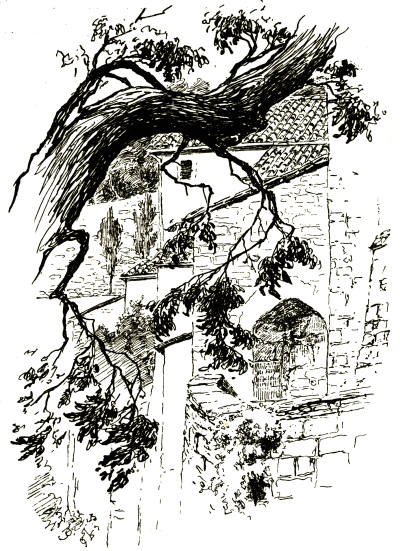
We did not see the Carcere until we were actually
upon it. It is completely hidden in a ravine of ilexes,
in a fold, as it were, of the brown skirts of Subasio.
Small wonder that the Poverello loved this place; it is
so humble, so silent, so restful. Often and often while
he toiled down in the valley, ministering to the lepers
of Rivo Torto, or preaching to the hard of heart,
himself beset with doubts and fears, he must have
lifted his eyes unto the hills, and longed for the Peace
of God, which he knew dwelt in this solitude. Far
away on the spur of the mountain is Assisi, where
he laboured to bring love; and further away still,
beyond the peaceful vales of Umbria, are great cities
in which men worked, and hated, and struggled, ay,
and loved unceasingly. But here in this leafy ilex[165]
grove, in these tiny cells and chapels, there is a little
world of dreams and tender memories.
It is so small that a few minutes suffice to see everything—the
courtyard with its miraculous well; the
narrow cell and chapel of St. Francis, which is polished
by the feet and shoulders of a multitude of pilgrims; the
hole through which the exasperated devil vanished when
he found that his temptations were of no avail; the lonely
caves of the Early Companions in the hillside. It is a
mere cluster of cells overhanging a mountain torrent; but
it has a peculiar beauty as of a place set apart, dedicate
to holiness.
And there is peace in the shadowy ilex wood
in which St. Francis loved to walk, holding converse
with his little sisters, the birds. Myrtle and
cyclamens grow among the grey rocks, and the sunlight
flickers across the mossy path. In the silence
we could hear the song of Brother Wind down in the
glen, the humming of an insect near at hand, and,
far away, a bird calling to his mate. And all the time
the brother, who walked beside us, prated of the miracles
of the saint. I hardly listened, for like an echo down
the years I seemed to hear Francis, the troubadour
of God, singing his canticle of the sun as he toiled
up the barren hillside from Assisi.
'Laudato sia Dio mio Signore
Cum tutte le tue creature,
[166]Specialmente messer lo frate sole,
Il quale giorna et illumina nui per lui,
Et ello è bello et radiante cum grande splendore,
De te Signore porta significatione.'
On a day of never-to-be-forgotten beauty we went
down into the fields below Assisi, and wandered in the
footsteps of Francis and his brother saints. Our way
led out of the town by the old Roman road below the
ancient Porta Moiana, and there among the olives we
came upon Gothic farms, tended by beautiful Umbrian
peasants, and many a humble half-forgotten shrine,
made holy in the thirteenth century, and fallen now
into disuse. There are many such places round Assisi,
within whose walls Mass is only said once a year,
leaving them for the rest of the days to be store-houses
or granaries or sheds in which to keep the wooden
plough of the country-side.
Everywhere were snow-white butterflies dancing in
pairs before us as we passed, or swinging on the slender
flowers that starred the hedges. White doves bowed and
sidled in the golden wheat, and wayside shrines rose from
a tangle of flowers where the cross roads met. And here,
as though it was a custom oft repeated, the milk-white
oxen, which once were deemed a fitting sacrifice for
Roman gods, paused in their rolling gait while their
masters laid down their whips, and doffed their hats
and knelt a moment in the dust before the symbol of
the suffering Christ.
[167]
It was a world of great simplicity and faith
in which we walked. For here in Umbria, down
in these fields where Francis' 'Camp of the Lord'
set up their wattle huts, faith is a real and potent
thing. They do not doubt, these people, these
rugged-faced men, these Madonna-like women—they
never will doubt. To them the mysteries of the Incarnation
and Ascension are accepted facts. In simplicity
and faith they rise up in the morning and lie
down again at night, never fearing that their prayers at
dawn and evening, their hastily uttered petitions at a
roadside cross, have not winged their way straight to
heaven. I too would fain believe it when I am
walking in their olive-groves and vineyards, for it is a
lovely thing, as dreams are lovely, and young ambitions
and young hope. And it is here perhaps that the
secret of the intangible beauty of Assisi may be found—because
it is a shrine; no matter of St. Francis, or of
Jesus of Nazareth, or of the older gods. Out of the
wreck of time the flame of worship and faith has been
kept burning; the stones upon this altar have never
darkened and grown cold.
It was the season of the husking of the maize, and a
happy harvest air hung over everything. Each farm
had its pile of fragrant white husks outside its door
ready to replenish the mattresses of the household, and
the corn was spread out on the threshing-floors like a
golden carpet. Sometimes we saw the family gathered[168]
there to shell the cobs, and sometimes we came upon
them sitting below their olive-trees, separating the
yellow corn from its white sheaths, and heaping them
up on either side the gold and silver largesse of the
Great Mother.
It was in the midst of all this pastoral loveliness
that we came to Rivo Torto, which is so bare and ugly
and un-Franciscan in feeling. Poor and humble, but
far richer in the spirit of St. Francis than the great
church of Rivo Torto, are the two chapels of Santa
Maria Maddalena and San Rufino d'Arce, which may
mark the approximate site of the hut in which the
saint dwelt while he was ministering to the lepers.
We found Santa Maria Maddalena in a field of hemp,
whose tall slender stalks and green tassels veiled the
ancient apse and narrow lancet windows. Golden
pumpkins were piled shoulder-high outside its wall,
drying in the sun; and the interior, when at last it was
unlocked, proved to be a potato store. Even more
dilapidated is San Rufino d'Arce, which stands further
from the road near the threshing-floor of a neighbouring
farm. Nor could the lovely peasant woman, who
brought its key and walked like a queen barefoot
among her golden corn-cobs, tell us anything of its
miraculous well in which, tradition says, a young boy
saint was drowned.
225
[169]
But now, as we drew near it, along the dusty white
road which links Perugia to Rome, the dome of Santa
Maria degli Angeli towered above the plain. This is
the holiest place in Umbria, the Little Portion, beloved
of St. Francis and his brethren, in which they lived
and worked, and from which they issued forth to preach
the gospel of love and repentance to the world. It is
sanctified by miracles and the frequent presence of the
saint, and is pregnant with the romance of the Franciscan
order, which the writer of the Fioretti has set forth so
admirably. But overmuch devotion has robbed it of
simplicity and nullified many of its gentler associations.
It is a pathetic sight to see the little church, consecrated
by centuries of prayer, in the centre of the
sixteenth-century Leviathan. It looks like an imprisoned
thing, a dim unspoken reproach. I wish they
could have left it in its fields, where the wild sweet
wind would have sung praises through door and window,
and the ardent sun have shamed the candles on the
altar. But just as the papacy swept away Francis himself,
so this great church has swallowed up the Little
Portion which was all-sufficing for so many saints.
A gentle, white-haired friar took us round the church.
'Here by this pier,' he said, 'Francis dined with Clare.
And this is where he died. You know he wished to
die here. He loved the Porziuncula better than any
other place in the world.'
And then we saw the thornless roses of St. Francis,
and his cell, and the garden where he bade the brothers
put cabbages into the earth upside down to test their[170]
obedience, and the fig-tree which the brothers lately
planted at the request of two Englishwomen, to take
the place of the tree wherein the cicala praised God
continuously with Francis until the saint begged him
to rest because he had edified him enough.
He was a simple, dear old man, our guide, who told
his stories smilingly and yet with reverence and faith,
very different from the unkempt and cynical monk at
Rivo Torto. And when he had finished he took us
into the sacristy and gave us a little book he had
written about Saint Mary of the Angels, and a
rose sprig from the bush which lost its thorns when
St. Francis threw himself into it. And so we parted,
he to his prayers, we to climb up through the fields to
Assisi.
[171]
GUBBIO
I shall always think of Gubbio as I saw her first, in
the magic sunset of a cold grey day, on which summer
had been hidden by the jealous clouds, and the wind
blew bleakly from the Appennines. September had
come in the night before with storm and wind. When
we left Assisi the sky was clear and rain-swept, blue as
the heavens of Giotto's frescoes in the Upper Church
of San Francesco, and there was a glint of sunshine
lighting her Gothic towers between the racing cumuli.
But all day the mountains of Nocera and Gualdo
'mourned for their heavy yoke,' hiding their crests in
wind-blown veils of cloud; and the rocky stream-beds
at their feet, which had lain mute and parched since the
last rains of spring, gave voice in swirling torrents.
So we came to the heart of the Appennines, to the
broad Valley of the Chiaggio, which is so rich with
maize and vineyards. Here in the north three mountains
lift their great heads to the sky, and in the hollow
where their three slopes meet lies Gubbio, a fairy
citadel such as poets dream of. Indeed, Gubbio might
well be the home of dreams, for I can think of no place[172]
where their gossamer threads could be so lightly spun
as in the long, fantastic arcade of the Mercato Vecchio,
in the shadow of her Gothic palaces.
As we drew near, the sun slipped from below
her mantle of cloud, and in a seeming passion of
desire bathed the whole world in flame. Seen by the
ruddy torch of this wild sunset Gubbio was all rose, a
city of fair dreams, unforgettably lovely. Her towers,
palaces and loggias were illuminated, and the bare
slopes of Monte Calvo were flooded with roseate light
save where the folds of the hill made cobalt shadows.
Even the peasants walking in the Piazza del Mercato
were caught in the same radiance, which made a glory
round the humblest implements of toil. It was so fair
a sight that I stood as one enchanted and feared to
take my eyes away from it, lest it should vanish like
the fairy cities of our childhood, and I should find myself
once more upon the bleak hillside of life.
O little town, with the name whose quaintness has
made it familiar, do you still sleep at the foot of
your mountains under the shadow of your holy houses?
Can it be that I have dreamt of you, seeing some
picture of a mediaeval city in a psalter? Or does your
lamp-lighter still light your ancient swing-lamps in
the dusk, with old-world grace and disregard of time,
setting out on his slow rounds long before the sunset
glow has faded from your brow? I must come back to
see if it is true; if your barren hills have really[173]
blossomed into shrines and monasteries; if you have
still the wistful charm that I remember; if you will
greet me after the long journey with that same rosy
blush at eve!
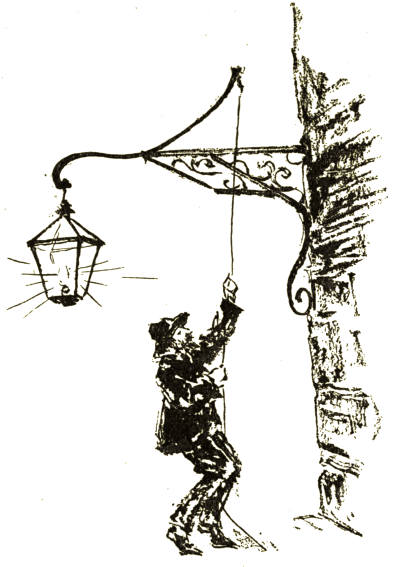
And yet, I do not know why I should question, for
I have many gentle memories of Gubbio—of steep,
quiet streets whose ends are closed by solemn mountains;
of Gothic palaces and loggias; of ancient churches
full of faded pictures; of saints and Madonnas brooding[174]
over city gates; of peasants streaming into Mass of
a morning; of women in black mantillas or the graceful
fringed shawls of Venice and the March. Nor have I
forgotten the hospitality that she extended to us.
Gubbio was always famous for her hospitality. There
is a story that in the olden days the nobles of Gubbio
fought so fiercely for the right of entertaining visitors
to their town that to avoid the really serious conflicts
which resulted from this rivalry a pillar was erected in
the Mercato with rings attached to it, 'each belonging
to some separate aristocratic house, and to whosesoever
ring a traveller chanced to fasten his horse, to him
belonged the right of entertainment.'[18]
Though our inn was humble, even rough, we were
lodged in the ancient convent of San Marco, and we
took our meals in a vine arbour full of hanging grapes,
where the sunlight piercing the leafy roof flecked the
snowy table-cloth with silver, and made the floor an
arabesque of dappled light and shade. A few yards
away among the vines the Carmignano foamed along
its rocky bed. And here we were content with simple
fare, but of the best—macaroni spread with pomidoro,
misto fritto, golden eggs, fruit and honey, washed down
with amber-coloured vino del paese.
Whatever may be the facts about the grandson
of Noah, to whom local tradition loves to assign the
foundation of Gubbio, there can be no doubt that[175]
she is of Umbrian antiquity. Unlike most of the
so-called Umbrian cities Gubbio has ample proof of
her importance as a city of the older race, which was
displaced by the Etruscans; for besides the number of
prehistoric utensils discovered in the caves of her
mountains, and a short course of Cyclopean wall on
Monte Calvo, which point to a remote civilisation, there
are certain pieces of money in existence bearing the
Umbrian name Ikuvini; and, most conclusive evidence
of all, there are the world-famous Eugubian Tables.
These tables of bronze, which have been of such
inestimable value to the student of ancient languages,
are Gubbio's greatest treasure. They are housed in her
Palazzo Pubblico, in her little shrunken museum, which
has so few precious things left to-day, except a solitary
tazza by the immortal Maestro Giorgio. It would be
useless for me to write of them at length, for it is
impossible to treat of them scientifically in a short
chapter, and only those who come to see them can
gauge the romance and mystery which hang about them.
There are seven tables in all, four written in Etruscan
characters, two in Latin, and one partly in Etruscan
and partly in Latin characters. Yet the language that
they have immortalised is neither Latin nor Etruscan,
but the tongue of that mysterious people, the Umbrians,
who have left us so few traces of their civilisation, whose
origin is lost in the misty ages.
Since the discovery of these tables in 1444 students[176]
and scholars have sought to read their riddle, and it
is by the fruit of their labours that we know what
an interesting clue they afford to the character of
Gubbio. For these fine letters traced by the scribes
of long ago are sacerdotal inscriptions, dealing
with the religious rites of the Attidian brethren,
who paid homage to a strange pantheon of gods—Umbrian,
Roman and Greek—and whose headquarters,
according to many students, were in the temple of
Jupiter Appenninus, eight miles away, at Scheggia, on
the old Flaminian way. M. Bréal, however, does not
hold this theory, claiming that Jupiter Appenninus is
not mentioned in the text; and urging the plea that as
the tablets were discovered in a subterranean vault, near
the ancient theatre of Iguvium, the college of the
confraternity was likely to be found within the city
itself.
It would be difficult to say, for necessarily the
reading of the tablets is but vague; the only point
we can be certain of is that this ghostly echo of a
vanished city is one of prayer and invocation, occupied
with sacrifices and propitiations rather than with laws
or ceremonies, as the inscriptions of Rome and Etruria
have been. And this is typical of the city, for the real
characteristic of Gubbio to-day is her gentle air of
sanctity, just as the most vivid memories of her Middle
Ages are concerned with saints and bishops. For the
bishops of Gubbio, the saintly Ubaldo, whose name the[177]
people of Gubbio venerate in the yearly festival of the
Ceri on the 15th of May, the blessed Teobaldo who
succeeded him, and Villano, that man 'of pure and
saintly life who was, besides, the friend of St. Francis[178]
of Assisi,' are only a few of the many holy men who
steered her helm through the stormy waves of Time.
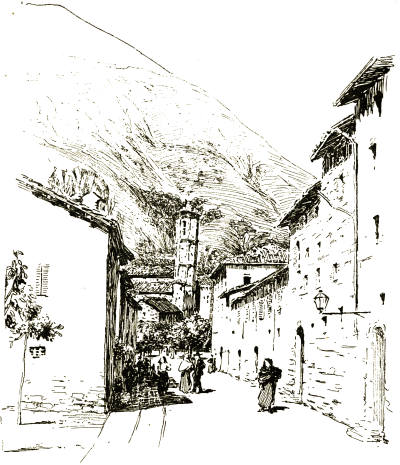
And here, as you remember, St. Francis came
with song and thanksgiving, although he had been
but a short time before stripped naked to the world,
to see his friend Giacomello Spada, who clothed him
and sheltered him, and whose garden covered the
ground where the picturesque Gothic church of San
Francesco stands to-day. Nor is there any more
familiar story told by their nurses to the breathless
children of the Latin countries than the legend of
St. Francis and the Wolf of Gubbio, which is commemorated
to this day in the little chapel of S. Francesco
della Pace; built, so it is said, on the site of the cave
wherein the wolf dwelt after he had been tamed by the
brotherly love of Francis. It was to Gubbio Francis
came in the first glow of his renunciation, for we read
that he was confident of finding shelter and the bare
necessaries of clothing with his friends there, but I think
there was another reason. Perhaps as he lay on the
bleak side of Subasio he thought with longing of the
gentle city of Ubaldo, cradled at the foot of its bare
mountain, which soared towards the heavens, offering,
as it were, upon an altar, the body of its saintly bishop.
Gubbio is a city of vanished splendours, a ghost
of her old glory. So that we were amazed on entering
Santa Maria Nuova to see anything so brilliant and
full of vivid beauty as the Madonna della Belvedere,[179]
which Ottaviano Nelli painted there. Like Sant'Agostino
and San Pietro, Santa Maria has her share of
faded fresco; but this Madonna in her splendid robes, in
the midst of her gracious court of angels and saints
and kneeling donors, is a vision of the glories of that
Gubbio which once raised a proud head among the
principalities of the Quattrocento. Yet not even Nelli
has succeeded in colouring the past of Gubbio. For
nearly all her treasures have been stolen from her, and
her tired old walls toppling to their decay enclose more
gardens and smiling vineyards than streets and squares.
If she had not been so poor and so ready to sell herself
for a few soldi to the passing stranger she might have
been a museum of lovely things. As it is she has been
stripped of everything which could be carried away, from
the exquisite majolica of Maestro Giorgio (whose ruby
glaze made him as much the glory of sixteenth-century
Gubbio as Oderigi was of the city visited by Dante) to
the intarsia cabinets in the Palace of Federigo of
Urbino.
How typical of Gubbio, the shrunken city, is the
ruined palace full of lovely crumbling stones, where
Federigo and his beloved wife Battista lived. It is
fallen into decay; it has become a mere barrack; a more
desolate spot could not well be imagined. And yet it
is a fitting symbol of the house of Montefeltro; for
Guidobaldo, the weakling son of the great condottiere,
was born here, in the house which Federigo built so[180]
proudly in his birthplace among the loyal people of
Gubbio. And it was the scene of a great tragedy. For
here Battista died.
After her death Federigo came here less often,
for we read that he loved Battista very dearly. She
had inherited the wit and ready sympathy of her
great grandmother, Battista da Montefeltro; she was
a scholar, and a woman of resource and courage,
capable of defending the duchy while Federigo was
absent on his long campaigns. And withal she loved
him. It was for this reason, knowing his disappointment
because she had given him no heir to succeed to
his hard-won estate, that this great woman, the grandmother
of Vittoria Colonna, listened for her lord's sake
to an old wife's tale, and making a pilgrimage to Gubbio
vowed to Saint Ubaldo that if a son was vouchsafed to
her she would be willing to die for his sake. A curious
story. But she did bear a son, here at Gubbio, whither
she had come to be under the special protection of the
saint. Federigo was away in Tuscany, gaining more
laurels by his great victory over the Volterrans. He
came back to her as soon as he could, riding swiftly
through the Appennines with his honours fresh upon
him. And here is the strangest part of the story. For
when he was but a few hours away Battista, who had
been progressing so well, fell ill, and died soon after his
arrival, thus expiating her vow. Federigo's heartbroken
letters to the Senate of Siena and the Pope
testify his grief. Nor did her love and sacrifice avail
him anything, for Guidobaldo was the last of his race to
sit upon the throne of Urbino.
239
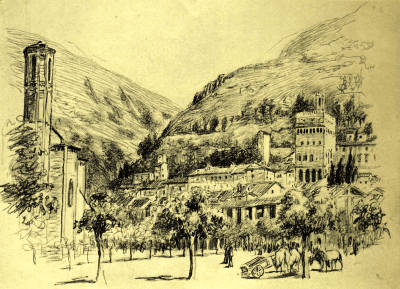
Gubbio: Piazza Vittorio Emanuele.
[181]
But neither Time, nor the wanton hand of strangers,
can rob Gubbio of her beauty. She is a dream-city
within whose walls we grew forgetful of the world.
It is not the imperishable grandeur of her mountains
or her monuments which constitute her special charm
so much as her Gothic grace and her gentle blending
of art and nature. See what a fraction of old
Iguvium is left—a theatre, with its memories of
vanished pomps and vanities, and some broken tombs
standing in the corn-fields, with twisted vines veiling
their ragged cores, and brambles tossing wide arms
over their crests. And yet I carry with me the
memory of a golden hour in that ancient Umbro-Roman
theatre of Iguvium, not so much for its
importance as a monument as for its beauty; although
the vandalism of the last century, which allowed the
people of Gubbio to strip it of its marble columns, has
left it many interesting fragments, such as a perfect
doorway with its jambs complete, and the unspoilt
sloping pavement of the wings by which the actors
entered the stage. For we approached it through a
vineyard below the city walls: its auditorium was a deep
semi-circle of grassy steps, broidered with little flowers,
and in its proscenium the apples dropped from neighbouring
orchards.
[182]
We stepped through the vineyard gate on to the
raised platform of the stage, denuded of everything
except some stumps of masonry and some few feet of
pavement. Three blocks of marble served as rough
steps from the proscenium to the orchestra, and
here a lizard sunned himself, and a happy golden
butterfly fluttered, as though these old worn stones
were their familiar playground. As we climbed up
the seats where once the Romans sat, and perhaps
the Umbri, for the theatre was repaired in the lifetime
of Augustus, the scent of crushed thyme filled
the air. It was very quiet. There were not even
cicalas, only the distant bells of Gubbio calling her
people to prayer. We sat on the highest circle of
the mossy steps, and looked across the vineyards to
the little city, asleep in the golden noon below her arid
hills.
The poet was deep in opus reticulatum and
cornices and friezes, but I could only love the
silence and the scented air, the little flowers which
starred the ground, the grasses pencilled lightly against
the sky on the chain of arches, the lizards sunning
themselves on broken marbles, the butterflies dancing
above them. And when I raised my eyes Gubbio lay
before me with olive-gardens enclosed in her broken
walls, and her old grey houses piled one above the
other round her lovely Gothic Palazzo dei Consoli,
which soars above the lesser roofs, arcaded and[183]
battlemented, a crown of beauty on the hillside.
Behind rose her three mountains, Monte Calvo, Monte
Ingino, and Monte S. Girolamo, barren of everything
but lonely cypresses pointing the way to monasteries
on high.
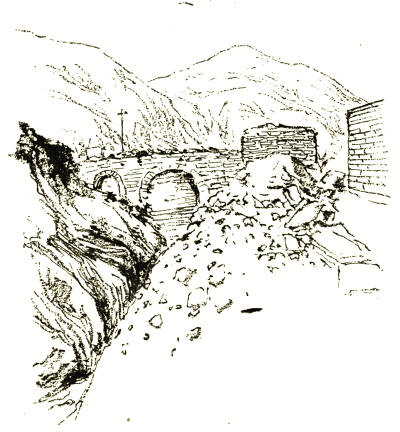
GUBBIO: THE MEDIAEVAL AQUEDUCT.
Gubbio has the indefinably wistful charm of a city[184]
built in the shadow of great mountains, for though she
has conquered the three giants which hem her in, and
left her monasteries as out-posts on their slopes, and
solemn crucifixes as her ensign on their brows, she has
not tamed their wildness. It needs only a few steps
through the picturesque old Porta Metauro to prove
this, for out in that rugged pass which leads to
Scheggia, and the Old Flaminian Road, and Cagli,
and Urbino we were hemmed in between the hungry
mountains, whose sides are scarred by torrents,
curiously seamed, and richly coloured.
Along this road the Dukes of Urbino rode in splendid
state. How little it is altered from their day! Here
you are face to face with Nature, who changes slowly.
The strata on the frowning cliffs are a little worn;
the road is a little better, though it is a poor strada
even now for motors; perhaps there was no wall then
between the road and the deep gully where the green
Carmignano stirs up its sandy bed. But the peasants
rode up the hilly pass then as now with their women
riding astride and a-pillion on mules or donkeys, and
the traveller in that day would hear as we did the
forlorn music of their bells still floating back, long
after they were out of sight. On the hillside
above was one of Gubbio's wonders—the mediaeval
aqueduct which creeps perilously round the shoulder
of Monte Calvo, and dips down the hillside to the
Bottaccione, which I can best describe by saying that
it is a thick wall which joins Monte Calvo to Monte
Ingino, and dams the Carmignano, making a reservoir
from which water can flow at will into the town
for use in mills and fountains. If the Eugubian
Tablets testify to the importance of ancient Iguvium,
these vast engineering feats testify to her mediaeval
greatness. For though they are not as imposing as
Roman Monuments, and are built of small poor stones,
they are a splendid testimony of the energy of this little
hill-girt city in the twelfth and fourteenth[19] centuries,
when most principalities were too occupied in petty
wars to think of such stupendous work.
245
[185]
It would be unfair to Gubbio to take leave of her
without saying one word about the Via Carmignano,
which is not only one of the most picturesque streets
to be seen anywhere in Italy, but which represents a
sphere of life in which Gubbio was extremely active
from the twelfth century to comparatively recent years—her
woollen industry. It is rather astonishing that
Gubbio, who had so many trades and arts, should be so
poor to-day. Her school of painting which was mainly
of the miniature type—for Ottaviano Nelli was as much
a miniature-painter as the mysterious Oderisi, whose
name, like Francesca da Rimini's, has been handed[186]
down to posterity by Dante—was famous throughout
Italy.
I have already spoken of her renown as the home of
Master George, the great majolica-maker; she sheltered
a school of mosaic-workers from early times; and her
wood-carvers, who have left splendid work in her old
Church of San Pietro, were reckoned so important that
a certain Niccolò was commissioned to carve the great
doors of San Francesco at Assisi. But it was by her
wool industry that Gubbio built up her wealth; and it
was to turn their wool mills that the Eugubians built the
Bottaccione out in the pass between Scheggia and
Gubbio, and diverted the course of the Carmignano,
which till the twelfth century had been a moat round
the city walls.
To-day this little mountain torrent still runs through
the heart of Gubbio, but the mills are silent. For
the woollen trade, which was so prosperous in the
twelfth and thirteenth centuries that the nobles passed
a law forbidding any of their class to enter its ranks
under penalty of forfeiting his title, has been slowly
killed by the suppression of the monasteries, which has
robbed it of its staple support, the making of habits for
religious houses.
The Via Carmignano is a little Venice which loses
itself in a mountain torrent as it approaches the Porta
Metauro. Behind the arcaded loggia del Mercato,
where it runs at the foot of the cypress garden of San[187]
Giovanni Battista, a picturesque and ancient church on
the site of the early cathedral, the ravine is spanned by
as many bridges as a Venetian waterway, mediaeval
erections of the maddest shapes, full of fantastic angles,
which sometimes only lead to the barred doors of
some Merchant of Gubbio's private house. Here are
Gothic palaces with gardens pouring over their walls,
and coats of arms by their doors like the house near the
Via dei Consoli, which has the Lamb of the Templars
over its portal. But as the road creeps up towards the
Porta Metauro they are replaced by thirteenth-century
houses, mere cottages of rough grey stone such as you
might find in any mountain village—only these were
built in the time of St. Francis. Between the street
and the deep river gully is a breast-high parapet with
wide-eaved shrines whose hanging lamps are always lit
at night; and beyond and above are the everlasting
hills, towering overhead, blocking every vista with
their rocks and gullies and stony water-courses, lifting
their tawny heads up to the soft sky and crowned with
giant crucifixes, as though they shouted in triumph to
an unheeding world the old war-cry of the Lord, 'In
hoc signo vinces!'
[188]
ANCONA
We caught our first glimpse of the shimmering Adriatic
across a richly-farmed plain full of the fruit-trees which
Horace and Juvenal extolled; and soon afterwards we
saw the Eastern Gate of Italy, beautiful Ancona,
rising like a city of white marble above its blue, sickle-shaped
bay.
The history of the origin of Ancona is unique among
the cities of the Adriatic, for she was founded by a
colony of Sicilian Greeks who came to the shores of
Picenum about 380 B.C., seeking refuge from the tyrant
Dionysius. Ancona is a typical Greek site, a natural
harbour well adapted to the use of commerce, with a
steep hill overhanging the 'elbow' bay. From the
earliest times she was rich and prosperous, for besides
being the only port on the eastern coast before the
growth of Venice and Ravenna she was situated in
the fertile fields of Picenum, which were noted for the
excellence of their olives and fruits, as well as for their
wine and corn. She also had a wonderful purple dye
which was said to equal that of Phoenicia, whence
came the garments immortalised by Macaulay.
[189]
'Woven in the land of sunrise
By Syria's dark-browed daughters,
And by the sails of Carthage brought
Far o'er the southern waters.'
She was one of the first cities to hold out friendly
hands to Caesar after he had crossed the Rubicon on
his march on Rome, and in the life-time of Pliny she
was raised to the rank of a Roman colony. Later
when the Emperors and after them the Exarchs held
their courts at Ravenna, Ancona was of even more
importance than Ravenna as the natural trading port
with the Byzantine Empire.
To-day she is a large and prosperous city, with
broad streets and boulevards given over to the tyranny
of electric trams. She is like Alexandria, or Marseilles,
with her busy wharf life on the one hand and her
piazze with their fountains and bandstands and their
alfresco cafés under avenues of plane trees on the
other. Her restaurants are dear, and her inns bad;
her inhabitants are the most disagreeable people we
met in Italy—with all the taciturnity of the Venetians
and none of their picturesqueness; but we were able
to forgive her everything for the beauty of her
cathedral, and for the first view of her wide bay with
the pictured sails of her fishing-boats poised like a
flight of butterflies on its mirroring waters.
In Ancona, while I am down in the noisy streets, my
heart is always up on the grassy hill above the Mole[190]
of Trajan, where the Cathedral of San Ciriaco is set
like a jewel on the crest of Monte Guasco. Truly it
is on their hills that you may know the cities of Italy.
For up there, far removed from the unlovely bustle of
her streets with their clanging tramways, their painted
kiosks, their matter-of-fact commercialism, we seemed
to creep unawares right into the heart of Ancona.
Coming straight from the peace and breadth and quiet
of Umbria we had found her peculiarly unattractive.
We had pictured a city of romance, for Ancona has
ever been Italy's link with the Orient; the wealth of
Byzantium has been unloaded in her harbour; the
merchandise of the East has stood upon her quays.
And in the first flush of our arrival, when we stood
upon the wharf and saw the brilliant wings of her
fishing-boats drifting in from the Adriatic, she seemed
for a moment to be the city of our imaginings—a
fleeting fancy, not easily recaptured on the boulevards
of the modern city. But on the hill of San Ciriaco,
far above the noisy town, with the Adriatic filling the
horizon, and the soft bells of the incomparably lovely
church of the first bishop of Ancona wafting a benediction
to the fishing fleet as it sailed into the sunset,
she became once more our Port of Romance, true
sister to Venice, the beautiful bride of Italy's Eastern
Waters.
There was nothing to prepare us for the exquisite
vista which unfolded itself before us on the crest of[191]
Monte Guasco as we toiled up the steep stair-streets
which scale the Cathedral hill. The houses were old
but undistinguished, the homes of the very poor, who
do not even have windows in Italy, but live behind
stable doors in bassi. Nor did we realise the moment
at which we emerged from them, for our eyes were
blocked by the bell-tower of age unknown which
stands like a sentinel before Ancona's Cathedral.
There is no church in Christendom so enthroned. It
is built between two tideless seas on a wind-swept hill,
which was once the seat of the white temple of the
laughing Goddess of Eryx—Aphrodite, who was born
of the foam.
Beside it is the old Episcopal Palace in which
Aeneas Sylvius, the last of the crusaders, waited for
the false Patriarch of Venice to set sail with him
against the Turks. Poor Pius II., with his quixotic
and splendid dream of reconquering Jerusalem for the
Papacy, how often must he have stood on the bulwark
of San Ciriaco's hill watching for the galleys of the
Venetian to come into sight. And when at last they
did sweep down upon Ancona he was no longer waiting;
he had embarked alone upon a longer journey;
the last and most incomprehensible of the crusades
had failed!
We, too, stood upon the crest of Monte Guasco
behind its bulwark of acacia trees, on our first evening
by the Adriatic, and looked down upon the busy wharf,[192]
with the long arm of Trajan's Mole encircling the
harbour, and the white crescent of Ancona stretching
round the bay to Monte Astagno. It was nearing the
hour of sunset. Across the sunlit water we could see
the great Appennines towering towards heaven, aerial
as clouds upon the horizon. There Rimini lay, on
that fair coast, and Venice and Ravenna, the homes of
Poetry and Romance. But near at hand Ancona's fleet
of bright-winged boats was spread across the bay. We
stood and watched them sailing out into the west,
slowly, for there was little wind to fill their gold and
copper sails. They looked like argosies of Love
journeying into a land of sunset mists across a painted
sea. Surely they must come back to-morrow with
dreams below their wings, and little lovely treasures
from the land whither they were sailing to-night!
Slowly they crossed the bar—now a crimson wing tapering
to gold with a black griffin rampant; now an orange
Gonfalon bearing a lion and anchor; now one of black
and gold, now one of Venetian brown. We watched
them drifting out, and always the west grew more
golden and the distant mountains more aerial until
the sea was a path of flame from the far-off coast to
Trajan's Mole, where the sunset gilded the black hulks
of the coal-ships in the harbour. Ere the last of
those fantastic birds had winged its way out to the
deep waters, the lights of Ancona had begun to twinkle
in the dusk, and the bells of San Ciriaco were stilled.
255
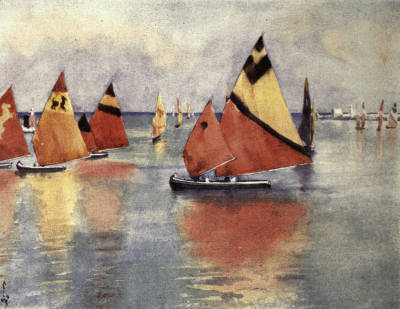
Ancona: the Fishing Fleet.
[193]
San Ciriaco is worthy of its site. Begun a thousand
years ago in the form of the earliest Christian temples,
half Byzantine, half Romanesque, it preserves the
original Greek cross of nave and transept, and is
crowned by an antique dome, one of the oldest in Italy,
which time and the salt breath of the Adriatic have
painted a wonderful green, the despair of artists. The
exterior of San Ciriaco is of almost Eastern simplicity,
but sun and wind have mellowed the dazzling white
marbles of its walls to such gracious tints that it
is like a perfect fruit ripened slowly to perfection
through the centuries. Its chief glory is the Gothic
portico of rose-red Verona marble which tradition and
Vasari assign to the hand of Margheritone d'Arezzo,
the sombre painter of crucifixes, who was so jealous
of Giotto that he died of spleen. Two couchant lions
at the head of a flight of steps support its outer columns,
and within it is blush-hued, with slender columns,
alternate rose and white, wrought with a delicate frieze
of the heads of saints and the grotesques of mediaeval
fancy.
Nor has the interior of this noble church suffered
much from the hands of the restorer. It is a granary
of rare and interesting Byzantine fragments, and its
choir is graced by ten of the marble columns which once
stood in the temple of Aphrodite.
Ancona of to-day is a garden where the beautiful
flowers of an ancient architecture are still flourishing[194]
among the energetic weeds and herbs of everyday life.
Between the two horns of her crescent bay, Monte
Astagno, crowned by the Spanish bastions of the
Fortezza, and Monte Guasco, which enthrones the
lovely church of San Ciriaco, there is a network of
streets. Let us for the sake of the metaphor suppose
that these streets are paths in the garden of Ancona;
and let us walk in them, searching in the tangle of hardy
commercial upshoots for the delicate blossoms which
graced the pleasances of the Middle Ages and the
Renaissance. More than this, for down in the crowded
port we shall discover the ancient growths of the
Roman city in many a broken arch on whose blackened
stones a Gothic spandril has been grafted, and in the
glorious Triumphal Arch which the Imperial Plotina
and her sister-in-law raised in honour of Trajan.
Between the shrieking railway station and the Porta
Pia there is nothing to detain us; this is more or less
a modern suburb which has sprung up since the foundation
of the railway; but at the Porta Pia, which stands
at the foot of Monte Astagno, we enter the old harbour.
To our left is the picturesque Lazzaretto built by
Clement XII. in 1732, now used as a sugar refinery; and
in front we see before us the curving bay of Ancona,
with its grand new quay or Banchina, of which the
Anconans are so proud. The Via Ventinove Settembre,
whose name like the ubiquitous Venti Settembre commemorates
the expulsion of the Papal troops in 1860,[195]
takes us into the heart of the modern city; but it is not
in her wide Corso Giuseppe Mazzini, or Vittorio
Emanuele, or Piazza Cavour that we shall find anything
of the old Ancona. Here she is as modern as her names
betoken, although the fruit-market in a curious uphill
square and the fish-market below the picturesque
sixteenth-century fountain of the Corso Giuseppe
Mazzini are as picturesque and irrelevant as any market
in Italy.
It is in the southern wing of the city that we shall
find the flowers we seek, in the steep Strada delle
Scuole which runs through the centre of the graceful
arcaded Court of the Prefettura, and the Via Aurelio
Saffi, the most characteristic and romantic street in
Ancona. In the Strada delle Scuole we see the great
church of San Domenico with the colossal statue of
Clement XII. upon its steps, and San Francesco with
its riotous Gothic façade towering over the narrow street
from its lofty stairs, and the Palazzo del Comune built
by Margheritone d'Arezzo, and much restored and
modernised in the seventeenth century.
But it is in the Via Aurelio Saffi that Ancona
flowers best; for in this centre of the busy wharf life,
which has been given up to the merchants and bankers
of the eastern port, we find such gracious little basilicas,
enriched with carvings from Byzantine bestiaries, and
Gothic porches and façades flowering into the Renaissance
under the Oriental touch of Giorgio da Sebenico,[196]
the last Gothic architect of Italy. Here is the Loggia
dei Mercanti, very florid and flamboyant, with its tilting
knight a-horseback; and close beside it Napoleon's home
in Ancona, the Palazzo Benincasa, with fifteenth-century
Gothic-Renaissance windows; and here, standing a little
back from the rattle of the modern port traffic, with
pigeons resting on its many little arches, is Santa Maria
della Piazza, with a Pisan-romanesque façade, soft and
eaten by the years, encrusted with ancient sculptures
and dusty majolica plaques. Opposite this ancient
and beautiful church a gateway with another relief of a
knight on horseback, like the splendid gilt knight of the
Loggia dei Mercanti, leads into the big docks; but it is
better to go down the Via Aurelio Saffi, though at the
first glance it seems to be given up to shipping agents
and barbers. For here, in the shadow of the old old
Palazzo del Comune, which is carried up on gigantic
arches to the level of the road above, we find the little
church of Santa Maria della Misericordia, with its curious
Renaissance portal, its one Byzantine ambo, and its
elegant mosque-like interior of brick with stone cornices,
pillars and groinings only thinly disguised by
plaster. A little further up is a doorway of Roman
masonry, and two ancient arches, with uncemented
blocks up to the cornice but Gothic work above. And
soon afterwards the narrow street debouches on to the
wharf.
Not in all Italy is there such a quay, or such a blaze[197]
of colour! A long line of mediaeval wall, of burnt red
brick machicolated, runs down the Mole, and in its
shadow are some low trattorie covered with Morning
Glories. High above these, raised on a flight of steps,
the arch of Trajan, with its marble painted grey and gold
by rain and the years, is framed in the blue Italian sky.
Beside it the bronze and copper sails of the fishing-boats
are massed together among the black colliers, and above
and behind are the green hills of Ancona, with her red-roofed
houses climbing up their wide slopes, and Monte
Guasco crowned by the white jewel of her cathedral.
It has been said that Trajan's arch is the most beautiful
and perfect Roman arch in Italy. I do not know. It
is wonderfully unspoiled and graceful, extremely simple
in design, plainer even than the arch of Titus on the
brow of the Velian. But surely there is no other
Roman monument which has so rich a setting!
Though we spent a long morning down in the
harbour, hemmed in by the amphitheatre of Ancona's
hills, now watching the fishermen mending their big
brown nets, now engrossed with the picturesque wharf
life—the sailors clad in bright blue linen at work
among the black hulks of the coaling ships, the oxen
toiling over the stones, their snowy flanks grey with
dust and dirt, the lascars of ocean-going steamers whose
scarlet turbans lent a fresh note of colour to the animated
scene—our first and last thoughts of Ancona were with
her fishing-boats. For when we left her they fluttered[198]
after us like butterflies out of a garden as far as Falconara,
just as they had come to meet us when we drew
near her sickle bay.
To watch the boats of Ancona drift into the little
harbour at sundown, furling their sails, is to find oneself
taken back to the Age of Beautiful Things when the
ideal form and colour were as natural as sunlight and
shadow. It was for this reason that we took rooms in
the Albergo Milano, which is a bad and cheerless inn,
for below our windows lay the whole fleet of graceful
craft, with up-curved bows like ancient galleys, and sails
emblazoned with devices, flaunting gay colours—old
gold and purple, and Venetian browns and reds at
dawn and sunset.
Although her white temple has long since vanished
from Monte Guasco, Aphrodite, the goddess of fair
and prosperous journeys, still keeps watch over Ancona's
bay. In these halcyon-days we forgot that the vines
of Umbria were already yellowing under the autumn
rains; we hardly realised that these smiling waters were
of an eastern sea.
Think of the coast of Norfolk in the cold wet
days of an English September, when the North
Sea thunders along the shore as though Poseidon
shook his head in wrath! If you have stood upon the
timber pier at Lowestoft, its wooden sides green with
sea-wrack, and watched the deep-sea fishermen lurching
out in heavy grey rollers to wrest their living from an[199]
angry sea, you will find it hard to reconcile their perilous
existence with the gracious beauty of Ancona's
fishing-fleet. There life is full of the grandeur and
bitterness of toil, salt with the kiss of the sea and the
tears of the women weeping for those who never come
back; here there is song and sunshine; here you could
set sail for dreamland in these painted ships upon
the mirroring Adriatic.
We were never weary of watching the boat-life
from our windows. In the still dawn the arms of
the harbour were like gold bars encircling a sapphire,
and in the distance we could see the little towns along
the sea-board shining rosily from their misty hills.
Sometimes the bay was sown with boats, like azure
embroidery with butterflies, and sometimes below the
windows the cargo of a felucca with gold and bronze
sails was being unloaded on the wharf. The sailors
were clad in white and blue, or stripped to the waist,
with scarlet sashes girding up their short white drawers.
How Brangwyn could have caught that vivid colour
against the pearly dawn! Then the sun rose and the
fleet began to drift slowly out to sea, trailing their
bright reflections in the water.
But I loved them best when they came in at night,
furling their yellow wings or drooping their tired
pinions to the west, laden with who knows what
treasures from the caves of sea-gods! Some were
blended into a soft harmony of colour, copper and[200]
red and gold; others had strange devices painted on
them, griffins and black dragons, elephants and
mermen; some were like tiger moths, black and
emblazoned. And there was one crimson sail
with a white horse, a gallant beast like the fiery
steeds of an ancient frieze, who sank to his knees
when the fishers reached the quay, and then vanished
in its rich red folds.
Aeneas Sylvius must have looked upon such sails;
so might the wings of the Venetian Antonio's ships
have been wrought. All the gold of the East seemed
to be pouring into the harbour as those boats came
in. We watched them tacking into port, passing one
another again and again, like the figures in a stately
dance—far off at first, then nearer, then just outside
the bar, then looming large below the windows as
they trailed by to tie up at the quay—drooping their
pennons and folding their wings like dream-ships, the
fantastic heralds of the night.
[201]
LORETO
Loreto, the hill of laurels, which tradition has made
the most sacred spot in Italy, has more than a legendary
antiquity. For on its sunny slopes, overlooking
the battle-field of Castelfidardo and the still Adriatic,
the mysterious Picenians, contemporaries of the Umbrians
and the Etruscans, left traces of a perished
history in graves which have yielded the highest native
art of prehistoric Italy.
They are charnelled in the museum of Ancona.
But the vast cathedral built over the Holy House of
Loreto is of a solidity which stands well for eternity.
As we approached it on the sunny autumn morning
of the Feast of the Nativity of the Virgin, we thought
we saw not a church but a castle, built with the robust
towers of the fifteenth century. It is in fact a castle
built to protect from the Saracens the treasures laid
by the potentates and peoples of the Middle Ages on
the threshold of the Holy House, which the hands of
angels transported in the thirteenth century first from
Palestine to Dalmatia; and then, when Dalmatia was
no longer secure, to the hill above Recanati in the
March of Ancona.
[202]
One May morning in the year 1291 some peasants
of Rauniza, a little town situated on the Dalmatian
coast between Tersatto and Fiume, saw a spectacle
which filled their souls with wonder as they went
out to work in their fields before dawn. On a hill,
which the night before had been bare and solitary, they
beheld a strange building, which, even to their unaccustomed
eyes, was of great antiquity. Drawing
near they found that it had no foundations, although
it stood miraculously upright; and while they were
wondering at the phenomenon they saw a multitude
approaching from Tersatto, from Rauniza, and from
Fiume. Summoning up courage they entered, and discovered
that it was formed of a single chamber whose
ceiling was made of wood painted blue, and illumined
with small gold stars. The rough walls were covered
with plaster on which was frescoed the story of
the life of Christ, and a large open door in one of
the side walls gave access to the mysterious dwelling.
To the right was a long narrow window with an altar
surmounted by a painted crucifix, and near by a little
cupboard contained some vases of rough pottery. On
the left of this they discovered a chimney hearth, and
a statue of the Holy Virgin holding the Infant Christ
in her arms.
267
[203]
In that serene and far-distant dawn all the world
was spell-bound in the contemplation of the prodigy.
But the explanation of the mystery was not far off,
for the venerable pastor of the church of St. George,
Bishop Alexander of Modruria, who had been lying on
a bed of sickness, came into their midst crying out that
the Blessed Virgin herself had appeared to him during
the night, saying in the sweetest voice: 'My house at
Nazareth is now transferred to these lands. This is the
very altar erected by the apostle Peter: the statue of
cedar-wood is my authentic portrait carved by Luke
the evangelist. Arise from thy bed of pain! I restore
you to your health because I wish that the miracle of
your cure may breed faith in the crowd in what you
may relate to them.' Upon which he rose up full of
joy and strength and ran to render thanks. The
people united their prayers night and day with the
prayers of the Holy Bishop, while the Miraculous
Intelligence spread rapidly, and carried by the winds,
the clouds and the light, it crossed the seas and mountains
to fill all western Christendom with happiness
and wonder.
At that time Nicholas Frangipani, the Governor
of Dalmatia, was accompanying his sovereign the
Emperor Rudolph of Hapsburg in a military expedition.
Warned by a courier of the arrival of the Holy
House he came to Tersatto, where he could not at first
believe his eyes. However, he gave permission to four
wise men to go immediately to Nazareth to examine
and check the facts of this extraordinary occurrence.
The mission was accomplished with danger, because[204]
the Saracens under the Sultan Khalil were in possession
of the Holy Land, having driven the crusaders from
their stronghold in Acre. But the evidence was
altogether convincing. At Nazareth the House of the
Virgin was no more to be found; a mysterious power
had torn it from its foundations, which were still there
to show that their dimensions and materials tallied
with those of the house thus suddenly transferred to
Dalmatia.
Every doubt having disappeared, the facts of the
translation were made public, and religion took advantage
to reap a good harvest of faith from the miraculous
seed which had taken root on the shores of
Dalmatia.
But the rejoicing was not for long. On the 10th
of December 1294 the Holy House of the Virgin
disappeared as suddenly as it arrived, and the pilgrims
sought for it in vain on the little hill of Tersatto
which had become so celebrated.
One whole day the Sanctuary was upon the waters
of the Adriatic. At ten o'clock at night it appeared
on the other coast, in the neighbourhood of Recanati,
where it deposited itself in a laurel wood (lauretum),
to the terror of some shepherds who were tending their
flocks, and saw the wonderful edifice approach surrounded
by a halo.
At Loreto the same thing happened as at Rauniza.
In a few days the place became celebrated. Crowds[205]
of pilgrims flocked to it, and from dawn to sunset the
echo of their prayers mingled with the song of the
woodland birds.
Here again there were revelations. The first was a
recompense to the prayers of an aged hermit. The
second was found in a prophecy of St. Francis, who
had foretold the coming of the Holy House. The
third was vouchsafed to St. Nicholas of Tolentino who,
filled with the prophetic spirit, often walked towards
the sea, and fixed his gaze on the azure distance with a
presentiment that from there he would receive a precious
treasure. Which he did. For it was from the
Virgin, in person, that the Holy Monk had the
announcement that her house was no longer to be
found at Nazareth, or at Tersatto in Dalmatia, but in
the fresh and whispering wood of Lauretum.
Loreto the town is dependent upon Loreto the
church. It is a mere growth, which has sprung up
round the miraculous shrine of the Santa Casa, as the
tents of the servants of God sprang up round the
Holy Tabernacle in the wilderness. If by another
miracle the Santa Casa, and with it the mother church
and the apostolical palace, were to change its abode
again, Loreto would be nothing but a cluster of
peasant cottages with a mediaeval clock-tower and
a picturesque city gate. It consists mainly of one
long street, leading from the Porta della Città to the
church, lined with humble shops, which on feast days[206]
empty themselves into the road in gaily decked booths
of rosaries, medals, peasant jewellery, bright kerchiefs,[207]
and all the semi-religious paraphernalia dear to the heart
of the Italian holiday-maker.
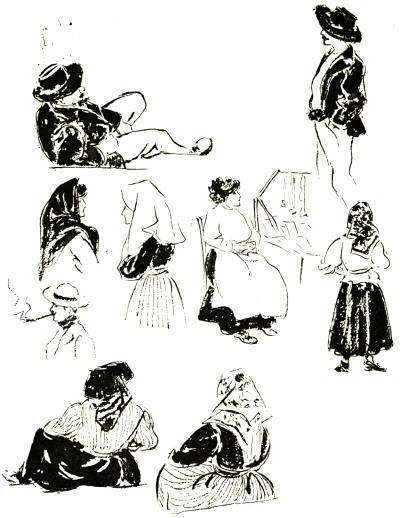
Loreto is the Lourdes of Italy. The prevalence
of cholera in Apulia, in the autumn of 1910, caused
the Government to issue an edict forbidding the annual
fair of the Feast of the Nativity of the Virgin, which
brings more than a quarter of a million peasants from
all parts of Italy; but although the festa lost much
in picturesqueness by the absence of the southern
Italians, we drove up the hillside, in the company of a
host of pilgrims.
As we went all eyes were turned towards Loreto,
the little village, white as any city of the Orient,
which enshrines one of the greatest treasures of the
Roman Catholic Church, the humble cottage, built
of rough stones, which half Christendom believes
to have been the home of the Holy Family on
their return from Egypt, as well as the scene of the
Annunciation and the Incarnation. For in its midst
loomed the towers and bastions of the Chiesa della
Santa Casa, with its many apses spreading out on the
crest of the hill like the petals of a flower, golden-hued,
and crowned by a dome bearing aloft a gilded image
of the Virgin. We approached it through an avenue
of tinselled merry-go-rounds, and rifle ranges, and red
and white striped theatre-booths,—the mushroom-growths
of all European festas; but it was not until
we passed through the city gates that the real business[208]
of the day began. Here it was impossible to hurry.
The stream of pilgrims in that narrow and crowded
thoroughfare, stopping at every stall to chaffer and bid,
flowed but slowly towards the shrine, although the
great bell was booming from the campanile like the
voice of a temple, calling its devotees to prayer.
It was a scene of indescribable noise and gaiety,
but from the picturesque point of view it was disappointing,
for the peasants of the March are not
beautiful like the peasants of Umbria and Tuscany,
nor do they wear the gay kerchiefs and costumes of the
southern Italians, seeming to prefer white silk and wool
kerchiefs to the brilliant flowered tovagliette of the
women of the Campagna.
When at last we did emerge from the narrow,
crowded thoroughfare we found ourselves in a wide
piazza surrounded by elegant Renaissance arcades, and
saw before us the Chiesa della Santa Casa, towering
above a broad flight of steps. And straightway,
although the gay stalls with their fluttering kerchiefs
and strings of rosaries and images flowed down one side
of the square, we forgot the noise and bustle of the
street; heard only the deep-toned bell calling the
world to worship on that sunny hill-top overlooking the
Adriatic; saw only the pilgrims streaming up the stairs
on either side of the statue of Pope Sixtus v., and into
those exquisite bronze doors which are among the chief
glories of Loreto's treasury of art.
[209]
For here in Loreto the legend of the Holy House
is told with the simple faith of the age of Rudolph of
Hapsburg, the founder of the Austrian dynasty, and St.
Nicholas of Tolentino, in whose life-time it took place.
And whether the stranger comes to Loreto as a pilgrim
or a sight-seer it is impossible for him not to be stirred
by the simple piety and devotion of the multitudes
which throng this shrine. When I remember that for
five centuries the world has journeyed here to pray
and worship, to me it makes no difference that the
dimensions of the foundations of the Holy House in
Nazareth do not tally with the dimensions of the Santa
Casa of Loreto, or that none of the pilgrims to Nazareth
between the fourth and the sixteenth centuries made
mention of the house of Joseph in Palestine. It stands
for so much in the history of the world. For we have
all waited on the shore of the Sea of Doubt, like
St. Nicholas upon the shore of the Adriatic, and
searched the horizon for the treasure which we dreamt
lay beyond it. And though many of us have had some
message, faint and fluttering maybe, which has nevertheless
grown clearer as we strained towards it, for
how few of us has the miracle come safely through
the breakers and blessed our eyes as the Santa
Casa of Loreto blessed the eyes of the shepherds of
Recanati!
In comparison with its splendid fortified apses, whose
fifteenth-century fighting galleries are still intact, and[210]
pierced by holes for dropping hot lead on to the heads
of besiegers, the façade which Sixtus v. built for the
Chiesa della Santa Casa is unimposing. But it is graced
by three bronze doors worthy of comparison with
Ghiberti's wonderful gates in the baptistery at Florence.
They are the work of the sons of Girolamo
Lombardo and his pupils; and the panels of the
central door, with their story of the Creation, the
Expulsion from the Garden of Eden and the murder
of Abel, are masterpieces of the Renaissance, so godlike
are the figures of Adam, as he tills the soil, and of
the slayer Cain, fleeing from wrath to come. They are
surrounded by a daring and frankly pagan arabesque of
fauns and mermen and foliage. Nor are the side doors
less beautiful, with their lives of Abraham and Moses,
and their smiling cherubs holding up medallions and
lockets in which are figures of Virgins and Saints, and
miniature scenes in delicate low relief.
While we stayed to look at those exquisite panels of
the oldest story in the world, there came two shaggy-haired
men, with the dust of long journeys on their hob-nailed
boots, who doffed their hats and knelt there
on the pavement in the midst of the shifting crowd of
worshippers, praying before their Lord with unconscious
grace, as Abel prayed before the God of Israel,
ere they ventured to approach the holy shrine.
And here we paused, for this was what we had
come out to see. We had no meed of worship to[211]
offer to Madonna through that strange Byzantine doll,
loaded with jewels like an Indian totem, who smiles so
enigmatically, over her glittering lamps and tapers, at the
kneeling people. To us the story of the Santa Casa was
a legend only beautiful in the faith which can believe it.
Nor were we drawn hither to see the treasures worth
the ransoms of many kings which Popes and Emperors
have lavished on the shrine, or the exquisite frescoes of
Melozzo da Forli and Luca Signorelli in its sacristies.
For greater than any of these are the humble and lowly
of heart who worship in the magnificent temples which
princes and prelates have built to their gods. They are
indeed the salt of the earth, the shining light which
cannot be hid. They are like the hills and the valleys
in which they live; in their eyes are the shadows born
of century-long communion with Nature; being meek
they have inherited the earth; being pure in heart they
have seen God.
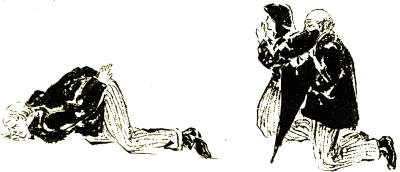
[212]
Come in with me then to this great rich church
and see these little ones at prayer. See how they press
into the Santa Casa. Are not their simple faith, their
gentle humility, the tears and sighs of the women, the
bent heads of the men, more beautiful than the rich
marble screen on which Sansovino and five other great
sculptors of the fifteenth century lavished their art to
make a worthy casket for the House of the Virgin?
Its stair is worn into two deep furrows by pilgrims
journeying round it on their knees. Do you not think
that the great Mother of Pity loves this rough sculpture
best? Look how they pray before the hearth, how
eagerly they place their rosaries and medals in the little
bowl which legend relates was found in the Holy
House after its miraculous journey. They do not doubt
that the hands of Madonna Mary, nay, of Christ Himself,
have touched it.
We, too, were borne by the crowd into the Santa
Casa. It was quite full of kneeling people. The altar
was ablaze with candles, and lamps were pendant all
round the walls, so that we saw them as it were through
a mist of light. Here we could discern the window,
blocked up now, through which the Angel Gabriel
entered the cottage; there the little cupboard in
which were found the humble bowls, such as poor
people use to-day for cooking. And on the altar, clad
in the rich robe presented by Maria Teresa and valued
at 4,000,000 lire, stood the little cedar-wood statue of[213]
the Madonna and Child, which the Virgin is stated to
have claimed as her authentic portrait.
Mass was being celebrated at the High Altar when
we came out again, and the body of the church presented
a charming patriarchal effect. All the men were
clustered in the aisles, and the women gathered together
in the nave, looking like a garden of flowers,
with row after row of serious girlish faces under fair
white kerchiefs, broken here by a group of black mantillas,
there by the stray bright tovagliette of a southern
contadina. The gilt and frescoed apses were misty with
incense and sunlight; and here pilgrims, fresh from their
visit to the Santa Casa, were kneeling with rapt faces
before the altars. And in the midst of all this piety and
worship, with the organ pealing music down the aisles,
we found old crones asleep, or taking snuff as they rested
in confessional boxes, and children playing hide-and-seek
round them. All very reverently, however, not
forgetting that they were in the house of their Father;
nor were the dogs which had strayed in with the crowd
turned away.
Later, when most of the pilgrims were enjoying a
hard-earned siesta, or marketing in Loreto's single
street, we sat in the cool nave and watched the people
trooping in like sheep coming confidently into the fold.
The great bell tolled overhead and in they streamed, all
with their newly-bought treasures—now an umbrella,
bright emerald or scarlet, wrapped clumsily in paper,[214]
now with some baking-pans, now with a household lamp.
And all of them with some gewgaw to be blessed in the
Virgin's bowl.
The basins of holy water were so lofty that many
of the women could not reach them, and some passing
pilgrim would dip his fingers in and touch their hands.
Now it was a group of barefooted girls with kerchiefed
heads and sunburned faces who went up to the shrine;
now an old old man who dipped his hand into the holy
water and then knelt down in the middle of the nave,
passing wet fingers across his tired eyes, and praying
there awhile before he kissed the floor, and wearily
stumbled out of those glorious bronze doors into the
sunshine again. Here a whole family knelt together
round their rugged-faced father, with their bright kerchiefs
looking like a homely flower-garden; there a man
going out with his two little sons dipped his fingers in
the high bowl, and moistened the hands of first one
awe-struck child and then the other.
So it went on all day. Nor does it matter that
the Casa is of mediaeval construction; that it is not
built of the grey limestone with which all the houses
of Nazareth are built, and that it does not fit its ascribed
foundations in Palestine. For the gods have ever been
secret. Did Ceres weep at Enna? Did the rosy feet
of Aphrodite ever press the sands of Paphos? Is it
the blood of Adonis which makes the stream of Carmel
red?
[215]
And listen to the words of the prophet: 'The
workman melteth a graven image, and the goldsmith
spreadeth it over with gold, and casteth silver chains.
He that is so impoverished that he hath no oblation
chooseth a tree that will not rot; he seeketh unto him
a cunning workman to prepare a graven image that shall
not be moved. Have ye not known? Have ye not
heard? Hath it not been told you from the beginning?
Have ye not understood from the foundations of the
earth? It is He that sitteth upon the circle of the earth,
and the inhabitants thereof are as grasshoppers; that
stretcheth out the heavens as a curtain, and spreadeth
them out as a tent to dwell in' (Isaiah xl. 19).
[216]
RAVENNA
Who could dream of anything but love as they drew
near to Rimini and Ravenna, those cities of romance
whose names are as knit with lovers' tales as Rome's
with Caesar and Macedon's with Alexander! They
are foremost in the troubadour land of Italy, their scroll
of history is gracious with the names of knights and
ladies. With the word Rimini upon the signboard of
the train our thoughts leap back at once across the gulf
of years, and in imagination we hear again the oft-repeated
plaint of pale Francesca—
'No greater grief than to remember days
Of joy, when mis'ry is at hand!
One day
For our delight we read of Lancelot,
How him love thrall'd. Alone we were, and no
Suspicion near us. Ofttimes by that reading
Our eyes were drawn together, and the hue
Fled from our alter'd cheek. But at one point
Alone we fell. When of that smile we read,
The wished smile, so rapturously kiss'd
By one so deep in love; then he, who ne'er
From me shall separate, at once my lips
All trembling kiss'd. The book and writer both
Were love's purveyors. In its leaves that day
We read no more.'[20]
[217]
Nor is it only of Francesca whose griefs were sung
by Dante that we think, but of those greater lovers of
the same ill-fated house—Sigismondo and the divine
Isotta; of Galla Placidia, the Cleopatra of Imperial
Rome; of the poor child Honoria, who chose the terrible
Attila to be her knight-errant; and of the Gothic
Queens, Amalasuntha and Matasuntha, whose lives
seemed as foredoomed to tragedy as those of the
beautiful women of the Polentani. But the marshes
of Ravenna, at once her stronghold and her weakness,
seemed to have bred distemper; for almost all the stories
end in sadness whether they tell of Francesca and her
lovely sister Samaritana, or of the Beatrice Dante loved
and lost and found again in visions, walking in the vast
Pineta; or of Boccaccio's Nastagio degli Onesti; or of
the weeping bride of Gaston de Foix, the flower of
French chivalry, who was mown down by the scythe
of war outside Ravenna's gates.
There is a peculiar and vagrant charm about the
Adriatic, different from the exquisite beauty of the Ligurian
Riviera with its rounded bays and vine-clad hills,
but worthy of a sea which washes the golden shore of
Greece as well as the most romantic coast in Italy.
The Appennines tower upon the horizon, and many
mountain rivers rush from them to the ocean, and flood
the sapphire water at their mouths with opaque gold
churned from their sandy beds. Flowers grow upon the
shore only separated from the sea by a strip of shingle,—tamarisks[218]
and sea-holly, mallows and yellow mulleins.
And all the way from Ancona to Ravenna, save where
the line runs through the famous pine-woods, are
ancient cities strung like jewels along the shore of the
Adriatic, with their river-harbours full of the gold and
copper-coloured sails of fishing-boats—Senigallia, which
Pompey devastated; Fano, Fortune's fane, linked to
Rome by the Flaminian Way; Pesaro, a city of the
Sikels; Gradara up on the mountains with a perfect
mediaeval castle and a flight of towered walls; and
Rimini, Caesar's first footing after he had crossed the
Rubicon. They are all more or less blatant seaside
resorts, especially Rimini, whose plage rivals that of
Livorno.
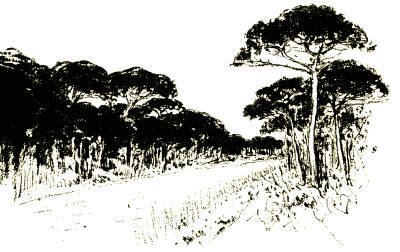
[219]
Of them all Ravenna only is unspoiled. She is a
jewelled city where East and West, Christian and
Pagan, Rome and Byzantium met and commingled and
immortalised themselves in the service of Architecture.
Ravenna is a place in which one is instinctively
happy. Ravenna Felix is the name she bears upon her
ancient coins. And even to-day, notwithstanding her
years of poverty, she has an air of subdued gaiety as
though in spite of herself she must be happy. She is
like a gentle convalescent who goes softly in recovering
her strength. For, after many centuries of waiting,
Ravenna, the Imperial City who proudly offered shelter
both to Roman emperors and Gothic kings, and who
was the handmaiden of Byzantium long after the
Western Empire had ceased to exist, is beginning to
live again. The spectre of fever has fled from her
marshes; the people no longer wander palely through
her streets; she is in fact the centre of a prosperous
agricultural district; under the hand of science even
Classis, long regarded as a hot-bed of malaria, is being
revivified.
Just as her history is of special interest to lovers of
romance, because the fate of the city was so often held
in balance by the lovely women who were queens within
her walls, so are her monuments of special interest
alike to the historian and the student of art, as representing
a period little touched upon elsewhere in Italy.
For almost all the ancient buildings still standing in[220]
Ravenna were raised in the centuries which saw the Fall
of Rome, the Gothic Occupation of Italy, the Invasion
of the Lombards, and the final administration of the
Empire through the Exarchs from the court of
Byzantium in Constantinople. Through all these
vicissitudes Ravenna was the seat of government, from
the day when Honorius fled before the barbarians to
the marsh-girt city, until the coming of Pepin of France,
who invested the Papacy with Temporal Power.
Of the triple city of the Augustan era nothing
remains. Where Aeolus once filled the sails of
galleys in the vast harbour that Octavian built three
miles from old Ravenna, he strays to-day like a vagrant
musician singing strange songs of the sea among the
stems of the Pineta. Classis, the ancient port, has
vanished underground, and flowers bloom above the
stones of Caesarea, the suburb which linked the seaport
of Augustus to Ravenna.
It is not before the period when the weakling
Honorius transferred his court from Rome to Ravenna
that we find any traces of the city's glorious past. But
here are four treasures which by themselves are worthy
of a visit to Ravenna—the little church of Sant'Agata,
rebuilt in the fifteenth century, but preserving some of
its outer wall intact, and containing twenty-four columns
of precious marbles; the chapel of San Piero Crisologo
in the Episcopal palace; the Baptistery, once the
thermal chamber of some Roman bath, still lined
with rare mosaics of the fifth century; and the tomb
of Galla Placidia, the regent of the Western Empire.
[221]
[222]
The story of Galla Placidia is one long romance.
We cannot doubt that she was beautiful since she
was desired of so many men. Daughter of Theodosius
and sister of Honorius she fell into the hands of
Alaric the Goth in the Sack of Rome when she was
but twenty, and was taken prisoner by him to Calabria.
There she won the love of Athaulf, the brother-in-law
of the Gothic king; and, after many delays caused by
the hesitancy of Honorius, who would not give his
assent to the marriage, she became his wife at the price
of peace for Rome. Alaric was dead, and Athaulf was
King of the Goths when the nuptials were celebrated
with great splendour in Narbonne; but before many
months had elapsed Fate once more changed the
course of Placidia's life. Athaulf was assassinated;
their infant child died; and the daughter of Roman
Emperors found herself at the mercy of a barbarian
who, to mark his ill-gained triumph, made her walk in
chains through the streets of Barcelona. Within a few
days, however, Singarich the murderer was slain, and
the fallen Empress was restored to the Roman army,
which came to meet her at the foot of the Pyrenees
under the command of the greatest general of the time,
Constantius the Illyrian. Constantius loved Placidia.
Often before her capture by the Visigoths he had
sought to win her hand and failed; but now, aided by[223]
the prayers of the people, who regarded him as a
worthy successor of Honorius, he gained his desire,
much against the will, it is said, of the Emperor's
beautiful sister.
Even so the Fates were not satisfied with their web.
Constantius died and Honorius, 'credited but a short
time before by evil report with criminal desires towards
his sister, now turned from love to hatred, and banished
the unhappy woman with her children to Byzantium.'[21]
In the same year Honorius himself died; and Placidia,
supported by the armies of her nephew Theodosius II.,
the Eastern Emperor, came back to Ravenna where
she reigned with her son for twenty-five years, first as
his regent, and later as his adviser.
Her tomb, in the shadow of the great church of
San Vitale, built many years later when the Western
Empire had been absorbed by the emperors of the
East, is the most perfect example of Roman-Byzantine
art in Italy. It is like a rich casket of Oriental
splendour encrusted with gems. It has walls of yellow
marble, and alabaster windows, through which a golden
light is shed upon the gleaming mosaics which cover
every inch of vault and arch. And here, under a
sapphire sky sown with gold stars and illumined by
the gilded beasts of the evangelists, with white-robed
saints walking under date-palms among the doves and
lambs of Christian symbolism, are the three great[224]
sarcophagi which enclosed the bones of Galla Placidia
and of her husband Constantius, and Valentinian her
son.[22]
Thus did the last great Empress of the Western
Empire order her resting-place, and when we realise
that this jewelled casket has lain open to a rapacious
world for fifteen centuries, it is little short of miraculous
that it has come down to us so perfect. All praise to
Theodoric, the King of the Ostrogoths, the lover of
ancient arts, who presented in his person the great
anomaly of a Gothic king who was the protector of
temples as well as the founder of some of the most
lovely churches standing in the city to-day.
The name of Theodoric the Ostrogoth is great in
Ravenna. Notwithstanding the fact that many of his
buildings, notably his palace, have almost disappeared at
the hands of the Orthodox Church, which regarded him
as a heretic because he professed the Arian Creed,
Ravenna still possesses four of his monuments—San
Teodoro, now called Santo Spirito; the Arian baptistery,
its cupola still covered with sixth-century mosaics; his
palace, his sepulchre, and Sant'Apollinare Nuovo.
The stately tomb of Theodoric, round which mediaeval
imagination wove legends, as the flowers and the
fruits of the earth weave a web of beauty to-day, rises at
the end of a wide turf avenue enclosed in hedges of acacia.
It stands in a rose-garden with a background of firs[225]
and flowering yews; round its sunken pronaos are
fruit-trees laden with pomegranates and purple figs;
and wistaria and yellow roses have hidden the steps
which lead to its upper chamber. Externally, the
tomb, which the unfortunate Amalasuntha built for
her father, is as unspoiled as the mausoleum of Galla
Placidia; its solid masonry of grey limestone has defied
the years; and the gaping crevice in its marvellous dome,
composed of one huge block of Istrian marble, only
serves to give point to mediaeval legends. But inside
it has been devastated by his enemies and robbed even
of his sarcophagus. Mr. Symonds says, 'in spite of
many trials, it seems that human art is unable to
pump out the pond and clear the frogs and efts from
the chamber where the great Goth was laid by
Amalasuntha.' But on the damp September day when
we visited the mausoleum its stones were dry, although
the little spotted frogs, which fled below the rose-trees
at our approach, were shrilling a chorus of mockery at
the vanity of tombs.
Sant'Apollinare Nuovo, which has changed its
name twice since Theodoric dedicated it to the Saviour,
is one of the most beautiful churches in Christendom.
Like San Teodoro, its exterior is of the Renaissance.
Beside its portico stands one of Ravenna's curious
round bell-towers, probably built in the ninth century;
but inside we found the riches of Rome and Byzantium
gathered together to make a glorious whole. For[226]
along the architrave of the nave, supported on antique
marble columns, we saw a long procession of Virgins
and Martyrs leading from the western doors to the arch
of the transept, where the Madonna and the Saviour
were enthroned. Above them, and between the
windows of the clerestory, were ranged the figures
of Saints and Prophets. And above them again were
scenes resembling the early mosaics in Santa Maria
Maggiore in Rome, depicting incidents from the life
of Christ. From the technical point of view these
little panels indicate the highest art to be found in
Sant'Apollinare Nuovo. They are the work of Roman
mosaicists employed by Theodoric, whereas the lowest
zones are by Byzantine artists; they are full of vigour
and freedom; while the others, in spite of their
magnificence, have the terrible Byzantine stiffness
which held Italian art in thrall until the coming
of Cimabue and the Pisani.
But how rich, how decorative those jewelled
garments of the honourable women, the snowy robes
of the Martyrs! Just so the artist of Byzantium may
have pictured them against a golden dawn, issuing from
the proud city of Classis on the one hand, and from the
Palace of Theodoric on the other, to lay their crowns
before the Thrones of Heaven. For those Virgins are
robed as daughters of the King, and they link the
Mother of God in a gold and jewelled chain to the
ancient town of Classis, without whose gates the galleys[227]
ride, with the wind in their billowing sails. Flowers
spangle the grass at their feet, and behind them the red
dates hang heavy on the palms; while in the heavenly
Court the Three Kings offer their gifts, how eagerly!
to the Virgin seated among the angels with the Baby
Christ upon her knees.
The beauties of San Vitale and Sant'Apollinare
in Classis are too well known to need description,
even if it were possible to do any sort of homage
to their magnificence in so general a chapter. They
were both built by Julian the Treasurer during
the reign of Justinian, and they represent the third
period of Ravenna's greatness before the temporal
power of Rome was eclipsed by that of the Eastern
Empire. In San Vitale especially, the glory of
Byzantium is reflected as in a mirror. Nowhere else
in Italy is there such a perfect illustration of the
Courts of the Lord towards the middle of the sixth
century. In this great church, whose domed central
space and retreating galleries, sustained by the gracious
horse-shoe arches of the East, gave the mosque of the
coming Arab conquerors its genesis, we have walls
enclosed in precious marbles, and pierced and fretted
capitals wrought by Oriental craftsmen. And here,
below the rich encrusted vault where Christ is enthroned
upon the blue orb of the heavens, in such a
paradise as Dante may have dreamt of, where white-robed
Saints cull flowers as they pass, we have thejewelled splendour of the Court of Byzantium, with
the Emperor Justinian among his priests and soldiers,
and Theodora with the ladies of her court.
[228]
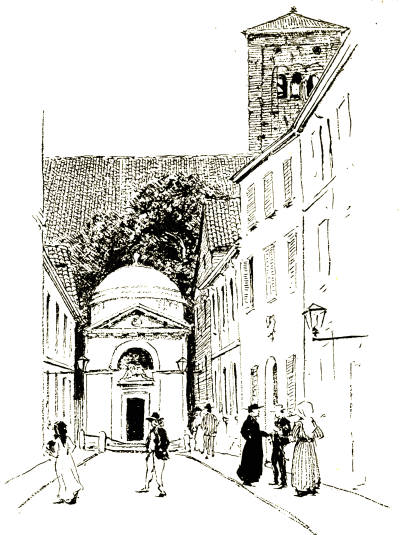
RAVENNA: THE TOMB OF DANTE.
[229]
Side by side in the heart of Ravenna are the tomb
in which the dead Dante was laid, when the secret of
his sepulture had been made known to the Ravennesi,
and the old palace of the Polentani in which Francesca
of Rimini was born. Near by is the house of that
other poet-wanderer, Byron, whose windows overlook
the gallery from which it may be that Francesca,
seeing the gracious form of Paolo Malatesta coming
to woo her for his hunch-back brother, felt the first
pangs of love, as well as the sacred tomb whence
'he had so oft, as many a verse declares, drawn
inspiration.'
Notwithstanding its withered wreaths, its stuccoed
dome, its air of cheap and tawdry Campo Santo sentiment,
the people of Ravenna really do come to pay tribute
to the sepulchre of the great bard of the Risorgimento.
But it is difficult to find anything of the real Dante
here. For though Ravenna was his 'ultimo Rifugio,' as
it has been the last refuge of many other great ones;
and though he finished his Divine Comedy here in the
house of Guido Novello Polenta his patron; and
dreamed, poor pilgrim, when he wandered through
the exquisite beauty of the pine-woods of Classis that
he had found paradise, I think his spirit fled at its[230]
release to his beloved Florence, 'la bellissima e famosissima
figlia di Roma.'
And yet there was a special fitness in our pilgrimage
to the Pineta on September 14th, which is the anniversary
of his death; for if the spirit of this wayfarer
lingered anywhere upon the eastern shores of Italy it
must have flown to the 'celestial forest' in which, in
visions, he beheld his Beatrice walk amid the white-robed
companies of heaven.
Autumn had laid her hand upon the poet's paradise.
The earth was carpeted with pine-needles, soft and
rusty, and pied with flowers,—scabious and yellow
thistles, veronica and cinquefoil, and Michaelmas
daisies. Great bunches of scarlet fruits encarnadined
the undergrowth. The bramble leaves were rose and
russet; the Pilgrim-trees were hung with crimson tassels;
the yews were thick with purple berries. Evening
primroses grew so tall that they were reflected in the
water among the blossoming reeds. And everywhere
the ethereal webs of cow-parsley, those loveliest flowers
of the field, were spun on slender stems as delicately as
frost upon a spider's web. Moon-flowers I call them,
dust o' the moon, and when they fade they fold their
treasures up into a knitted purse of green and gold,
swaying heavy-headed in every hedge.
The air was warm and fragrant, like the scented
breath of some one beautiful. Beneath our feet the
timid lizard darted to the shadows; the birds made[231]
music in the pines, and all around we heard the shrill
chorus of frogs and the rapturous song of the cicala.
Driftwood and fallen leaves floated slowly to the sea,
on just such a shadowed stream as that by which Dante
beheld Matilda:—
'A lady all alone, who, singing, went,
And culling flower from flower, wherewith her way
Was all o'er painted.'[23]
And all was still, save where a snake made a ripple
that you could hear as it swam neck-high through the
water.
A paradise indeed!
On our way back across the rice-fields and flowery
marshes, which cover the fallen city of Caesarea, we
passed the mouldering column marking the spot where
Gaston de Foix fell in the battle of Ravenna. It
stands on a causeway above a sluggish river, in an
esedra of cypresses which whisper melancholy to the
wind. All the world knows his lovely broken tomb,
whose effigy is one of the treasures of the Milan
Museum, but in Ravenna itself there is another tomb
of just such another boy—Guidarello Guidarelli. A
warrior of Ravenna it is named, but there is no stone
to mark the place where fell this Knight of the beautiful
face, 'dear at once to Mars and to Minerva,' who
followed the fortunes of Cesare Borgia, and met his
death by treachery in Imola.
[232]
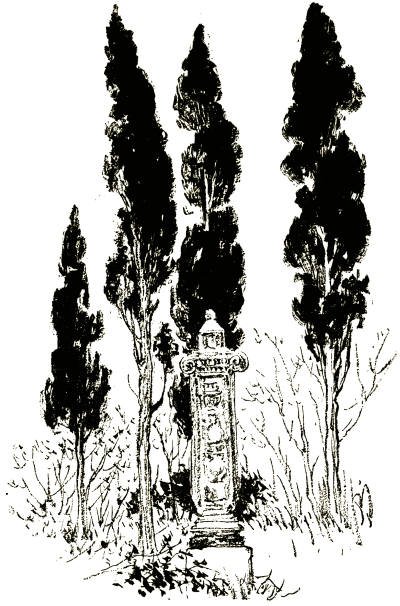
RAVENNA: THE COLUMN OF GASTON DE FOIX.
[233]
Signor Corrado Ricci, himself a son of Ravenna,
speaks truly when he says 'Ravenna is a city historically
great and fatal, nay, the very charnel-house of history,
whither destiny sends great achievements and lofty
personages to decay and oblivion. Here the Caesars,
the Roman Empire, Roman Captains, Barbarian Kings,
the reign of the Herulians, of the Goths, of the
Exarchs, all pass away. And when its importance
seems to wane, lo! Dante Aligheri is here to complete
the greatest of his poems, and to die.
'Cardinal Bessarion, the perfect flower of Humanist
culture, is brought to die in Ravenna. Francesco
Maria della Rovere slays in her streets the infamous
Cardinal of Pavia, Francesco Alidosio. Hither come
the armies of Julius II., of Ferdinand of Spain, of Louis
of France, of Alfonso d'Este; and Gaston de Foix
receives his death-wound in the great battle which
reimposes a term of foreign rule. Nor can the epic
of the Risorgimento develop itself without new and
memorable episodes being reserved for Ravenna. Here
Garibaldi's astonishing retreat from Rome terminates;
amid endless dangers the hero's life is preserved, but
Anita, worn out by grief and hardships, died in his
arms.'
[234]
THE REPUBLIC OF SAN MARINO
To the classical scholar, San Marino must always
be the real Nephelococcygia—the cloud-cuckoo-town,
which the Athenian satirised as built by the birds up
in the clouds to cut off the Gods from all connection
with mankind. That is how the Sammarinesi live,
cut off from the earth in which they are the smallest
and most trivial nation. The proudest too, for though
the area of their Republic is only twenty-four square
miles, and they have their seat of government on the
crest of a perpendicular rock, with a sheer drop of nearly
a thousand feet, they have preserved unbroken their
tradition of independence through fourteen centuries.
Not, it appears, from any particular valour on the part
of the Sammarinesi, although they must often have
stood ready to the call of arms, with the greedy
Malatesta so near at hand in Rimini, but because they
have been greatly favoured by the enemies of Republics.
The Papacy, which had already brought almost all
the other petty States of Italy to their knees by force
or treachery, granted recognition to the smallest of
them in 1631. Napoleon listened to the pleading[235]
of Antonio Onofri, called by the grateful citizens
'the father of his country,' and repealed his decree
for the suppression of the Republic. And the Kings
of Italy, perhaps as a reward for the courageous shelter
it offered to Garibaldi and his broken army, not only
recognise its independence, but have made it a present
of modern cannon, with which to defend itself.
San Marino was a true Nephelococcygia, on the
afternoon we drove to it from Rimini. A heavy bank
of cloud veiled the ragged crest of Monte Titano, that
giant outpost of the Eastern Appennines, towering
nearly 3000 feet above sea level, to which Marinus,
the saintly stonemason of Dalmatia, fled from the
persecutions of Diocletian. It was a day of storms.
The sullen indigo-coloured mountains were lost in
drifting clouds. Sometimes when the grey pall was
rent by the wind, we glimpsed the fantastic towers
of San Marino, high in the heavens on their mighty
cliff; but while we pointed to them they were gone,
like the city of a magician conjured out of mists.
From Serravalle, which is the first village of the
Republic on the road from Rimini, our way led uphill,
through the vineyards and fields of corn which are
the chief source of income to the diminutive state.
Down in the plain of Rimini it had been warm and
sultry, but as the bearded clouds swept down to meet
us, the air grew cold and damp. The Philosopher had
a touch of fever and was unspeakably miserable, but[236]
nothing could damp the ardour of the Poet, who sat
upon the coach-box and strained his eyes towards
the fairy city overhead, whose turrets every now and
then loomed grey among the clouds. On the long
steep climb to the Borgo, we overtook the public
diligence, which had dashed past us an hour before,
rattling recklessly down one hill to gain sufficient
impetus to carry it up the next. It was toiling along
slowly enough, behind two rolling white oxen, while
its steaming horses, ridden by grooms, brought up the
rear.
And now the clouds rolled down the hillside and
enveloped us, blotting out the distant view of Rimini
and its sea-board, and crowding round us like curious
ghosts. We could feel the chill breath of the mists
upon our faces, and soon even the diligence with its
laughing, chattering crowd of passengers was shut
out of sight, and we were alone upon the grey
mountain side. Just then the bells of the Borgo
began to ring overhead, and their music floated down
to us out of the thick fog, indescribably poetic, like
the lights of an unknown harbour shining over the
water. So we crept up, winding round the shoulder
of the mountain towards the unseen town, which for
all we knew might be one of the magic cities of our
childhood. Sometimes the cliff rose sheer above us,
and at others, the road faced a wall of cloud; and
sometimes when, as it were, the breeze made windows
in the mist, we saw the ragged, sullen crests of the
Appennines lifting their heads above the drifting
clouds. Suddenly, we found ourselves in a street
with low stone houses, and in another minute we were
in the Borgo.
303
[237]
It was all commonplace enough, not at all the
city beautiful we had imagined,—a mountain village
built of grey stone, with a few stuccoed houses, but
it was very friendly and welcome after the unfamiliar
mists. We did not stay. We still had before us the
steep climb up to the Acropolis, 700 feet above
the Borgo, and as we zig-zagged up the one road
that for strategetical purposes San Marino possesses,
we were overtaken by the rain, a cloud-burst,
which, umbrellas notwithstanding, drenched us to the
skin.
It was as though a sluice had opened in the heavens.
But our vetturino, who had neither overcoat nor umbrella,
was unmoved. He deposited us, bag and baggage,
at the city gate, telling us with many shrugs, non
posso andare de più. It rained in torrents. We did
not know which way to turn. The steep, paved street
in which we found ourselves was a miniature cascade
whose stream ran over the tops of our shoes, and
flowed in eddies round our luggage. Our condition
was pitiable, until some kindly Sammarinesi helped
us and our baggage up that waterfall and into the
hospitable Albergo Titano.
[238]
Only then did we realise our good fortune in arriving
before the public diligence, which was still lost in
the mists below. For the Albergo Titano, an excellent
and simple inn, where mine host in spite of his smart
English tweeds is not too proud to help in the kitchen
and hand the dishes at dinner, has limited accommodation.
When we passed the belated travellers on
the stairs after we had changed our wet clothes, we
heard them expostulating indignantly because there
was only one room to share between the five of them!
We found San Marino a City of Grey Cloud as
romantic as the City of White Cloud into which the
soul of the butterfly vanished in the Japanese legend of
the Holy Mountain. It was full of shadows which
materialised out of the mists, grew solid as we passed,
then melted into wraiths again and vanished. It was
very quiet, a world of ghosts, with great grey clouds
ramping through everything. We could not see more
than twenty yards ahead of us, and the end of each
street seemed to float in space. No sooner had we won
things from the mists than they were devoured again.
And so we came to the Piazza del Pianello with
its statue of Liberty and its battlemented palace,
which loomed up in the clouds like a ghost of the
Gothic Palazzo dei Consoli at Gubbio. From the
parapet where Herr Baedeker had told us to look for
the view, we faced a sheet of mist on which some
fantastic chimney-pots were faintly sketched.
[239]
Suddenly, by a seeming miracle, Monte Titano
lifted its head out of the clouds, and San Marino lay
clear before us, a grey, tidy, self-respecting hamlet
overlooking some of the grandest mountain scenery to
be found anywhere in Italy. Down in the valley the
Marecchia wound, white as a river of bleached bones,
towards the Appennines, whose heads were wreathed
in sullen clouds. In the west the sun struggled to
look once more upon the earth before it plunged below
the mountains, and the white storm-wrack behind
the ragged scarp of San Leo, where Cagliostro died,
was fired by the fan-shaped rays. If we had felt like
Dante and his guide climbing the hill of Purgatory as
we toiled up the side of Monte Titano in the blear-grey
mists, we looked for a moment into his Inferno when
the curtaining clouds were rent apart.
'... For certain on the brink
I found me of the lamentable vale,
The dread abyss, that joins a thund'rous sound
Of plaints innumerable. Dark and deep,
And thick with clouds o'erspread ...'[24]
Across the valley the fortress of San Leo stood out in
black relief against the smoking clouds, until it seemed
as though eternal fires were burning behind the eagle's
nest in which the great necromancer of the seventeenth
century was confined. And beyond it rose the crested
waves of the Appennines with the torn garments of[240]
the storm shredded upon their cruel rocks. Here and
there a stray beam slanting athwart their slopes illumined
the towers of some little far-off town. For a
few minutes the valleys were bathed in golden light,
then the sun went down, and the world grew indigo
with night and storms.
San Marino itself has not much to offer to the
stranger within its gates. Its houses are commonplace:
its cathedral and its Gothic Palazzo del Governo are
modern, and its palaces contain few traces of antiquity.
On the other hand the manners and customs of the
Republic have a refreshing quaintness not to be found
elsewhere. For instance in San Marino you do not
buy and sell with the coinage of the state; that is
minted entirely for collectors; and in this small community,
where every one knows the business of his
neighbour better than he knows his own, the pretty
telegraph girl goes about the town like the buttons
in a hotel, asking strangers if the wire which has just
been brought up from the Borgo is for them, when she
does not know the name of the recipient. Unlike the
cities of Italy, San Marino is early to bed: at half-past
eight the streets are silent and deserted. But she is an
early riser. The only public conveyance to Rimini,
which also purposes to serve the Ancona-Rome express,
is timed to depart from the city gates at 4 a.m.
The gaoler and the police are foreigners, i.e. Italians,
because, as the prison-keeper remarked, 'otherwise no[241]
one would ever be arrested, because the Sammarinesi
would all be relations of the police.' But the army,
forty strong, is recruited from the Sammarinesi themselves.
Nor should the traveller be surprised if perchance
he finds lop-eared rabbits making themselves at
home in his bedroom, as we did in the Albergo Titano,
although this peculiarity is not confined to San Marino,
it being on record in Volterra that when an artist
begged the hotelkeeper to sweep below his bed, she
answered that it could not be done, much as she wished
to oblige the signore, because her hens were sitting!
But it is San Marino's incomparable views, over the
wide valley of the Marecchia to the Appennines on
the one hand, and over the plain of Rimini to the
Adriatic and the hills of Dalmatia on the other, which
make the long climb worth while.
Even the Philosopher, who had rheumatism added
to his other sorrows, could not help responding to the
joy of waking, and finding himself high up in the clear
blue sky overlooking a world washed clean by the
rainstorms of the night before. The great mountains
and rock-scarps which bounded the valley of the Marecchia
were flecked with shadows, and snow-white
cumuli, shining in the sunlight, were piled above the
distant peaks. We climbed up to San Marino's second
tower through a half-deserted quarry where pink
cyclamens, brambles and wild flowers had woven a
tangled web about the rocks. In the west the ragged[242]
hills rolled on like waves towards the gaunt peaks of
the Appennines, and the highest of them all had its
great solemn crest hidden in a low-hanging cloud which
held it in the old embrace of sky and earth, regarded
by the Greeks and Egyptians alike as a mythological
sacrament. To the east the rock fell sheer to the
vine-clad plain of Rimini, and far away we saw the
Adriatic in a silver haze.
How long we stayed up there among the flowers by
that ancient tower I do not know. There was a kind
of rapture in the morning. The bees were humming in
the ivy as though they thought that it was still summer.
The cicalas sang. Close at hand the Rocca, as fantastic
as the most fantastic fortress in the whole of fairy-land,
overhung its precipice. On our left rose the third
tower of the Republic flaunting its feather to the wind.
We forgot San Marino, that gay popinjay of a city,
which is so out of keeping with its landscape, absorbed
in watching the play of light and shadow down in the
wild valley of the Marecchia, where the great cloud-barques
which sailed across the wind-swept sky were
reflected on the bosom of the hills. It was a land of
great and primitive desires, with rivers rushing passionately
to the sea, and inarticulate mountains travailing
to reach heaven. Nor was the earth appeased until
the gathering storm-clouds stooped down and rested on
its hills, as the Ark of the Lord rested upon the peak
of Ararat.
[243]
We left at dawn in the postchaise of the Republic.
Night had not yet rolled her curtains from the mountains.
Eastwards the sea and sky were veiled in tremulous
mists, but when we reached the Borgo the silver
morning was lightened by a rose and saffron glory.
We found the Borgo asleep, though when we left,
after waiting half an hour for the mail and picking up
a solitary passenger, the church bells on the cliff above
were ringing and all the cocks were crowing. How
gay and fresh it was! None of the grumblers of the
world were out of bed. The cocchiere with the stemma
of the Republic in his hat cracked his long whip; the
horses made music with their bells, tossing their heads
as they smelt the breeze; even the querulous brake
made merry over its discomfort as we swung down the
hillside.
Long after daybreak the mists lay supine in the
valley and there were shadows on the mountains, as
though the languid eyes of nature were not yet opened
to the morning. But overhead the little clouds were
pink as the wings of flamingoes, and when we reached
the fields we found the vines, drunk with the magic of
the morning, dancing like Bacchanals with linked
hands across the valleys, bearing their gifts of purple
grapes. Often at the turning of the road we looked
back to San Marino, standing up like a biblical fortress
with its strong watch-towers overlooking the plain, the
home of liberty, where Garibaldi found sanctuary from[244]
his pursuers. When we reached Serravalle we saw it
through a veil of mist, thin as gossamer spun out of the
dawn. Later there were little wisps of cloud-drift
hanging on the rocks below the towers. Long ere
we drove into the gates of Rimini our Nephelococcygia
vanished like a dream into its clouds again.
[245]
URBINO
We came to Urbino for the sake of Raphael, the gentle
youth who conquered Death in dying, and to see the
palace built by the greatest hero of the Rinascimento,
Frederic of Montefeltro, Duke of Urbino. We stayed
long after we had made our pilgrimage to the brown
palace, where Giovanni Santi reared his motherless
immortal, long after we had walked through the decaying
splendours of that fairy castle which saw the star
of Frederic's dynasty go down not ninety years after
it had arisen so brightly on the slopes of Monte Ingino.
For Urbino, though she is old and faded, though the
grass grows in her streets and flowering weeds spring
from her cracked and tottering walls, is still a city
beautiful, a golden crown upon the green hillside.
We came to the foot of her vine-clad slopes after
three hours of journeying through a world of shadowy
mountains which had moonlit gossamer resting on their
peaks, and silver rivers running through their valleys.
Her towers gleamed white as polished ivory against
the vaporous sky; her many lights were like a diadem
of jewels out-brilliancing the stars. As we climbed up[246]
the hillside in the chill night air every turn of the road
revealed fresh vistas of mountain peaks rising like crested
waves out of the moonlit vapours. And when we
reached the summit of Urbino's hill, and found ourselves
below the terrific walls of Federigo's palace, we saw
above them, limned against the stars, an enchanted palace
such as Perrault might have dreamed of, with its towers
and esedras transmuted by the moonlight into jade.
Only for a moment; in the next we were rattling
over the cobbles of a wide arcaded street lit with electric
lights and hung with hundreds of little coloured globes,
red and white and green, for the festa of the Venti
Settembre. It was so gay and homely after the moonlit
silence of the mountains, and the inn we found upon
that lonely hill-top was so unexpectedly good, with
airy rooms and clean red tiles and snowy bed-linen,
that we loved Urbino from the first hour we knew
her. When we woke next morning to the music of
Sabbath bells and saw the towers of Federigo's palace
shutting out our horizon eastwards; and westwards,
across a valley, the white houses of Urbino climbing
up through their gardens towards the broken walls of
her fortezza, we knew that she was to be one of our
cities of happy memories. Nor were we disappointed.
For in Urbino with her crisp morning air tempering
the sunshine, and her vistas of wide valleys and deep-bosomed
hills rolling away towards the magnificent
crags of the Appennines, we spent some precious days
forgetful of the world, which toils and sweats in busy
marts and narrow self-made prisons, so far removed in
spirit from the hills and all the sweetness that appertains
thereto.
[247]
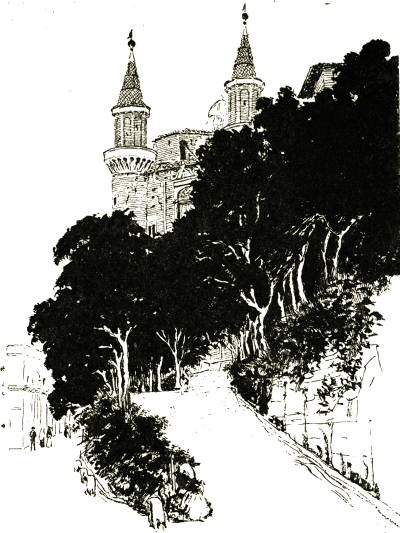
THE PALACE OF THE DUKES OF URBINO.
[248]
We had read in books that Urbino was decayed
and lifeless, the true ensample of Leopardi's tragic
words:—
'O patria mia, vedo le mura e gli archi,
E le colonne, e i simulacri, e l'erme
Torri degli avi nostri
Ma la gloria non vedo.'
So we went out expecting to find her a mere ghost,
pathetic in her faded grandeur, like beautiful San
Gimignano or the wind-swept home of Perugino. It
is true that grass was growing in the climbing street
which leads up the hill past the house of Giovanni
Santi, and we were to find out soon enough that the
great castle of Federigo, where Castiglione wrote his
Golden Book, was falling to decay like his palace at
Gubbio. But it was easy to forget these things on a
sunny morning in September, when the Piazza Otto
Settembre was filled with a crowd of stalwart men, in
their national costume of wide velvet breeches and
black wide-awake hats, and lovely dark-eyed women,
kerchief'd or wearing the fringed mantillas of Eastern
Italy,—the descendants of the brave mountaineers who
made the arms of Duke Frederic respected even by
the redoubtable Francesco Sforza.
As it was Sunday, the day on which country people[249]
come into their hill-towns all over Italy for Mass and
market, there were booths of haberdashery and flowered
kerchiefs in the piazza below the ruddy old church of
San Francesco, and pottery, not of Urbino, was spread
out in the roadway of the two streets which descend
so swiftly to the valley. The fruit and poultry market
was in the little piazza full of pollard acacias behind
the Franciscan church. The passive hens of Italy,
which spend so much of their lives being carried head-downwards
to and from market that they never give
way to hysteria like the fowls of other countries, were
ranged below the trees on one side of the square, and
golden pears and peaches were heaped with purple
grapes in the cool shade of the other. 'And may you
have salvation!' cried the merry old dame from whom
we bought more than we could carry of her luscious
wares for a few soldi.
Close by, in the very heart of the gay little city,
stands the house of Giovanni Santi, a brown fifteenth-century
palace, with broad eaves and bricked-up arches,
which bends like an aged man over the lichened pavement
of the Contrada Raffaello. A white dove was
bowing on the sill of the room in which Raphael was
born, and through the opened panes of another window
we could see the broad plastered beams of the low-ceiling
living room within.
Urbino cherishes the memory of Raphael. The
house in which he spent the spring of his short life is[250]
swept and garnished, empty except for framed engravings
of his pictures and some antique chairs and high-backed
stools old enough to have been there in his
father's day. The rooms are low, with panelled ceilings
and decent red-bricked floors. One of them has a
Madonna and Child by Giovanni Santi which is said to
be a portrait of Magia and the baby Raphael, and in
the other is a bust of Morris Moore of London, who
gave the money, needed to buy the house, to the Società
Reale Accademia Raffaello in 1872. But to me the
place was somewhat disappointing; it lacked the spirit
of the happy boy who carried with him to the courts
of Rome and Florence the breath of sunlight and fresh
mountain air. Urbino itself is just the home one would
imagine for Raphael, a city of the Renaissance, golden,
full of gardens, in which the culture and refinement
engendered by the Montefeltro Dukes still lingers.
But there is nothing of Raphael in his father's house.
Perhaps because he was there so little, for, like the
lovely curly-headed children of Urbino to-day, he probably
spent most of his time out in the streets when he
was not working with his father, now waiting to see
Duke Guidobaldo, and the knights and ladies of his
court riding up the hill from their hunting and hawking,
now playing with clay, as Gigi of the golden curls
and petulant mouth plays still, a little higher up the
Contrada Raffaello, with a world of great mountains
lying below his feet.
[251]
When we first saw him, Gigi was sitting on the
doorstep of a house close beside the palace of Timoteo
Viti, one of Raphael's greatest pupils, who for love of
his aged mother left his studio in Rome and came back
to his native town. Gigi was three years old, with a
shock of golden hair, and grey eyes, thickly-lashed and
full of dreams. He was barefoot, very dirty and happy,
modelling childish fancies out of a morsel of wet clay,
and he was so beautiful that we stopped to speak to
him. But Gigi was adamant. He frowned and went
on making unintelligible daubs with his slim brown
fingers. Later, when we passed again, his mother had
dressed him in boots and socks, his face and hands
were washed, his clay was forfeit. But when she tried
to make him beg for soldi from the forestieri, he wept
and hid his face against the wall. Poor little Gigi!
We often tried to make acquaintance with him, but
he would have none of us. Nor did he play with the
other children, who seemed to laugh at him.
But one evening when the sun was sinking low behind
the Appennines, filling the valleys with a sea of rosy
mists, from which the fantastic rocks of San Marino and
San Leo emerged far away to the right, and the great
head of Monte Catria, Dante's asylum, to the left,
Gigi crept from his hiding-place behind a bramble bush
and came to stand beside the Philosopher. It was the
20th of September, the anniversary of United Italy,
and all the other children had long ago fled laughing[252]
to the piazza where the police band was to celebrate
the festive occasion with music. But Gigi, with his
golden head thrust forward and his little arms behind
his back, stood rapt in wonder before the glory of the
sun. We watched them stand together, those two,
both worshippers in their unconscious pose, both
dreamers, till Gigi, proud and silent Gigi, who would
neither smile nor beg, stretched out his hand and took
the Philosopher's in silent sympathy. So they stood
linked together, man and child, inarticulate before the
glory of earth and sky, until night began to hang her
purple veils along the valleys and Venus was shining
softly in the West.
'Among other laudable actions Federigo erected on
the rugged heights of Urbino a residence, by many
regarded as the most beautiful in all Italy, and so
amply did he provide it with every convenience that it
appeared rather a palatial city than a palace.'
So spake that courtly gentleman Baldassare Castiglione,
friend of Raphael, honoured guest in Guidobaldo's
brilliant assembly, and ambassador from Urbino to the
English Court in 1503, when Henry VII. of England
invested the Duke with the Order of the Garter
as his father Frederic, the most distinguished soldier
of his day, had been invested by Edward IV. And
seen by moonlight, as we climbed Urbino's hill, it
was a fairy palace, with towers and loggias soaring
up to the stars above dark ilex groves, once gardens
where the lovely ladies of Elisabetta's court dallied
with love.
321
[253]
But if you wish to carry with you unimpaired this
vision of ethereal loveliness it is wiser to let your
imagination, and the flowery epithets of Castiglione,
Sanzio, Baldi and Vasari, fill up the blanks, nor
seek to find inspiration in the deserted halls of
Federigo. Come rather, across the cleft in Urbino's
hill, and climb towards the height of the Fortezza.
There you will see a panorama of great hills unfold
itself, Monte Catria and lovely Monte del Cavallo,
Monte Nerone and Carpegna, the cradle of the Montefeltrian
race. At your feet across the brown roofs of
the Città Inferiore you will see the mighty walls and
bastions of Urbino encircling Federigo's palace, with
the dome-crowned bulk of the Cathedral on the one
hand and a gracious ilex-wood upon the other; and
in the midst, enshrined as it were in the panoply of
war, a pleasure-house for princes, white and gold, with
airy loggias opening out towards the mountains, and
hanging gardens and slim tourelles, like a mediaeval
castle of the Troubadour land. For the spirit of the
Renaissance was in Urbino when Frederic and his
Dalmatian architect Laurana built this palace. Though
Italy was still racked by civil wars, though she was yet
to tremble before the foreign armies, which poured
through her defenceless passes from the day that
Charles VIII's. mad escapade showed that the way was[254]
open, to the invasion of Napoleon in 1796, Federigo
the man of war and letters chose to build a pleasure
palace for himself and his descendants upon Urbino's hill.
No one else but Federigo would have dared. The
Sforza trembled in the fortress they had wrested from
the Visconti in the heart of Milan; many years later
the Medici had need of a covered passage connecting
the Pitti with the Palazzo Vecchio, as the Popes had, to
cover their retreat from the Vatican to Sant'Angelo;
the palace of the Dukes of Ferrara was armed at every
point; even the courtly Lords of Mantua could flee at
a moment's notice from their exquisite summer-house
outside the city gates to their stronghold in the
Castello Gonzaga. But it is not likely that Federigo,
the great soldier who had led the armies of kings and
Popes to victory, and whose fame had crossed the
Alps and earned him laurels in the far-off Court of
England, depended only on the strength of his mountain
home or the loyalty of the sturdy citizens of
Urbino, when he planned the first unfortified mansion
which an Italian dared to build since the Villas of the
Roman Empire were destroyed by the barbarian. He
knew well enough that they could be trusted. Had he
not left his beloved Countess Battista to their care
while he was carrying on his wars in Tuscany and the
Campagna, although his life-long enemy, Sigismondo
Malatesta of Rimini, was harrying his borders and
seeking to inflame his people to revolt?
[255]
There was another weapon in his armoury, stronger
than precipices, more trustworthy than the shifting
humour of a crowd. He may have learnt to use it as
a boy in the brilliant Court of Mantua, where he was
taught philosophy and science and literature and
oratory by the famous Vittorino da Feltre, while he
was becoming one of the most skilful swordsmen and
military tacticians of the day. No doubt the liberality
of Nicholas V., the great little man of Sarzana, and his
own intercourse with Pius II. the Humanist Pope, and
Lorenzo the Magnificent, augmented his enthusiasm.
For the Renaissance was at hand. The lamp of learning
hurled by the Saracens from the shores of the
Bosphorus had thrown its beams across the Adriatic
just in time. Already Petrarch and Boccaccio had
kindled the sparks of their wit and humour at its
flame. Manuel Chrysoloras, the Byzantine, had
already filled the Greek chair in the University of
Florence; Gemistos Plethon, the Platonist, had
already attacked the roots of Christianity; the famous
Academy of Florence had been founded by Cosimo de'
Medici.
And nowhere did the torch of culture burn more
brightly than in Urbino, where Federigo, and after him
Guidobaldo, and that exquisite lady Elisabetta Gonzaga
his wife, stored up the treasures bought by Federigo's
hard-earned and honourable wealth—rare translations,
rarer autographs, sculpture and bronze and paintings,[256]
choicest intarsia, delicate instruments of music, all the
curious and beautiful fruits of the Renaissance. This
little hill town, almost unheard of until the Montefeltro
dynasty raised it to dignity, became a beacon among
the Appennines, a city of fair fame to which poets,
philosophers, artists and musicians, humanists, scholars,
knights and ladies gathered from all the courts of
Italy.
'It was scholarship which revealed to men the
wealth of their own minds, the dignity of human
thought, the value of human speculation, the importance
of human life.' Gone was the need for barred
and shuttered gates, for secret night raids, for bravoes
waiting in the narrow ill-lit streets. The doors of
Federigo's palace were thrown wide open, and while
the duke sat in his great hall for dinner all those who
wished could come and go; or, if they sought an
audience of their lord, gain easy access. It is only
when we remember how, many years later, the Baglioni
were to bathe the streets of Perugia in blood, and the
fair cities of Tuscany,—Siena and Pisa and Lucca, were
to sweat under the yoke of tyrants, that we realise how
much the airy grace of this premature flower of the
Renaissance stands for in the history of Italy.
All this was clear to us as we looked across the
valley and saw the towers of Federigo's palace golden
in the late September sunshine. But as we had come
so far to see its long-deserted halls, we turned back and[257]
climbed the Via Puccinotti to the piazza where
Raphael, the Adonais for whom Rome wept, is immortalised
in bronze between the House of God and
the House of Urbino.
The battered crown of Italy's Iron Duke is not a
whited sepulchre. Behind its cracked walls and
perishing windows are many precious carvings, doors
of rich intarsia, and gracious stucchi, not plundered
from other palaces but designed for the salons where
the Montefeltro, and after him the Delia Rovere, held
his court.
But how the spirit of the place has flown! How
shrunken are the glories chronicled by Santi and the
philosophers and historians who were attracted to
Urbino in the zenith of its glory! Here and there
some trace of human use conjured up the ghostly past—a
marble balustrade polished like glass by hands long
since forgotten in death; the yellow stories of fireplaces
where pages and men-at-arms once leant to warm
themselves beside the cheery blaze; the worn-out tiles
before the dais of Federigo's great hall, with its windows
overlooking the piazza, where he watched his workmen
building a worthy house for his God. And sometimes
we caught a glimpse of the inner character of these
sons of history, in the rich study lined with fine
intarsia and hung with tapestry where Federigo rested
from cares of state with his beloved books; or the
exquisite little chapel in which the cipher of Guidobaldo[258]
is entwined with the delicate carvings and
arabesques which cover vault and walls.
It would be a mournful place if it were not that the
Renaissance, flowering so graciously within these silent
halls, has left a world of fantasy to people them, satyrs
and fauns, and little laughing loves who make music
with pipe and tabor, and dance along the chimneys of
the Sala degli Angeli above the roses and carnations,
tipped with gold, which bloom upon its panels. For
almost all the treasures, which Lucrezia Borgia
wondered over when she passed through Urbino on
her way to wed the Marquis of Ferarra, were rifled
some months later by her terrible brother Cesare, who
broke into the territory by sword and treachery where
she had come in peace. And what was left when the
Borgia fled and Guidobaldo returned, and all that
Guidobaldo and his successors, the della Roveri,
garnered together, were bequeathed to the Papacy by
the last Duke of Urbino, Francesco Maria II., in 1624,
only one hundred and fifty years after Sixtus IV. had
placed the ducal cap upon the head of Federigo,
creating him at the same time Knight of St. Peter and
Gonfaloniere of the Holy Roman Church.
[259]
FOLIGNO
In Foligno it still rained. From my bed I could see
the indigo clouds which had pursued us with such a
mighty storm-song all the way from Urbino. Every
now and then great splots of water fell from the wide
eaves on the paved street, with a pleasant sound like
the intermittent music of a fountain.
I was in no hurry to get up. We had arrived late
the night before, in such a downpour of rain that we
knew nothing of Foligno except that we had driven
through a wide avenue of plane trees to the city barrier,
where the douane insisted on opening our luggage; and
that the Albergo della Posta, whose charming host,
Signor Cherubino Pinelli, had made us welcome, was
one of the most comfortable hospices in Umbria.
But we were back in Umbria, mystical Umbria,
where ancient gods walk hand in hand with saints along
the banks of gently flowing streams; where life goes
slowly to the tune of bells slung round the dewlaps of
snow-white oxen, bred by the waters of Clitumnus and
praised by Virgil, Pliny and Propertius; where the soft
beauty of the hills and sky forms worthy backgrounds[260]
for a gentle people, whose stately and unconscious
grace has been immortalised by artists of the Quattrocento—an
age in which, we learn from Matarazzo, the
human form was worshipped with a touch of the old
passion which was mother to the genius of Greece.
And that was enough to take me out of bed and to
the window, where I found the wings of the storm
sweeping across the bleak blue hills towards Nocera as
it fled back to the Appennines, and the sun already
shining through the rain upon the white towers of
Spoleto, while Trevi, near at hand, rose out of the
plain on the top of her conical hill.
In the road below, the men of the octroi, with their
long blue cloaks wrapped round them, waited, rapier in
hand, to prod the bags and bundles of the peasants as
they entered the city gates. And along the fair white
road which links the little townships of this Umbrian
vale together—Perugia, Santa Maria degli Angeli,
Assisi, Spello, Foligno, Trevi, Spoleto—I saw a stream
of people flowing towards the Porta Romana. Some
had burdens on their heads, and others were riding
pannier-wise on mules; here they walked with free step
beside their milk-white oxen, there they rode on wooden
tumbrils among their heaped-up fruits and vegetables.
Far away where the slim poplars rose up like banners
upon the horizon I saw them, mere specks upon the
long white ribbon of the road. Below my window they
streamed into Foligno through the modern barrier which[261]
has taken the place of the old Porta Romana, running
the gauntlet of the facetious or overbearing octroi-men,
who prodded everything with their long skewers in
search of illicit wares.
It was a rare comedy to watch. The gay Lothario,
whose cloak thrown well over his left shoulder gave
him a swashbuckling appearance, lingered in conversation
with the pretty kerchiefed girls, though often they
carried nothing in their hands at all; and dare-devil
boys fled laughing by on their bicycles, with diminutive
dinner-bags tied to the handle-bars, nor slackened speed
for the surly old octroi-man who bade them stop, and
who, I wager, suspected every one of them.
Foligno, which many people only remember as the
little city low in the background of Raphael's Madonna
del Foligno, is to-day as it has always been, one of the
most important commercial towns in Umbria. Its position
down in the plain three miles from Forum Flaminii,
the junction between the great Flaminian Road from
Rome to the Adriatic, and its loop branch by Interamna,
Spoleto, Trevi and Foligno, made the Fulginium of
Imperial Rome a city of considerable importance.
The proximity of Mevania and Hispellum probably
prevented its growth during the Roman Empire; but
after the destruction of Forum Flaminii by the
Longobards in the eighth century, its scattered inhabitants
settled in the then flourishing town of Foligno,
which became one of the chief communes in Umbria.[262]
Was it not in the market of Foligno that young
Francesco Bernardone came to sell his father's bales of
cloth before he gave the money to the old priest of San
Damiano? And is it not the proud boast of Foligno
that in 1472 the earliest copy of the Divina Commedia
was printed within her walls, a fact which her citizens
claim to prove not only her industrial but her artistic
energy?
Standing at the junction of the railways from Rome
and Florence to Ancona she is of considerable commercial
importance to-day, with numerous sugar refineries
and paper mills, and a large carburet factory
on the banks of the Topino. But never did a city so
small and compact hide the cloven foot of commercialism
as well as Foligno. It is true that looking down
on her from Perugia or Spoleto, she is seen, lying like
a bride in the green valley, below a veil of fine white
dust or smoke from the carburet factory; but outside
the walls she is still the city Raphael painted for Sigismondo
Conti; and in her byways she is the same town
which ran with blood when the terrible Corrado Trinci
paraded through her streets with the three hundred
dead who were the price of his Vendetta.
For when Ser Pietro da Rasiglia, the Governor of
Nocera, whose wife Niccolò Trinci had dishonoured,
lured Niccolò and his brother Bartolomeo to Nocera
and slew them on a hunting expedition, Corrado killed
three hundred 'souls' and brought them back heaped
up on mules to show his vengeance to the people of
Foligno.
[263]
[264]
Foligno is full of ancient churches, some with their
ruddy mediaeval grace unspoiled, like beautiful Santa
Maria Infra Portas, a little Romanesque building of
rose-coloured Subasian stone with a gracious porch and
a square bell-tower, which is a treasure-house of frescoes,
and contains an interesting Byzantine chapel. And
others like San Feliciano, the Cathedral, modernised
within, but still one of the chief glories of Foligno with
its exquisite facciata minore in the Piazza Vittorio
Emanuele, rich with the art of the Comacine Masters,
and the beautiful reconstruction of the western front by
the Scuola di Arti e Mestieri.
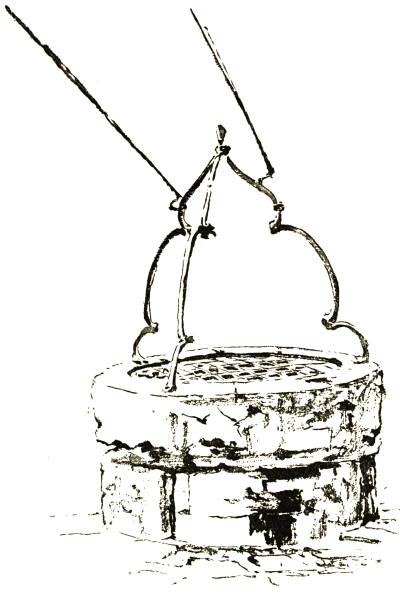
FOLIGNO: WELL IN THE CASA NOCCHI.
But it is the fruit of her mightiest days that makes
Foligno rich in monuments—the years between 1305
and 1439 in which the Trinci, having finally driven the
Ghibellines out of the city, were its despots, until
Eugenius IV., to whom the memory of Corrado's
terrible vendetta had an evil savour, deprived him
of power, and put him and his family to death. For
to this period Foligno owes the vast church of San
Domenico, whose picturesque campanile Mr. Markino
has sketched rising over the trees of Signor Tradardi's
garden; and little San Giovanni dell'Acqua with its
gracious doorway; and San Francesco and San Salvatore,
and the dismantled church of Santa Caterina, and many
another façade of rose and white Subasian stone, on[265]
which the years have wrought a tender bloom as of
fruit ripened in the sun. And not churches only, for
to the Trinci she owes the stately Palazzo Trinci long
since fallen to decay, but still linked to San Feliciano
by a covered archway, still preserving its great processional[266]
stairway, still decorated with the frescoes
which Ottaviano Nelli painted for the bloodthirsty
Corrado.
Foligno has many charms too often overlooked by
the traveller because she is such an admirable headquarters
both by rail and road for seeing Central Umbria.
The courtyards of her ancient palaces have lovely well-heads
of wrought iron, and many of their doors have
quaint and interesting epigrams over the lintel. She
has a little Venice on the banks of a canal, half dammed
by docks and water weeds, crossed by a Roman bridge;
and a water mill, where the women wash their linen in
a long arcade of red brick overhanging the brown millstream.
Her churches are full of golden pictures by
the greatest exponents of the Foligno school, Niccolò
d'Alunno, and Pier Antonio Mesastris, a painter little
known outside his native town, whose beautiful Angels
and Madonnas, combining an ideal tenderness and
sweetness of conception with a real depth of feeling,
have earned, in the language of the people, the name
of Maestà Bella.
Speaking of the Foligno school of painting, which
was characterised by an earnestness not to be found
in every branch of Umbrian art, whether it is the
grace and delicate spirituality of Mesastris or the
tragic intensity of Niccolò d'Alunno, brings me to
Foligno's modern school of art, of which she is justly
proud. It is housed in the old cloisters of San Niccolò[267]
where Canova once had his studio, and where he left
many of his plaster casts. And it is under the direction of
Professor Arturo Tradardi, a delightful enthusiast who
never wearies of studying the glories of his native town,
or seeking to recreate them. In the beautiful cloistered
garden of the Scuola di Arti e Mestieri he has gathered
together reproductions in plaster, toned to the exact
colour of the originals, of all the most beautiful monuments
in Umbria. A labour of love which may be responsible
for some of the extraordinary energy to be
found in Foligno, which with Viterbo leads the way
among the smaller towns of Italy in the glorious work
of freeing ancient monuments from the plaster prisons
in which they have lain hidden from the world during
the last three centuries.
It goes without saying that Foligno, which lies low
in the heart of Umbria, not more than ten miles from
Assisi, the cradle of the Franciscan legend, should be
the birthplace of a saint. But, notwithstanding the
picturesque legend of the Blessed Angela, which tells
us that as she walked through the fields of Umbria,
wearied by her struggles, and despairing of overcoming
the burden of her sins, she heard the voice of
Christ bidding her be of good cheer because He loved
her better than any other woman in the Valley of
Spoleto, we hear more of the Blessed Angelina within
Foligno than of Sant'Angela, who lies buried in the
church of San Francesco. For it was the Blessed[268]
Angelina, Countess of Civitella and Montegiove, who
founded the Convento delle Contesse, that quiet retreat
in a forgotten corner of Foligno where noble women
have continued to work and pray unceasingly since its
foundation towards the end of the fourteenth century.
Just as it was the Blessed Angelina's chapel in the
church of the Franciscans which sweated blood seventeen
years after her death because, as she related in a
vision, the Christians had lost Constantinople.
But it is not so much for her miracles and wonders
that this saintly woman is held in veneration as for her
holiness and chastity. And indeed her calm spirit
seems to linger in the quiet cloisters and gardens of the
Convento delle Contesse, in which she died after she had
founded no less than sixteen Convents of the Tertiary
Order of St. Francis. It is an oasis of peace and rest,
an oasis which is too easily passed by in the maze of
Foligno's streets, for its walls are high and bare, and
give no hint of the gardens they enclose, unless perchance
the outer gate be left unbarred, as it was when
we stumbled upon it and stopped to wonder at the
beauty of a picture disclosed under a wide pent-house
roof within. For over the doorway of this Holy House
which was the first home of that much-travelled picture,
the Madonna del Foligno, Mesastris painted one of his
lovely golden-haired Madonnas, enthroned among angels
and virgin-saints, while in the background little Loves
gather the delicate pied wind-flowers, limned against
the sky, and heap them up in baskets to scatter, maybe,
with song and praise upon the courts of Heaven.
339
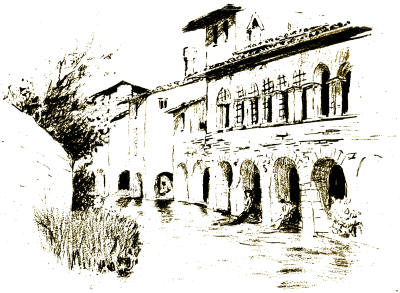
Foligno: the Washing Place.
[269]
Here too, if anywhere, the liberal spirit of the
Middle Ages lingers. We knocked, and the door was
opened as it was wont to open in the bountiful fifteenth
century before the old Order trembled. And within
we saw the Lady Abbess of a bygone day ruling a
little company of noble dames amid the serenest spells
of art and nature, with the beauty and the holiness of
their lives setting an ensample to the world instead of
being lost in mortification of the flesh behind closed
gateways. Signor Tradardi made us acquainted with
the beautiful Mother Superior, who came with us,
telling her beads and smiling at our enthusiasm as
each step revealed unsuspected charms, for nowhere
else in Italy had we gained such free admission to
a nunnery, nowhere else had we found the ancient
loveliness of fresco and Gothic loggia untouched in any
convent possession as in the little courts and pleasaunces
of this Garden of the Lord. Two black-robed sisters
were walking among the flowers with their pupils, but
when the gentle Abbess called for candles to take us
to the frescoed cell of the Blessed Angelina, they were
brought by a slender boy, whose curiously intense
beauty made a break in the calm and holy atmosphere
of this quiet retreat. He was very much at home, and
evidently did not seem to think that we should feel it
unnatural to find him in that galère.
[270]
We learned that he was the nephew of the Lady
Abbess—the professor of music for the convent. And
that he lived in Umbria, but next week was going to
Ancona. We had lately come from there? Then
perhaps we had heard the opera Thaïs, recently produced
so excellently in Ancona, which he was making
the journey on purpose to hear!
We drove to Spello on a September day of vagrant
sunshine, when the earth was musical with running
waters and the heavens, tinted mother-o'-pearl, were
spread with tearful clouds. The rugged crests of
Nocera's pyramidal hills in the van of the great
Appennines were shadowed with cobalt. The vines
were brown, the hedges full of berries, the scent of
wild mint sweetened the air. A rippling stream was
singing in its rocky bed beside the road, and long
grasses were still lying against the muddy banks as
they were pressed by the rush of storm-rain the day
before. And Spello lay before us in the sunshine like
a cluster of yellowing roses on the spur of Monte
Subasio.
But first we drove between the vineyards to the little
church of San Giovanni Profiamma which marks the site
of the ancient town of Forum Flaminii, built by the
Consul Flaminius on his Roman road before it left the
Umbrian Vale and plunged into the passes of the
Appennines. Like all the thirteenth century churches[271]
of this part of Umbria, it is built of the lovely pink
limestone of Subasio which gives such a peculiar beauty
to the streets of Spello and Assisi. Its ancient rose
window is broken, and two white houses hem in the
façade on either side.
The Romanesque doorway stood wide open, because
a knot of villagers were busied in putting up a gilt and
paper baldacchino for a festa. Some children and a
black goat had strayed in to watch; the priest was
giving directions, and every now and then lending a
shoulder when the whole affair threatened to fall over.
But what simplicity, what unspoiled mediaeval grace we
found in this tiny chapel in the fields, which is the only
relic of a long-forgotten city. It has been restored,
almost rebuilt, by the parish priest, who to his honour
has preserved every ancient stone, and arch, and bifora;
even the altar he has left in mediaeval simplicity, a slab
of marble on a worn and battered fragment of granite
column, all that remains of the pagan city of Flaminius.
They are a splendid people, these country priests
of Umbria, with their ambition to beautify their little
churches, and their merry good-nature in the face of
hardships. We met so many of them in Foligno,—one
who had written a book about his church, and
toiled to rescue the faded frescoes veiled in plaster on
its walls, taking the same pleasure in their beauty as a
gardener in the first blossoms of the year; another who
had made a museum of his sacristy and cloisters. But[272]
the priest of San Giovanni Profiamma has preserved
some precious pages in the history of art. We watched
him scramble into his ramshackle cart, shouting some
last instructions to his villagers before he drove off at
full gallop over the rough road with a huge sack of
fodder tied on behind. And we remembered another
country priest whom we had seen at Todi leading his
saddle horse down the hill to say Mass in some roadside
chapel, singing as he went, as Brother Francis
might have sung, with no thought of the morrow,
but only joy in the present, and faith for the life to
come.
We found Spello gay with the bells of her ox-carts,
and as busy as a good housewife, her men bringing in
bundles of fire-wood against the winter, or getting
ready for the vintage by rolling the pipes and hogs-heads
down the hill to be cleansed at the fountain
below the old bell-tower; and her women washing
their linen with song and laughter outside the Roman
gate.
Spello, the old Hispellum, which claims to have
been the birthplace of Propertius, notwithstanding the
stress that poet laid upon the neighbouring city of
Mevania as his home, is one of the loveliest cities in
the Valley of Spoleto. She is as pink as a rose. Her
houses are all ancient, many of them with Gothic doors
and windows; her arches are threaded with vines and[273]
Morning Glories; she clambers up the hillside in
narrow streets which turn naturally into steps when
they are too steep even for the nimble mule; her
people dress in bright-coloured linens, and the women
cover their burnished hair with the gayest of flowered
kerchiefs. As we drew near we saw her Gothic gate
bestriding the road as fiercely as though it feared the
Trinci might still come riding from Foligno, but close
behind it, on the tower of some fighting baron which
has been turned into a belfry, a full-grown olive tree
stretched out its arms, welcoming strangers with the
branch of peace.
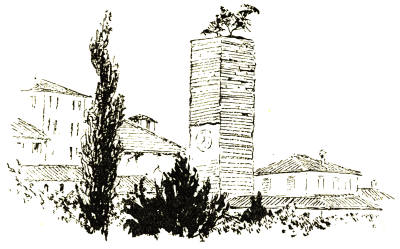
We went up through the ancient Porta Consolare,
whose Roman statues, toga'd ghosts of old Hispellum,
stare down upon the snowy flanks of the yoked oxen[274]
bringing in the fresh-picked grapes just as they did in
the years before Hannibal laid waste the Valley of
Spoleto on his march down to Campania. In Spello's
climbing streets, though she is poor and broken, we found
treasures worthy of great temples, heirlooms stranded
in the shipwreck of her wealth, like Santa Maria Maggiore's
rich Renaissance doorway and thirteenth-century
portal, and the exquisite holy water stoup in the nave,
which was once a pagan altar.
But most of all Spello is Pinturicchio's city. Her
peasants are the ghosts of his old people; in her streets
we met the lovely fair-haired girls whom he was never
weary of crowning as Madonna Mary. He painted
many pictures in her churches, in San Girolamo and
Sant'Andrea, and a whole chapel in Santa Maria
Maggiore, where he left his own portrait hanging
from the Virgin's shelf of books in the scene of the
Annunciation, as it hung perhaps from the shelf of some
woman whom he loved. In this church too are many
altar pictures, and an exquisite Madonna hidden away
in the sacristy among the tawdry paraphernalia of
saints' days, and an angel, lost for three hundred years
in a dark cupboard, which, when the sacristan illuminates
it with a candle, shines like a vision of the angel
Gabriel coming in the dawn of day to Mary.
The chapel, which was painted for one of the Baglioni
of Perugia, is faded and defaced like the Borgia room in
the Vatican, and needs bright sunshine to bring out its[275]
dim rich colours. But it is full of gracious Pinturicchio
figures who play their parts in the drama of the birth of
Christ against a luminous background in which we
glimpse the life of the Quattrocento as it flows in and
out of distant cities. And the floor is covered with gold
and blue Deruta tiles, made for the Brothers in 1565, and
so worn that we were sad to walk on them, although
the sacristan dragged chairs across them with the
utmost unconcern.
Then it rained, and because we had seen all
Spello's churches we had to seek shelter and lunch.
The only inn was down the hill outside the Porta
Consolare, but we found both food and refuge in a
humble cottage where the family were just sitting down
to their meal of steaming pottage. They gave us a
plate of that, and dressed some raw tomatoes with oil
and vinegar, at our suggestion, for Italians seldom eat
raw tomatoes, which they do not think are healthy.
And we were content with this and some good wine
and excellent rough bread, although the coffee which
our smiling hostess prepared so carefully was spoilt by
its too liberal dash of methylated cognac.
But the rain drove us from our little hill-city. We
tried to brave it, as we searched in vain for the
Porta Venere; nor could the old country women
climbing the hill in the shelter of their enormous green
umbrellas, who were the only people out in the storm
beside ourselves, tell us the whereabouts of anything.
[276]
CLITUMNUS
We drove to Spoleto along the Roman road which
threads the rich green valley of the Clitumnus, skirting
the hill of Trevi and the olive-groves which crowd
round the ruined fortress of Le Vene, and dipping at
last into an oak wood where the crystal springs, far-famed
in ancient days, leap from the rocky hillside.
It is the loveliest drive in Umbria. Not only for the
beauty of the way, for here all ways are beautiful, and
lie through gardens, where milk-white oxen labour
with wooden ploughs beneath the classic olive, and
vineyards where the vines usurp the trees and clothe
the valley in luxuriant festoons; not only for the loggia'd
farms scattered among the fields, or for the towered
castles frowning upon the road like mediaeval Sant'Eraclio;
not only for the sight of Trevi, the steepest
town in Italy, a queen upon her hill-top, with her face
towards Spoleto and her yellow skirts trailing down
into an olive-grove. All these we had seen a hundred
times before from other Umbrian towns. But nowhere
else had we found such unspoiled pastoral loveliness as
in this soft wide valley whose glory Virgil sang, and all[277]
the ancients praised, the latest home of gods, where
snowy bulls, victims for the Roman sacrifice, were bred
beside the waters of a sacred stream.
'Thou, gay Clitumnus, where thy currents glide
There bleating flocks thy flow'ry borders hide;
There snow-white bulls, the greatest sacrifice
Design'd for Jove, who rules the deities,
First wash'd and sprinkled with thy sacred flood
Pay for the Roman triumphs with their blood.'
Though she looks like a queen on her hill-top, Trevi
is at heart a simple country maid, with nothing to offer
to the traveller but a few pictures by Perugino and his
pupils, and an exquisite Renaissance altar by Rocco da
Vicenza. She is the most disappointing of all the
mountain fastnesses which have defied the assaults of
change, but she stands like a sentinel before a landscape
of surpassing beauty, peopled with classic memories.
For here, below the crumbling walls and towers of
Le Vene, at the foot of olive-wooded hills, we walked
beside the crystal waters of Clitumnus, through scenes
immortalised by Virgil in the Georgics.
'Unbounded plains with endless riches blest;
Yet caves and living springs, and airy glades,
And the soft low of kine, and sleepy shades
Are never wanting ...'
Here by the roadside we found the little temple
which some say is one of those chapels of the god Clitumnus
that Pliny wrote of to his friend Romanus when he
adjured him to visit this so-lovely spot. And others,[278]
because of the Christian symbolism carved on its walls,
claim to be a Christian fane built of pagan fragments
in the fourth century. In any case it is deserted of its
gods to-day, for if no incense is offered to old Clitumnus,
neither is Mass said now before its altar, for the honour
of San Salvatore. And yet I do not think the oracle,
whom Caligula as well as Honorius came to consult, is
far away; for the sun and rain have mellowed the old
stones, giving them a rare and perfect beauty, and the
birds nesting beneath its tympanum chant praises in
the dawn, while from below ascends the song of
the sacred stream as its flows by to mingle with the
Tiber on its way to Rome. Nay, Pan himself, weary
of making music in the reeds, might stray into this
temple, to wonder at the faded saints who looked so
coldly on him from their niches, before he leapt back
again at break of day to the oak-woods on the hill
above, where the goat-herds tend their flocks.
A little further on we reached the source of the
Clitunno, where many crystal streams gush from the hillside
or bubble up from the ground, uniting in a wide
lake before the river can escape along the valley. The
air was full of the merry music of lapping waters and
the ecstatic shrilling of the frogs. Tall poplars swayed
upon the shallow banks, and giant willows trailed their
branches in the stream like the long hair of water-nymphs.
Little white bridges led from one green
island to another, but the lush grass sloped so gradually
to the clear waters that we could hardly tell where it
first mingled with its own reflections. The crystal
pools were underworlds of emerald waterweeds, now
dark, now light, and in their mysterious depths were
springs whose shafts of cyanite blue gleamed phosphorescent
through the swaying plants. And here
small fishes darted in and out with watchful eyes, and
speckled trout swam slowly to and fro.
351
[279]
Surely if anywhere the old gods linger here. And
when the valley is silent, but for the distant shepherd
piping to his flocks, surely the naiads resting on the
emerald sward call to their sisters, the Hamadryads and
the Oreads, to leave their oak-woods and the hills above
and dance down to join them in the clear cool water.
Half unconsciously we looked and listened for them.
And in a moment the youth of Arcady seemed to be
born again. The babbling of the many little streams
was like the echo of mocking laughter. I felt as
though I had strayed into a court of water-nymphs and
heard them making merry as they hid among the reeds.
I could have sworn I saw one once; but it was only a
darting fish. Then a kingfisher flying low took cover
in the sedges just where the glinting sunshine dazzled
my eyes. And I thought I heard them laugh again.
[280]
SPOLETO
Too few have sung the splendour and beauty of
Spoleto, the proud white city whose towers breathe a
message of peace to-day, where they once blazoned war
down the wide green valley to Perugia. For Spoleto,
like Perugia, has been a queen among cities. Like
Perugia she has kept ward through the ages upon the
valleys of Umbria, gazing down from her sacred ilex
groves on lesser cities riding the encircling hills—towered
Montefalco upon the ridge which shuts off the
valley of the Tiber; Trevi on its steep olive-girt
mount; Foligno and Bevagna down in the plain; little
Spello; Assisi, very beautiful as she kneels before the
mighty temple she has raised to San Francesco on the
slopes of Monte Subasio; Santa Maria degli Angeli and
Ponte San Giovanni. And in one proud memory at
least she is greater even than Perugia, for she alone
withstood the tidal wave of Hannibal in the second
Punic War, so that he turned from her walls dismayed,
nor dared to march on Rome, seeing that this small
colony could hold his force in check.
If she had faded out of history after that, her name[281]
would have been heroic among the Umbrian towns.
But though she suffered in the civil war of Marius and
Sulla, we know that she continued to flourish even in
the dark years between the fall of Rome and the growth
of mediaevalism. Totila destroyed her as Frederick
Barbarossa was to destroy her in the middle of the
twelfth century; but Theodoric the Ostrogoth, and after
him Narses, the Exarch, built her up. Under the
Longobards she became an independent duchy; after
the fall of the Carlovingians her Dukes were for a short
time Emperors of Italy.
Ah! Spoleto, it is little wonder that you are proud
to-day, that your bells ring so joyously down the valleys,
that you hold high festival to celebrate the fiftieth
anniversary of United Italy. What does it profit
Perugia that her name was splendid in the Middle Ages,
and that she is still the Queen of Umbria, 'the Empress
of hill-set cities'? Yours was the greatness of a more
heroic day. Her lords were savage beasts, her people
slaves, her streets were noisome with slaughter, her
name a proverb for ferocity, while the Baglioni spread
their pestilence across the valleys, seeking ignoble
victories, and fighting unending little wars for self-aggrandisement.
Because the Barbarossa laid you low
the star of Perugia rose clear upon your horizon.
Already in 1198, when you with all the other Umbrian
towns paid tribute to Innocent III., she was the capital
of Umbria. But you, the champion of Rome, the
Knight-errant of the Papacy, had nobler ambitions.
Your Dukes were heroes before the lords of Perugia
were even robbers. Were they not Emperors too?
Guido, with his pretentious claim to the kingship of
France, and poor young Lambert, the chivalrous and
beautiful Knight of Spoleto, with whose ill-timed death,
on the very spot where the great battle of Marengo was
fought nearly a thousand years after, perished the hope
of a united and independent kingdom within the Italian[25]
frontier.
[282]
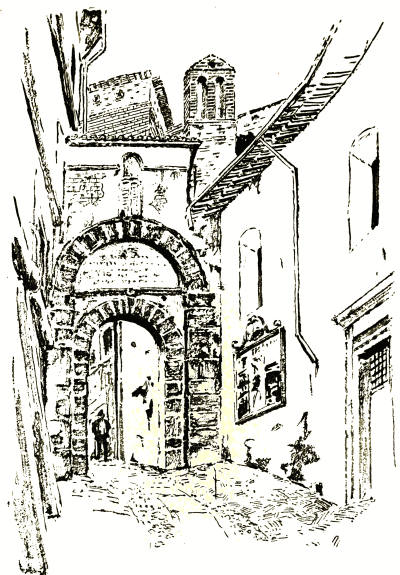
SPOLETO: PORTA D'ANNIBALE.
[283]
Spoleto was truly in a jubilant mood when we
climbed up her winding streets, past the beautiful but
ruined apse of San Niccolò, and the magnificent prehistoric
wall below its convent. An Industrial Exhibition
was being held in the Piazza Bernardino Campello,
and the Merry Widow—'nuovissima per Spoleto'—was
to be played that night in the Teatro Nuovo, 'con richissima
messa in scena!'
But at all times we found the quality of joy in
Spoleto. Long long ago she wept perhaps when she
waited, as Elaine for Lancelot, while her lover, the
beautiful and splendid Lambert, was in the toils of his
insatiable mistress, Rome. Widowed, she trimmed a[284]
lamp before his shrine and turned her eyes towards
the Papacy, seeking to build up an Italian Empire,
through the temporal kingdom of the Pope. But now
she has opened her gates to welcome the new era,
and, having doffed her mourning garments, sits
enthroned at the head of her magnificent valley,
welcoming the world with the gracious dignity of one
who for a few short years was the mother of United
Italy.
Spoleto does not clamber up the hillside like rosy
little Spello. She is tall and stately, pale as a lily,
silent as a girl who dreams of love. More than any
other of the hill-set cities of Umbria she bears the stamp
of Rome, in arches and half-buried houses, in walls and
ancient temples long since turned to the worship of
other gods, and most of all in the inspiration of the great
aqueduct which spans the ravine between her Rocca and
the ilex-woods of Monte Luco.
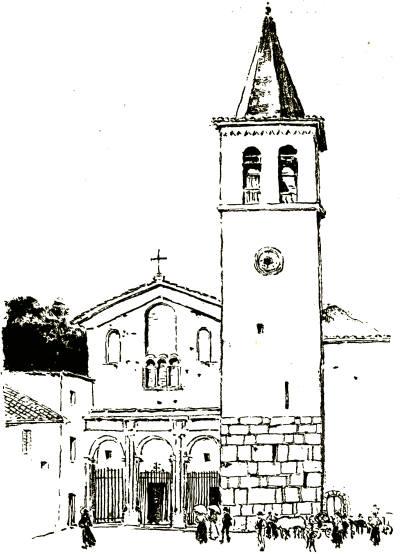
In Spoleto Rome and modernity walk hand in hand.
Spoleto is not mediaeval in character like other
Umbrian towns. Her hill is crowned by the imposing
Castello which Cardinal Albornoz and Nicholas v. built
on the site of the Rocca of Theodoric, and she has
many gracious churches which flowered from the
eleventh to the thirteenth century, like the cathedral
and San Gregorio Maggiore; or, more ancient still, San
Salvatore, that exquisite relic of the fourth century,
which contains the nucleus of a Roman temple; and San[285]
Pietro, on the lower slopes of Monte Luco, which was
built in the fifth century and restored in 1320, after it
had been practically destroyed by the Ghibellines. It is[286]
true that the splendid roofless apse of San Niccolò soars
above the main street with broken lancet windows
framing the heavens, like the windows of Tintern, but
it is built over the ancient circuit of the city walls;
and though its slender Gothic grace beautifies the hillside,
it was the rugged stones of Spoleto's prehistoric
fortifications which claimed our eyes. For it was
against these walls, which the Unknown People, and
later the Pelasgians and the Romans, built round the
foot of their city, that Hannibal threw his Punic troops
in vain before he retired to the rich territory of Picenum,
where he fortified his soldiers after the rigors of their
journey through Northern Italy and the Alps.
It is the same all through Spoleto. Here and there
we wandered into steep, narrow lanes, where the strip of
sky above our heads was cut by bridges leading from one
tall mediaeval mansion to another, where there were
shrines in the walls and Gothic doorways leading to
dark and mysterious courtyards, and Doors of the Dead,
and, to speak truth, unsavoury odours, which are the
least pleasing reminiscences of the Middle Ages. But
for the most part Spoleto is clean and modern, with
wide streets and piazzas graced by hanging gardens, in
which her Roman fragments are stranded like the
skeletons of giants, where they are not buried beneath
the soil, like the wonderful subterranean bridge outside
the Porta San Gregorio; and the lower church of Sant'Ansano,
on the foundations of a Temple of the Sun;[287]
and the mosaiced house which is said to have been the
home of the mother of the Emperor Vespasian.
Among her treasures Spoleto holds the dust of
Brother Philip in a beautifully wrought casket of lapis
lazuli and gold, for that was how the façade of Santa
Maria Assunta appeared to us as we rounded the corner
of the Episcopal Palace, and came upon it suddenly,
bathed in the yellow sunlight of late afternoon.
The Cathedral of Spoleto is set humbly on the hillside
in the shadow of the great Rocca of Nicholas V. So that
we stood, as it were, above the jewelled façade, and saw
it rising in all its glory at the bottom of a wide steep
slope which opened out into a green piazza between the
sloping gardens of the Rocca and the little Renaissance
Chiesa della Manna d'Oro. Like the Cathedral of
Assisi, which its façade resembles, having the same
triangular tympanum enclosing grand Gothic arches
corresponding to the naves of the older building, it is
externally one of the most gracious churches in Umbria.
The fifteenth century loggia of its portico supports a
Renaissance arabesque, and above it the central arch
of the tympanum is filled with gold and blue mosaics
which glow like jewels in their rich setting of mellowing
stones. The glass in the beautiful rose windows is
the colour of lapis lazuli; two little stone pulpits are
built into the wall on either side of the portico, and in
its shadow is the frescoed chapel of Francesco Eroli,
Bishop of Spoleto.
[288]
But why attempt to reproduce with pen and ink
and dull description a picture more fitted to the
golden brush of Fra Filippo Lippi, and which indeed
owes much of its charm to the beauty of the Umbrian
hills billowing away to the horizon, and the alchemy
of sunlight changing ancient stones to gold—the
complete and lovely unity of Art and Nature.
I hope the sun sometimes shines in upon the tomb
of Lippo Lippi, for I know he loved it, and the marble
cenotaph which Lorenzo the Magnificent raised in
his honour, when the Spoletani refused to let him
carry away the body of the painter, because 'they
were badly provided with things of note,' is rather bald
in spite of its florid epitaph. But the tomb itself did
not detain us long, for in the apse we had caught
sight of some of Brother Philip's loveliest frescoes
telling the story of the life of the Virgin, in four great
chapters—the Annunciation, the Birth of Christ, her
Death, and in the vault above, her Coronation in the
Courts of Heaven.
363
[289]
According to Vasari, Fra Filippo, engaged as usual
in a love affair, was poisoned by the family of the lady
whom he had seduced while he was at work on the
Cathedral. It is likely that the people of Spoleto
were not so complaisant as the Florentines, who had
long ago ceased even to shrug their shoulders at the
amours of this son of the Renaissance, although he had
refused the offer of Pius II. to legitimise his marriage
with the beautiful nun Lucrezia. But later writers
have dismissed the idea as one of Vasari's ill-founded
scandals. In any case there were few men less worthy
of painting the sacred story of Madonna Mary, and
few who could have told it with such purity and
tenderness, and intuition. For not even the damp
which has caused them to peel and discolour in places,
or the uninspired work of Fra Diamante who finished
them, when Lippo Lippi, 'that vagabond and joyous
mortal,' had been laid to rest, can rob these pale and
sad Madonnas of their beauty, or take away the
spiritual loveliness of the angels, who with the sun and
the moon and all the constellations do homage to
the Queen of Heaven.
But these things are as nothing compared with the
real glories of Spoleto—the peculiar beauty of her
landscape, and the magnificence of the Ponte delle
Torri, the great aqueduct of the Longobard Dukes,
which links the city to the sacred ilex groves of Monte
Luco.
Nature has endowed Spoleto richly. She is built
on the slopes of an isolated bastion of the Appennines,
which closes as it were the Central Plain of Umbria.
Behind her towers the broad shoulder of Monte Luco,
veiled in ilex woods. To the south the wild valley
of the Tessino opens a vista of rolling hills, mounting
fold on fold to the horizon. And from the windows
of our inn, the picturesque old Albergo Lucini, whose[290]
palatial rooms, sparsely furnished with ancient grandeur,
are such a luxury in the hot summer months, we
looked over the roofs of the lower town, and across
the tranquil country to Perugia, more than forty miles
away.

Was it perhaps because we knew this soft and
gracious valley, sanctified by the footsteps of many
saints, so well, that we loved it even more dearly
than we had loved it as we gazed from the bulwarks[291]
of Perugia? Then these little towns sown along the
hillsides or crowning their miniature peaks, like Trevi,
and Montefalco, were nothing but names and points
of beauty. But now after many weeks spent on the
eastern coast of Italy or among the rugged Appennines,
we had come back again to gentle Umbria, to find
that every little town was full of smiling memories,
and all the winding roads were pathways to romance.
Who could forget the classic grace of Clitumnus,
when he saw the clustered poplars soaring from the
plain? Or the capers and the flowering rosemary,
which made a garden of the ancient walls of Trevi?
Or the sweetness of the olive woods below Assisi,
where we wandered in the footsteps of St. Francis
gathering an imperishable bouquet of holy memories?
Or the subtle beauty of the Tiber, as it washed the
skirts of Perugia's hill?
Nor had long association lessened the miracle of the
soft radiance of the heavens, or made commonplace the
clarity of atmosphere, or dimmed the strange light
which seems to float like an eternal benediction
between the mountains of this Mystic Land.
Early next morning we climbed up the hillside,
past the Piazza Mercato, where a blackbird, always
singing in a wicker cage, in the shadow of a Roman
arch, is the personification of the joyous spirit of
Spoleto. A few steps from the Rocca, through a
gate in the ancient line of fortification, brought us[292]
into a small bastioned piazza overlooking the deep
ravine of the Tessino, and the aqueduct which spans it.
In my notes, I have said nothing of the Ponte delle
Torri except to cry the wonder of it! Which is not
surprising, for there are no words to fit it, no words
large, or grand, or ambitious, or vigorous enough
to describe this bridge of towers and colossal arches,
which bestrides the valley between Monte Luco and
the hill of Spoleto. It is the work of giants. It
would be a worthy testimony to the grandeur that
was Rome's; to the energy and the indomitable
courage of the men who moulded an empire out of
a handful of earth, and ruled the world from seven
little hills. But the Ponte delle Torri is not the
work of Rome. A mystery surrounds its origin.
Theodelapius, third Duke of Spoleto, is said to have
built it early in the seventh century, but it is at
least reasonable to suppose that the foundations were
Roman—indeed the local Guida di Spoleto claims
that the actual conduits in use to-day are Roman. And
it is obvious that the pointed arches are of mediaeval
structure, probably contemporary with the ancient
fortress, now a water-mill, which guards the head of
the aqueduct on the slopes of Monte Luco. It is
in fact a mosaic to which the Spoletans of all ages
have contributed their stones.
369
[293]
But it was not only the grandeur of this Leviathan
which held us spell-bound on the edge of the ravine;
we were captivated by the lavish beauty of its mise en
scène. For the ilex groves of Monte Luco, sacred to
the ancients for their primeval forests, and to a younger
world for the mediaeval saints who dwelt therein, were
full of morning mists. Here and there some treetops
illumined by the rays of the sun, lately risen above the
shoulder of the mountain, stood out in clear relief
against the dark hillside. The rest was held in shadow.
Little blue columns of smoke ascended on the windless
air from the bosky depths where charcoal-burners
made their fires; the far-away bells of the Franciscan
Convent on its crest were like the music of
wind-bells under the roof-trees of the Gods. Every
now and then the chimney of a cottage, sunk in the
hillside below the level of the road on which we stood,
wove a transparent veil of fragrant wood-smoke between
our profane eyes and the sacred mount.
We came again in the evening when the aqueduct
was bathed in the declining sunlight, which threaded its
great arches with slanting bars of gold. And then we
crossed that magic Bridge of the Giants and plunged
into the enchanted ilex woods of Monte Luco. The
stony way was sown with cyclamens, and the rocks were
broidered with bronze and emerald mosses. At our
feet the hill sloped sharply down the ravine and the
slanting sunshine wove a web of light between the
trees. Above us a sea of sunlit ilexes rose to the blue
heavens. As we went deeper, the cool, scented breath[294]
of oak trees came out to greet us. And across the
valley we could see Spoleto and her crested Rocca,
with her ancient walls striding down the hillside
through her vineyards. From this point she seemed
to be a city of towers and loggie and hanging gardens.
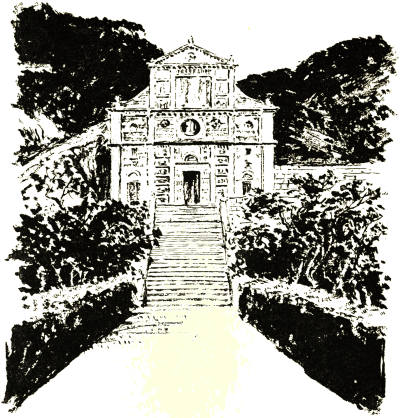
Presently we reached the beautiful and ancient[295]
church of San Pietro, and found the strange Mediaeval
carvings on its façade gilded by the last rays of the
setting sun. While we were spelling out its fanciful
devices the glow faded from its face, leaving it old and
grey at the head of its long flight of steps, as though
it had seen fear. And indeed time has dealt harshly
with this shrine since it was founded in the fifth century
on the fragments of a pagan building. Even the fading
light sufficed to show us that it held no treasures,
beyond the twelfth-century fragments from Byzantine
Bestiaries on its façade, and the later reliefs dating
from its restoration in the fourteenth century, after it
had been wantonly destroyed by the Ghibelline wolf,
seeking in vain to force an entrance to the fold of
Spoleto.
[296]
THE FALLS OF TERNI
At Terni the marvels of Nature have been transformed
into the marvels of electricity without changing the
face of the landscape. For the Velino, the swift black
river which has its source deep in the mountains of the
Abruzzi, and hurls itself in three gigantic columns over
a precipice 600 feet high, takes to the mills of Terni an
electric current which does the work of 200,000 horses
without speeding the placid Nar as it washes the fantastic
Gothic walls of Interamna.
There are few waterfalls so unspoiled as Terni.
The immense power-station is almost out of sight, and
though the leafy valley which excited the admiration
of the younger Pliny is blocked at various points by
great factories, there is not a single café or restaurant
to mar the savage splendour of the Cascate delle
Marmore.
Early in the morning of a St. Martin's summer we
set out from Terni to see the famous cascades of the
Velino, which, like the falls of Tivoli, are the work of
Roman hands.[26] The great mountains closing the valley[297]
of the Nar were shadowy against the sunlit mists. As
we drew near, the clamour of the water grew and
gathered like the exultant roar of some primeval giant.
The river began to hurry in its deep channel below the
road, and foam-white torrents clambered down its
banks, with bursts of laughter, to find themselves
escaped from the main waterfall. But still the mists
clung to the green hillsides so that we only saw their
crests silhouetted against the welkin.
Suddenly out of the tender half-tones a sunlit
cloud loomed silver in the heavens. I have seen the
snowy turrets of a cumulus illuminated by a burst of
sunlight on many an April noon. I seemed to see
them now, shadowed against the blue Empyrean. But
it was no cloud. The growing clamour told me so.
That fantastic outline, clothed in the semblance of
giant trees, was solid rock cleft with a flood of leaping
water, which caught the sunshine, like the silver lining
of a storm-cloud, as it topped the cliff, and then vanished
in a mist of mounting spray.
Sun and river poured together over the ilex-crested
mountain, the light in solid rays athwart the belching
smoke of the falls, the water like a living thing, an
unchained element, which leapt again in ecstasy to the
blue heavens, winnowing the air with plumes of wind-tossed[298]
spray. On either side the hills fell back before
us, their forests and terraces glistening with Byron's
'... unceasing shower, which round,
With its unemptied cloud of gentle rain,
Is an eternal April to the ground,
Making it all one emerald....'
And in the midst, cleaving the ilex forest on the
brink of the precipice, the Velino hurled itself into the
abyss with a mighty shout of laughter. Sometimes it
spent itself upon the rocks in foaming passion, impotently
desiring its consummation with the sea,
doomed to captivity upon the way, to lie in stagnant
pools chained for the service of humanity. Sometimes
it trickled languidly over the moss-grown crevices, engrossed
in the delicate pleasure of its own music.
Sometimes it glissaded as transparently as glass, seemingly
motionless in its resistless speed, over the smooth
yellow boulders bearded with stalactites.
377
[299]
It was profoundly exciting—the voice of Nature, a
real and primitive thing. Only a little way up the
valley great manufactories choked up the banks of the
Nera; but here the clamorous voices, mad with the
delirium of motion, sang to the heavens in unbridled
joy. It was a great song of labour, a gigantic Wagnerian
strain, in which we could distinguish the lilting
song of the Rhine daughters above the thunder of the
giants, telling the happy innocence of earth before her
stolen gold became a passion to gods and men. Or in
another mood we heard the laughter of water-gods
as they leapt into the boiling chasm, and the dryads
and the naiads calling to their sisters, the 'wind-enchanted
shapes of wandering mist,' and clapping their
hands to see their great comrade come hurtling from
the heavens careless, in his mad race, of the defeat to
come. Only the mists, the tiger-striped mists, leapt up
to warn the silver giant, and lost themselves under the
melting kiss of the sun. We never could have wearied
of watching these maenads dancing before their lord.
But time pressed. We were to be in Narni that
night, and we had yet to climb to the head of the fall,
through its enchanted ilex-wood, where ferns and
flowers, all wet with glancing spray, grow round the
lips of overhanging caves, and dock leaves wave huge
fans in the wind of rushing waters.
Sometimes through an opening in the trees we caught
sight of a moving curtain of white mist; sometimes the
path led on to a narrow ledge overhanging the main fall,
where we could stand in the shelter of a hollowed cave
and watch the water leaping down in Gothic points
of spume, plunging into the smoking cauldron to rise
again in Iris clouds of spray. A butterfly which
had ventured from the green shadows of the music-haunted
wood fluttered an instant in the wild wet
breath of the fall, and was drawn remorselessly into
the vortex. Here, indeed, with the thunder of the
Velino shaking the hillside, there was a savage and
awful beauty in the scene. Here we could recognise
the landscape where Virgil's Fury, leaving 'the high
places of the world,' fled to the mansions of Cocytus.
'A place of high renown, and celebrated by fame in
many regions ... the side of a grove, gloomy with
thick boughs, hems it in on either hand, and in the
midst a torrent, in hoarse murmurs and with whirling
eddies, roars along the rocks....'
[300]
[301]
We lunched in a cottage a little way from the
bottom of the fall, which seemed to be a restaurant for
the humble needs of the workmen in a neighbouring
carburet factory. At least its landlady was greatly
distressed because she had nothing for the signori.
'Non è basta! non è basta!' she cried, although we
discovered four roast chickens and some excellent
potato salad as well as a huge cauldron of minestre on
her stove. Later, when the factory bell had rung for
mezzogiorno, and all the employés crowded in, we
found there really was not enough to go round. But
the courtesy and charming manners of the workmen
were a revelation. Although there was no soup for
some of them, and certainly we had eaten one of their
chickens, they treated the whole affair as a joke, and
heaped their plates contentedly with pasti.
But to us the biggest joke was the price of the good
lunch we had so unwittingly stolen from the regular
patrons of the inn. For the bill for the wine was
threepence-halfpenny for all, and the potato salad was[302]
a penny each, and a plate of chicken was sixpence, and
a plate of soup twopence only. Truly, as the poet said,
'Italy has everything: climate, scenery, art, antiquities,
history, romance, beautiful people, fruit and wine and
cheapness.'
[303]
NARNI
From the first moment that we saw her, a jewelled
hill-top set high among the stars, there was a touch of
magic about Narni. As we drove through the valley
tall black cypress spires showed us our path, and the
starry heavens were as luminous as though Diana had
already lit her lamp below the hills. Dimly we
glimpsed a battlemented gate rising gaunt above the
road, and the ghostly form of the broken bridge of
Augustus striding amid the reflections of the Nar.
We climbed up into the hooded night between great
hedges where the frogs shrilled softly to each other.
The Pleiades hung low upon the mists of the horizon
like the phosphorescence of a tropic sea, and above
us the lights of Narni were gold against the silvered
canopy of stars.
The way was long although it was so beautiful,
and lonely, too, when the town was hidden from us
by a fold of the hill and we could see nothing but
the towers of the Rocca upon its crest, a shade of the
Middle Ages among the imperishable stars. So that
we welcomed the cheery beams of a shepherd's lantern
set by chance in the window of a white-walled farm,[304]
like a beacon on the dark hillside. And soon afterwards
we passed under the beetling Trecento gate of
Narni, and found ourselves in a piazza
where the driver pointed out thousands
of earthenware pots spread on the ground
beneath the trees. 'For the festa to-morrow,
Signori,' he said. And that was
the first we heard of any festa. But not
the last, for all the inns were crowded,
and it was only by dint of a great deal
of talking, and through the courtesy of
a young Italian girl who had travelled
by the same train as ourselves, and who
volunteered to sleep in the village, that
we were able to find two beds and a sofa
in the Albergo del Angelo.
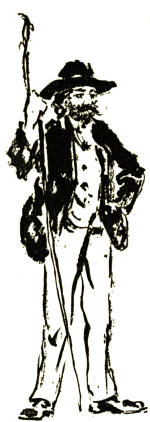
We woke to find ourselves in
Arcady. The smiling sunshine called me early out of
bed. Below my windows came the music of passing
herds and flocks—the lowing of kine and the tinkling
of their bells, the clipping hoofs of mules and asses, the
pattering feet of sheep, like summer rainfall on the
broad-leaved trees. And, strangest sound of all, the
clear high song of larks, so rarely heard in Italy,
where the native, as in Dante's age, still 'throws away
his days in idle chase of the diminutive birds.'[27]
There were two windows in my room. The one to[305]
which the dulcet singing of the larks called my attention
looked from the wall of Narni's precipice into the
deep valley of the Nera, a magnificent
and awe-inspiring view, for
the Angelo is perched upon a crest
of beetling rocks with a sheer drop
of a hundred feet towards the river.
But from the other I looked on one
of the loveliest pastoral pageants I
have ever seen in Umbria. For
down the old Flaminian Way which
Popes and Emperors, and Caesar
with an army, trod, and up a winding
pathway such as Gentile da
Fabriano loved to paint, which led
from the valley to the hill of Narni
and joined the main road at our
very door, came neat-herds driving
before them snow-white oxen, and peasant women with
brightly flowered kerchiefs riding a-pillion on mules and
asses, or walking behind flocks of sheep with wide flat
baskets of poultry and fruit and vegetables on their
heads. Barefoot children helped to guide the calves;
and here a shaggy farmer rode up the hill a-horseback
in sheepskin trousers, with a wallet and flask of wine
slung across his mediaeval wooden saddle; and there
some happy youths led in their heifers with scarlet
fillets hanging on their brows.
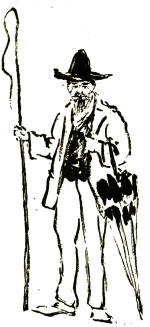
[306]
They might have been processions of the Magi
bringing their gifts to the Infant Christ in the dawn of
the Nativity. Or, better still, these joyful husbandmen
and shepherds bringing the first-fruits of their harvest
into this little hill-town for the ox-fair of St. Michael,
might have been the votaries of Apollo coming to
celebrate the Pyanepsia with offerings and invocations.
We dressed in haste and hurried to join them as
they flowed along the streets and out through Narni's
mediaeval gate to their Forum Boarium beyond the
city walls. And it was Arcady we found below the
silver olives. For the road looped a natural theatre,
such as the Greeks loved to terrace and face with
marble, where the citizens might sit gazing over the
glittering stage, on which Gods and Heroes spoke the
dialogues of Aeschylus and Sophocles, at one of
Nature's masterpieces—Etna, rising above the Strait
of Messina, or the isle-girt sea of Salamis.
Here the olive-clad slopes were steep and the curves
of the bay were bold, and the flat area which they enclosed
was commanded on one side by the towering
bastions of Narni and on the other by a great Dominican
Convent with all its ancient splendour revived by
the Royal House of France. And here we looked across
a market in the hollow of the theatre, where thousands
of white oxen, their foreheads bound with Roman
fillets, scarlet and blue, stood below the twisted olives
in a mist of slanting sunlight, which threw a tracery of
blue-veined shadows on their snowy flanks. Beyond
them in the open champaign we could see the towered
bridge over the Nera, and the green pasture land
characteristic of lower Umbria which makes it so
different to the vine-engarlanded plains of the Valley
of Spoleto.
387
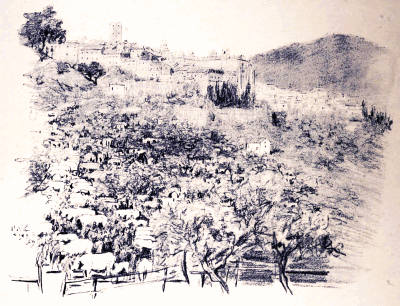
The Cattle Fair at Narni.
[307]
On the hill above, the mules and asses, still bearing
their wooden pack-saddles picked out in brass and
scarlet cloth, were tethered in the
shade of the army of olives, which
swept up to the walls of the grim old
Rocca. And before us lay the winding
road, with its gay stalls and
booths and its moving crowd of
peasants, looking for all the world
like a brightly-coloured ribbon threading
the grey wood.
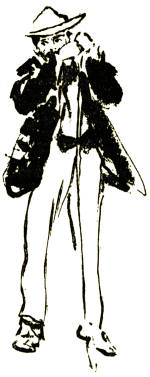
Surely the gay Hermes, the god
of markets, the beneficent patron of
pastures and herds, smiled on this
gracious fête champêtre, so pagan in
its simplicity and lavish beauty. Perhaps
he lingered down in the ox-fair
where a charming patriarchal
custom was observed every time a bargain was concluded,
when the bystanders joined the hands of the
two farmers concerned, and held them while they shook[308]
in token of good-will. Or likelier still he wandered on
the causeway with Corydon and Thyrsis, or, in more
jovial mood, searched among the pretty peasant girls,
for Amaryllis and fair Delia, whose thoughts to-day
were all for market wares, displayed by plausible
auctioneers below the laurel avenue.
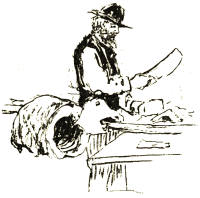
There were restaurants of trestle-tables in the
chequered shade, where husbandmen regaled themselves
with such aesthetic fare as bread and celery
and walnuts, washed down by plentiful libations of
amber wine; and savoury
kitchens where pigs and
calves were roasted whole
on spits; and stalls of
peasant jewellery—strings
of blood-red coral
and over-chased earrings;
and booths of lace
and embroidery. Here
boots and shoes were
spread beside the road; there sun-burnt peasant women
were buying stays, heaped on the ground close to a stall
of fluttering kerchiefs. The majolica and copper dishes
were also ranged along the roadside, as were the stalls
of wooden implements, bobbins, and spoons and trays.
But the cotton umbrellas, scarlet and blue and emerald
green, were hung like fantastic lanterns from the
branches of the avenue.
[309]
What a scene it was! The lowing of the kine
mingled with the distant music of the bells of Narni.
Every moment fresh arrivals added their quota to the
merry bustle of the market, some bearing on their
heads great baskets heaped with fruit, some laden with
captive turkeys and chickens, some leading in their
wide-horned oxen, gay with scarlet fillets and bells
slung round their silken dewlaps. The brilliant
kerchiefs of the women made them look like flower-gardens
as they stood in smiling groups before some
alluring bargain held up to their admiring eyes by
salesmen. And mingling with the crowd were fortune-tellers,
and ballad-singers, and the terrible crawling
beggars of Italy.
Later in the day we went down the hillside and
rested in the shadow of the great ruined bridge of
Augustus, that splendid relic of Imperial Rome, which
once carried the Flaminian Way across the waters of
the Nera. Only one arch is left to stride across the
ravine, and in the middle of the sulphureous stream
the second pier has fallen sideways in huge blocks, as
though it had been toppled over by an earthquake.
But even in its ruin it is a monument of the greatness
of Rome, and it frames a wonderful vista of the wooded
glen of the Nar and the ancient convent of San
Casciano.
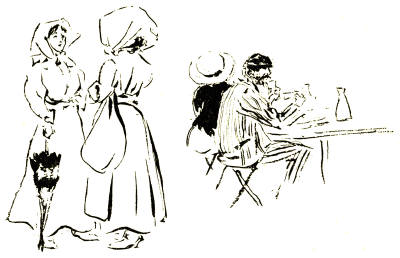
The contadini were pouring out of the city and
across the river by the mediaeval bridge that takes[310]
on its shoulders the modern traffic, which, had the
years been kinder, would still have been carried by
the Ponte d'Augusto. They were all laden with
purchases from the fair, and they made merry as they
passed along, driving before them, not without a
struggle, their unwilling cattle. But we did not stay
there long to watch them, notwithstanding the picturesque
beauty of the scene. For the pitiable cries of
the mothers, struggling to go back to their calves,
resounded through the valley; and the blind unreasoning
misery of their offspring, driven with blows along
an unaccustomed road, was heartrending to witness.
Though common sense was plausible to point out how[311]
soon the agony would pass, it was too human to be
anything but tragic.
So we climbed the hill back to Narni and wandered
through her empty streets, astonished to find them rich
in ancient grandeur. For we had grown to think of
her as a pastoral queen of Arcady, forgetting her antiquity—that
as Nequinum she was great among the
cities of the Umbri; that under the Romans she was a
fortress of importance commanding the Flaminian Way;
and that in the fifteenth century she bore a famous name
as the ancestral home of Gattamelata, the great Condottiere
of the Venetians. Narni has good reason to
be proud of her sons. One was an Emperor, one a
Pope, and one a hero.
And she herself has an heroic history, for so
great was her defence against the Romans that
when at last she fell before the Consul Fulvius in
b.c. 299, he was given a Triumph 'de Samnitibus
Nequinatibusque,' and in the fatal year, 1527, she offered
an historic and gallant resistance to the lanzknechts of
the Bourbon when they retreated from the horrors of
the Sack of Rome. For this the little citadel suffered
the terrors of a sack in which one thousand men and
women were brutally put to death by the Spanish and
German mercenaries. So that there is again cause for
wonder that so many of her ancient churches and
palaces have been left unharmed, like the gracious little
chapel of Santa Maria Impensole, the Gothic Palazzo[312]
Comunale and Palazzo dei Priori, and the beautiful
cathedral, which is so rich in tombs, and counts among
its treasures a Romanesque shrine of high antiquity
and interest.
But though the Bridge of Augustus was the
glory of Nequinum in the days of Martial, it is
Erasmus, called Gattamelata, who is the chief pride of
Narni. A whole quarter of the city bears his name.
In the Vicolo Gattamelata a humble little house is
inscribed 'Narnia me genuit, Gattamelata fui,' and in
the Palazzo Comunale, beside Narni's great Ghirlandajo,
is a copy of that Knight of the Uffizi, which up to the
last few years has been ascribed to Giorgione, and which
the citizens of this little hill-town treasure as a contemporary
portrait of their hero.
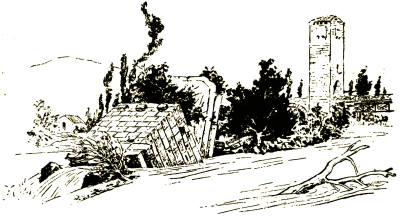
NARNI: THE PONTE D'AUGUSTO.
I have another memory of Narni. One morning,[313]
very early before sunrise, we set out from that little
city and made pilgrimage along the Old Flaminian
Way to the altar of an unknown, quite forgotten god.
It was our fancy to pay homage by the roadside where
the careless feet of generations had passed by. But we
had not thought to find such unexpected beauty on
this ancient highway whose stones were old before the
Caesars had been dreamed of by the oracles of Rome.
The Via Flaminia girdled the hillside, now disappearing
round the bluff of overhanging cliffs, now
plunging into bosky depths of wooded slopes, now reappearing
across the ravine like a white thread among
the firs and ilexes which clothe the valley of the Nera;
now climbing down to the open plain. The air was
fragrant with the freshness of a sweet September morning,
and musical with the liquid song of larks. Below
the road the hill sloped sharply from our feet to where
the Nera encircled the folds of its mountains; and above
us to the right towered a sheer cliff, curtained with
wild flowers.
At last we reached the altar of the Unknown God,
or so we called him, because, unlike Aius Locutius of
the Palatine, we knew nothing of him save that in the
distant ages, even before the coming of the Romans,
men sacrificed and offered incense here before a god.
It was only a rough-hewn table of stone, raised above
the level of the road, overlooking the deep valley of
the Nera where it pierces the wooded hills and widens[314]
out into that misty plain of the Tiber,—already a mighty
river on its way to Rome. As we stood before it,
gazing down the valley, Phoebus gilded the hill-tops.
Our feet were on the Old Flaminian Road. And
because the day was young and the air like wine, and
the ancient way to Rome was as beautiful as a poem,
we gathered together ferns and dried leaves, and lit a
fire upon this cold altar of the God of an older world.
It began in play. The Poet put a sprig of scented
thyme upon the ancient stone. But as the fire leapt
up, and the blue smoke ascended to the clear air like
fumes of incense, our laughter died away. Just for
that moment all we were slipped from us. We became
as children playing in a temple who turn from their
games at the solemn voice of the prayer-bell, and leave
their toys unheeded for a while. Just for that moment
there was only beauty, and the need of worship to the
God of beautiful things. No longer can we say,
'Glory and loveliness have passed away;
For if we wander out in early morn,
No wreathed incense do we see upborne
Into the east to meet the smiling day.'
For standing on the steep hillside upon the Old
Flaminian Way, we made a heap of scented herbs,
thistles and dry mullein stalks, all that the withered
bosom of the earth could yield, and made our offering
to the valley and the hills and the great plain which
opened out before us.
[315]
So the old stone was warmed, the old god propitiated.
And as the smoke curled up to the blue
heavens we saw the feet of Apollo golden on the hill-tops.
When we turned back we found Narni sheathed
in sunlit mists, as Turner painted her, like a mediaeval
saint rapt in the mystic glory of communion with
nature.
The Poet quoted softly:—
'For, it may be, if still we sing
And tend the shrine,
Some Deity on wandering wing
May there incline;
And, finding all in order meet,
Stay while we worship at her feet.
[316]
ORVIETO: THE CITY OF WOE
'To rear me was the task of Power divine,
Supremest wisdom, and primeval love.
Before me things create were none, save things
Eternal, and eternal I endure.
All hope abandon ye who enter here.'
Dante.
The broad white steps of Orvieto Cathedral were
strewn with thousands of dead flies, killed by the
merciless glitter of its new mosaics in the eye of the
sunshine. Poor little dust of life scattered at the door
of Madonna Mary's temple, with your shattered wings
and your sightless crawling agony, meeting your death
unwittingly in the heart of this city of woe! You are
the key to its desolation, you with your myriads of
dead, the horrid harvest of an insatiable ghoul. For
not even the shrill music of Luca Signorelli's angels,
hovering above the gloomy fortresses of Orvieto with
their hair streaming in the breeze of the dawn, can
raise her up to life. She is a city of the dead—shrivelled
and dark-browed, standing high over the plain on an
island of volcanic rock, 'dark-stained with hue ferruginous,'
like Malebolge within the depths of hell.[317]
Death lies around her in the valleys where the earth
is riddled with the tombs of Etruria—one vast necropolis—and
she herself, though she held life so dearly,
as we can see by her grim Romanesque houses each
with its back to the wall as it were, each armed at
every point, would be almost dead to the world if it
were not for the Tuscan glitter of her great Miracle
Church.
Even her name has a sinister ring about it—Orvieto—the
Old City. To the writers of antiquity she was
Urbs Vetus, but no man knows her ancient name,
and although archaeologists dispute in vain as to the
rival claims of Herbanum and Salpinum, it is recognised
that the origin of Orvieto is plunged in mystery.
Unlike the other cities of Southern Etruria, built on
the extremity of a peninsula of hills, she is isolated
on a volcanic rock in the heart of the melancholy
valley of the Paglia, an impregnable position, as many
a Pope has realised with thankfulness as he fled to it
for Sanctuary from the wrath of Emperors or the malice
of Cardinals, or, more often still, the vengeance of the
people of Rome. For Orvieto was consistently Guelf
in her sympathies, and no less than thirty-two Popes
have taken refuge within her walls since Adrian IV.,
Nicholas Breakspear, the only Englishman who ever
sat upon the Papal throne, held his court there in 1157,
because Rome had not yet forgotten the martyrdom of
the heroic Arnold of Brescia.
[318]
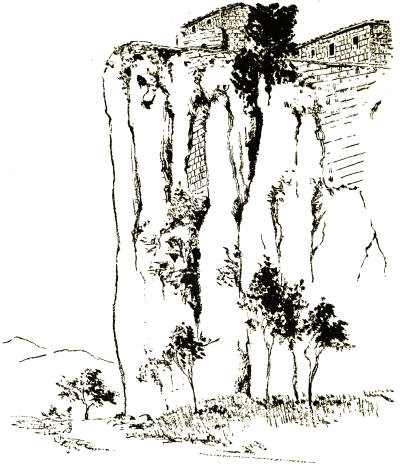
BELOW THE WALLS OF ORVIETO.
We came to Orvieto by rail and scaled her precipice
on the funicular, which connects the station down
on the plain with the city on the rock above. If we
had come by road, only a toilsome climb of several[319]
miles would have brought us to the grim Porta
Maggiore, where Boniface VIII., in his twofold tiara,
keeps watch from his niche above the gateway.
Does any city frown so fiercely on the traveller as
Orvieto? The arch is gloomy and the road within is
dark and steep. The sheer cliffs sweep to right and left
like the pylons of an Egyptian temple, and above them
peer fortified houses, squat and brown. This surely is
the city named of Dis, which Dante had in mind, whose
walls 'appeared as they were framed of iron,' upon
whose gates the citizens looked down with ireful
gestures!
Through this gate hastened the Popes, fleeing from
wrath to come, and in their footsteps we toiled up the
steep street between the same houses of yellow volcanic
tufa gone black, which frowned upon the turbulent
successors of St. Peter, who let down their nets, not
for the drawing in of souls, but for the dragging in
of wealth and the entangling of the feet of the unwary.
Through dark alleys we could see the gloomy
depths of caves, hollowed out of the living rock
behind them: in the low bassi the citizens of this
broken city toiled silently, and outside their doors sat
hooded owls on poles driven into the stony ground.
Here indeed were the Middle Ages, but not the Middle
Ages of pomp and pageantry, of Gothic palaces and
slim young knights in silken hose. There are some
streets in Orvieto which look as though war had stalked[320]
through them only yesterday; as though the terror-stricken
Ghibellines still cowered within doors, while
the Monaldeschi rang
bells in triumph, as they
did on that fateful day
in the year of grace 1312,
when the Filippeschi had
tried in vain to open
the gate of the city to
Henry VII. of Luxemburg.
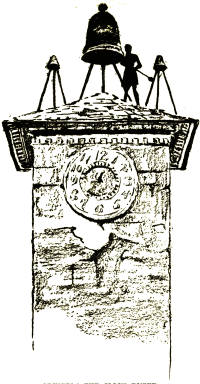
ORVIETO: THE CLOCK TOWER.
Well, that is over
now. But the curse of
the Prophet Isaiah seems
to have fallen upon the
papal City of Refuge.
'In that day shall her
strong cities be as a forsaken
bough, and an
uppermost branch ...
and there shall be desolation.'
So that it was
with a kind of wonder,
as though we too had
assisted at a miracle, that
we came suddenly upon
the Duomo of Orvieto with its rare marbles and brazen
beasts of the Evangelists, its glittering mosaics, and[321]
gilded pinnacles soaring to the heavens. For this great
cathedral, built to commemorate the triumph of the
dogma of the Roman Church over northern intelligence
in the Miracle of Bolsena, is a bird of strange plumage
to find nesting on the melancholy rock of Orvieto.
Siena or Florence, Pisa or Lucca, any of the flowery
cities of Tuscany would have been its proper setting.
It is too gay for Umbria, whose hills are bathed in the
serene, ineffable calm of a mystic holiness, who, remembering
her many saints, still keeps the low estate of
a handmaiden of the Lord. It is like a golden iris
plucked from some Tuscan garden, and transplanted
upon the bosom of this sombre precipice of tufa upheaved
by Nature in primeval struggles. For chance
and the Papacy have grafted the most exotic bloom of
Italian Gothic architecture upon the rock of Orvieto.
But look closer. Behind the aerial grace of the
façade with its bewildering embroidery of yellowing
marbles, rarely carved, its jewelled canopies of mosaic,
its Lombard colonnades and soaring pinnacles, not even
Time, the great artist who puts the crown of beauty upon
all the works of man, can veil the ugly nudity of nave
and transept. If the pride of the Orvietans had only
left him a freer hand upon the façade it would have been
immeasurably more beautiful. But the mosaics which
should gleam from their rich setting with the subdued
brilliance of a peacock's feather, have been restored so
garishly by a local artist that they rob the cathedral of[322]
half her wonder. Their glitter sears like a burning
glass: only on a rainy day, or by moonlight, could we
look on them with equanimity.
It was not for these that we stayed so long
outside the portal of Santa Maria, but to study the
exquisite carvings which Lorenzo Maitani or Niccolò
Pisano traced on the bases of the four pilasters. When
two such scholars as John Addington Symonds and
Mr. Langton Douglas fall out over the authorship of
these sculptures it is useless to offer any opinion on the
subject. But there is a pretty legend concerning
Niccolò Pisano and his work at Orvieto; and because
the reading of it gave me much pleasure as I sat on
the stone bench below the Opera del Duomo, marvelling
over the glories of the Miracle Church, I will give
it in a quotation from Mr. Symonds' delightful essay:—'Nicola
Pisano, before Cimabue, before Duccio, even
before Dante, opened the gates of beauty, which for a
thousand years had been shut up and overgrown with
weeds. As Dante invoked the influence of Virgil
when he began to write his mediaeval poem, and made
a heathen bard his hierophant in Christian mysteries,
just so did Nicola Pisano draw inspiration from a
Græco-Roman sarcophagus. He studied the bas-relief
of Phaedra and Hippolytus, which may still be
seen upon the tomb of Countess Beatrice in the Campo
Santo, and so learned by heart the beauty of its lines
and the dignity expressed in its figures that in all his
subsequent works we trace the elevated tranquillity of
Greek sculpture.'[28]
405
[323]
And, indeed, there is a curious and unexpected
beauty in these naïve reliefs telling the ancient story
of the Creation and the Fall, the Old Testament up
to the Birth of Christ, the life of Jesus, and the Last
Judgement. For though they are a typically mediaeval
expression of faith, yet they are astonishingly free from
the bizarre design and crude workmanship of mediaeval
imaginings. Lofty in conception, they tell the solemn
history of Christianity in a series of scenes divided the
one from the other by the Vine, of which it has been
written, 'I am the Vine and ye are the branches.'
But here for the first time in Mediaeval Art we see
treatment worthy of the nobility of the Theme. For
whether the sculptor did really become enamoured
of the antique by the study of an ancient tomb, or
whether some fire of genius within himself bade him
struggle forth from the swaddling bands of Byzantium
and the grotesqueries of the North, he has inscribed a
new chapter in the history of Art upon the walls of
the Cathedral of Orvieto.
Forsaking the crowded imagery of Mediaevalism,
he has made manifest the dignity and beauty of the
human form. And something else as well. For looking
on the reliefs of the Creation, we can almost hear
the rustling wings of the two guardian angels as they[324]
hover in the silent dawn above the garden where God
creates man in His own Image. And we see the
germs of that poetic imagery which was later to bear
fruit in the genius of Ghiberti and Donatello, even, it
may be, in the frescoes of the Sixtine Chapel where
Michelangelo completed the great epic of the Human
Form, whose prologue we may read upon the stones
of Orvieto Cathedral.
Directly we pass through the portal and enter the bare,
ugly church, it is apparent that although its Tuscan
architects and artists began their work lightheartedly
enough, and although the Popes made offer of indulgences
to all who assisted them, the sullen influence of
the place weighed on their spirits. See how grey and
gloomy is the nave behind its gay mask; see how
Niccolò in spite of his love for the human form dwelt
on the grim drama of the Fall of Man; see how the
tragedy of life is blazoned forth by Signorelli. Only
the Umbrians, the simple-hearted artists of the countryside,
called in to paint the chancel with the story of the
Virgin and the Life of Christ, and the Blessed Angelico,
working on the vault of the Cappella Nuova, seem to
have been untroubled.
But neither the frescoes of the Umbrians, among
which we thought we could trace the hand of Pinturicchio,
and certainly he was under commission to paint
for the canons of Orvieto, when he was working in the
Borgia Rooms in Rome, nor the exquisite reliquary[325]
which Ugolino Vieri of Siena wrought for the miraculous
Corporal of Bolsena, detained us long. For in
the southern transept we had glimpsed the Chapel of
the Madonna di San Brizio, where Fra Angelico and
Benozzo Gozzoli frescoed the vault, below which, many
years later Luca Signorelli came to paint his great
pictures of the Last Judgement.
It is a strange coincidence, as though some deep
emotion had moved these Tuscans to expression, that
in Orvieto we see not only the beginnings of realism in
sculpture but the masterpiece of the first great painter
of the Quattrocento, who gave life to the human form
in fresco. Every one knows that Vasari claims for his
kinsman, Luca of Cortona, the honour of having inspired
the Last Judgement of Michelangelo. And no one
can dispute that the Florentine, his greater genius
less exercised by the study of anatomy, clothed his
figures with more grace and dignity; and that the
Dantesque terrors of his hell, with the boatman of
the Styx silhouetted against the lurid glare of the
underworld, are told with more reserve than Signorelli's.
But whether the confusion and morbidity of
the whole, already foreshadowing Baroque, surpasses
the spacious compositions of Signorelli is largely a
matter for the enthusiast for technique to declare.
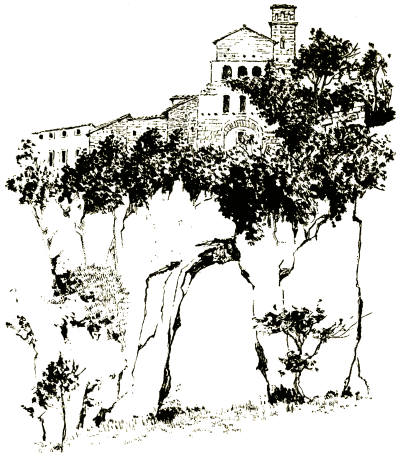
It is interesting to note the discrepancy between the
conditions under which these two men worked, each
animated by the fire of genius, though one so far beyond[326]
the other, each rapt in contemplation of the awe-inspiring
mystery of life and death. Michelangelo,
with the denunciations of Savonarola fresh in his
memory, worked alone and silently below the vault of[327]
the Sixtine, where he had lavished his splendid energy
twenty-two years before; almost friendless, filled with
gloomy imaginings. And looking on the Sixtine Judgement
we feel something of the inarticulate anguish of
his great spirit. But the frescoes of the Cappella della
Madonna di San Brizio are the key to an unsuspected
chamber in the soul of Luca Signorelli. For how
reconcile these strange visions of the anti-Christ and
of Life after Death with our knowledge of that
courteous and stately gentleman 'who delighted in
living splendidly, and loved to dress himself in beautiful
garments.'
Only one other time does he give us a glimpse
into this secret chamber, when we read the pathetic
story of how he painted the bodily loveliness of his
dead son before he yielded it, dry-eyed and silently, to
the tyranny of the grave. Yet here perhaps we have
the clue to the meaning of his frescoes in the
Cathedral of Orvieto. For he had loved exceedingly,
and seen his loved one lowered to the unresponsive
earth. Do not we too know what it is, in spite of
all our creeds and our philosophies, to weep for the
gentle voice and the dear brave eyes and the comforting
hand of those others whom we shall never meet
again except in dreams? And it is not only the spirit
that we cry for, but the body.
So, Signorelli. And we felt this, especially looking
at the fresco of the Resurrection. For into the cold[328]
grey dawn of a featureless world rise men and women,
struggling with the clay which seems to cling about
their limbs, forcing them to make conscious efforts.
Above them in the starry heavens two strong and
splendid angels send forth the blast which calls them
from the earth. The utter aloneness and the awful
sense of space make the newly-risen dead shrink
together, and some of them cling to each other, showing
a pathetic human feeling of desolation in the midst
of their wonderment and terror. Others are still engrossed
in their struggle with the encumbering earth.
But there are some who meet in this cold plain
after long years of separation, and rush to hold each
other. How Signorelli loved their splendid physical
beauty! Even in his Paradise, where the heavenly
choir makes music overhead, and the angels scatter
celestial roses among the saints, he does not clothe
them in gold raiment, only in their fair, strong limbs
which were to him as beautiful as flowers.
It was not so long a step as it appeared from
Signorelli's Visions of the Future Life to the Necropolis
of Etruria, below the frowning walls of the city.
For Orvieto is shadowed by the Wings of the Angel of
Death—the genie of the ancient Etruscans, which we
see faintly limned upon their sepulchres—and as the
old custode at the Mancini Tombs told us with arms
outspread towards the plain, 'c'è una vasta città dei
morti, più grande che la città alta.'
[329]
The way was strewn with flowers, like all the paths
of Umbria, and it led us through the undergrowth at
the foot of the rock of Orvieto to the olive garden
of the Mancini Necropolis. Barren figs sprouted from
the gaping crevices overhead, and sometimes the bearded
ivy hung half-way down the cliff. Once we came upon
two rude wooden crosses nailed to the brown tufa, with
the marks of a third between them, making the desolate
valley more like a Golgotha than ever.
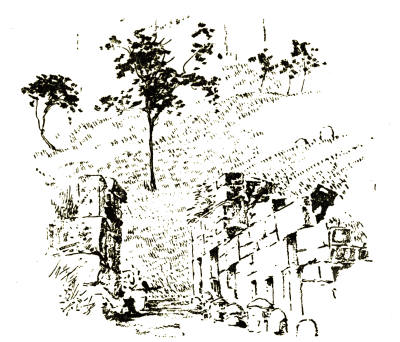
ETRUSCAN NECROPOLIS BELOW THE WALLS OF ORVIETO.
The necropolis below the hanging church of Sant'Agostino
is more interesting than romantic now that
the tomb has been dismantled, which Signor Mancini[330]
used to show to the traveller, intact, with the inmate
lying on his rough bed, surrounded by his last possessions.
The sepulchres are not hollowed out of the
living rock like most Etruscan tombs, but are built in a
sort of honey-comb of rough masonry, back to back,
with chambers about 12 ft. long by 8 ft. wide, and
perhaps 10 ft. high. The round cippi on the mounds
which cover them make them appear curiously like
Oriental villages.
But it is to the student rather than to the pilgrim
in the world of Beauty that this sombre burial-place of
the ancients will appeal. We found more joy in the
painted tombs on the hill of the Cappuccini, where in
the cavernous depths of the tufa rock we caught a fleeting
glimpse of Proserpine seated beside the Lord of
Hades, and heard the flutings of Etruscan slaves as
their princes drank libations to their own departed
souls. And it is worth while crossing the valley in the
early morning to see the loveliness of Orvieto, crowning
her great rock in the heart of her wide pale valley, with
the sunlight gilding her towers and the jewelled face
of her cathedral.
415
[331]
It was very early when we emerged from the frowning
gate of the city and dipped down among the dewy
vineyards. Beside the road an aqueduct rose out of the
earth, a crumbling mass of ancient masonry. As we
climbed down into the valley it towered above us,
spanning the ravine, but when we toiled over the
penitential stones of the Via dei Cappuccini, thankful
for its shade as we mounted, it sank again into the hillside,
and the leaping green things clambered upon it,
eager to drag it back to the ditch. So we went leisurely
through the play of light and shade, and always as we
looked back we saw Orvieto rising sheer out of the
valley like a queen on her brown rock. The morning
mist wove a magic beauty round the spires of her
Gothic cathedral and the giant pine-tree on the edge of
her precipice, until she seemed the very city Turner
immortalised.
And presently we came into a chestnut grove
where the path was hidden under a carpet of rustling
autumn leaves; and a tangle of wild flowers—harebell,
cyclamen, saffron and fireweed—wove a tapestry on
the loom of the grass. Here were our nameless tombs,
sunk deep in the tufa rock, with over-arching trees
above their gates and Canterbury bells growing on
their mossy paths. Within, the damp had eaten away
many of the beautiful forms about which Dennis
wrote. But we could trace the shapes of the Lords
and Ladies of Etruria as they sat like shadows before
their eternal banquet in the halls of Elysium; we
could see the slaves preparing their elaborate feast,
here baking bread, there pounding meat to make it
tender. And on another wall, a young warrior, attended
by a winged genius, bearing in her hand a scroll
inscribed with his good and evil deeds, drove in his[332]
chariot to Judgement in the Unseen World. In the
midst of these wraiths there was one unspoiled fragment
of plaster, the head of a youth, beautiful and
Greek, who gazed sadly upon the ruin of his gods, shut
from the world so fair, which he had dreamt was made
for his strong youth and beauty, in whose ears even
the faint, half-vanished music of the pipes will soon be
silenced, if it is true that when the pictured ghosts of
things have faded their soul is stilled.
Their melody rang in our ears when we stood once
more in the chequered shadow of the chestnut grove,
already gilded with autumnal gold, and looked across
the wide pale valley to Orvieto. It was the hour of
Mass, a Sabbath day and wonderfully silent. Again we
seemed to hear that plaintive strain. But it was only
the humming of the insects, and the bells of the distant
city calling her people to prayer.
[333]
VITERBO
Though they are sisters in name—Urbs Vetus and
Vetus Urbs—and though their function in the mediaeval
history of the Papacy was the same, it would be difficult
to find two cities so dissimilar as Orvieto and
Viterbo. The mystic sadness of Orvieto is foreshadowed
in the pale valley of the Paglia, strewn with
the débris of volcanic upheavals; but instinctively our
spirits rose as we drew near the gay and beautiful city
of Viterbo, across the rolling plains of Lazio, which
have been trodden by the feet of all the armies who
sought to invade the sanctuary of Rome. It is a field
of history and romance, full of memories.
Far away upon our left the Appennines were piled
like storm-clouds on the horizon; and upon our right,
over the valleys once guarded by the strongholds of
Etruria, rose the splendid outline of Montefiascone, the
shrine of the Goddess of the Etruscans—the Fanum
Voltumnae, to which they gathered in times of
doubt or danger to consult the oracles and appease the
gods. Near at hand, black against the blue Sabine
mountains, was the mysterious Ciminian Mount, whose[334]
terrors held the Roman legionaries in check until the
Consul Fabius Maximus in b.c. 310 plunged through
its forests into the great Etrurian Plain, to the terror
of the Senate, whose prohibition reached him too late.
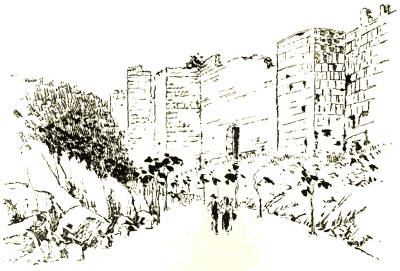
OUTSIDE THE WALLS OF VITERBO.
The sun was sinking behind the hill of Montefiascone
when we entered Viterbo. It was Sunday, and the passeggiata
between the station and the Porta Fiorentina
was filled with a gay crowd of citizens and soldiers.
For unlike the other papal cities of refuge, Orvieto
and Anagni, which have fallen upon evil days, Viterbo,
always a natural centre, is becoming an important
provincial capital, one of the most prosperous towns
in Italy, with a rapidly increasing population. And[335]
to her honour be it said that her municipal energy is
making itself felt to great advantage in the direction
of stripping from her Gothic palaces and churches the
baroquetries which have veiled their beauties during
the last three centuries.
The origin of Viterbo is as mysterious as the source
of the Nile. An Etruscan city is known to have stood
upon its site; it contains positions of great strength,
tongues of hill, guarded by gorges, well suited to the
Etruscan style of fortification; and it stands at the
Etrurian gate of the Great Ciminian Forest, the chief
obstacle which the Romans had to pierce for the
subjugation of Etruria. So, putting aside the stupid
forgeries of Annio of Viterbo, who 'claimed for his
native city an antiquity greater than that of Troy,' it
is curious that the Vetus Urbs is not mentioned before
the eighth century, when the old chroniclers speak of
an ancient castle—castrum Viterbii—standing on the
present site of the cathedral. But from the year 773,
when it attracted the attention of Desiderius, the last
King of the Lombards, who made it the base of his
intended conquest of the States of the Church, has
its history been interwoven with that of the Papacy.
Little is known of Viterbo in Lombard times, for all
the grandeur of her Lombard walls, which were many
times thrown down and built up again in her constant
warfare with Rome. It was not until the beginning
of the twelfth century that she sprang into importance[336]
in mediaeval history as the capital of the Patrimony,
bequeathed by the Countess Mathilda of Tuscany to
the occupants of the Chair of St. Peter, assuming the
rôle of a fully-armed Minerva springing from the brow
of Jove, because her lofty position made her a fortress
for the Popes in time of peril from the sword, and a
sanatorium in seasons of pestilence. In the twelfth
century Eugenius III. summoned the vassals of the
Church to assemble in Viterbo, and in the thirteenth
century five popes were elected within her walls, and
four popes died there; in 1240 Frederick II. was living
in peace in Viterbo; and five years later the city
inscribed the most glorious page in her annals when
the great Emperor was humiliated by her heroic defence
against his onslaughts and forced to retreat into Pisan
territory. But her power decayed from the end of the
thirteenth century, when Honorius IV., in removing
the interdict which his predecessor had laid on the
city for the outrages committed in the papal elections,
decreed that she was to raze her fortifications, lose
her jurisdiction, and yield her rectorate to Rome.
Later, we find Urban V. staying in the Rocca when
he returned from Avignon, the mediaeval Babylon,
in answer to the exhortations of Petrarch; and here
died the great soldier and statesman, Cardinal Gil
d'Albornoz, before the Pope continued his unwilling
journey to Rome. But it is chiefly as a city of the
twelfth and thirteenth centuries that we regard Viterbo
to-day; for in those stormy years which saw the rise and
fall of the great house of Hohenstaufen, the fate of
Viterbo was synonymous with that of the Papacy, and
it is to this period that most of her mediaeval monuments
belong.
423
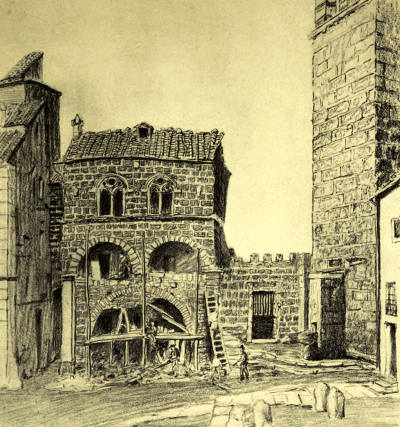
Viterbo: mediaeval house in the Piazza S. Lorenzo.
[337]
Coming from Orvieto we found Viterbo very gay
and gracious, with exquisite fountains making music
in all her piazzas, and her mediaeval streets full of the
merry air of vintage time. Already the great vats
had been cleansed, and we had encountered enormous
barrels groaning and rumbling down the hills as they
were rolled to the fountains to be soused and sweetened
by sun and air, or tumbled back to their accustomed
cellars. All day long the yoked oxen swung slowly
in through the ancient gates, drawing carts filled with
barrels of fruit; and in front of more than one humble
osteria we found a group of men and girls singing
and laughing as they pressed the grapes with bare
white feet, up and down, up and down, while the
dark fluid flowed through a conduit into the vats
below. This alone would have made us love Viterbo,
just as we still carry gentle memories of Mantua,
not so much for its great castles of the Gonzaga,
as for the beautiful simplicity of the vintage which
we watched being brought home to that city of
arcades from the fields round Virgil's home not many
autumns ago.
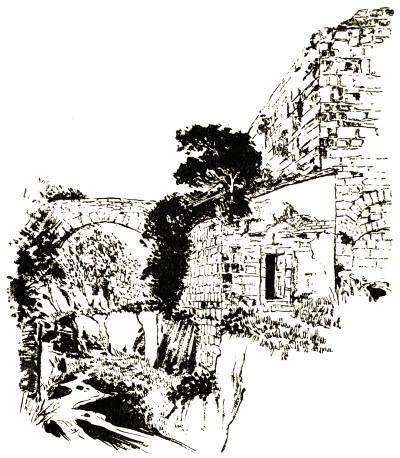
VITERBO: THE MOAT OUTSIDE THE PORTA SAN PIETRO.
But Viterbo, 'the Nuremberg of Italy,' is full of[338]
charm. She is one of the most mediaeval cities in
Italy; she has a whole quarter of thirteenth-century
houses cheek by jowl with barons' towers and ancient
churches; she has exquisite cloisters like that of Santa[339]
Maria della Verità, where the recent Camorra trial was
held; and on the hill where the ancient castle of Viterbo
stood she cherishes a gem of Gothic architecture—the
Palazzo Vescovile, which was once the palace of the
popes.
This was the stage on which the chief personages
in the history of Viterbo and the Papacy played
their parts. Here came the Barbarossa to pay his unwilling
homage to proud Adrian IV., who thought of
lowering human dignity far more than any Latin
would have done. Here came Frederick II. in peace,
because Viterbo had departed from her loyalty to
the Papacy for the time being, since the cause of
Gregory IX. had been espoused by her ancient enemy,
Rome. Here was elected Urban IV., the pope who
never entered the Lateran or St. Peter's. Here Charles
of Anjou, and King Philip III. of France, travelling
from Tunis with the body of his father, Louis IX.,
waited for the election of Gregory X. in 1271; and
the impatient Charles, seeing that the cardinals were
in no hurry to choose a successor for Clement IV.,
took the roof from their council chamber, confident
that discomfort would hasten the decision of those
luxury-loving priests. That same year, in the presence
of the King of Sicily and the King of France, Henry,
son of Richard, Duke of Cornwall, who was on
his way to England from the Tunisian crusade, was
done to death by Guido di Montfort, Charles' vicar in[340]
Tuscany. 'The sight of the English prince awoke the
fury of this bloodthirsty warrior, and impelled him to
avenge himself on the royal house of England, by
whom his great father, Simon of Leicester and Montfort,
had been slain in battle, and his remains outraged
in death. He stabbed the innocent Henry at the altar
of a church, dragged the corpse by the hair, and threw
it down the steps of the portal.'[29]
It is interesting to note that the murderer was
not punished by Charles, and that, as Gregorovius
points out, only twelve years later he was spoken of
by Martin IV., who made him General in the service
of the Church, as his beloved son. But Dante places
his soul in hell among the tyrants who were given
to blood and rapine, where he commemorates the
fact that Prince Henry's heart was exposed before
the sorrowing eyes of the English nation beside the
waters of the Thames.
'... He in God's bosom smote the heart
Which yet is honour'd on the bank of Thames.'
But it is difficult to realise such stirring scenes
in Viterbo to-day. For directly we left the Corso
Vittorio Emanuele, with its cheerful provincial bustle,
behind us, and crossed the sunny Piazza del Plebiscito,
guarded by the lions of Viterbo, rampant on columns
below their heraldic palm-trees, we found her a gentle
city fallen upon sleep, full of stately mediaeval
houses with outside staircases, and ancient hospices
for pilgrims, Gothic and grey, with buttressed
walls and cowl-like windows.
429
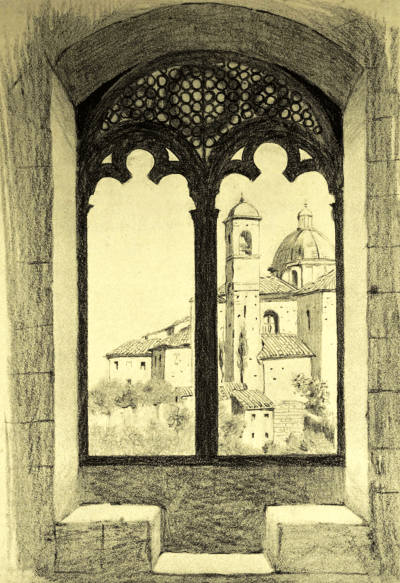
Viterbo: from a window in the Palace of the Popes.
[341]

VITERBO: THE STEMMA
OF THE CITY.
The Palace of the Popes, where there
are memories for every stone, stands with
the cathedral in a sunny square beyond
the Piazza della Morte and the picturesque
palace where the great Farnese Pope was
born. Thanks to Pedro Juliani, that most
distinguished scholar, who took the name
of John XXI. when he was elected to the
vacant chair of St. Peter at Viterbo, the
palace which was the home of so many
popes in the thirteenth century is one
of the most beautiful Gothic ruins in
Italy. For it was the ill-fated John
XXI. who built the exquisite chamber
supported by a single mighty column
and an arch, which is the chief glory
of the Palazzo Vescovile. Legend has
been busy with the name of this pope,
whose scientific studies made him hated
and feared by the ignorant and superstitious
monks of his day, and whose untimely death
increased the popular belief that he was a magician.
He was killed by the falling ceiling of the very room
which he had taken such pride in adding to the papal[342]
palace, and on the night of the catastrophe it is said
that a monk roused his companions from sleep by
crying out that he had seen a huge black man knocking
with a hammer on the wall of the Pope's room—a
legend quite in keeping with the general belief
circulated in Rome more than two hundred years later,
that the devil had called in person at the Vatican to
carry away the body of the wicked Borgia Pope.
At the first glance the Palazzo Vescovile seemed
nothing but a gracious ruin, for the lovely Gothic
chamber of John XXI. is only a shell whose loggias
frame the blue heavens, and whose fountain, fallen
into decay, is overgrown with weeds. It is open to
the sky; but the great Council Chamber, from which
that impatient Prince, Charles of Anjou, took the roof
above the heads of the Papal Conclave, has been closed
in again, although the wind strays at will through
its beautiful trefoil windows. And here we loved to
sit looking through the empty Gothic frames at the
great church of the Trinità across a vine-clad slope,
and the grey convents and buttressed walls of Viterbo
shimmering in the opal light of an October morning,
with the noble sky-line of Montefiascone upon the
horizon, and the misty blue hills of Umbria beyond.
For we never wearied of the mediaeval grace and
the deliberate beauty of this palace of the Popes with
its silent fountain and its grass-grown loggia; and one
day, while we sat in the lofty Council Chamber[343]
which has been witness to so many stirring scenes,
a motor drove up to the foot of its sweeping steps,
oh, splendid anachronism! and from the inner palace
hastened a proper dignitary to meet the ancient prelate
who descended from it, and conduct him into the
presence of his master, reminding us that this stately
ruin is still the episcopal headquarters of Viterbo.

VITERBO: THE PALACE OF THE POPES.

VITERBO: FOUNTAIN IN THE PALAZZO MUNICIPIO.
'Città delle belle fontane e delle belle donne'
was the boast of the ancient chroniclers of Viterbo,
but we did not see many beautiful women in her
streets, although the splendour of her fountains is
still a proverb. Every little piazza, no matter how
humble, is endowed with a fountain of exquisite[344]
grace, where silver floods of water pour over lichened
stones, or trickle from the spouting mouths of the
Guelph lions of the city; even Rome cannot boast so
many gracious fantasies of the fifteenth century. They
are as numerous as the beautiful outside staircases
which are to be found on more mediaeval houses in
Viterbo than in any other Italian city. Such an one
is the Casa Poscia, half way up the Via Cavour, which
is turned to a humble use to-day, like all the great
palaces of Viterbo, having an osteria in its basement,
but which is a perfect specimen of the local domestic
architecture of the Middle Ages, still closed at night
by ancient wooden doors. The Viterbesi invariably[345]
point out this house as the Casa of the bella Galiana,
whose inscription in the Piazza del Plebiscito bears[346]
witness to the mortality of that Helen of the
Middle Ages, who was 'flos et honor Patriae, species
pulcherrima rerum.'
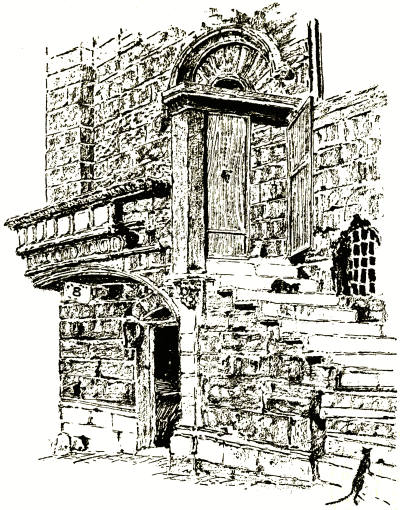
VITERBO: THE HOUSE OF BELLA GALIANA.
But the chief glory of Viterbo is the romantic
mediaeval city which lies between the Via Principe
Umberto and the gates of the Carmine and San Pietro.
Here even the names of the narrow and mysterious
streets have not been changed by the rise of the House
of Savoy. Would it not give a thrill even to the most
unimaginative of travellers to step from the Square
of the Dead into the Via di San Pellegrino with its
grey thirteenth-century houses huddled on either hand,
now flowering into Gothic windows and elegant outside
staircases, now frowning defiance from square
fighting towers with evil slits for eyes, now opening
a passage down the steep hillside like the Street of a
Hundred Bridges or the staircase street which leads to
the Bridge of the Paradox?
437
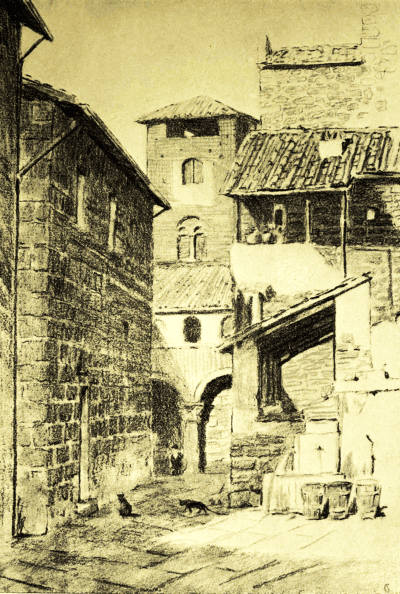
Viterbo: Via di S. Pellegrino.
[347]
Here the Middle Ages come to life again; nor are
the people themselves greatly changed, for the women
scrub their linen at ancient fountains, and the men
work in the dark bassi at their humble trades; here we
saw a white-haired dame plying her distaff in a little
vine arbour at the head of her balcony staircase, and
there we met a man coming from the bakery with a
plank of bread, three and a half feet long on his head.
As in Orvieto, there were hooded owls on stands
outside the doors to give another mediaeval touch,
and from the upper windows women looked down with
the languid curiosity of the Latin races. In the
smaller streets there were dirt and squalor unimaginable,
broken fruit and flies, unspeakable smells and the
noise of screaming children, but in their midst were
serene-eyed mothers, with the mysterious calm in their
faces which has made the Italian woman the most subtle
type of Madonna, who seemed in some strange fashion
to be exalted above the impure atmosphere in
which they lived, like the crimson garofani, or the
long sprays of Morning Glory which flowered in their
mediaeval windows. Though there was poverty it was
the poverty of the country rather than the destitution
of a city, just as the sheets and towels which fluttered
from loggia and arch and balustrade were threadbare
in spite of their fine embroidery and rich insertions of
hand-made lace.
It was through these streets that we saw the
vintage coming in through the ancient Porta San
Pietro under the shadow of the magnificent palace
which was the home of Donna Olimpia Pamphili,
the infamous sister-in-law of Innocent X., just as
it was brought in the days when the Vetus Urbs
was a sanctuary for the princes of the Church.
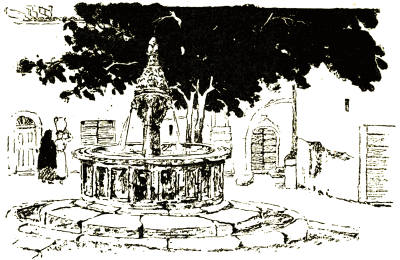
ONE OF VITERBO'S MANY FOUNTAINS.
Una giornata di tempo bello we drove across the
swelling plains of Etruria to the ruined city of Ferentinum.
It was the happiest of days, the last, though we
did not know it then, of our careless pilgrimages, for[348]
the next morning came autumn with cold winds and
rain, and we were forced to hurry after our luggage
which had already gone to Rome. But on that day
there was a special beauty in the rolling plain which
once was peopled by the vanished cities of Etruria, and
now is so like the Campagna with its ruined tombs and
scattered trees and lonely farmsteads. Here we found
the same enchantment that we remembered in the
fields of Rome—the silence, the gnats hanging in the
air in glinting masses as though they danced in an
invisible net, the larks singing in the blue distance, the
song of a ploughman hidden in a fold of the plain.
From our feet stretched the dusty road losing itself
in the valleys and cresting the hills beyond. Far[349]
ahead rose Montefiascone with its great dome soaring
above its ilex wood, and to the right, blue and mysterious
in the early morning sunlight, was the dark
Ciminian Mount, misty with spreading columns of
smoke as though the shepherds or the woodcutters
within the precincts of its haunted forest were offering
incense to the Gods.
And once we came upon a dozen yoke of oxen
ploughing the heavy brown earth, with the sunlight
shining on their smoking flanks and glistening on
the freshly-turned clods of mould behind them.
How little it has altered, this immemorial plain,
since the days when Rome feared to plunge into
the dark recesses of the Ciminian forest, and the
Lucumos of Etruria rioted their energies away in the
little cities below the mighty fane of Voltumna! For
if mankind has changed, Nature is still the same;
those rolling oxen are on the tombs of Thebes; the
ancient poets have sung of these dark woods and
scented plains, and the husbandmen at work!
The way was long until we came, between hedges
with a flower like japonica, to an outpost of Ferentinum
standing over the green valley of the Acqua
Rossa,—a disused tomb which had been a home for the
living long after the dust of the poor forgotten dead
had been scattered to the winds. Here we dismounted
and climbed up a path so thickly spread with soft
brown dust that our feet sank into it and made no
sound. Here and there we saw the basalt selce,[350]
which marked the direction of the Roman road.
Among the tangled brambles at the side were half-demolished
tombs, now a columbarium for cinerary
urns, now a niche, now merely a heap of tumbled stones.
For the earth is taking this ancient city back to her heart
again, and though the summer drought had withered
the flowers which bloom where once the pitiful dust of
humanity was laid, the empty chambers were full of
golden bracken and fantastic thistles, silver with
scattered seeds.
Still we wound up the hillside, and presently we
came upon two wind-blown oaks, the only watchers
at that city's gates, beside a rough stone wall, built
by some shepherd to prevent his sheep from breaking
in upon the sleeping silence of Ferentinum. It was a
city of the dead, deserted save for the lizards fleeing
from our footsteps, and a few white butterflies dancing
above the mullein stalks.
At first it seemed as though no stone had been left
standing on the other, but on the crest of the hill,
overlooking the wooded and precipitous valley of the
Acqua Rossa, and framing in its Royal Gateway the
misty forest of the Ciminian Mount, we came upon
the Theatre of Ferentinum, the only building in the
ancient city which retains any semblance of its
former grandeur. So do our vanities outlive us when
our loves and homes are covered with the dust of
oblivion! Behind it the purple basalt of the road was[351]
worn into deep ruts by the chariot wheels of the ancient
peoples as they drove by on pleasure bent, and the
ground was jewelled with mosaics and the iridescent
dust of ancient glass, powdered by time. Here and
there we could trace fragments of the mediaeval town
grafted on to the city of Etruria, which in the days of
its Roman occupation was the birthplace of the
Emperor Otho—like the remains of the Byzantine
church in the shadow of the Theatre—but for the most
part there was only ruin in the fallen city of the
Etruscan Goddess of Fortune.
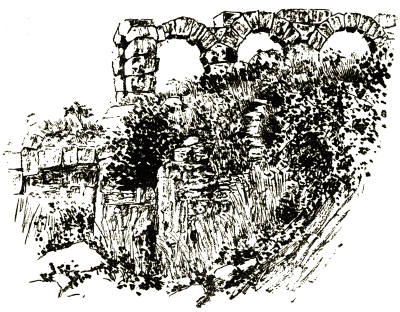
THE RUINED THEATRE OF FERENTO.
[352]
Surely the earlier Gods must wonder at the fate of
this small country town, which was renowned among
the ancients not so much for the greatness of its
history, as for the beauty of its monuments and the
art of its brass-workers, but which was destroyed in the
name of Christ in the year 1014, nearly nine centuries
ago! It is a strange story. How the Viterbesi,
arrogant and always on the watch to increase their
power as a commune, razed the little episcopal city of
Ferento to the ground, because it persisted in the
heresy of representing Christ upon the cross with His
eyes open (after the manner of the Byzantines) instead
of closed!
From that day there has been no human habitation
in Ferento except the hut of the shepherd-guide. But
the half-vanished city of three civilisations is filled with
an inexpressible charm, not desolate because the sun
and wind have peopled it with flowers, and not deserted
by the fleeing footsteps of the Gods. For surely they
were with us in the magic beauty of that soft October
morning when the little breeze across the valley fanned
our hair like an invisible plume, and Earth, the wise
mother of mankind, was offering incense to the heavens—the
fragrance of crushed herbs, the soft hymn of
insects, the silver voice of the Acqua Rossa. Even the
blue threads of smoke which still ascended from the
ilex groves of the dark Ciminian Mount seemed part
of the mysterious sacrament.
[353]
ROME
It was in Foligno, seeing that fair white road which
threads the rich valley of Spoleto, now skirting the Hill
of Trevi, now leading through the olive gardens of Le
Vene to the crystal springs of Clitumnus, that we first
began to think of Rome. Up to that time we had not
raised our eyes to the horizon. The beauty of the road
itself had led us on, but now, though she was still far
off, we felt once more the magnetism of the great
Mother of Cities. Truly in Italy every road must lead
to Rome. Many times we had been greeted with the
words,'E Roma? Andate ancora a Roma?'—in little
Passignano that gazes like Narcissus into the mirroring
waters of Thrasymene, rapt in the contemplation of
her own beauty; in far-off Gubbio, wistful and forlorn
in the shadow of her great hills; in San Marino,
the eagle nest where Liberty has taken refuge upon a
mountain top. And when we told our simple questioners
that we knew the city well, they pressed to hear
what she was like, this città bella e magnifica, whose
light shining upon their horizons they perhaps might
never see. We had not dreamed that she was so[354]
beloved. But at the oft-reiterated question some flame
of enthusiasm, which we had thought quenched, began
to burn again, and Rome became the secret goal of our
pilgrimage, until we thrilled to see that white road
leading through the plain from the walls of Foligno,
because it had become the symbol and expression, as it
were, of our desires.
We crossed the Campagna in a thunderstorm, when
earth and sky were united in a mighty storm-song.
Above the roar of the train we could hear the booming
of the thunder and the shriek of the wind, the sibilant
cry of the rain-lashed trees, and the exultant shout of
rivers, which the demon of the tempest had changed
from languid veins of water to brown and foaming
torrents.
As we drew near the Eternal City across the many-bosomed
desert of the Campagna we saw St. Peter's
dome hanging like a mirage on the grey thunder-clouds,
more like a mountain than a church, dwarfing Monte
Mario. And we thrilled at the thought of nearing
Rome, feeling the contentment that human beings feel
towards each other when they meet a dear friend after
long years of absence, knowing that, the strangeness of
the first moment over, they will find themselves settled
down with few words into the old dear comradeship
of yesterday.
447
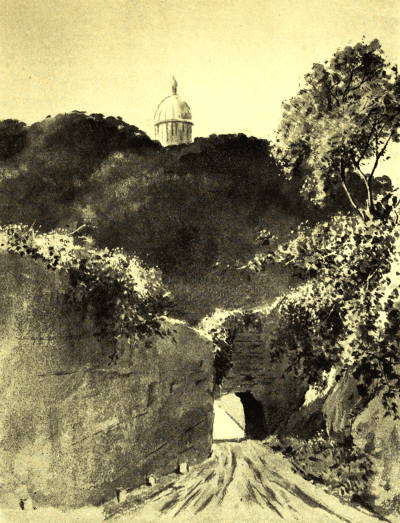
Rome: St. Peter's seen from the Arco Oscuro.
[355]
But perhaps it was because we came so lately from
Umbria, sweet-scented, golden Umbria, where the only
shadows are the heavy veils of night or the shifting
reflections of sunlit clouds, that our hearts sank in
Rome. We had bid our loves good-bye so lightly,
looked our last upon their beauties, and shut their little
voices up by miles of empty plain. Perhaps too we
had caught something of the spirit of the simple country
folk who clasped their hands and sighed over the
splendid city of their imagination.
I will own that I felt very heartsick in those first
few days, notwithstanding my old love for Rome.
The golden peace of Umbria, which we had garnered
and stored in our hearts through the long summer
months, seemed lost in the urgent business of Rome.
Memory had clothed her with antique grace, had
peopled her with Emperors and Popes, had filled
her winding streets with mediaeval palaces, her
piazzas with the gay Renaissance. But coming
from Umbria, where the Middle Ages still linger,
and that older, simpler life of the Beginning of
the World is pictured in her vineyards and olive
gardens, we found Rome little more than a modern
city, full of unrest and noise. Everywhere there was
scaffolding and masonry, and we feared to look for our
familiar landmarks lest the great god of change should
have swallowed them up. It was impossible to enjoy
walking in the streets; all we could do was to pick our
way along the narrow pavements, one behind the other,
thinking ourselves fortunate if a screaming demon of a[356]
tram did not come upon us unawares. We crossed the
roads in a meaningless sea of shouting taximen and
winecarts and motor-cars and jostling people. To
make matters worse our beloved Via Tritone was being
enlarged, and was still undergoing the process of having
tramway-lines laid down it to the Corso. And the
Piazza Barberini, our own piazza, where the Triton
singing in his fountain had dwelt in our memories and
dreams, was the workshop of the tramway people, full
of stones and unconnected lines, which seemed to fall
automatically upon each other with a hideous noise all
through the day.
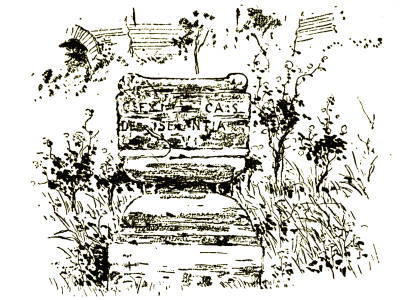
THE ALTAR OF THE UNKNOWN GOD ON THE PALATINE.
Can you wonder then that our Goddess, Imperial
and lovely Rome, seemed to have stepped down among
ordinary mortals?
[357]
Another thing. We had left a great city in search
of joy. And we had found it. Up there in Umbria
we had culled it from the roadside as you cull flowers.
We had drunk of Lethe and gathered forgetfulness
beside its waters. The burden of the world had slipped
from off our shoulders. Little by little our feet had
grown lighter upon the hillside. Our mountainous
doubts, our despairs, our days of little faith, became
mere memories. All the old fears of a city 'with
houses both sides of the street,' were forgotten. We
no longer bruised our feet on paving stones, but felt
the soft warm earth beneath our soles and smelt the
fragrance of pine-needles in the woods. Life became
a beautiful and simple thing. Holy too.
But here in Rome old doubts came back upon us,
taking us unawares. 'The poor in great cities are not
like the poor in Umbria,' said the Philosopher; 'here
they suffer so.' We heard more tales of pain in those
first days in Rome than we had heard in all the sunny
months we had been dreaming away in Umbria. And
on our first night in the city a courtesan screaming
hopelessly below our windows as she was dragged to
prison made our new-found joys shiver away to death.
We felt like the Israelites when they looked upon their
manna the second day and found it full of worms, and
we knew that we had gathered the food of angels in the
sunlit spaces of the Umbrian plain.
I am no Utopian who seeks to bring the country to[358]
the town. I know too well how soon its incorruptible
beauty would be corrupted. It is only in the hills that
we may find it and the open spaces. There, it seems,
we must go to learn our lesson, and when we have
learnt it, this A B C of beauty, we can come back to
the towns and learn more difficult things, the reverence
for beliefs which are no longer beliefs, as Emerson
taught, the beauty of a city, and of a poor man's smile.
But just as the Israelites, when the need for manna was
past, returned to ordinary food and found it good, so
we too drifted back to our old content and began reluctantly
to worship our old gods again.
And it would be childish to deny that the great
Exhibition for which Rome was preparing marked
her splendid prosperity under the rule of the House of
Savoy; or that the magnificent memorial to Victor
Emmanuel on the brow of the Capitol is the most
imposing monument in the whole city; or that the
Palatine has gained in picturesqueness now that the
débris has been cleared away from its lower slopes.
453
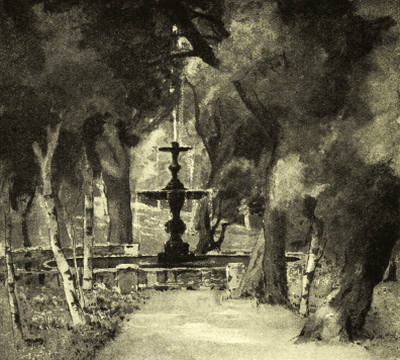
Rome: a fountain in the Borghese Gardens.
[359]
But it was not to see these things that we came to
Rome, and we found their ancient charm untouched in
those shrines of beauty to which we paid a special
pilgrimage. For all the pictures which had given us
delight upon our journeys, from the faded frescoes of
Cimabue in San Francesco d'Assisi to the strange
fancies of Luca Signorelli in the Cathedral of Orvieto,
were only stepping stones to the vault of the Sixtine
Chapel and the revelations of Michelangelo. Not any
of the fountains in Viterbo or in Siena or Perugia had
such a gracious setting as the moss-grown basins of the
Villa Borghese, whose crystal jets, like Arachne of old,
challenge Athena to spin a lovelier web below the
ilexes and autumn-gilded maples. And when we came
to worship at the shrine of the Unknown God on the
sunny slopes of Rome's sacred hill, where the reapers
were scything the fennel and thistles and tall rank weeds,
which had grown higher than a man, we found the
altar of the Genius of Rome fragrant with the last red
roses of summer. Above it fluttered a butterfly like a
soul that fain would speak, and a careless lizard was
sunning himself upon the ancient inscriptions which
mottled lichens seek vainly to erase.
Out on the Appian Way the roadside was still full
of flowers, white, purple and gold. The dry fennel and
yellow thistles and tall weedy mulleins were waist-high
among the tombs. Butterflies fluttered their last dances
before they yielded their little bodies to the enchantment
of winter sleep; birds were fluting overhead, lizards
sunned themselves upon the old grey stones.
For the rest we found the Ancient Way deserted, a
home of sunshine and peace. If there was dust, was it
not dust of the dead? Is not all the dust in the world
dust of the dead? And were not the flowers, those gay
brave pennons of spring and summer, the quintessence
of this Roman dust?
[360]
To our right Tivoli was hidden in mist, but Rocca
del Papa and the Alban Mount rose like shadows to
the south. The aqueducts marched across the plain,
or stumbled into ruin among the flowers with which
the merciful earth covered their fall. Lonely farms,
towers, nameless tombs, grew out of the folds of the
plain. And the early setting October sun, dipping into
a haze, empurpled the fields and wove a golden halo
round the sheep who bleated homewards in the melancholy
of the dying sky. The little trees, like mourners,
bent down towards the tombs, or seemed to shrink
back to the earth. Only the stone pines with their
heads to heaven were unconscious of the death around
their roots.
FOOTNOTES:
TRANSCRIBER'S NOTE
—Errors in printing and punctuation were corrected.
*** END OF THE PROJECT GUTENBERG EBOOK 46092 ***

